
Home » Destinations » Europe » Spain » 5-14 Day Spain Itinerary: A Guide For Planning Your Perfect Spain Trip

5-14 Day Spain Itinerary: A Guide For Planning Your Perfect Spain Trip
Links in this article may earn us a little money if you book/ order stuff. More here .

Plan Your Perfect Spain Itinerary with These Detailed Templates!
Want to explore Spain but confused about the perfect itinerary? You are not alone! It can be a true challenge to determine how many days to spend exploring.
From 5-day Spain itineraries to 7 or 10 days, to 14-day itineraries – there are certainly lots of different routes and options to choose from. The hard part? None of the routes are necessarily bad or wrong since there’s just so much to see and do all around Spain!
Spain is one of the most visited countries in the world. Because of its popularity, Spain knowledge is really flowing around the travel world these days!
It’s no secret that Lisa lived in Spain and took full advantage of her location (and her Spanish language knowledge)! So, she’s experienced quite a few of the places we recommend below for a great stop on your itinerary!
Spain Itinerary Overview
Best Time to Visit: Generally, summer is the hottest and winter is colder and wetter, but regional exceptions apply. March-June and September-end of October are best.
Getting Around: Trains ( RENFE ) and buses ( Alsa ) are reliable. A rental car in Spain is a must-have for smaller towns.
Popular Places to Visit: Barcelona , Madrid , and Valencia for larger cities, and Granada , Seville , and Córdoba are worth a look, too.
Where to Stay: Check for hotels in Spain here and Check for hostels in Spain here .
Table of Contents
Spain Itinerary – 5 Days
If you plan on travelling through Spain for only 5 days, it’d be best to fly into one of the bigger cities as they are usually well connected with other European cities.
Depending on your route, you can either take public transport if the travel times align with your plans or opt for a rental car if you would like more flexibility.
As with the other Spain itineraries in this blog post, our 5-day itineraries are pretty fast-paced. However, since it is pretty much impossible to go top to bottom and actually see parts of the country we decided to write two separate Spain itineraries for 5 days.
One covers the north and northeast of Spain while the other itinerary covers the south of the country . Choose the one that is more suitable for your interest and travel plans and feel free to modify the written itineraries however you see fit!
Spain Itinerary 5 Days – Northern Trip
For this classic 5-day trip across the northern parts of Spain, the total driving time is about 8 hours and covers around 750km .
If you rent a car, given this exact route, there are tolls on most of the highways so keep that in mind that it may be longer if you took non-tolled roads that may be more indirect. A bus would be able to breeze right along these highways, however.
navigate map
Spain Itinerary 5 Days – Northern Trip Overview
Day 1: Barcelona
- Day 2: Half-Day Barcelona/ Zaragoza
- Day 3: Logroño
- Day 4: Donostia-San Sebastián
Day 5: Bilbao
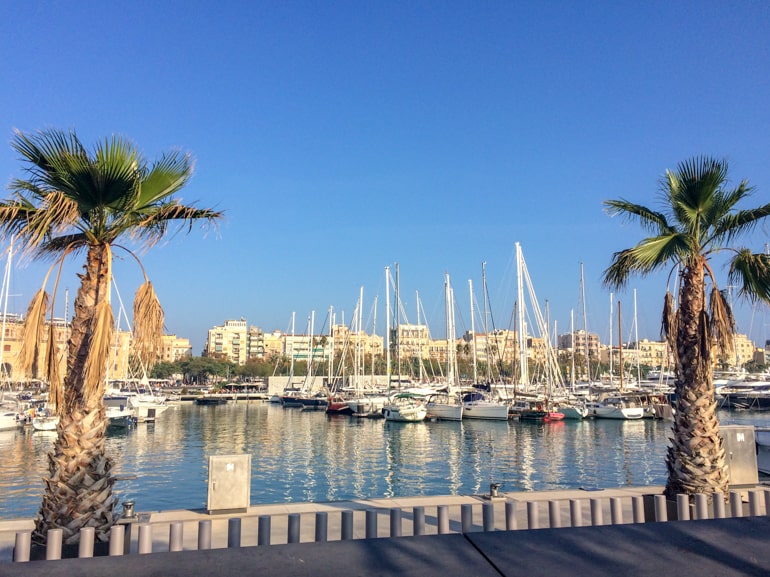
Barcelona is a good city to start a road trip since it is a popular tourist destination and thus has frequent flights to other European or International cities. Barcelona is the capital city of Catalonia which has its own unique culture and language next to Spanish.
Since it is such a popular city, the car rental industry is very well developed and it is easy to pick up a rental car from the airport or in the city.
Find your rental car in Barcelona here .
Alternatively, the bus station in Barcelona is great and easy to reach from the centre. There are numerous connections to Zaragoza which will be the next stop on your 5-day Spain itinerary.
Accommodation in Barcelona : As a super popular tourist destination, there are lots of hotels and apartments available in Barcelona.
Check here for Accommodations in Barcelona .
Specifically, for hotels check out Catalonia Born Hotel with a boutique style and rooftop pool in the city centre and close to the beach.
If you travel by car, Sallés Hotel Pere IV is a lovely and affordable hotel with spa in the heart of the city with a private parking garage onsite .
As for hostels, you can check out Barcelona hostels here. Specifically, we liked Kabul Hostel . This place even made our list of favourite hostels across Europe .
Overall, since Barcelona is so popular we strongly advise you to book in advance – especially during summer – as it can get very expensive otherwise.
Must-see Attractions in Barcelona:
- Sagrada Familia
- Casa Batlló
- The National Catalonian Arts Museum
We’ve written a whole guide on some of the incredible places to visit in Barcelona if you are interested in seeing more!
Day 2: Barcelona/Zaragoza
On the second day of your 5 days in Spain, you’ll spend the morning in Barcelona (you’ll get a cafe con leche y croissant in any cafe/bar for quite cheap if you get off the main tourist roads) and then drive from Barcelona to Zaragoza later in the day.
The drive from Barcelona to Zaragoza will take you approximately 3 hrs 10 min by car (includes a toll road), 3,5 hrs by bus and 1,5 hrs by train . If you end up taking the train, try to book in advance if you can as this will usually end up being cheaper.
Accommodation in Zaragoza: Since Zaragoza is a smaller city, there are fewer accommodations to choose from – but still lots of really great options.
Check here for hotels in Zaragoza .
Specifically, we love the look of Hotel Sauce . This bright and airy hotel is located right in the city centre and offers a homemade buffet breakfast, air conditioning, and private parking onsite for those travelling by car.
If you are looking for a rooftop pool, Hotel Palafox has you covered! Also located right in the heart of the city, the hotel has a cool decor, great city views, tasty breakfast, and also has parking and air conditioning!
There aren’t a ton of hostels but the ones that do exist are well-rated – so you can check here for hostels in Zaragoza .
Must-see Attractions in Zaragoza:
- Basílica del Pilar
- Aljafería Palace
- Cathedral San Salvador
Day 3: Logroño
On your third day, you will drive from Zaragoza to Logroño which is the capital of the autonomous region of La Rioja and known for its delicious wine.
If you get the chance visit one of the wineries and do a wine tasting – please plan ahead if you’re travelling by car since drinking and driving is a big no-no!
The drive will be a lot shorter than the day before. By car, it’ll take you approximately 1 hr 40 min and by bus the journey would be around 2 hrs if you get a direct bus.
Accommodation in Logroño : Similarly to Zaragoza, Logroño is a smaller city with many great accommodations in the heart of the city.
Check here for apartments and hotels in Logroño .
Specifically, Hotel Murrieta is a popular and very affordable option with a good breakfast right in the heart of the city. If you drive a car, Hotel Calle Mayor is a more charming (but still very affordable) hotel with secure underground parking at the hotel.
If you are looking for a hostel in Logroño, there aren’t many but the ones that exist are very good. You can check here for hostels in Logroño .
Must-see Attractions in Logroño :
- Cathedral of Santa María de Redonda
- Church of San Bartolomé
- The Bodegas (Wineries)
Day 4: Donostia-San Sebastián
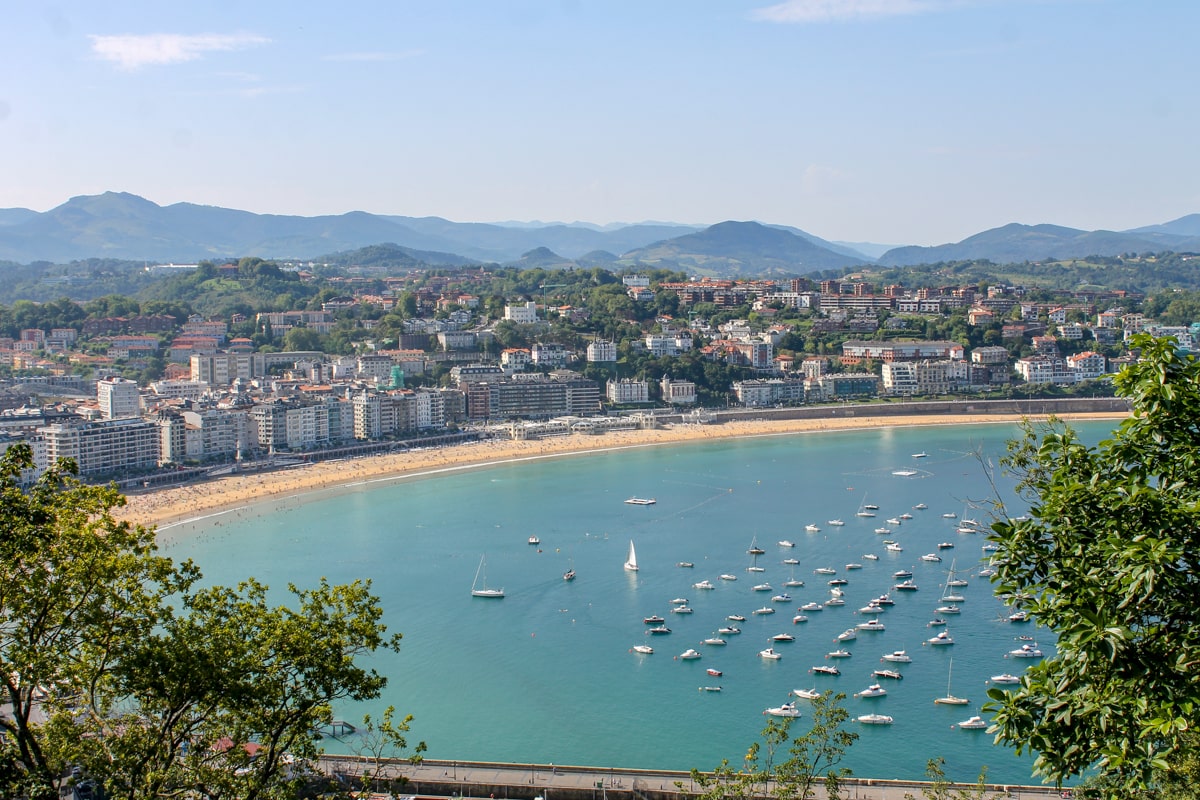
Some would consider San Sebastián one of the most beautiful towns in Spain and Lisa can see why.
When she lived in Bilbao she visited San Sebastián quite a few times and really enjoyed the vibe of the town (and having a beautiful beach so close). Don’t forget to eat some delicious Pintxos since San Sebastián is especially known for them!
The drive from Logroño to San Sebastián takes around 2 hrs by car, and between 2 and 5 hrs by public transport .
Since you are travelling between two smaller cities the connections are not that great and we would recommend planning ahead to compensate for this.
Accommodation in San Sebastián : San Sebastián is one of the most expensive towns in Spain and very popular among luxury travellers.
So, don’t be surprised if accommodations seem a little more expensive overall. That said, you can still find a great place to stay that suits your budget and style if you’re not looking for luxury.
Check here for hotels in San Sebastián .
Specifically, you can check out Casual de las Olas San Sebastián . This hotel is a bit further from the old town and beach but makes up for it in sleek decor, breakfast, and air conditioning.
If you want more of a laid-back guesthouse feel, check out Talaia HT . This authentic and cozy guesthouse is located in the heart of the old town – and has public parking nearby .
If you are looking for a hostel, you can find great hostels across San Sebastián here . Wherever you book, our advice is to book early to find deals and generally save money when booking.
Must-see Attractions in San Sebastián :
- Urgull Hill
- Plays de La Concha
- San Sebastián Cathedral
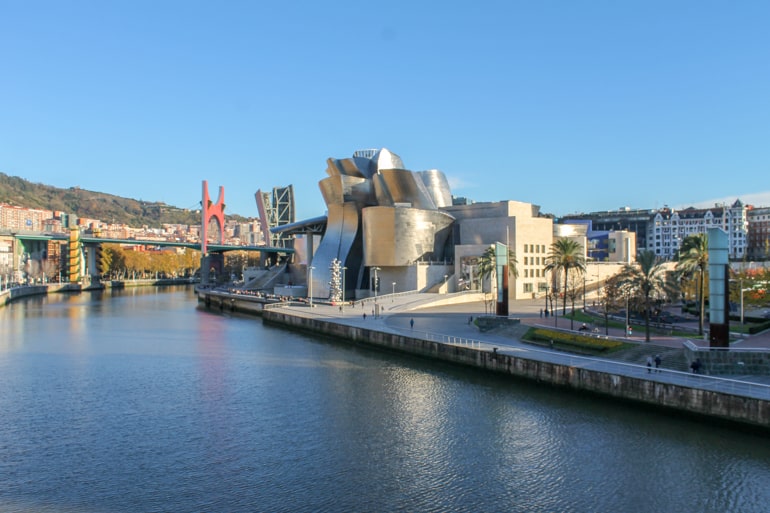
Bilbao has to be one of Lisa’s favourite Spanish cities. Not because it is especially beautiful, but because she lived there for a few months and it felt like home from the beginning. If you get the chance, take the metro to one of the beaches – you won’t regret it!
The drive from San Sebastián to Bilbao is a short and beautiful one as you will drive through some mountainous regions. By car it’ll take you approximately 1 hr 15 min and by bus the journey will be around 1,5 hours .
Bilbao also marks the end of this 5 day Northern Spain itinerary.
Bilbao is a good city to fly out of as it is one of the biggest cities in the region and well connected to bigger airports in other European cities. To get to the airport you can simply take the Airport bus from the bus station at San Mames.
Accommodation in Bilbao : Since Bilbao is a bigger city there is a wider variety of accommodations available.
Check here for apartments and hotels in Bilbao .
Specifically, Hotel NH Bilbao Deusto is a bright and simple hotel with buffet breakfast and private underground parking . Lisa had friends stay there and liked it. It’s not right in the heart of the city centre – but across the water from the Guggenheim Museum!
If you want to stay right in the heart of old town Bilbao, you should definitely check out Ercilla Hotela . This is a very stylish and popular hotel with an amazing rooftop terrace, lounge, also onsite parking , and traditional Basque food in the restaurant!
If you are looking for a cheaper place to stay, Bcool Hostel is a very “cool” hostel in Bilbao. In general, remember to book accommodations closer to the city centre/the river since the rest of Bilbao can be quite hilly!
Must-see Attractions in Bilbao:
- Guggenheim Museum
- The Old Town (Casco Viejo)
- Zubizuri Bridge
*Just so you know, we have a whole detailed guide on Bilbao things to do !
Spain Itinerary 5 Days – Southern Spain Itinerary
If you would like to explore Southern Spain instead of the north, then we would recommend the following 5-day Southern Spain itinerary.
Generally, the south is a little bit warmer than the north so maybe don’t try to do this trip in the middle of the summer heat as it can be quite exhausting!
The itinerary is just over 600 kilometres with a total driving time between 7 and 8 hours depending on your mode of transportation.
Spain Itinerary 5 Days – Southern Itinerary Overview
- Day 1: Málaga
Day 2: Day trip to Granada
- Day 3: Marbella
- Day 4: Cádiz
Day 5: Seville
Day 1: málaga.
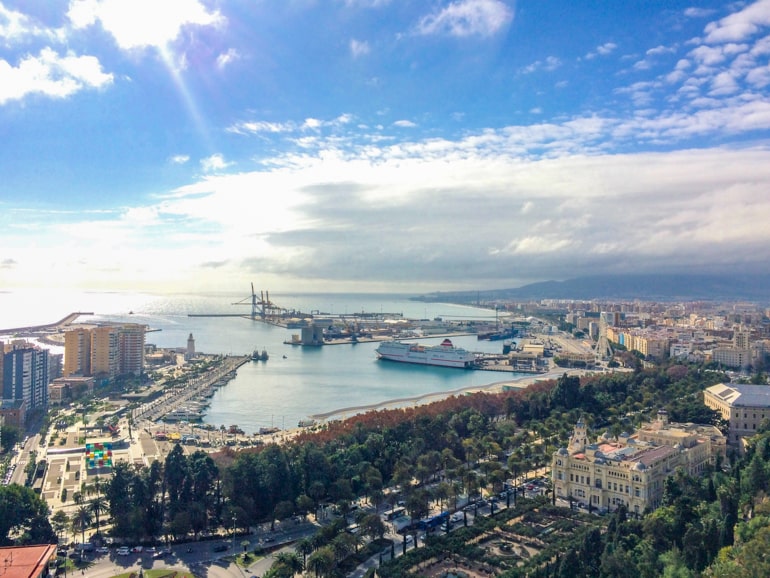
We are starting this itinerary in Málaga since it is an easy airport to fly in from other parts of Europe.
When Lisa arrived at the airport the first time she was actually kind of shocked to see that all the signs were written in German as well.
Needless to say, Málaga is a very popular destination among German tourists. It’s also an interesting city to visit in the wintertime !
Lisa didn’t like the city that much (as in wouldn’t want to live there), but it is definitely worth exploring for a day or two. It is also quite easy to get from the airport to the city centre by public transport. You can find your rental car from Malaga here .
Accommodation in Málaga: Malaga is a popular tourist destination in the south of Spain and so there are lots of different accommodation options. That said, apartment rentals are a very popular option.
Check here for apartments or hotels in Malaga .
Specifically, if you want a hotel, check out Hotel Boutique Teatro Romano . This minimalist design hotel is bright and clean and offers an excellent breakfast while being located right in the heart of the city centre.
If you are planning to stay in Malaga a bit longer, check out Apartamentos Nono . Located close to the beach and a quick walk to the city centre, these apartments have kitchenettes for smaller meals, terraces, and onsite private parking .
If you are searching for a hostel, Malaga has lots. You can search for hostels in Malaga here . When visiting Malaga with a friend, Lisa stayed at Casa Al Sur Terraza .
Even though it’s a “hostel”, it’s a popular place to stay in Malaga. They have private rooms and a lovely rooftop terrace. She and her friend stayed in a private room and loved it!
Just remember for this itinerary, wherever you book you will need to stay for 2 nights !
Must-see Attractions in Málaga:
- Alcazaba Palace
- Picasso Museum
- Cathedral of Málaga
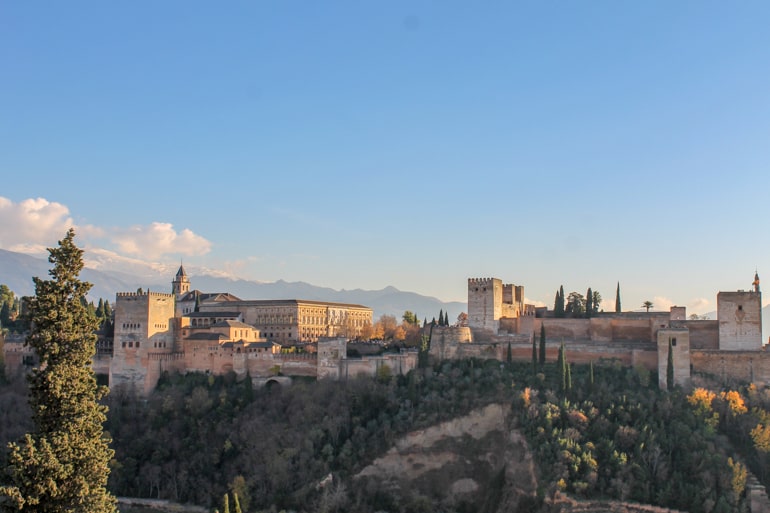
Today you’ll take a day trip to Granada. If you decided to rent a car you can do this by car, but then have to find parking in Granada. Lisa and her friend took the bus to Granada which was pretty easy to do since there are frequent buses throughout the day.
In Granada, you HAVE to go see La Alhambra. Make sure to book your ticket in advance (since there is only a limited amount of spots per day).
Lisa and her friend had to pick up her tickets at an office in the city before going to the actual attraction. Double-check your ticket since you might have to do that, too!
The journey from Málaga to Granada is approximately 1.5 hrs by car and 2 hrs by bus .
Accommodation in Granada: You won’t need a place to sleep in Granada since you’ll be returning to Málaga at the end of the day.
But IF you are curious – check out Hotel Granada Center or Granada Five Senses Rooms & Suites for two great hotels in the heart of the historic city centre!
Must-see Attractions in Granada:
- Alhambra Palace
- Albaicín District
- Cathedral of Granada
Day 3: Marbella

On the third day of this 5 day Southern Spain itinerary, you’ll drive from Málaga to Marbella. Marbella is a city by the water and part of the well know Costa del Sol. It is one of the most popular tourist cities in the region mainly due to its nice beaches and climate.
Since Marbella is quite close to Málaga the drive won’t be long – giving you more time to explore the city and relax at the beaches. The journey takes approximately 1 hour by car (there are different routes some of which include toll roads) and 1.5 hours by bus .
Accommodation in Marbella : Since the tourism industry is quite developed in Marbella, there are lots of amazing sunny accommodations to choose from.
Check here for hotels and apartments in Marbella .
Specifically, Paloma Blanca Boutique Hotel is a gorgeous (and affordable) boutique hotel with breakfast and free private parking onsite.
If you are looking for more of a beach resort, Amàre Beach Hotel Marbella is a beautiful all-inclusive adult-only beachside resort with breakfast, spa, pool, amazing views, and more!
Must-see Attractions in Marbella:
- The Old Town of Marbella
- Avenida del Mar
- Puerto Banús
Day 4: Cádiz
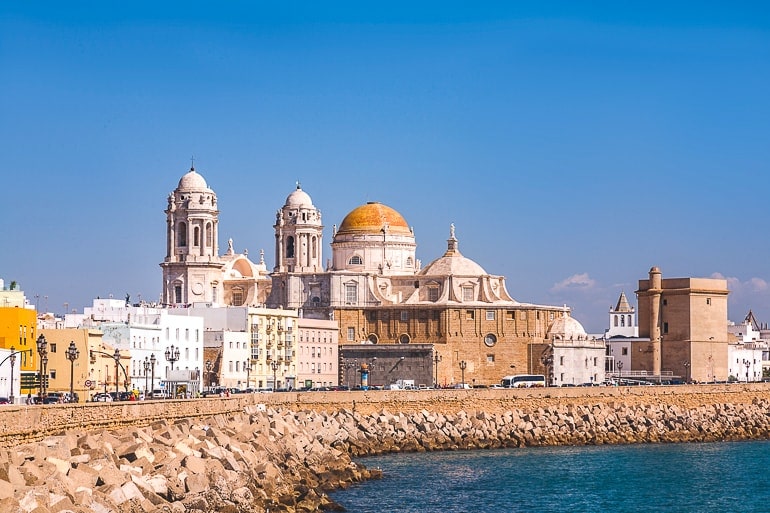
Cádiz is often considered a hidden gem in Spain. Lots of people who have been there seem to love it and Lisa is dying to visit the city.
Fun fact: Some think of Cádiz as the oldest continuously inhabited city in Western Europe. It is just slightly smaller than Marbella with lots of attractions waiting to be explored.
Driving from Marbella to Cádiz by car will take you approximately 2 hours including a toll road and slightly longer if you want to avoid toll roads.
You’ll drive along the coast for a while and could consider stopping along the way. Another option would be to make a pit stop in Gibraltar which you will pass along the way.
Unfortunately, Marbella and Cádiz do not seem to be connected well by public transport and travel between the two cities would involve going back to Málaga and/or through Sevilla (or Seville as the English like to call it).
If it is too much of a hassle for you to get from Marbella to Cádiz, consider skipping it and going straight to Seville instead.
Accommodation in Cádiz: Even though Cádiz is a smaller city, there are plenty of places to stay.
Check here for hotels and apartments in Cádiz .
Specifically, Hotel Boutique Convento Cádiz is a gorgeous hotel in the old town (close to the beach) with a great breakfast and private parking nearby .
Alquimia Albergue-Hotel is a cool and cozy hotel (also in the city centre) close to the beach and also with parking nearby. As for hostels, Cádiz does have quite a few hostels with amazing ratings. You can check here for hostels in Cádiz .
Must-see Attractions in Cádiz:
- Cádiz Cathedral
- Fortress San Sebastian
- Plaza de San Juan de Dios

Seville is another popular destination in Spain and is often considered one of the hottest cities of the country. Therefore we would not recommend going there during July and August if you don’t like extreme heat (Lisa definitely doesn’t).
It is a beautiful city with lots of attractions to check out so be sure to have a good amount of time for exploring. If you don’t end up going to Cádiz, there is more than enough to do in Seville to keep you busy for two days!
Driving from Cádiz to Seville will take you approximately 1.5 hours by car and just slightly longer (1 hr 45 min) by bus . Seville also marks the end of this Southern Spain trip as it has a big airport which makes it super easy for you to fly back home.
Accommodation in Seville : Seville is a bigger and very popular city so there is no shortage of great accommodation options.
Check here for apartments and hotels in Seville .
Specifically, you have to see Petit Palace Puerta de Triana . This very trendy and cool design hotel offers a buffet breakfast and is located right in the city centre close to top attractions.
If you want a more historic stay, Hotel Simon is a more simple and authentic hotel. It’s located in a historic building, also does breakfast, and is also located in the heart of the city centre.
Neither of the above hotels offers parking – but few in the city centre of Seville offer onsite parking (or even public parking nearby).
If you are looking to have parking available, then you can check out La Parada del Marqués . It’s a beautiful guesthouse/hotel also centrally located and offers breakfast options and good connections to public transit!
If you are looking for a hostel, you can search for hostels in Seville here . Again, since Seville is so popular we would advise booking ahead – especially during the high season!
Must-see Attractions in Seville:
- Seville Cathedral
- Plaza de España
Spain Itinerary 7 Days
If you have slightly more time to explore Spain, we have also created two 7-day Spain itineraries for you. You’ll see that once again we give you two options since seven days are – in our opinion at least – still not enough to see the whole country.
Therefore, you’ll find a 7-Day Western Spain Itinerary and a 7-Day Eastern Spain Itinerary below. As always, feel free to modify them to make them fit your exact plans!
Spain Itinerary 7 Days – Western Trip
For this itinerary, the total driving time would be around 14 hours and the distance would be around 1300 km .
These estimates account for the Toledo day trip (and back to Madrid) AND finishing with ONE of either Seville OR Malaga from Córdoba. So, in theory, it could be shorter or longer than we have indicated here on the map!
We’ve already covered some of the places above, but we will mention the important parts again to make it easier for you to plan your exact trip.
Please note that we won’t actually include any places on the west coast of Spain – that would be a whole other trip in itself. Your 7-Day Western Spain Itinerary could look something like this:
Spain Itinerary 7 Days – Western Trip Overview
Day 1: Bilbao
Day 2: burgos.
- Day 3: Salamanca
- Day 4: Madrid
- Day 5: Madrid / Day trip to Toledo
Day 6: Córdoba
Day 7: seville or málaga.
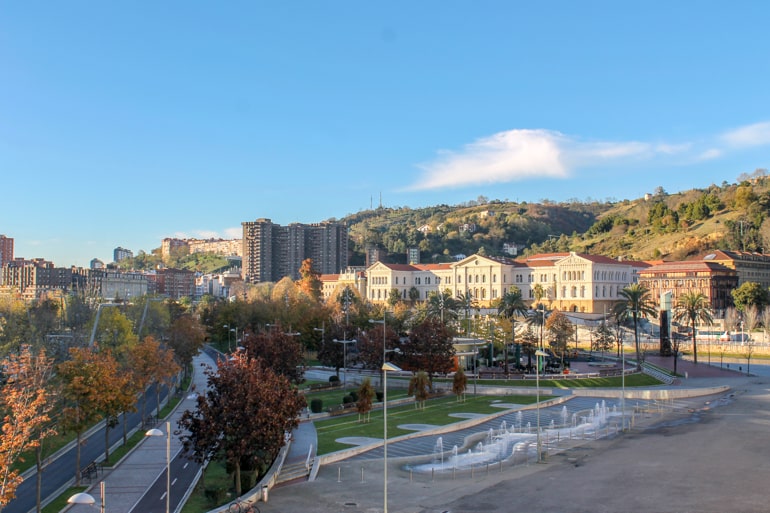
Similarly to how we ended the five-day itinerary in Bilbao, we’ll start this itinerary there as it is a relatively easy airport to fly into from other places in Europe. If you’re starting your longer Spain trip, you can find your rental car in Bilbao here .
Make sure to use your time to explore the Casco Viejo (the Old Town) and walk along the river! There are some great Pintxo places in the Old Town that you should absolutely check out!
Accommodation in Bilbao : Bilbao is a larger city so there’s quite a variety of accommodations available.
Check here for hotels in Bilbao .
Specifically, Hotel NH Bilbao Deusto is a bright and simple hotel with good breakfast and underground private parking . Friends of Lisa stayed there and said they enjoyed it. It’s close to the river across from the Guggenheim Museum but still a quick walk to the old town.
To stay in the heart of old town Bilbao, you have to see Ercilla Hotela . This is a very stylish and popular hotel with a lovely rooftop terrace and lounge, onsite parking , and they even serve traditional Basque food!
As for hostels, Bcool Hostel is a very “cool” hostel in Bilbao. In general, remember to book any hotels or accommodations somewhat closer to the city centre/the river because Bilbao can be quite hilly around the edges!

Burgos might not be a city that is immediately on your radar for places to visit in Spain but we would recommend a stop there on your way south.
Lisa visited Burgos with friends on a day trip from Bilbao so she knows how easy it is to get there. Burgos is a nice city but since there is not a ton to see, one night is the perfect amount of time in our opinion.
Getting from Bilbao to Burgos takes approximately 1.5 hours by car and 2 hours by bus .
Accommodation in Burgos : Burgos is not an overly big city, but you can still find lots of great accommodations.
Check here for hotels in Burgos .
Specifically, Hotel Puerta de Burgos is a popular, trendy, and affordable hotel with private underground parking at the hotel. This makes it a great option if you have a car because it’s a little further from the centre (still quite close) and just off the motorway.
Another great hotel closer to the city centre/attractions is NH Collection Palacio de Burgos . This is an elegant hotel with a great breakfast and private parking, too.
If you want to stay in a hotel that physically faces the famous Burgos Cathedral, check out Hotel Mesón del Cid !
Must-see Attractions in Burgos:
- Burgos Cathedral
- Las Huelgas
- Museum of Human Evolution
Day 3: Salamanca
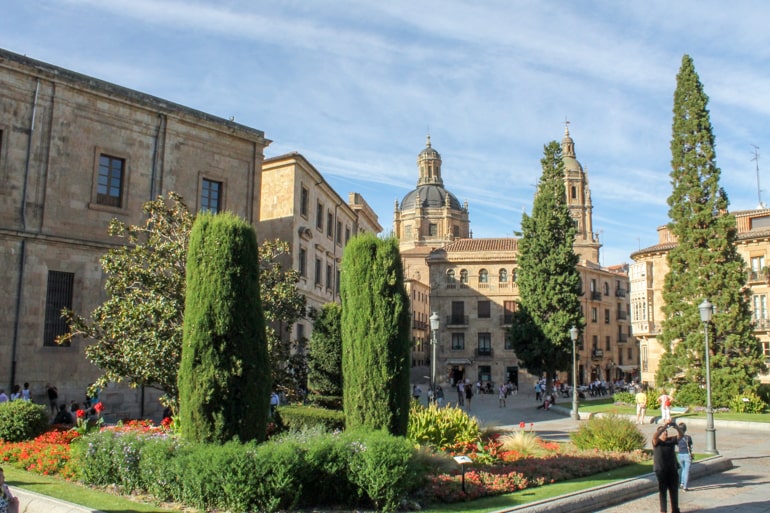
From Burgos, your journey continues to Salamanca – another one of Lisa’s favourite cities in Spain. Salamanca is sometimes called “The Golden City of Spain” and you’ll understand why.
The many sandstone buildings get illuminated beautifully by the sun – making it appear golden. Be sure to bring your camera because you’ll want to use it in Salamanca. Our tip: Cross the river to get amazing photos of the cathedral.
Getting from Burgos to Salamanca is easy and will take approximately 2.5 hours by car or 3 hours by bus .
Accommodation in Salamanca: Salamanca has lots of great accommodations in the city.
Check here for hotels in Salamanca .
Specifically, Hospes Palacio de San Esteban is an authentic-style hotel in the city centre with an incredible breakfast and onsite private parking .
If you are looking for a very affordable hotel with views of the Cathedral, Hotel San Polo is for you. The popular hotel is in a location that doesn’t get much more central! There’s no parking available – making it great if you travel by bus and train only.
When Lisa visited Salamanca on a weekend trip, she stayed in a hostel with friends close to the Old Town and loved it. You can check out the good selection of hostels in Salamanca .
Must-see Attractions in Salamanca:
- Salamanca Cathedral (Old + New)
- Plaza Mayor
- Salamanca University
Day 4: Madrid

Since Madrid is the capital of Spain you shouldn’t miss it on your itinerary. Conveniently it is also quite close and easy to get to from Salamanca.
Since there is so much to see in Madrid one day to explore might not be enough for you. That’s why you might opt for spending two days in Madrid instead.
Lisa has been to Madrid two times now and still hasn’t seen everything there is to see. But at least you’ll get a good sampler!
As mentioned, getting from Salamanca to Madrid is easy. The journey will take approximately 2 hrs 12 min by car (including a toll road) and 3 hours by bus .
Madrid’s main bus station is actually underground which is kind of cool and caused a lot of confusion for Lisa and her friends when they tried to find it the first time.
Accommodation in Madrid : Being the capital city of Spain, Madrid is a popular city with lots and lots of accommodation options. Keep in mind that Madrid has many “hostals” which are technically guesthouses but are basically hotels.
Also, if you have a car don’t be surprised if parking is in a public lot for a high fee – that’s just Madrid.
Check here for apartments and hotels in Madrid .
Specifically, you might want to check out Room007 Select Sol . This charming and trendy hotel is right in the heart of the city, has air conditioning, and serves breakfast at a cafe next door!
If you are looking for a simple stay right in the centre, check out Hostal Madrid . This authentic guesthouse is so centrally located with top attractions and a metro station around the corner.
It’s such good value for money that the two times Lisa travelled to Madrid she actually stayed here both times!
Should you be on the hunt for an actual hostel, you can check here for hostels in Madrid . Keep in mind wherever you book, you will be booking accommodation for two nights.
Must-see Attractions in Madrid:
- Museum Reina Sofia
- Puerta del Sol
Keep in mind we have a whole separate detailed guide on amazing things to do in Madrid !
Day 5: Madrid or Day trip to Toledo
As mentioned, you might opt to spend another day in Madrid since there is so much to see.
If that’s the case read our Madrid guide linked above to get more recommendations. Alternatively, you could opt to go on a day trip to Toledo, a beautiful small city not too far from Madrid.
If you don’t want to drive there yourself, you can choose to book a day tour which includes a tour of Toledo among other things. If you want to drive yourself the journey will take you approximately 1 hour by car and the same amount of time by bus .
Must-see Attractions in Toledo:
- Toledo Cathedral
- Monasterio de San Juan de los Reyes

The next day you will drive to Córdoba, a city in Andalusia known for its famous flower street – among other things of course. There is a lot of history to be found in Córdoba so consider taking a walking tour if you want to learn more about it.
This is one of few routes where you will actually be faster taking public transport as if you were to drive yourself since there is a good train connection between Madrid and Córdoba.
Driving by car takes approximately 4 hours while the journey by train would be slightly shorter with 2 hrs 15 min .
Accommodation in Córdoba : If you’re looking for a hotel, there are lot of options to choose from.
Check now for hotels in Córdoba .
Specifically, Maciá Alfaros is an authentic hotel located right in the heart of the city centre with an incredible swimming pool and easy parking onsite.
Hotel Cordoba Center is an elegant hotel located outside the heart of the centre. It’s still very walkable to the centre, is very close to the train station, and has a rooftop pool with amazing views!
There are quite a few hostels with very good ratings in Córdoba so you can check here for hostels in Córdoba .
Must-see Attractions in Córdoba:
- Mosque–Cathedral of Córdoba
- Alcázar de los Reyes Cristianos
- Historic Center of Córdoba
For this itinerary, you can decide in which city you would like to end your trip. For some, it might be more convenient to fly out of Seville while for others Málaga might be the better option. So it’s really up to you and your preference!
The journey from Córdoba to Seville takes approximately 1 hr 40 min by car and 45 min by train . The time it takes to get from Córdoba to Málaga isn’t much longer with 1 hr 50 min by car and 50 min by train .
Accommodations in Seville : As mentioned above, Seville is a popular city so there is always accommodations to choose from.
Specifically, check out Petit Palace Puerta de Triana . This trendy design hotel offers a buffet breakfast and a really great location in the city centre.
For a historic stay, Hotel Simon is a more simple and more authentic hotel. It’s located in a historic building, does breakfast, and is also located in the city centre.
Neither of the above hotels have parking – but fewer properties in Seville offer onsite parking (or even public parking nearby).
If you are travelling by car and want parking available, then check out La Parada del Marqués . It’s a beautiful guesthouse/hotel also centrally located with breakfast options and good connections to public transit!
If you want a hostel stay, you can search for hostels in Seville here . Regardless of what type of accommodation you book, Seville is popular so we would advise booking ahead – especially during the high season!
Accommodation in Málaga: Malaga is a popular destination in the south of Spain with lots of different accommodation options. That said, apartment rentals are very popular.
Specifically, for hotels, you can check out Hotel Boutique Teatro Romano . This design hotel is bright and clean and offers breakfast while being located right in the heart of the city.
If you are planning for a longer stay, check out Apartamentos Nono . Located close to the beach and a quick walk to the city centre, these apartments have kitchenettes, terraces, and onsite private parking .
If you want a hostel, Malaga has lots. You can search for hostels in Malaga here . When visiting Malaga with a friend, Lisa stayed at Casa Al Sur Terraza .
Even though it’s a “hostel”, it’s a popular place – with private rooms and a lovely rooftop terrace. Her and her friend stayed in a private room and loved it!
Spain Travel Itinerary 7 Days – Eastern Trip
If the other 7-day Spain itinerary doesn’t really appeal to you and you would like to stay closer to the coast, maybe this itinerary is more to your liking. The driving time would be just shy of 11 hours and would be approximately 1000 km driving distance !
Spain Itinerary 7 Days – Eastern Trip Overview
- Day 1+2: Barcelona
Day 3: Valencia
- Day 4: Alicante
- Day 5: Murcia
Day 6: Granada
Day 7: málaga, day 1 + 2: barcelona.
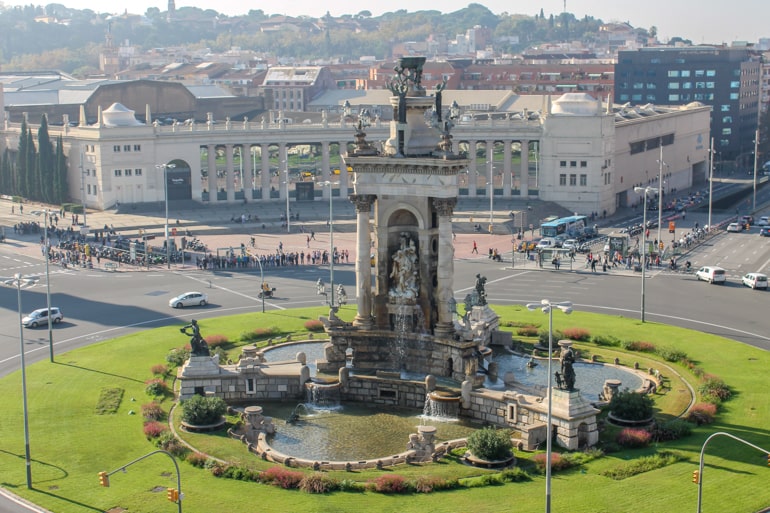
Once again, this itinerary starts in Barcelona since it is one of the easiest airports to fly into. Since you have a little bit more time with this itinerary you’ll stay in Barcelona for two days.
There is lots to see so you still won’t see everything, but definitely more than in just one day. To then continue on with this itinerary through Spain, you can find your rental car in Barcelona here .
Accommodation in Barcelona: As mentioned above, there are lots of hotels and apartments in Barcelona.
For hotels, you might like Catalonia Born Hotel with a boutique style and rooftop pool close to the beach in the city centre.
If you travel by car, Sallés Hotel Pere IV is an affordable hotel with spa in the heart of the city with a private parking garage .
As for hostels, you can check here for Barcelona hostels . We liked Kabul Hostel . Wherever you stay, remember to book in advance because the city does fill up and it can get expensive! And remember, you’ll be staying at this place for two nights .
- Las Ramblas

The third day of this Spain itinerary will take you from Barcelona to Valencia which is another city on Lisa’s favourite list.
It was actually the first Spanish city she visited and she fell in love with the city and its people right away. Her favourite part is that there is a huge part in what was formerly a river that stretches through a big part of the city.
In order to get from Barcelona to Valencia, you’ll drive along the coast for 3.5 hours by car and around 3 hrs 15 min by train.
Accommodation in Valencia: Since Valencia is a bigger city, you are sure to find accommodations that work for you.
Check here for hotels in Valencia .
Specifically, Petit Palace Ruzafa is a bright and boutique hotel right in the city centre.
They offer healthy breakfast options and free bike rentals. There’s no parking making this a great hotel for those travelling without a car.
If you want a place right on the beach, check out Hotel Miramar . This cool beachfront hotel has a bar and restaurant right downstairs and has paid parking onsite . If you are looking for a hostel, you can check here for hostels in Valencia .
Must-see Attractions in Valencia:
- City of Arts and Science
- Lonja de la Seda
- Cathedral of Valencia
Day 4: Alicante
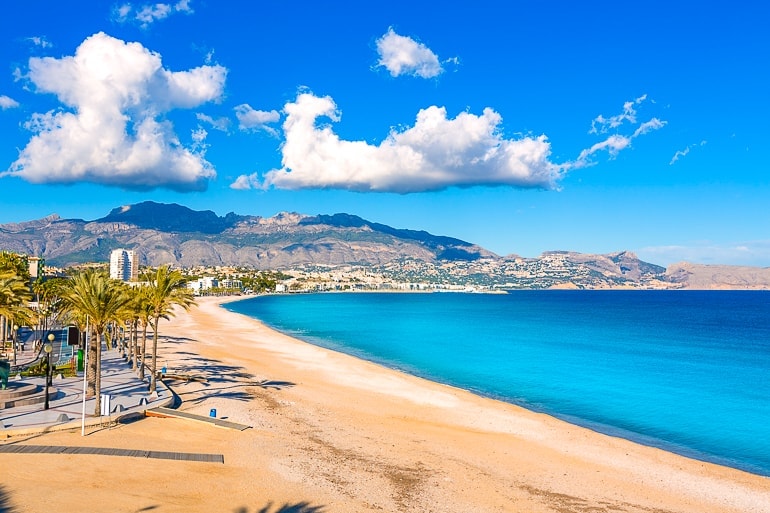
Alicante is a popular holiday town that lots of Europeans visit to enjoy the nice weather and the beaches. Maybe you have heard of the name Costa Blanca?
Alicante is part of that exact region. When you’re there don’t forget to check out some of the nice beaches – but of course, there are also lots of other things waiting to be explored.
Getting from Valencia to Alicante won’t take overly long. The drive will take approximately 2 hours by car and 1.5 hrs to 2.5 hours by train or bus respectively.
Accommodation in Alicante: Alicante is a popular city due to its great location on the coast.
Check here for hotels in Alicante .
If you want to stay directly on the beach, Hotel Almirante is a bright and stylish hotel with breakfast buffet. It’s a bit farther from the city centre, but there is free onsite parking if you have a car.
If you want more of a resort style, Melia Alicante is also located right on the beach with stunning views over the water. It’s much closer to the centre of the city and has good amenities (pool), paid parking next door, and a really good breakfast!
You can also find a good mix of hostels in Alicante. In any case, don’t forget to book ahead in the summertime since it can get very crowded.
Must-see Attractions in Alicante:
- Castle of Santa Barbara
- Casco Antiguo (Old Town)
- Beaches such as Playa Postiguet
If you’re heading for Alicante to get some sunshine, we’ve got a guide on things to do and see in Alicante that includes some great food tips for you to check out!
Day 5: Murcia
Murcia is a city in the southeast of Spain and the capital of the region with the same name. Travellers who don’t know much about Spain (yet) might not have heard of the city before but this doesn’t mean it is not worth a visit.
The drive from Alicante to Murcia is quite short with 1 hr by car and 1 hr 10 min by bus . This will give you a good amount of time to explore the university city and get a rest from all the driving.
Accommodation in Murcia: Since Murcia is a less touristy city you’ll find great places to stay and (generally) fewer crowds.
Check here for hotels in Murcia .
Specifically, the Hesperia Murcia Centro is a clean and modern hotel right in the city centre near the Cathedral. There’s also private onsite parking and a tasty breakfast.
If you want to stay closer to the coast – you could stay in Cartagena (about 30 minutes away from Murcia). Here, check out NH Cartagena – with bright, sea views and parking all in a great location.
Must-see Attractions in Murcia:
- Murcia Cathedral
- Floridablanca Gardens
- Monteagudo Castle
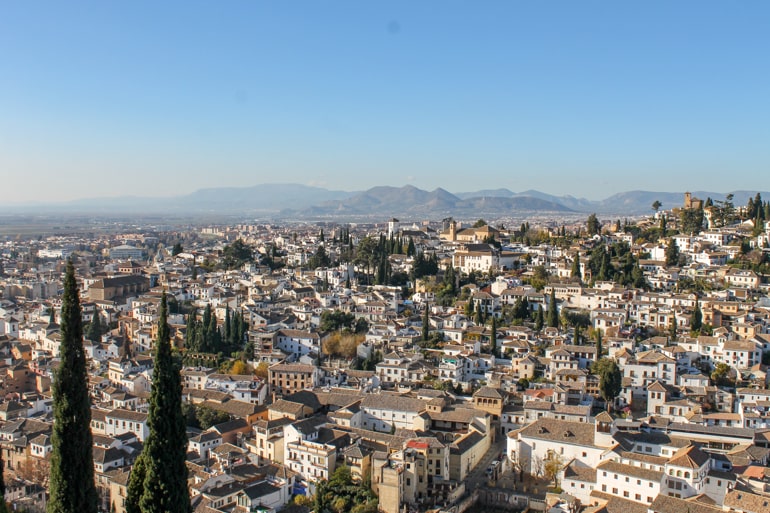
From Murcia, your journey will continue to Granada, a city which we have mentioned quite a few times by now so we won’t go into details again. If you haven’t yet, make sure to get your Alhambra tickets in advance!
Driving from Murcia to Granada will be a slightly longer trip with 2 hrs 45 min by car and around 3.5 hrs by bus .
Accommodation in Granada: Since Granada is a popular travel destination, many accommodations are available.
Check here for hotels in Granada .
Specifically, Hotel Granada Center is a VERY popular hotel with great breakfast, a very central location, and private underground parking onsite .
Also situated in the city centre is Granada Five Senses Rooms & Suites – a sleek and modern hotel with small rooftop pool with great views of the historic old town! If you are looking for a hostel, you can check here for hostels in Granada .
Since we have mentioned Málaga countless times above, there is not much to add. As you probably know by now Málaga has a great airport to fly out of so this is where this 7-day Eastern Spain itinerary ends.
The journey from Granada to Málaga is approximately 1,5 hrs by car and 2 hrs by bus .
Accommodation in Málaga: Malaga is a popular tourist destination in Spain so there are lots of available accommodations – with apartments being the most popular.
For hotels, check out Hotel Boutique Teatro Romano . This minimalist design hotel is bright and offers a great breakfast while being located right in the city centre.
For longer stays, check out Apartamentos Nono . Located close to the beach and to the city centre, these apartments have kitchenettes for small meal prep, terraces, and onsite private parking .
If you are searching for a hostel, you can search for hostels in Malaga here . When visiting Malaga with a friend, Lisa stayed at Casa Al Sur Terraza .
It’s a popular place to stay in Malaga with private rooms and a great rooftop terrace. She and her friend stayed in a private room and really liked it!
Spain Itinerary – 14 Days
This road trip would be a beast. As planned above with the scheduled day trips you’d cover around 2600 kilometres .
The driving time would be around 27 hours and 30 minutes – but of course, this varies by traffic and which day trips/stop days (beach days) you opt to take, etc.
If you swung down to Gibraltar at the end and then went to Granada and Malaga, it could very well be a tad longer.
You should also consider the price of renting a car for two weeks to see if there are any companies that offer discounts!
Compare prices for your car rental from Bilbao here .
Since you have read about most of these places in some of the itineraries above we’ll keep this one short.
Our version is written from north to south, so from Bilbao to Málaga. As with most of our itineraries, you can reverse the direction if you feel like it So, to really see the whole country, your updated 14-day Spain itinerary might look something like this:
14-Day Spain Itinerary Overview
- Day 2: Day trip to Santander, Vitoria-Gasteiz or Beach Day
- Day 3: Donostia-San Sebastián
- Day 4: Zaragoza
Day 5+6: Barcelona
Day 7: valencia, day 8+9: madrid.
- Day 10: Toledo or Córdoba
Day 11: Seville
- Day 12: Seville or Day trip to Cádiz/ Gibraltar
- Day 13: Málaga (or Granada)
- Day 14: Málaga
Once again we are starting this itinerary in Bilbao since it is an easy city to get to. There are quite a few things to see and delicious foods to try so with this itinerary you have slightly more time to explore the city!
Accommodation in Bilbao: Once again, Bilbao is a bigger centre in Spain so you’ll find lots of accommodations to suit many different styles and budgets.
Specifically, Hotel NH Bilbao Deusto is a bright hotel with breakfast and underground private parking . Friends of Lisa stayed here and enjoyed it. It’s the river from the Old Town – but it’s a nice area and a quick walk to everything.
To stay in the centre of Bilbao’s historic old town, check out Ercilla Hotela . This is a very stylish hotel with a great rooftop terrace/lounge, onsite parking , and food onsite, too.
If you are wanting a hostel, Bcool Hostel is a great option in Bilbao. Just remember: when booking any accommodations in Bilbao, try to book in the centre or near the river since the edges of the city can be very hilly!
Since the next day in this itinerary is a day trip we’d suggest booking your accommodation in Bilbao for two nights !
Day 2: Day Trip to Santander, Vitoria-Gasteiz or Beach Day
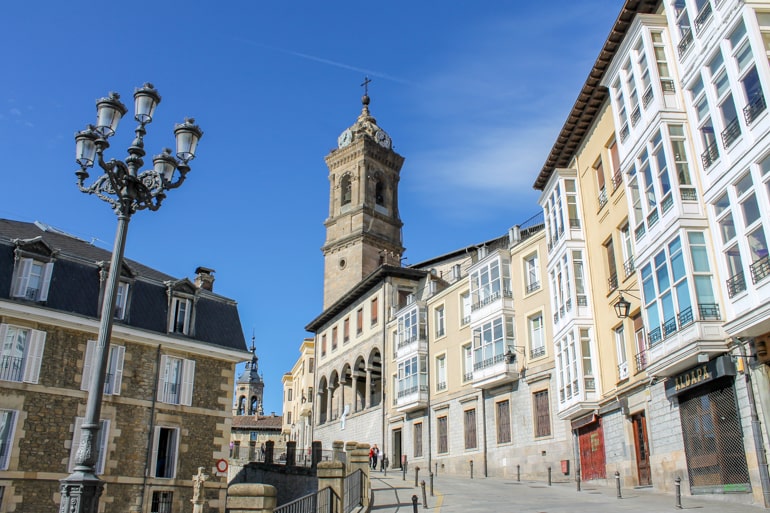
To give you the chance to see a bit more of the region we recommend a day trip to either Santander or Vitoria-Gasteiz, the capital of the Basque Country.
Alternatively, you can also opt to spend the day at the beach if the weather is nice (more on that below!) or use the time to see more of Bilbao.
Getting to Santander from Bilbao takes approximately 1 hr 15 min by car and 1.5 hrs by bus . The journey to Vitoria-Gasteiz is slightly shorter, taking approximately 1 hr by car and the same amount of time by bus .
Must-see Attractions in Santander:
- Palacio de la Magdalena
- Centro Botin
- Sardinero Beach
Must-see Attractions in Vitoria-Gasteiz:
- Catedral de Santa María
- Iglesia de San Miguel
If you opt for a beach day instead, we would recommend Sopelana beach. It is easy to reach by metro. Just take the line no 1 in the direction of Plentzia and get off at the Sopelana stop.
From there you can either walk or take the bus to the beach. It’s Lisa’s favourite beach in the Bilbao area since it looks beautiful and is not too crowded. It’s also a great stop to try some surfing.
Day 3: Donostia-San Sebastián
The next stop on your 14-day Spain itinerary is San Sebastián – a city we have already mentioned before. Beautiful beaches and delicious pintxos await you!
The drive from Bilbao to San Sebastián takes around 1 hr 15 min by car and 1.5 hrs by bus . There are very frequent buses by lots of different operators between these two cities.
Accommodation in San Sebastián : San Sebastián is one of the more expensive towns in Spain. It’s also very popular among luxury travellers. So, don’t be surprised if accommodations seem a little more expensive overall.
Specifically, check out Casual de las Olas San Sebastián . This hotel is a bit further from the old town and beach but makes up for it with sleek decor, breakfast, and air conditioning.
If you want more of a laid-back feel, check out Talaia HT . This authentic and cozy guesthouse is located in the heart of the old town – and has public parking nearby .
If you are looking for a hostel, you can find hostels across San Sebastián here . Wherever you book, our advice is to book accommodations early. Generally, you save money when doing that.
Day 4: Zaragoza
Day 5 of this itinerary will take you to Zaragoza, a city mentioned in the 5 day Northern Spain itinerary. The drive will be a bit longer but you’ll still have enough time to check out some of the attractions Zaragoza has to offer.
Driving from San Sebastián to Zaragoza will take approximately 2 hrs 45 min by car (including a toll road) and around 4 hrs by bus .
Accommodations in Zaragoza: Zaragoza is a smaller city but there are still lots of really great accommodation options.
Specifically, check out Hotel Sauce . This bright hotel is located right in the city centre and has buffet breakfast, air conditioning, and private parking onsite for those with a car in Spain!
If you want a hotel with a rooftop pool, Hotel Palafox is for you! Also situated right in the heart of the city, the hotel has a unique decor, city views, a nice breakfast, and also has parking and air con!
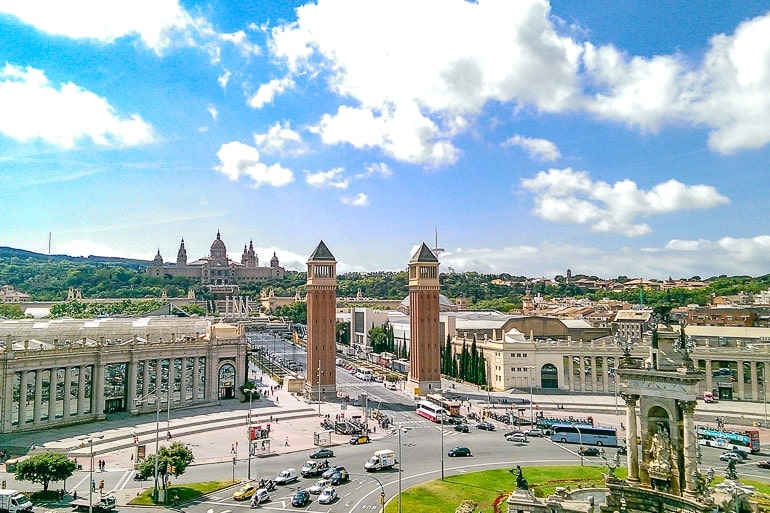
A tour across the country wouldn’t be complete without including Barcelona. Since there is so much to see you’ll be spending two nights in the city to give you enough time.
The drive from Zaragoza to Barcelona will take you approximately 3 hrs 10 min by car (includes a toll road), 3.5 hrs by bus and 1.5 hrs by train .
Accommodation in Barcelona : As mentioned above, you’ll find loads of great hotels and apartments in Barcelona.
If you are looking for a hotel, check out Catalonia Born Hotel with a boutique style and rooftop pool in the city centre (also close to the beach).
If you travel by car, Sallés Hotel Pere IV is a lovely and affordable hotel with a spa that is located in the heart of the city and has a private parking garage onsite .
As for hostels, you can check out Barcelona hostels here. Specifically, we enjoyed Kabul Hostel . Hostel or hotel – just remember to book early because Barcelona is a popular city. Also remember that for this itinerary, you’ll be staying over for two nights .
And we’re back in one of Lisa’s favourite cities. The drive from Barcelona to Valencia will be a bit longer but it is worth it (in our opinion at least).
Driving from Barcelona to Valencia will take around 3.5 hrs by car (including a toll road), 3 hrs by train and 4 hrs 15 min by bus .
Accommodation in Valencia: Since Valencia is a bigger city, you’ll find accommodations that work for your style and budget.
Check now for hotels in Valencia .
Specifically, Petit Palace Ruzafa is a boutique hotel very much in the lovely city centre. They offer healthy breakfast, free bike rentals, and no parking – making it great for travellers without a car!
If you’re looking to stay right the beach, you’ll likely love Hotel Miramar . This cool beachfront hotel has a bar/restaurant right downstairs, ocean views, and has paid parking onsite . If you want to stay in a hostel, you can check now for hostels in Valencia .
Must-see Attractions in Valencia:
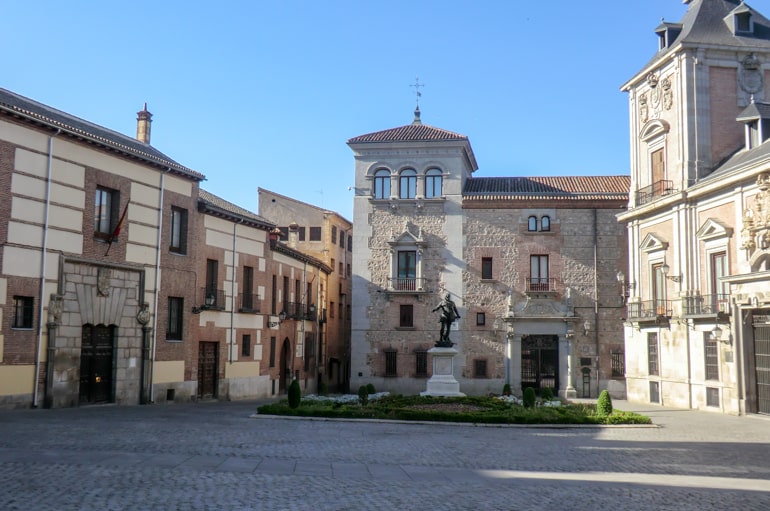
Of course, you can’t forget about the capital of the country when going on a trip through Spain.
Since there is so much to see and do you will spend two nights in Madrid. This will also give you some time to recover from the long driving days you’ve had.
Driving from Valencia to Madrid takes approximately 3.5 hrs by car and slightly less than 2 hrs by train .
Accommodation in Madrid : Being the capital city of Spain, Madrid is a popular city with lots of accommodations.
Keep in mind that Madrid has “hostals” which are technically guesthouses but are basically hotels. Also, parking can be very expensive per day but that’s just Madrid for you.
Specifically, check out Room007 Select Sol . This charming and trendy hotel is right in the heart of the city, has air conditioning, and serves breakfast at a cafe next door. You are very much in the city centre here!
If you are looking for more of a guesthouse stay right in the centre, check out Hostal Madrid .
This authentic accommodation is so centrally located with attractions and the metro close by. It’s good value for money – the two times Lisa travelled to Madrid she actually stayed here both times!
Should you want an actual hostel, there are loads of hostels in Madrid. You can check here for hostels in Madrid . Keep in mind wherever you book, you will be booking this accommodation for two nights if you are following this itinerary.
*We have written in-depth about many of the attractions you can visit in Madrid in our things to do in Madrid guide!
Day 10: Toledo or Córdoba
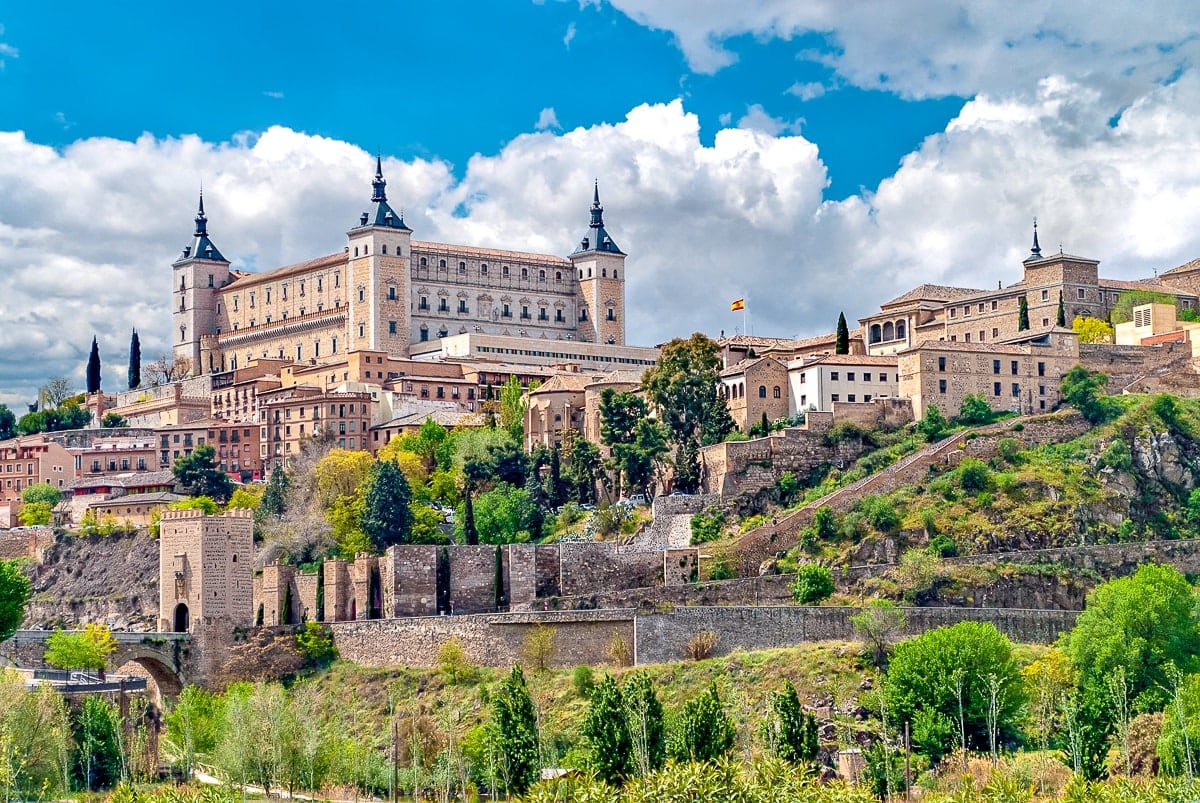
For the next stop on your itinerary, you can decide where you would like to stop. From Madrid you are driving further south and both Toledo and Córdoba would be great options for a stop on the way to Seville.
The drive from Madrid to Toledo will be short and only take an hour by car or bus . The drive from Madrid to Córdoba is a lot longer and takes approximately 4 hrs by car and 2 hrs by train .
While this drive would be longer, your drive the next day would be significantly shorter from Córdoba than from Toledo.
Accommodation in Toledo: If you choose to stay in Toledo, you can check here for hotels in Toledo .
Specifically, you have to check out Hotel Santa Isabel – an authentic and charming Spanish hotel in the heart of the city with an incredible rooftop terrace, good breakfast, and private parking under the hotel if you need it.
Accommodations in Córdoba: If you end up in Córdoba, you can check now for hotels in Córdoba .
Specifically, Maciá Alfaros is an authentic hotel located right in the heart of the city with a nice swimming pool and parking onsite.
Hotel Cordoba Center is an elegant hotel located just a short walk to the centre. It’s location is very close to the train station – and there is a lovely rooftop pool with city views!
There are also many hostels with very good ratings so you can check here for hostels in Córdoba .
On day 11 you will drive from either Toledo or Córdoba to Seville – a city we have mentioned multiple times now because it is very much worth the visit.
If you ended up staying in Toledo, it’ll take you 4.5 hrs by car and 4 hrs by train to get to Seville. If you stayed in Córdoba it’ll only take you 1.5 hrs by car and 45 min by train to get to Seville.
Accommodation in Seville : As we have mentioned above a bunch of times, Seville is a big and popular city so you’ll have no shortage of accommodations to pick from.
Check here for hotels in Seville .
Specifically, we like the look of Petit Palace Puerta de Triana . It’s a trendy design hotel with a buffet breakfast located right in the city centre close to top sights!
If you want more of a “historic stay”, Hotel Simon is a simple and authentic hotel located in a historic building!
They also do breakfast and are also located in the city centre. So you know: neither of the above hotels have parking – but not that many hotels in the city centre offer onsite parking (or even nearby public parking).
If you have/rent a car and need parking available, we’d say check out La Parada del Marqués . It’s a beautiful guesthouse/hotel also quite conveniently located but they also have parking, breakfast options, and good connections to public transit!
Should you be looking for a hostel, you can search for hostels in Seville here .
Again, since Seville is very popular so we would advise booking any accommodations ahead of time – especially during the high season! Remember, you’ll stay for two nights if you follow this itinerary!
Day 12: Seville or Day trip to Cádiz/ Gibraltar
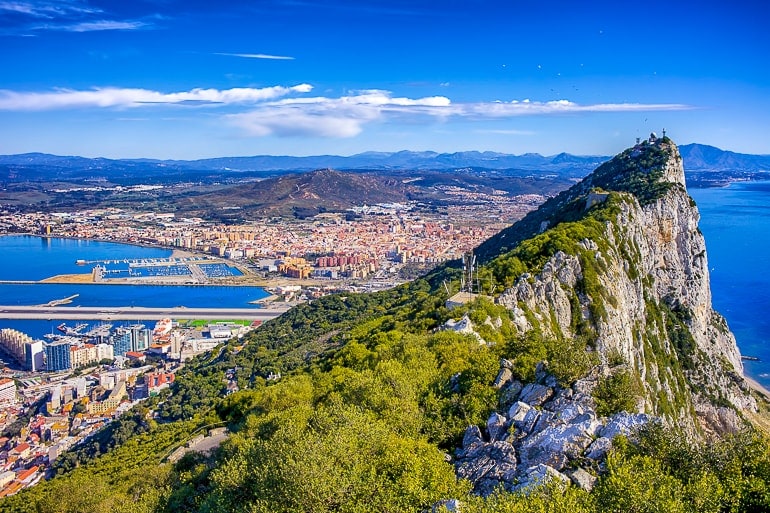
Since there is a lot to see and do in Seville, you have the option to stay another day to explore more of what the city has to offer.
If you’d prefer to see a different place you can consider day trips to either Cádiz or Gibraltar. Know that Gibraltar is not officially part of Spain but belongs to the United Kingdom instead.
It’ll take you around 1.5 hrs by car or train to get from Seville to Cádiz. To get from Seville to Gibraltar it’ll take between 2 and 3 hrs by car .
There does not seem to be any public transport between Seville and Gibraltar since it is another country, but you can participate in an organized tour from Seville to Gibraltar .
Must-see Attractions in Gibraltar:
- Rock of Gibraltar
- Great Siege Tunnels
- The Old Town
Day 13: Málaga (or Granada)
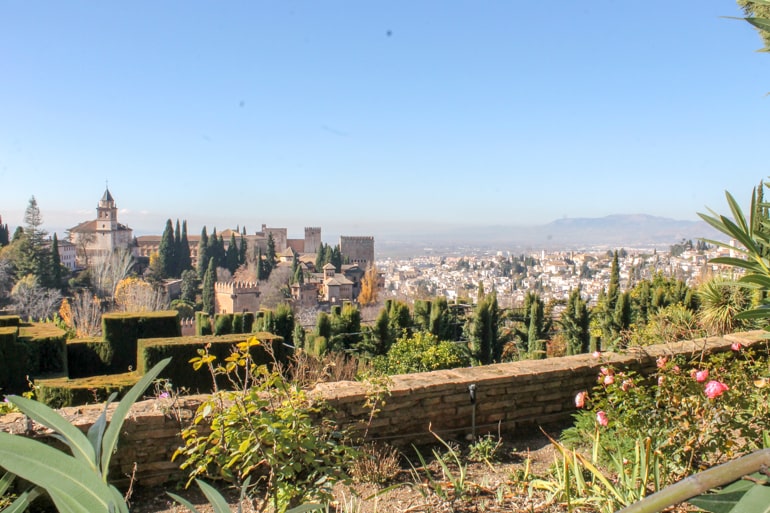
On your second to last day of this itinerary, you will drive from Seville to Málaga, a route we have mentioned quite a few times by now up above.
If you really wanted to visit Granada you could also drive there instead. You could then make the trip to Málaga at the end of the day or the next day.
The journey from Seville to Málaga will be approximately 2.5 hrs by car and 2 hrs by train. Whatever city combo you choose, just remember to book the right amount of nights in cities (one or two) for the end of your itinerary (keeping in mind where you fly out)!
Accommodation in Málaga: As a popular city in the south, Malaga has lots of places to choose from when it comes to accommodation options.
For hotels, have a look at Hotel Boutique Teatro Romano . This lovely design hotel offers breakfast – and it’s very centrally located in the heart of the city!
For an apartment rental (maybe for a longer stay), check out Apartamentos Nono . Located close to the beach and a quick walk to the city centre, the apartments have kitchenettes, terraces, and private parking onsite (if you travelling by car).
Malaga also has lots of hostels if you like. You can search for hostels in Malaga here . Lisa stayed at Casa Al Sur Terraza when travelling to Malaga with a friend.
For a “hostel”, the Casa is a very popular place to stay with private rooms and a sunny rooftop terrace. Lisa and her friend booked a private room and enjoyed it!
Accommodation in Granada: Since Granada is popular, many accommodations are available.
Specifically, Hotel Granada Center is a VERY popular hotel with a great breakfast, a very central location, and private underground parking onsite if you have a car.
Also situated in the city centre is Granada Five Senses Rooms & Suites – a modern hotel with a small rooftop pool with views of Granada’s old town! If you want to book a hostel, you can check here for hostels in Granada .
Day 14: Málaga
And this is the end of your two weeks Spain itinerary. Once again Málaga is the city you fly out of since there are lots of great flight connections to other places in Europe.
Alternatively, you could also stay in Seville and visit Málaga on a day trip if the airport in Seville works better for you.
Things to Consider When Travelling in Spain
Before you dive into Spain trip planning, you’ll want to consider a few details. From the currency they use (the Euro) to the weather, public transport, and the best time to visit, we cover a few key areas below to help you prepare.
Best Time of Year to Visit Spain
Spain is a destination that can be visited year-round – you just have to set your expectations right. Lisa visited Malaga with a friend in December and it was quite warm but of course not warm enough to go swimming.
Since the country is quite big and has a diverse geography, there are actually a lot of different climate zones in Spain. Generally, the summers are hot and dry while the winters are mild and quite rainy.
The average maximum temperature for July and August is 30 °C and 17/16 °C in December and January. However, this can vary greatly depending on which city you are visiting (e.g. Granada is always a little bit colder).
We would recommend that you avoid the south – especially Seville – and Madrid in July and August since it can get VERY hot.
And according to Lisa’s Spanish teacher in Bilbao, it would probably also be a good idea to avoid visiting the Basque country during the winter months since it can rain a lot.
In our opinion, the perfect months for visiting Spain would be from March to June and September to the end of October.
Public Transportation in Spain
Spain has a very well-developed long-distance bus system. Lisa was especially impressed by that since in Germany long-distance buses didn’t exist until a few years ago and sometimes it can still be a bit chaotic or unclear.
In Spain, almost every major city has an actual bus station (and not just a signpost). One of the biggest bus companies in Spain is Alsa .
Lisa has used them quite a few times when living in Spain (to go from Madrid to Bilbao for example) and always had a pleasant experience.
In addition to buses, Spain also has a pretty good rail system. You can check the train connections and prices on the RENFE website here .
We would recommend that you always check both buses and trains as sometimes they take approximately the same amount of time and the bus can be significantly cheaper.
In a few areas (such as parts of the Basque country), the buses can be actually a lot faster than the train.
You can reach all of the places mentioned in these Spain itineraries with public transport.
So if you don’t feel comfortable with renting a car in a foreign country you can still follow all of these itineraries. The bus and train stations are often very centrally located so it shouldn’t be a hassle to get into the centre in any of the cities.
Car Rental in Spain
If you would like to rent a car and make these itineraries a road trip that is a great option, too.
Driving in Spain is generally pretty safe – but it can get a little crazy in bigger cities like Barcelona or Madrid. Spaniards also like to speed – but if you are a confident yet careful driver then this shouldn’t be an issue.
Since Spain is such a popular destination, there are lots of different rental car agencies available. Make sure to read the fine print about additional costs in case there are any issues.
You can compare prices for your Spain trip with this handy comparison tool .
In Spain, there are quite a few toll roads which start with an ‘AP’ in the name. If you want to avoid paying tolls you can often find a road that runs in a similar direction.
Generally, your driving time will be longer if you avoid toll roads but you never know which hidden gems you come across on your way.
Travel Insurance for Spain
When visiting Spain you – and especially when renting a car – should get travel insurance.
While you’ll probably be fine, accidents do happen (and Spaniards are more reckless drivers than in other countries) and they can be expensive. That’s why we always travel with insurance.
If you live in a European country and have European health insurance, you can get the blue EU Health insurance card with which you are covered in emergencies. If you don’t have that option, we recommend that you get private travel insurance.
Related Posts
If you are planning your visit to Spain, check out our other posts on travelling, working, and studying in Spain!
- 12 Need to Knows When Travelling to Spain for the First Time
- 11 of The Most Beautiful Cities in Spain
- 17 of the Top Attractions in all of Spain
- Catalonia Road Trip Itineraries
And there you have it – 5 epic itineraries around Spain! Whether you need 5 days or 14, we think you’ll have lots to work with to plan that perfect trip. Lisa is so happy to be able to provide you with her knowledge of the country.
There is still so much to cover – but we think that these itineraries are a great starting point – you may even do the routes as is and see how they go!
As always, Happy Waddlin’, – L&E
- Compare flights on Skyscanner
- Check for Hotel Deals or Book A Hostel
- Get A Rental Car (depending on the destination)
- Research plug types and possibly get a travel adapter
- Go over our packing list
Pin it for later!

As an Amazon Associate we earn from qualifying purchases.
Destinations
Privacy policy
Disclaimer & Affiliate Disclosure
Terms of use
© 2024 Creativlier Media Inc.

The Best Road Trips in Spain and Their Self-Drive Itineraries
March 11, 2021

From rocky volcanic coasts to medieval city charm, driving in Spain can be an absolute joy. After years on the road as a travel writer and resident, I bring you the best road trips in Spain, plus the ultimate Spanish road trip itinerary. Bucket lists at the ready? Let’s go! Updated 2021.
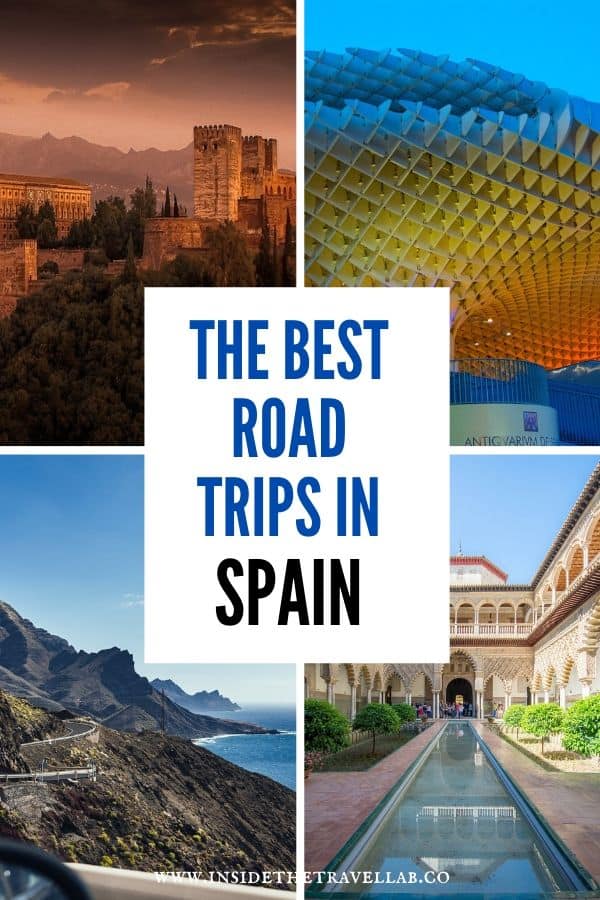
Table of Contents
THE BEST ROAD TRIPS IN SPAIN
If walking is one of the best ways to see a city, then driving is one of the best ways to see a country. Driving in Spain has brought me deep, deep joy, rising through the red dust of Andalusia and plunging through the deep green of Galicia.
You can find the separate road trip itineraries through Spain dotted throughout the article, but this article focuses on the best road trips in Spain.
- Download your free road trip essentials list and road trip packing list.
- Download the road trip planner and toolkit here.
Recommended
I love sharing the best travel resources I can find.
- I never book a flight without looking on Skyscanner first
- My favourite one stop shop for airport transfers, food tours & excursions is Get Your Guide
- Out of the big accommodation machines, I use Expedia and Booking.com the most
- I’ve hand-picked useful travel gear and tools for you in my Amazon shop . Never leave home without a travel adapter or collapsible water bottle . I’d also recommend these soft ear plugs and a sleep mask .
- Access all our planners and budget spreadsheets in the Travel Toolbox ©
- Plan the perfect road trip with our Road Trip Planner & Toolkit ©
- Use these packing cubes to make life so much easier on the road.
- Save on mobile phone roaming charges with an eSIM from Airalo .
TRAVEL SPAIN BY CAR
We start with the ultimate Spain road trip itinerary, taking in the mainland for first time visitors. But don’t forget Spain’s islands, not to mention delving deeper into the regions to find a richer, more authentic experience when you have more time.
Whether you call it fly-drive, self drive or want someone else to help you travel Spain by car, this is the collection of the best road trips in Spain.
Happy planning!
The Ultimate Spain Road Trip Itinerary
If all you have is two weeks, then this is the best Spain road trip itinerary for you. This two week self-drive Spain itinerary brings you the highlights of the country at a reasonable, but not relaxed, pace.
However, I’d always advise that you take is slow if you can. It’s far more enjoyable to spend more time out of the car than in. With that in mind, check out some of the other regional road trip ideas below.
Of all the places in the world, Spain is disinclined to rush. People here like to take their time and savour the joys of everyday life. Racing to fit your busy schedule does not usually rank highly in that regard.
The Ultimate Spain Road Trip Itinerary At a Glance
- Day 1: Arrive Barcelona
- Day 2: Barcelona
- Day 3: Girona and the Pyrenees
- Day 4: Valencia
- Day 5: Valencia to Madrid
- Day 6: Madrid
- Day 7: Madrid to Toledo
- Day 8: Toledo to Granada
- Day 9: Granada and the Alhambra
- Day 10: Alpujarras Mountains
- Day 11: Seville via Cordoba
- Day 12: Seville
- Day 13: Cadiz via Doñana National Park
- Day 14: Malaga to fly home
Historical city centres in Spain were designed for pedestrians and, at a stretch, horses. They were not designed for cars! Be careful when following SatNav instructions into steep, old towns. You can find yourself unable to make some tight turns and then somehow need to reverse backwards down a narrow road. Stick to the main roads in town!
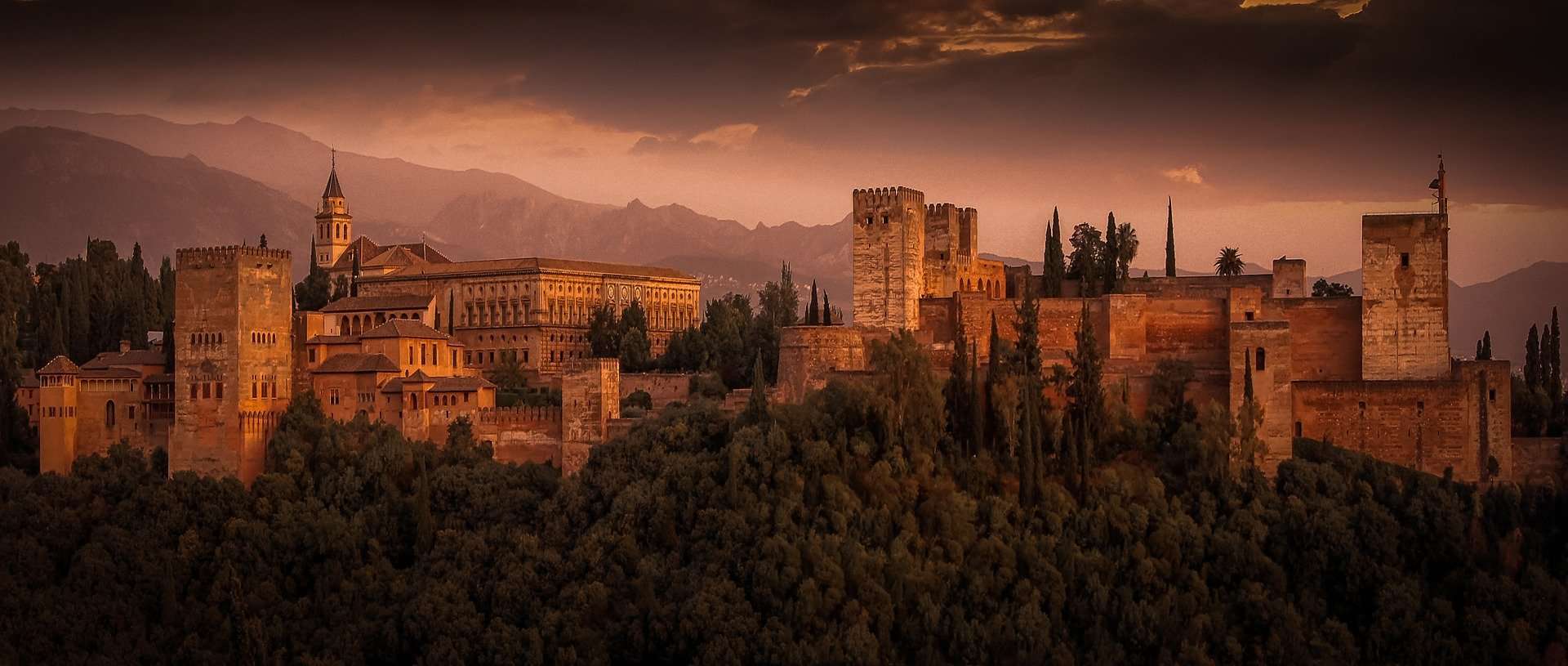
Southern Spain Road Trip Through Andalusia
A road trip through Andalusia, Spain’s biggest region, unsurprisingly covers a lot of ground. This passionate place is the home of flamenco, jamon and sherry, as well as staggering, world-renowned monuments.
You can easily fill two weeks with UNESCO World Heritage Sites like the Alhambra in Granada, the Real Alcazar in Seville and the unbeatable mosque turned cathedral in Cordoba.
But a self-drive road trip through Spain allows you to visit off the radar places and explore local traditions like joining the olive oil harvest in the mountains. From the beaches to the snowy peaks of the Sierra Nevada, driving through Andalusia really is one of the best road trips in Spain.
Andalusia Road Trip Itinerary At a Glance
- Day 1: Arrive Malaga.
- Day 2: Drive to Cadiz
- Day 3: Cadiz to Seville via Doñana National Park
- Day 4: Seville
- Day 5: Seville to Granada via Cordoba
- Day 6: Granada & Alpujarras Mountains
- Day 7: Back to Malaga to fly home. Find the complete southern Spain road trip itinerary here.
- Malaga is the biggest international airport but you can also fly into Seville and Granada with relative ease.
How about the Madrid to Seville drive?
With so many international flights arriving in Madrid, you may be wondering whether or not you should drive from Madrid to Seville or take the train instead.
A Madrid-Seville Road Trip can pass through many off the beaten path destinations, like Zafra and Merida, but in my opinion, it’s not one of Spain’s best road trips.
If you are short on time, I’d highly recommend taking the extremely fast and efficient Madrid-Seville train and then picking up your rental car in Seville to tour Andalusia.
It’s also possible to drive from Madrid to Granada by car, swerving up and down the Alpujarras Mountains, but again, I’d suggest picking up your wheels in Andalusia instead.
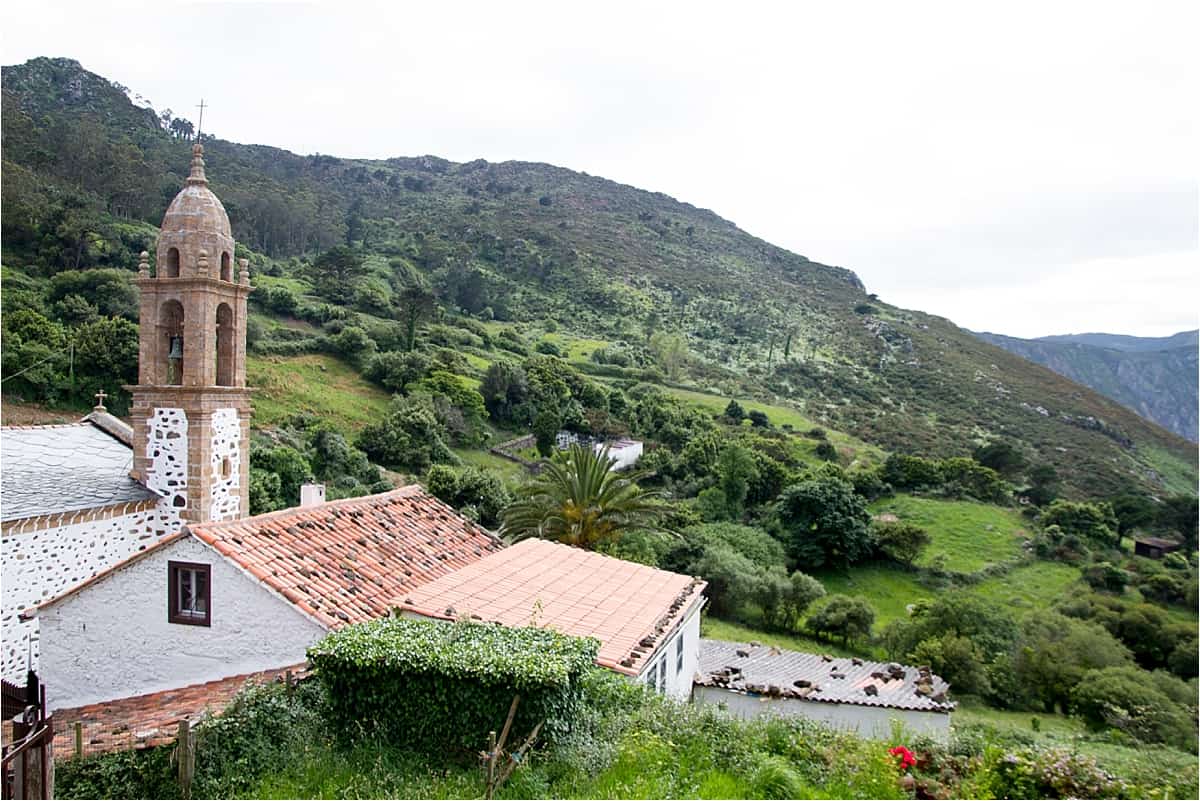
The Sanctuary of Dismembered Wax Body Parts
Northern Spain Road Trip Itinerary
Prepare to be surprised when you find out what makes this one of the best road trips in Spain.
The northern area of Spain swaps dry plains for rocky coves, and bull rings for lighthouses and salt marshes amid the green. Famed for its seafood and as the finishing point for the Santiago de Compostela pilgrimage route, this northern Spain road trip itinerary will show you a different side of the country.
- Want more detail? Explore this Galicia road trip itinerary.
Northern Spain Road Trip Itinerary At a Glance
- Day 1: Arrive San Sebastian
- Day 2: San Sebastian to Bilbao
- Day 3: Bilbao to Aviles
- Day 4: Aviles to A Coruña
- Day 5: A Coruña to Santiago de Compostela
- Day 6: Santiago de Compostela to Vigo
- Day 7: Back to San Sebastian to fly home
Recommended reading: Road Trip Galicia, Spain; The Undiscovered Northern Coast
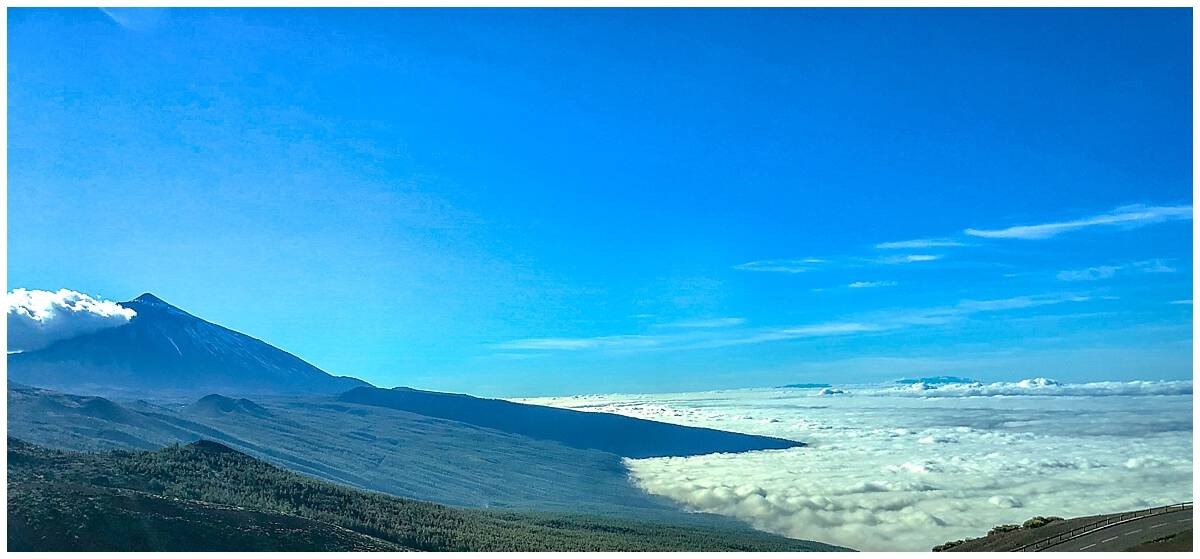
View above the clouds on El Teide in Tenerife
Road Trip Through Tenerife (Canary Islands)
As the largest Canary Island off the northwest coast of Africa, Tenerife is famous for its fly and flop beach holidays. But there are so many unusual things to do in Tenerife , from UNESCO World Heritage cities like Laguna to primitive biosphere reserves in Anaga. It’s a hiking paradise and if tight turns and steep roads don’t phase you, a great wild landscape awaits.
Driving through Spain takes on new and heady heights when you’re bounding over black volcanic stones and watching the clouds appear beneath you. This is one of the best road trips in Spain because it is also one of the most beautiful.
It’s also easy to combine with staying in one place and organising a series of day trips around the island. So if packing and unpacking on a road trip becomes a chore for you, try this instead.
Road Trip Through Tenerife at a Glance
- Day 1: Arrive and stay in UNESCO World Heritage La Laguna
- Day 2: Drive El Teide Volcano
- Day 3: Los Gigantes for a whale watching excursion
- Day 4: Hiking in Anaga National Park
- Day 5: Orotava, Icod de los Vinos and Garachico
- Day 6: Pyramids of Guimar
- Day 7: Explore La Laguna and fly home

Casa Mila: worth it on any Barcelona itinerary
Road Trip Through Catalonia (Catalunya)
Barcelona is the most famous part of Catalunya but to see more of the Catalan character, get behind the wheel and enjoy one of the best road trips in Spain.
Travel by car in Spain to discover the curious city of Girona, the sandy coast of Costa Brava and the smoky peaks of the Pyrenees.
Costa Brava offers volcanoes, sleepy coves and some of the best restaurants in the world. That’s not a boast. That’s actually a validated claim (read more about that here. )
You’ll also find flamboyant artwork from local household name Salvador Dalí, a great spot for a hot air balloon ride and a renewed appreciation for the difference between Catalan and Castilian Spanish.
- How to spend three days in Barcelona, an inside guide
- Unusual things to do in Barcelona
Road Trip from Barcelona At a Glance
- Day 3: Barcelona to Girona
- Day 4: Figueres and Cadaques
- Day 5: Garrotxa Natural Park
- Day 6: Tarragona
- Day 7: Return Barcelona to fly home
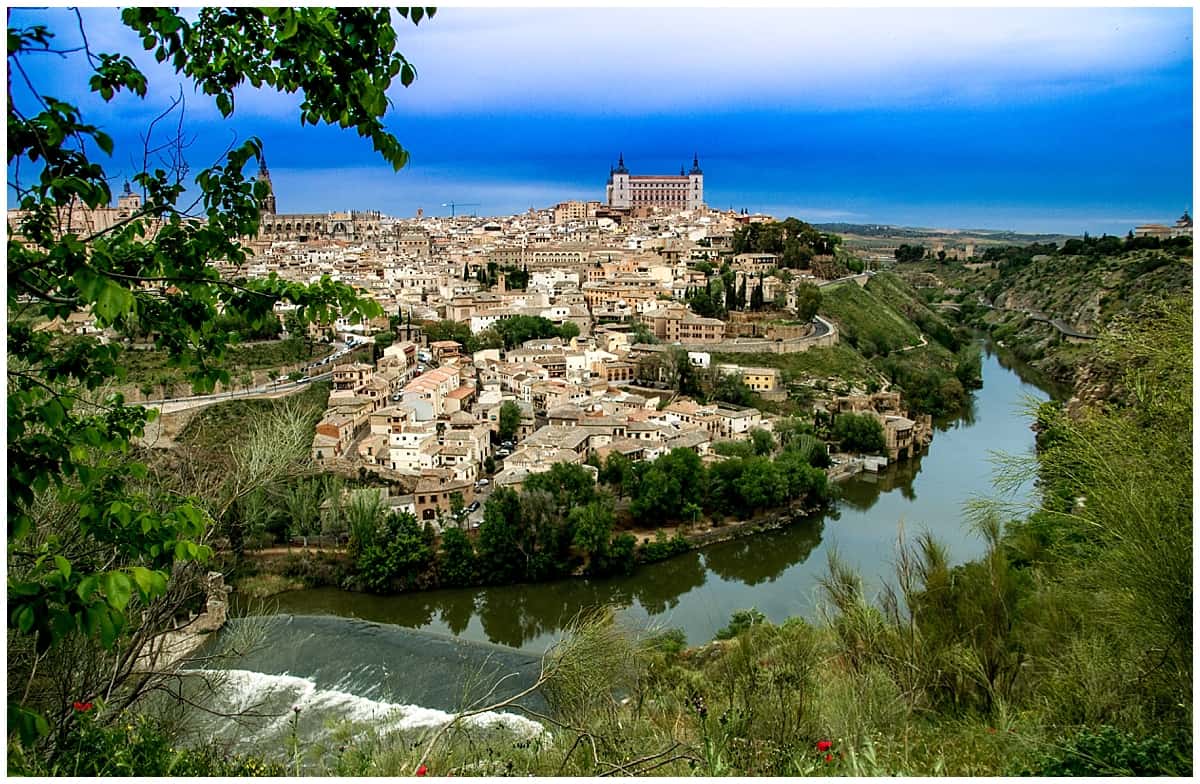
Road Trip Through Central Spain
Treat yourself to a literary, gastronomic and thoroughly authentic journey through this central part of Spain, the region of Castilla La Mancha. It’s one of the best road trips in Spain for hidden gems and a sense of exploration.
Take in Toledo, the former capital and UNESCO World Heritage Site. Search the hills for the windmills made famous by Don Quixote. Hike through one of the best bird reserves in the country. And relish taking your time amid small Spanish villages, far from the crowds.
Road Trip Through Central Spain at a Glance
- Day 1: Arrive Madrid
- Day 2: Madrid
- Day 3: Madrid to Toledo
- Day 4: Toledo
- Day 5: Don Quixote Countryside
- Day 6: Hike through the Tablas de Daimiel
- Day 7: Return Madrid to fly home
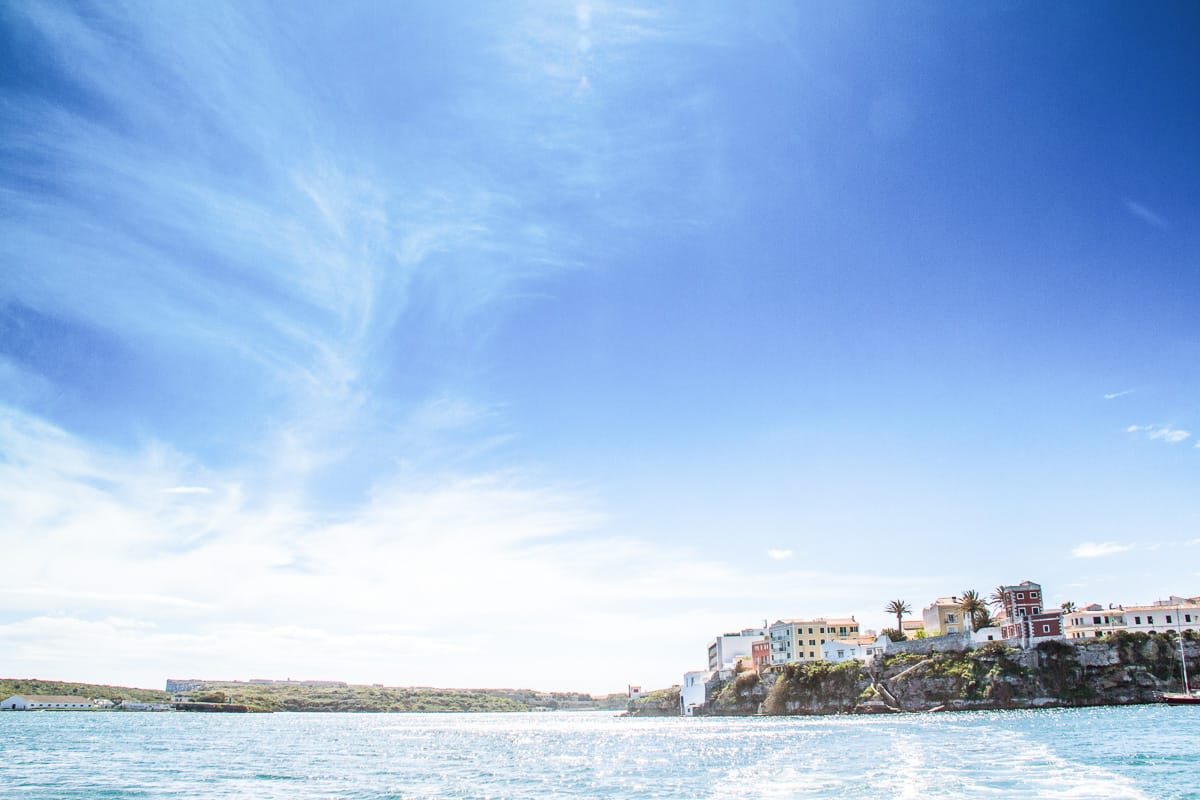
Both islands have stunning coastlines (but this place is Menorca!)
Driving the Balearic Islands
One of the best road trips in Spain involves flying to one of her smaller islands and taking a laid back approach to plans and itineraries all together. Mallorca and Menorca are the two main Balearic Islands and each has a distinctive character. Mallorca has party spots, UNESCO World Heritage and wild hiking routes. Menorca specialises more in family beaches, quiet streets, small towns and an awful lot of gin.
- Menorca or Mallorca for your Balearic Island holiday?
Set yourself up with one home base for a week and take a series of day trips to explore either island.
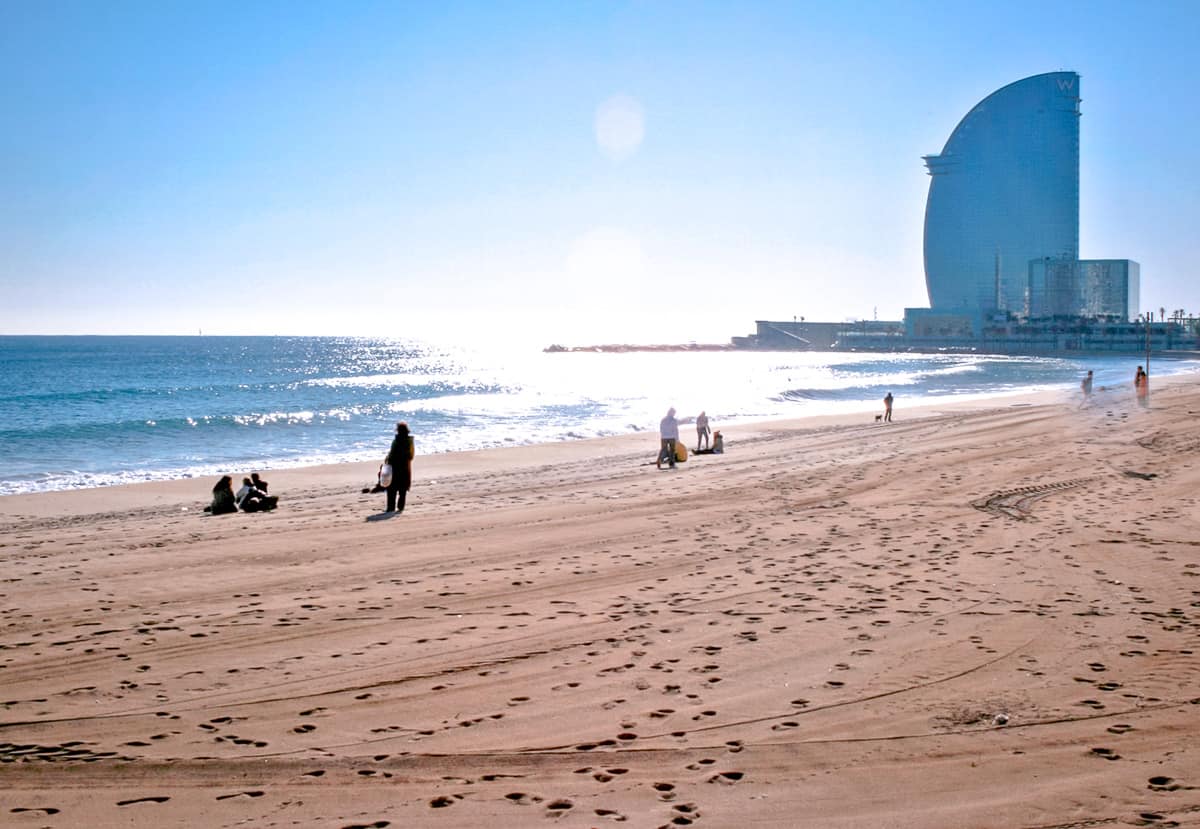
One of the best things about Barcelona is that it leads right onto a sandy beach…
Road Trip Along Spain’s East Mediterranean Coast
Drive from Barcelona to Valencia to experience two of Spain’s most interesting cities and her sparkling coastline as well. Find the Roman amphitheatre at Tarragona and the rice fields that gave us paella outside Valencia. If you have more than one week to ten days, continue south to the Moorish fortress in Amería as part of a road trip through Andalusia.
Road Trip Through the East Coast of Spain At a Glance
- Day 2: Barcelona and Girona
- Day 3: Valencia via Tarragona
- Day 5: Alicante and the Costa Blanca
- Day 6: Almeria and Cabo de Gata
- Day 7: Back to Barcelona to fly home (or to Malaga)
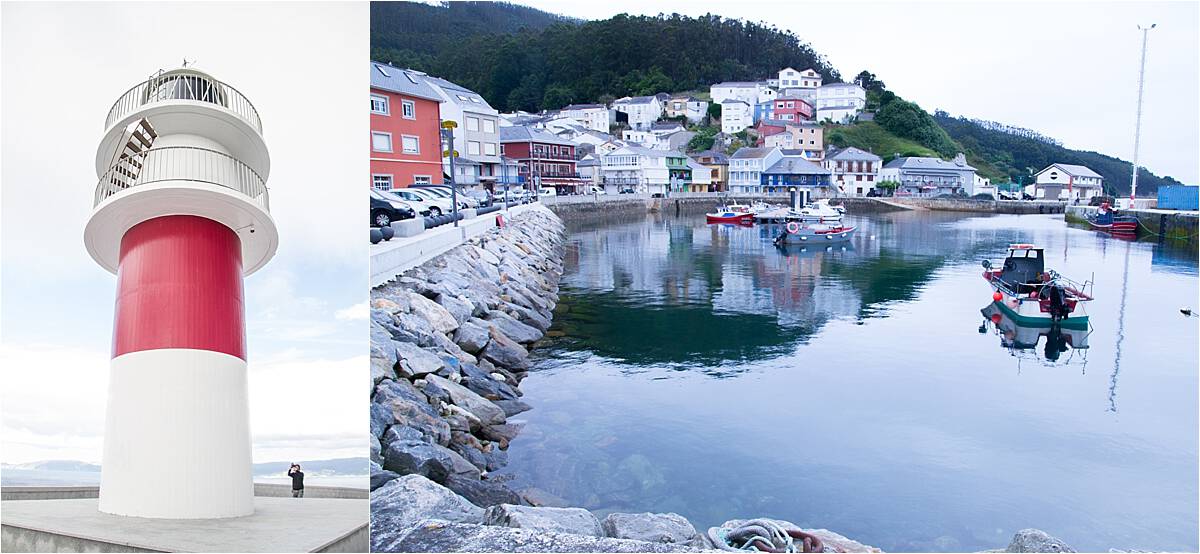
Road Trip Across Galicia
Decked out in deep green hues and bursting with salty seafood, a road trip through Galicia provides a completely different experience of Spain.
With a coastline more reminiscent of the rugged, craggy inlets of Ireland than the white sand of the south, it’s no surprise that Galicia offers seafood to make even the uncertain smile. Expect lighthouses, green fields, great walking routes and great food.
- A Galicia Road Trip: Northern Spain’s Rugged Green Coast
Road Trip Around Galicia at a Glance
- Day 1: Arrive La Coruña
- Day 2: Pontedeume and Redes
- Day 3: Porto do Barqueiro & Viveiro
- Day 4: Praia das Catedrais
- Day 5: Torre de Hercules Lighthouse & home

Road Trip Around the Basque Country
Link up San Sebastián, Bilbao and Santander for an epic road trip through Spain’s Basque country. Taste arguably the best food in the country in the pintxos bars in San Seb and take in the curls and swirls of the Guggenheim in Bilbao.
Add in secluded coastal curves and surprise museums, like the Balenciaga museum in Getaria , and you will find yourself with an unforgettable Spanish Road Trip.
Road Trip Through the Basque Country at a Glance
- Day 1: Arrive Bilbao
- Day 2: Bilbao
- Day 3: Bilbao to Logroño via Pamplona
- Day 4: Logroño to San Sebastian
- Day 5: San Sebastian
- Day 6: Hiking in Getaria
- Day 7: Back to Bilbao to fly home
What to know if you travel Spain by car
Cars drive on the right and you’ll need a full and valid driving license.
Tips for Spain Road Trip Itineraries
If you book through these links, we may earn a small commission at no extra cost to you. Cheers!
Typically, it’s best to pick up a vehicle at at the airport unless you have your heart set on exploring an historic city centre first. Bring your full driving license and book in advance. I’d highly recommend booking your car rental through Hertz.
Planning in Detail
I rely on the AA Route Planner to give me times and directions in Spain. Make sure you check for:
- Tolls (or factor them into your budget anyway)
What You Need to Drive in Spain
For a robust rundown of what you need to drive in Spain head to the Government website . From here you can check the latest recommendations and legal requirements, including information on an international driving permit.
Booking Hotels
Many smaller, boutique hotels in the centre of cities will not have parking options. It’s best to either park on the outskirts of town and walk in (in some places, such as Seville, taxis will struggle to get in as well) or if that’s too difficult for you then book a hotel on the outskirts of town and use their transport to travel in.
Highlights of Driving in Spain
Travel Spain by car and you’ll find all the following benefits.
While the big cities can get the pulse racing, for the most part, driving in Spain is a beautiful experience. Here are five reasons why:
1) THE ROADS ARE EMPTY
Outside the main cities that is. Gleaming wide main roads covered with smooth tarmac are the rule rather than the exception. Drive from Granada to Seville or Segovia to Merida and you’ll hardly see another car for miles.
2) THE SCENERY IS STUNNING
Low swirling mist rising over olive groves, intense sunshine hugging the contours of rust-red rock. Sparkling coastlines and white-washed towns with church towers spiking out of scorched plains. The green cloaked mountains of Galicia, the almond-scented mountains of Alpujarras and the Catalan curves of the eastern Pyrenees. Unlike driving in some countries, these views are visible from the windscreen of the car – you don’t have to wait until you park and get away from the roads.
3) GIANT BULLS ON THE HORIZON
Not real ones, of course. But building-sized, black, one-dimensional bull cutouts. Apparently, these first appeared as part of an advertising campaign for sherry. They were due to be removed until people clamoured for them to stay. Now, they add to the fun, as you never quite know when the next one will appear.
4) FRESH TAPAS AT SERVICE STATIONS
Forget about crisps, biscuits and overpriced coffee. Most petrol stations along the road in Spain are family run affairs with a chef on site. Coffee costs less than a euro while a plateful of patatas bravas, chocos, gambas or more is only a few minutes away. And if you’re feeling too hot? Try refreshing gazpacho instead.
5) FREEDOM AND GETTING OFF THE BEATEN TRACK
For reasons I’ll never quite understand, Spain has a reputation as a sand-and-sea destination and that’s about it. Visitors tend to cling to the coast and never realise just what they’re missing. Hiring a car and hitting the roads is the first step towards fixing that. Stop off in one of Andalucia’s pueblos blancos, for example, and you’ll probably be the only foreigner in town.
And that’s just for starters.
What is the best way to travel across Spain? Road trip or by train?
Great question. And the answer is: it depends.
Driving through Spain is an absolute joy, once you are out of the cities. Road tripping through Spain allows you to reach hidden villages and hike through unspoilt landscapes. It also makes life much easier if you are travelling with your children.
If you mainly wish to city hop between the big cities like Madrid, Barcelona and Seville, then the train is the better option. If you want to get off the beaten track and explore, go for a road trip.
Tools & Planners for the Best Road Trips in Spain
You’re in road trip heaven here, as we have everything from a full list of road trip essentials to the Ultimate Road Trip Planner for people who love freedom and hate spreadsheets.
And just for fun, we have the best road trip quotes and some road trip questions and games to help everyone get along.
Also, check out our road trip planning series on YouTube:
- The 5 biggest road trip planning mistakes people make (and how to fix them)
- The 7 best road trip planning tools.
1 thought on “The Best Road Trips in Spain and Their Self-Drive Itineraries”
The scenery is stunning indeed. I didn’t have to go driving to notice that. It’s wonderful!
Comments are closed.
- Travel to Spain Itineraries
11 Itineraries Around Spain: From 1 Day to 2 Weeks

Win a FREE Trip to Spain!
Exciting Announcement! For the first time, we're thrilled to offer exclusive trips to the heart of Spain - an experience like no other. This isn't your typical tourist journey; it's a unique opportunity to immerse yourself in authentic Spanish culture, alongside real locals and our passionate team.
But there's more! Simply by requesting information about this amazing trip, you'll be entered into a special draw to win a Fully Paid Trip to Spain for Two. And that's not all - everyone who inquires will receive an exclusive bonus gift, valued at $500, available only now.
Click Here ↑ to Request Information & Enter the Draw!
Have you been dreaming about Spain for the past few years? Have you been dreaming about traveling to the cosmopolitan European cities, the quiet medieval towns, or maybe the crystal blue beaches?
Have your dreams become reality just yet? If not, what is stopping you from traveling to Europe? I don’t know about you, but for years, I heard friends complain that they don’t travel enough, and when I finally asked one of them why, she said, “I don’t know where to start!”.
I finally got it! Most of our friends postponed trips because they didn’t know how to organize them, and who can blame them? What is best to choose with so many hotels, tours, restaurants, and places to see!?
I have always loved and enjoyed organizing trips; well, if you are reading this blog, you might see what has come of it. And I want to help you travel and discover Spain without worrying too much, without fighting with your spouse, and without sacrificing too much of your time organizing.
In this article, you will find 11 itineraries to travel to Spain, from 1 day to two weeks, all full of recommendations for different cities and activities.
You can follow them as they are or tweak them a bit and personalize the itineraries; after all, Sensation Spain’s itineraries are meant for you to enjoy and travel happily.
On top of that, I will link you to other resources that will make your time in Spain even better!
Table of Contents ▼ ▶
How to plan a trip to Spain?
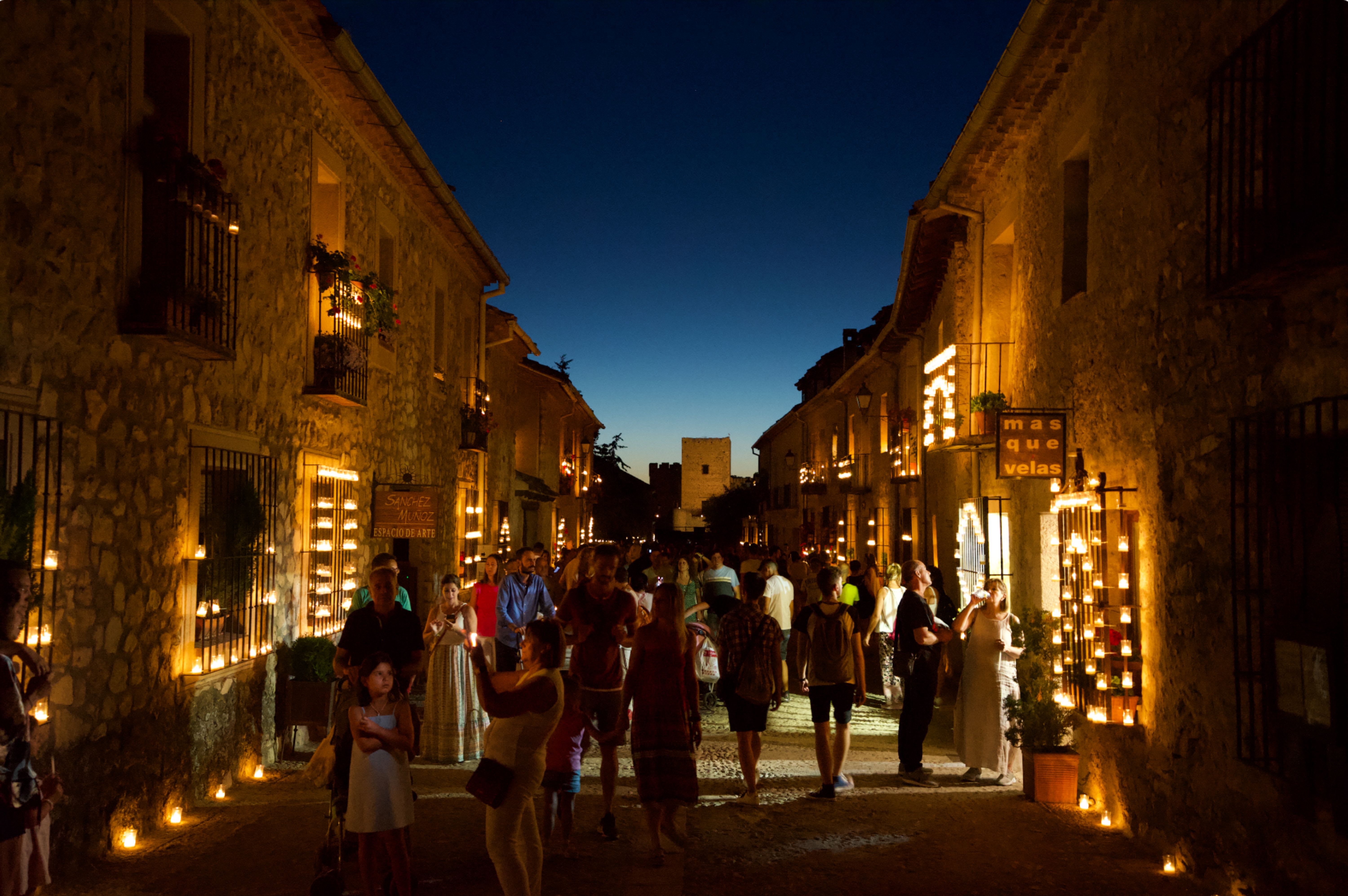
Planning a trip is like a writer confronting a blank page; you may have so many ideas but don’t know how to put them down and make them real.
Well, planning a trip can be way easier than writing a book because the information is already out there. You don’t have to be extra creative to plan an amazing trip. The only thing you need is to follow my three traveling steps.
(If you are traveling with a boyfriend or girlfriend, a wife or husband, or your entire family, it is vital that they also answer the same questions.)
- Go from general to specific.
- Create a set budget.
- When can I make this trip? And what would be my ideal season?
- How many days can I travel? How many days do I want to travel?
The most crucial part of organizing a trip is knowing when it would be possible. Timing affects the choice of season, place, and even your budget.
If your trip depends on company vacations, figure out when you can get them. If your trip depends solely on you, then choose your favorite season.
If you are wondering what is the best to travel to Spain, check out our featured article below. The best seasons are usually Spring and Autumn.
Go from General to Specific
After you have made a choice of season, let’s narrow down the travel options. I bet you have a book or a Pinterest board with all the cute places you want to see in Spain, with food recommendations, tips and tricks, and more.
Well, now is the time to gather all the general to create a more concrete board of the places you want to visit. Let’s answer the following questions:
- Do I prefer cities or small towns? Do I want to include nature in my trip?
- What are my top 10 places to see in Spain (cities or villages)?
- Which of these places are best for the season I chose?
After doing this, you will have a list of the best places you can visit in Spain according to the season. Now, onto the final step.
Tip: When you list cities, also write down which ones are non-negotiable. For example, when planning my first trip to the Netherlands, I had only four days available (including flying) and four cities in mind: Amsterdam, Rotterdam, The Hague, and Delt. I don’t enjoy rushing; I love discovering places, so I had to choose. Once I knew Delft was my non-negotiable and could narrow down my options, I could cross out Rotterdam and The Hague for the next occasion.
Create a set budget
After choosing the season, number of days, and the best places, it is time to set the amount of money you want to spend on this journey. Remember that a trip is an investment, so create a budget that will allow you to enjoy and not envy others.
In this article, you can read how much it costs to travel to Spain 🛫: How to Travel Spain on a Budget: Cost Guide & Tips
This is not an article for backpackers who travel for months. If you are short on budget, make your trip shorter and prioritize experiences that will make you happy!
For tight budgets that want to travel to Spain, you will need at least between 800 and 1,000 euros (air tickets not included). That could help you be more precise when setting the budget.
With these three steps, you can narrow down your options on everything. And decrease the amount of information you have to deal with when organizing.
Best time of the year to visit Spain
If you are open to suggestions, I will link you to our article that makes the best recommendation for each season.
For example, if you travel to Spain in autumn by the end of September, then you must see Madrid and Barcelona and experience wine fairs in Logroño.
The main cities will be full, and that is because the weather is WAY more pleasant than summer, and you can enjoy every aspect of the city.
This is the main guide to find out what is the best time to visit Spain:
- Best Time to Visit Spain: Monthly Guide & What to Expect
If you already know in which season you will travel, then check the following featured articles:
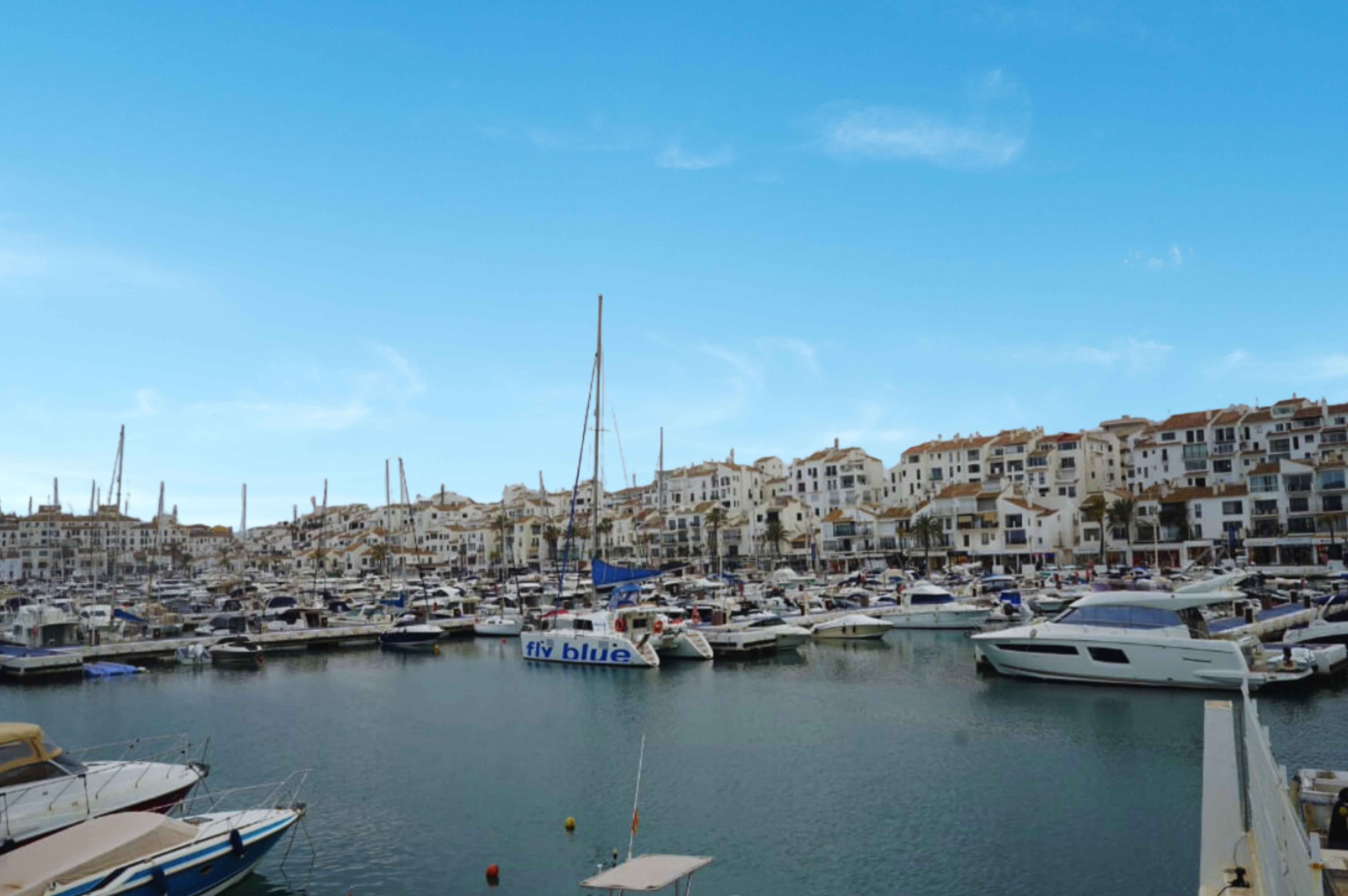
- Summer in Spain: 10 Best Places To Visit & Weather Info
- 10 Best Activities for the Perfect Summer in Barcelona!
- Summer in Madrid: 10 Fun Activities You Can’t Miss!
- Summer in Seville: 13 Top Activities to Beat the Heat
- Summer in Mallorca: 13 Best Things To do (or Avoid!)

- 10 Best Spring Destinations in Spain: Weather & Fun Activities
- Visit Seville in Spring: 10 Best Activities, Places & Food
- Mallorca in Spring: 7 Reasons Why It’s My Favorite Season
- Spring in Madrid: 13 Best Places To See & Things To Do
- Barcelona in Spring: 9 Reasons Why It’s My Favorite Season
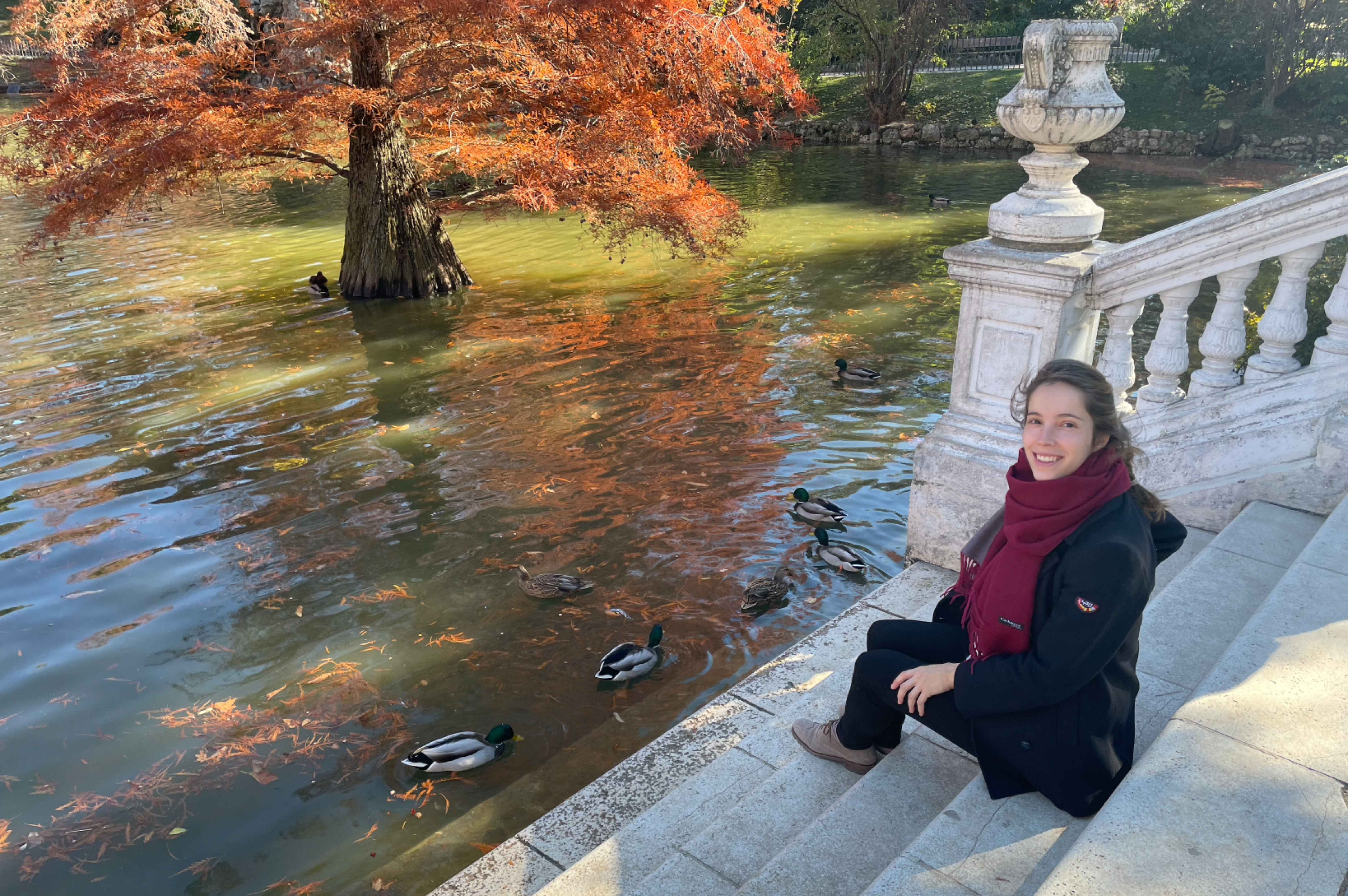
- 5 Best Autumn Destinations in Spain: Weather & Fun Activities
- Top 9 Reasons to Visit Mallorca in Autumn
- Madrid in Autumn: 15 Best Activities to “Fall” in Love!
- Barcelona in Autumn: 10 Best Activities to “Fall” in Love!
- Seville in Autumn: 13 Best Activities to “Fall” in Love!

- Spain in Winter: Weather, Destinations, Tips & more
- Seville’s Warm Winter: 11 Top Things in our Best Season!
- Explore Barcelona’s Winter Charm: 11 Cool Things to Do
- Madrid in Winter: 13 Cool Things to do in this Magical Season
- Winter in Mallorca? 7 Best Plans for the Perfect Off-Season
Top 11 Spain Itineraries
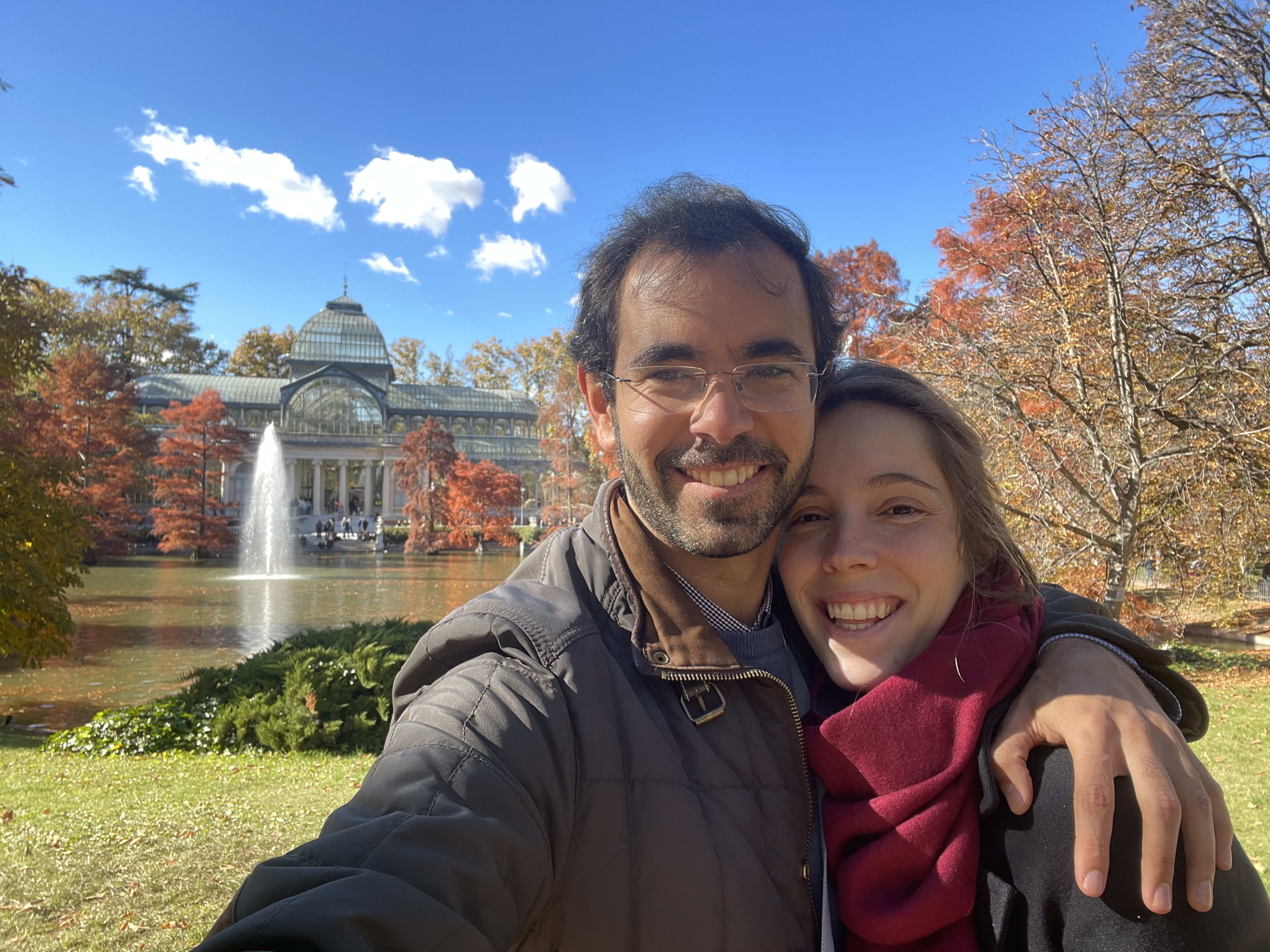
This is the section you came for! We have created 11 itineraries guided by the amount of time you might have available to travel to Spain.
We have made from 1 to 14 days itineraries, so you can choose what is best for you, your partner, and your family. They all include resources that will give you more information and advice to make your journey smoother and even more enjoyable!
Let’s begin!
Itinerary for 1 Day in Spain
In this article, you will find two itineraries, one for 24 hours well spent in Madrid and 24 hours to enjoy in Barcelona.
People who travel only for a day usually do it due to business trips or as a pit stop to go to another city; if any of this is your case, we got you covered!
- 1 Day in Spain? 10 Best Things to Do in 24 Hours!
Itinerary for 2 Days in Spain
In this itinerary for two days in Spain, you will find two itineraries: Madrid and Barcelona.
You will find all the key places you must see quickly, and I hope you enjoy them!
- 2 Days in Spain: Trip Ideas & Itineraries to Enjoy Your 48h
Itinerary for 3 Days in Spain
This Itinerary for 3 Days in Spain offers an amazing journey to Madrid and Barcelona. With this planned itinerary, you will see both of Spain’s most famous and cosmopolitan cities.
- 3 Days in Spain: What’s the Best Itinerary for Your Trip?
Itinerary for 4 Days in Spain
This itinerary for 4 days in Spain offers a twist! You will find FOUR different itineraries to choose the one that fits with your preferences.
You will find:
- How to spend 4 days in Barcelona and the Costa Brava
- How to spend 4 days in Madrid, Segovia and Toledo
- How to spend 4 days in Madrid and Barcelona
- How to spend 4 days in Madrid and Seville
Choose the one that calls you the most and aligns with the cities in your list!:
- 4 Days in Spain - Best Travel Itineraries for Short Trips
Itinerary for 5 Days in Spain
In this article, five itineraries will help you spend the best 5 days in Spain. You will find one itinerary for Madrid, Barcelona, and Seville, another itinerary only to discover southern cities, and a third one to visit Spain’s major classics.
- 5 Days in Spain: Itineraries to See (almost) Everything!
Itinerary for 6 Days in Spain
I love this article! Here, you will find a unique itinerary that will take you to Valencia and the Balearic Islands. This unique featured special is for those who have already seen Madrid and Barcelona and would like to give their trip nice ocean views!
- 6 Days in Spain: The 3 Best Itineraries for Your Trip!
Itinerary for 7 Days in Spain
This itinerary takes north and south! You will find three different ways to spend seven days in our country. The first itinerary takes you to the main cities plus Seville; the second itinerary takes you all the way to the north, where you will discover Bilbao and San Sebastián, and the third is special for first-timers as it takes you into an immersive trip to Madrid and Barcelona.
- 7 Days in Spain: The 3 Best Itineraries for Your Trip!
Itinerary for 8 Days in Spain
On this 8-day journey, you will travel through Barcelona, Madrid, Granada and Seville. Plus, I have added plenty of travel tips to make your journey more enjoyable.
- 8 Days in Spain: The Best Itinerary to See Everything!
Itinerary for 9 Days in Spain
With this nine-day itinerary through Spain we prioritize strategic accommodation and include plenty of day trips!
You will discover Bilbao, San Sebastian, and Pamplona in Northern Spain, plus Madrid and Barcelona.
- 9 Days in Spain: Top Itinerary to See Everything!
Itinerary for 10 Days in Spain
We have created a detailed itinerary to spend ten days in Spain. It includes Barcelona and the Costa Brava, Madrid, Segovia, Granada, and Cordoba.
- 10 Days in Spain: The Best Itinerary to See Everything!
Itinerary for 2 Weeks in Spain
With two weeks in Spain, you get to see lots of the essentials! With this two-week itinerary in Spain, you go from North to South, traveling and discovering 12 cities and top UNESCO World Heritage Sites. Check it out!
- How to spend 2 weeks in Spain? 12 Cities & Activities
Important Resources
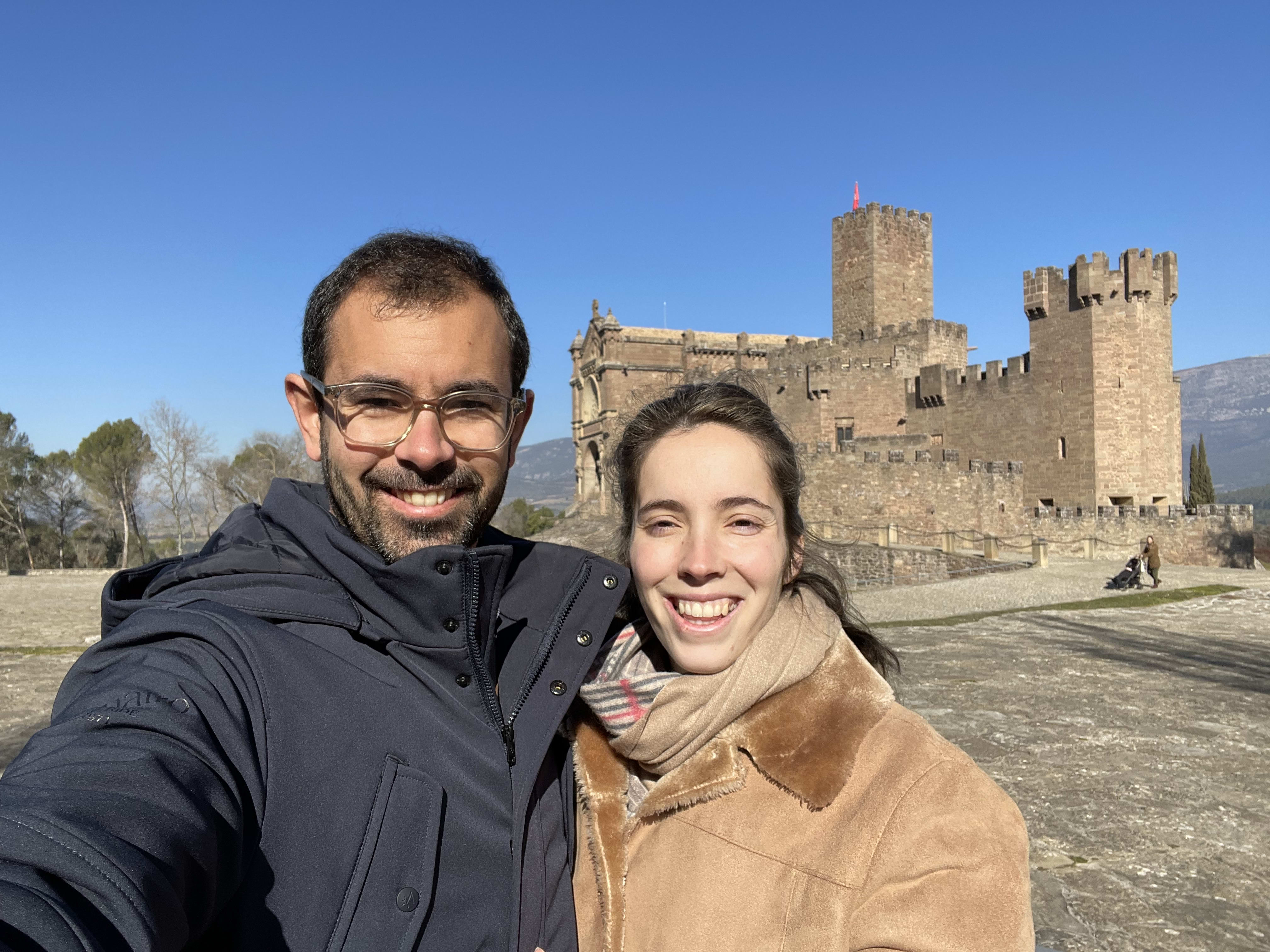
If you have traveled before, I bet you have faced the problem of not finding public restrooms. However, know that in Spain, that will not be a problem because I got you covered.
In this section, I will give you essential advice such as “how to find public restrooms in Spain” and “how to get around major cities in Spain.” The resources here come in handy!
Public Restrooms in Spain
How to Find a Public Restroom in Spain: 12 Spots!
How to Move around in Spain
How to Get around Barcelona + 8 Tips I wish someone told me How to Get Around Mallorca: 9 Tips I wish Someone Told Me How to Get Around Madrid + 8 Tips I Wish Someone Told Me How to Get Around Seville + 3 Tips I wish Someone Told Me!
Where to Eat in Spain
What to Eat in Spain: 31 Tasty & Traditional Dishes
Scams to Avoid in Spain
15 Mistakes Tourist should avoid in Spain. Must read!
Need help organizing your trip to Spain?

If these itineraries are not enough and you still need a little help, leave us a comment or email us!
We love Spain, and we want more people to be able to explore it for real and with the most authentic experiences. At Sensational Spain, we aim to make your dream trip come true. Whether it is with your partner or your whole family, we can create a personalized trip for all of you.
If you want a completely different itinerary or wish to avoid all the research and booking, we can cover that for you, so you juts have to relax and enjoy Spain.
Email us here!
I hope these itineraries are helpful when it comes to planning your trip! Remember to follow our three-step formula for organizing a trip, and then check out our itineraries to see which fits best.
Enjoy reading the 11 itineraries throughout Spain, and mix and match them as you wish.
Happy travels!
READ NEXT: What’s the Climate in Spain? Our Real Weather and Temperature
Rating: No ratings yet. Leave a comment!

You might also like...

Eating Out in Spain: Where to Eat & Best Food to Order
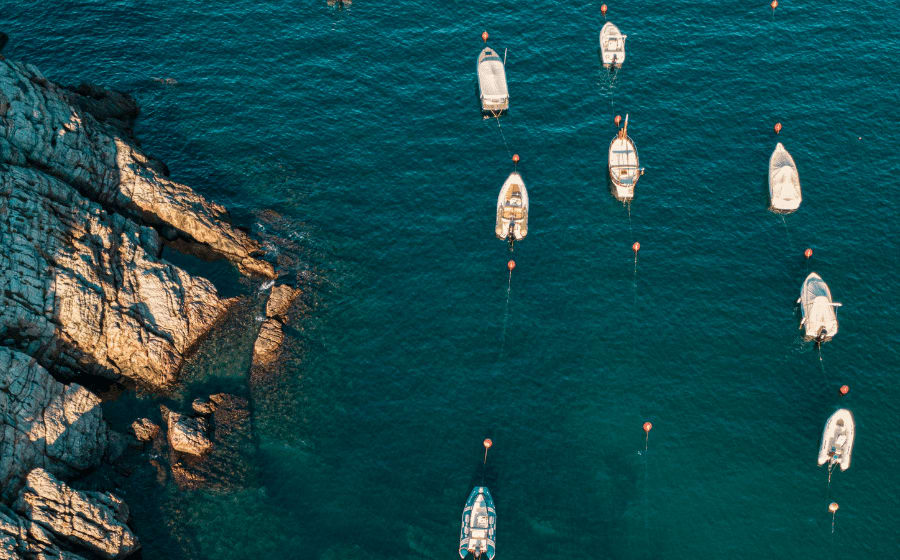
The Four Seasons in Spain and Where to Enjoy Them
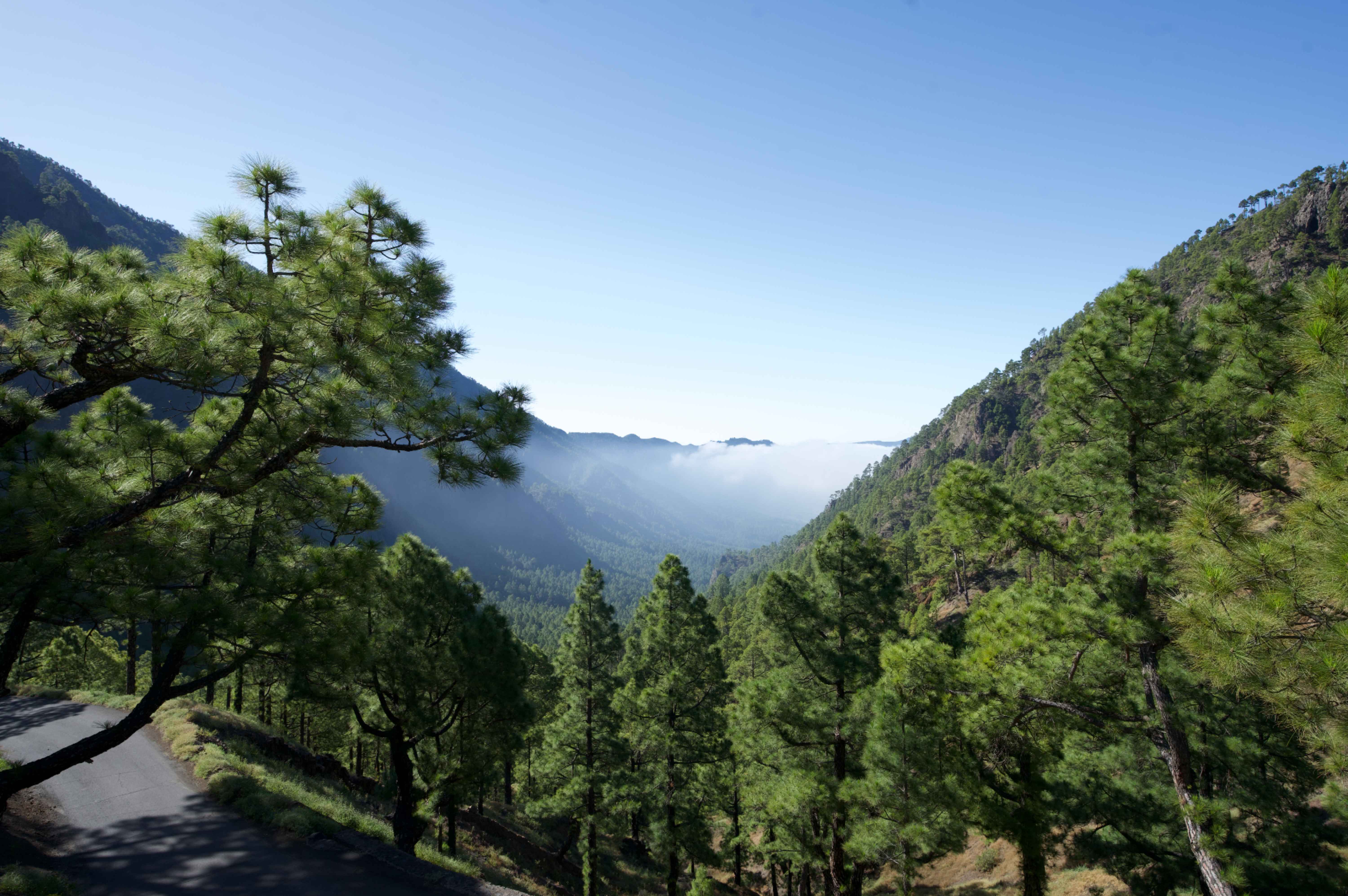
9 Natural Wonders in Spain Worthy of Your Bucket List!
Email address (optional), star rating (optional).
Be the first to comment!

Millions of people como to Spain every month! But many never get to experience the SENSATIONAL SPAIN!!
We're both born and raised Spaniards and our goal is to give you all the resources to plan a perfect trip to Spain.
Take a look! 👇
FYI! Some affiliate links may be sprinkled throughout the post. We'll receive a small commission when you purchase from our links (at no extra cost to you), which will help us keep creating content.
Join the waitlist
I'm about to release my City Guides for Madrid, Barcelona, Sevilla and Mallorca.
They're going to have everything you need to plan the perfect trip. From hotels and transport, to restaurants, attractions, activities, & a lot (A LOT!) of tips & tricks.
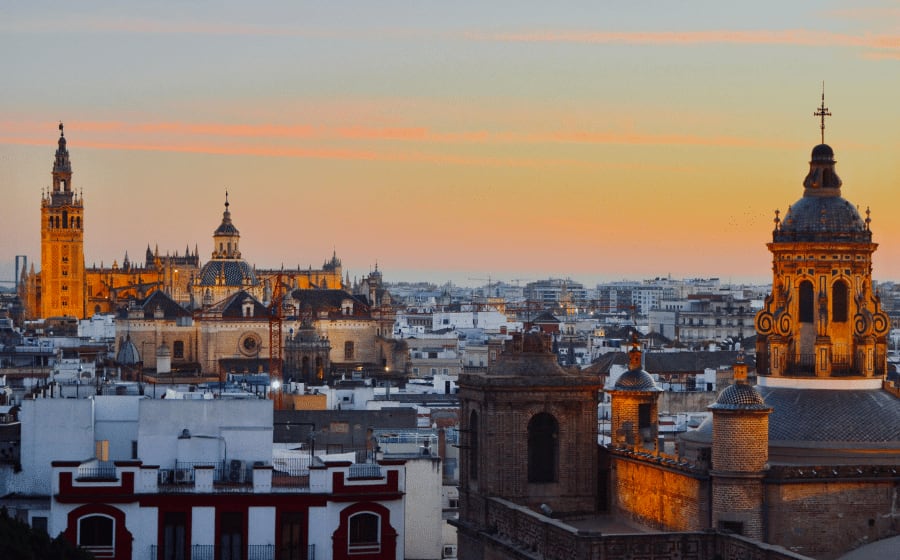
What’s the Climate in Spain? Our Real Weather and Temperature

What do Spanish People Think of Americans?

What Song Are You Listening To? MADRID

What is the Best Show to Learn Spanish?

Things People Should NEVER do Dating in Spain

Can Foreigners Adapt To The Spanish Lifestyle?

3 Weeks In Spain Itinerary
DISCLAIMER: This post might have links to travel services and products that we enjoy. We might make a commission from it at no extra cost to you.
Popularly known as one of the most visited countries in Europe, Spain offers its annual 82 million tourists with all grace and satisfaction. Evidently, the number of tourist arrivals in Spain just keeps growing every year with people who are keen to visit beaches, go hiking, explore ancient towns, and try out local dishes.
So, what is your reason for visiting Spain? Is it to treat yourself to local Spanish cuisine? Or perhaps to experience its rich history and culture through its beautiful architecture? Or maybe you want to experience its natural beauty and the Mediterranean coastline? The good news is – Spain has all these.
Travelling to Spain for an extended time is recommended. There are so many things to see or do throughout your tour.
This itinerary for 3 weeks in Spain should be enough to cover the best that Spain has to offer, especially for first-time visitors. We have prepared this itinerary to plan your trip seamlessly and conveniently.
If you want to visit other countries in this region, check out our 3 weeks in South Europe itinerary or do a trio adventure and go to Italy, France, and Spain for 3 weeks .
THINGS TO KNOW BEFORE GOING TO SPAIN
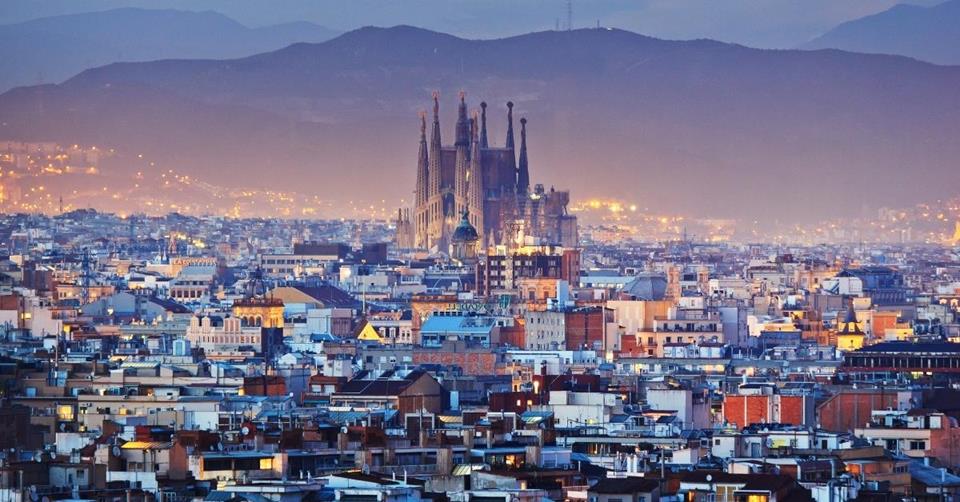
When you travel to Spain, it is important to learn basic Spanish phrases to make communication easier. Some can speak English, but some may not know the language at all. It is also important to know that drinking directly from the tap is safe. And tipping isn’t a big deal, so you are not required to leave a tip unless you are thrilled with the service.
As with any major tourist destination, pickpocketing can be an issue. Make sure you keep an eye on your belongings at all times. If it’s your first time travelling alone, check out our article on how to stay safe if you are travelling solo .
Here are more tips so you can better plan and write your 3-week itinerary . These tips will help you visualise and start having clarity on what your vacation will look like.
When is the best time to go to Spain
Choosing the best time to visit Spain can be a challenge since it is a great year-round destination. You generally decide the best time to go according to what you want to see or do. Each season offers a uniquely enjoyable experience, so you need to plan accordingly.
Spring (March to May) and fall (September to November) are the best times to go. This will provide you with good weather to enjoy the natural beauty and scenery of the country.
You can also expect fewer crowds (compared to winter and summer). And with fewer crowds, you can expect to find cheaper accommodations than when you book at other times of the year.
- Peak/summer season: June to August
- Heavy rains between September to January
- Winter season: December to February
One major holiday to remember when deciding when to go to Spain is Holy Week. During La Semana Santa , not only many businesses are closed, and locals not working, but there are parades and events surrounding this public holiday.
Make sure to book your hotel and other arrangements in advance if you plan to go during the Holy Week because it’s a peak season and last-minute booking will be expensive and challenging.
Are 3 weeks enough for Spain
3 weeks in Spain is perfect. You can visit historical sites, the beach, and even go for a hike or two. The country is also well-connected with flights and buses or trains, making travelling between cities or islands much easier. 20 days is plenty, and you won’t run out of things to do or feel like you have to cram everything and are always on the go.
If you’ve ever been to Spain or if you’re travelling here with your family and looking for something unique place to go to and spend your three weeks, perhaps this list of the best Spanish islands for families can be helpful. You can choose between popular spots and a tranquil peninsula to enjoy a peaceful atmosphere.
Average cost of 20 days in Spain
Plan to spend around $2,000 for a 3-week trip in Spain if you prefer to stay in a mid-range hotel and eat often. Accommodation costs you the most during your trip, around $40-$60 a night for a decent double room. Eating out in a m id-range restaurant will be about $7 to $12 per meal .
For those who want to t ravel more budget-wise, $1,200 could do it by staying in dorm rooms and eating street food most of the time. If your hostel has a kitchen, that could also cut costs. For l uxury spenders, around $3,500 will be an excellent budget if you plan to book five-star hotels and fancier restaurants.
These numbers don’t include your flight to and from Spain and are calculated for one person. For couples or a pair of friends travelling, you could save some money by sharing a double room.
What to pack
Knowing what to pack for Spain will depend on what time of the year you want to go. The country enjoys a Mediterranean climate, meaning the winters are mild with some rain, while the summers are hot and dry. When you visit during the summer, opt for casual and lightweight clothes to keep you cool.
It can get quite cold during winter in Spain, skiing is even possible here in the parts of the Pyrenees region. It is important to pack lightweight layering items such as cardigans and sweaters. The winters are not harsh, but it can get chilly at night.
We have a series of packing lists. Check out our packing for a 3-week trip . We also have a summer trip packing list , and of course, a packing list for winter .
How to get around
Getting around Spain is relatively easy. The best way to travel from one Spanish city or town to another is by train, especially while you are on the mainland. The high-speed train is called AVE(Alta Velocidad), a convenient way to travel between cities.
You can also rent a car and drive on your own since Spain has a pretty straightforward policy regarding recognising international driver’s licenses. However, remember that most vehicles in Spain are programmed with a stick (aka manual gear). You can, of course, find automatic cars, but they get booked up quickly.
Buses are also easy and cheaper but can be slower, while traditional taxis are everywhere. The use of ride-hailing apps is also common, and domestic flights will come in handy when moving between islands.
Spain has the same visa policy in place as any other Schengen State member (EU). This means that visitors with passports from most parts of the Americas, Oceania, Malaysia, Singapore, South Korea, Japan, and some parts of the Middle East can enter and travel around Europe for 90 days in every 180-day calendar.
US Citizens can travel to Spain for leisure or business purposes without a visa with a maximum stay of 90 days. The only requirement is that your passport must be valid for 6 months (during the time of travel). Also, it must have at least one blank page.
In some cases, a return airline ticket and enough funds are required. Aside from US citizens, the following passport holders do NOT need a visa to travel to Spain: Members of the European Union, Switzerland, Iceland, Norway, Canada, most parts of Latin America, Japan, South Korea, Malaysia, Singapore, New Zealand, Australia, and some regions of the Gulf countries and Central Asia.
For others not mentioned, the visa must be applied in advance. You could submit your application as early as 6 months in advance.
Travellers with passports from EU-member or part of Schengen States have indefinitely freedom of movement in Spain. Other passport holders must arrange their travel visa for Schengen through the Spanish Embassy or Consulate near you.
Package tours
Sometimes planning is overwhelming, and you really want a vacation where you can simply show up at the airport, and the fun begins. In that situation, I love booking package tours. In such tours, the travel agency book and arrange everything for you. This includes accommodations, activities, restaurants, transportation, and a knowledgeable guide.
Below is a list of exciting tours for 15 to 22 days. Let’s say you have 20 days of vacation, and you want to be easy but leave you time to do your own thing. Go book the 15 days, then you have 5 days of exploring on your own.
Other travel tips
Booking your travel arrangements can be overwhelming. There are simply too many options, and comparing them to one another is a daunting and time-consuming task. I was planning my Central Europe itinerary last night, and it is just a few minutes to book the accommodation I want and the flights I need.
I was also able to make a decision quickly because I know that some of the travel sites I use offer a flexible cancellation policy. Here’s a list of the websites and tools I use for any travel-related services. Perhaps, you might find them helpful and easy to use as well.
MUST-SEE PLACES IN SPAIN (pinned map)
Click the enlarge button on the top right corner. Credit: map data: Google
3 WEEKS IN SPAIN ITINERARY
Spain is home to many beautiful cities and towns that are worth exploring for various reasons. Whether you want to enjoy culture, nature, or history, you will be spoiled for options. Use this guide, so you know what to see or do for each destination in Spain.
If you enjoy your trip to Spain, perhaps you want to spend 3 weeks in Italy next time or a trip to France . For people on a budget, here’s our list of how to travel to Europe in 3 weeks on a budget .
Day-to-day overview
- Day 1 : Arrive in Barcelona. Arrange a private transfer to your hotel or take the airport shuttle bus . Pick up your rental car here at the airport if you plan to drive yourself. Get yourself a local sim card with data and local currency.
- Day 2-3 : Explore Barcelona and plan some day trips, get the Hola card for public transport .
- Day 4: Travel from Barcelona to Valencia by bus , train , plane, or drive.
- Day 5-7 : Discover Valencia, and don’t forget to enjoy the beach.
- Day 8 : Travel from Valencia to Madrid by bus , drive, train , or plane .
- Day 9 to 11 : Explore Madrid and plan some day trips from here.
- Day 12 : Get to Seville from Madrid by train , plane, bus , or drive.
- Day 13 to 14 : Discover Seville, and make sure to go to a flamenco bar.
- Day 15 : Travel to Malaga or Granada, which is around 2 hours by driving or 2.5 hours by bus ( Malaga / Granada ).
- Day 15-17 : Explore Granada or Malaga.
- Day 18 : Fly to Tenerife or Gran Canaria or Ibiza.
- Day 18-21 : Enjoy the island life and plan some relaxing days.
Barcelona for 4 days
Barcelona is probably the most popular city visited by tourists in Spain. It is known for its iconic architecture and beautiful Mediterranean location. It is rich in culture with a wide array of the iconic architect Gaudi’s works to explore. Barcelona is an ideal destination to start your 3 weeks in Spain trip, especially if you want to kick it off by relaxing on the beach and soaking up in the Mediterranean Sea.
Getting to Spain is very easy, there are two main destinations you can plan to start your trip – Barcelona and Madrid. Barcelona is as famous as Madrid, with non-stop flights from various cities in the US and Canada to Barcelona via American Airlines, Delta Airlines, Lufthansa, or Air Canada. The Josep Tarradellas Barcelona-El Prat International Airport in Barcelona is the central hub of flights and the second busiest airport in Spain.
Things to do in Barcelona
- Get a public transport pass – look at the price
- Mount Tibidabo
- Barceloneta Beach
- Basilica de la Sagrada Familia – skip the online and explore with an audio guide or combine with Parc Guell
- Barcelona Aquarium – suitable for young children, buy your ticket in advance
- Palau de la Musica Catalana
- Park Güell- get your ticket in advance , there’s a limit per day ticket sold for Parc Guell
- Casa Batllo
- Enjoy tapas and wine – book a walking tour
- Bogatell Beach/Playa de Bogatell
- Magic Fountain of Montjuic – ride a round-trip cable car
- Museo Picasso de Barcelona
- Explore Montserrate – join a half-day tour
- Trio-day trip and cover Spain, France, and Andorra – check the itinerary
- Walk around Barri Gotic
- Go kayaking and snorkelling in Costa Brava – book an affordable tour
Accommodations in Barcelona
- Affordable: Unite Hostel or Factory Hostel
- Mid-range: Sixties Ramblas or Violeta Boutique
- Luxury: Vincci Gala or Ohla Barcelona or ME Barcelona
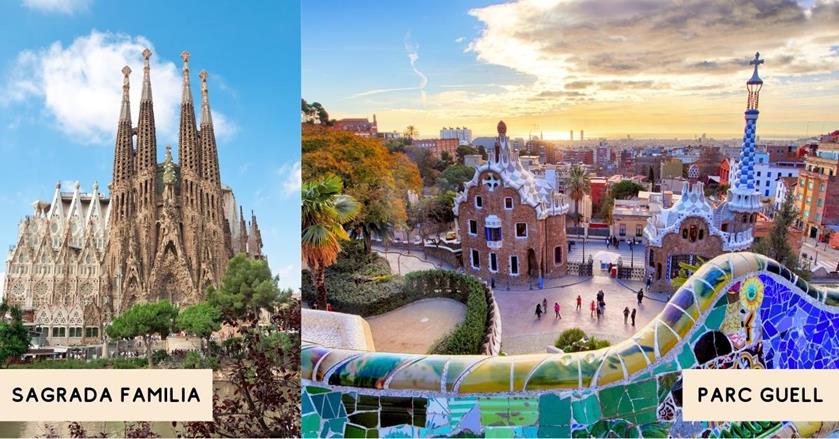
Valencia for 3 days
Best known as the home of paella, Valencia is the home of luscious Spanish dishes. But aside from introducing the world to this culinary delight, there are more reasons to visit Valencia in Spain. Valencia is another Spanish coastal town 348 km (216 miles) south of Barcelona.
Taking a stroll through its old town will enable you to marvel at the colonial architecture. But Valencia is also home to many futuristic architectural features, such as the world-famous Valencia City of Arts and Sciences. Spending 3 days in Valencia is plenty, although 2 days is possible if you want to add that one day to another city.
To get to Valencia from Barcelona, you can either drive your rented car for 3 hours and 40 minutes or take the train , the journey is around 3 hours or by bus is about 4 hours. You can also book a direct 1-hour flight.
The best way to get around Valencia is by using public transportation. You can also rent a bicycle or buy yourself this useful hop-on hop-off bus ticket which stops at major attractions in Valencia.
Things to do in Valencia
- La Lonja de la Seda
- Oceanografic – perfect for young children, get your entrance ticket
- Albufera Natural Park
- La Ciutat de les Artes i les Ciencies de Valencia
- Cuevas de San Jose – sign up for a half-day guide tour
- Mercado Central
- Plaza de la Virgen
- Hike and swim at Montanejos – book a group tour
- Bioparc Valencia
- Torres de Serranos
- Playa del Saler
- Sail on a Catamaran Cruise – check the tour price
- The medieval town of Requena
- Enjoy wine and tapas tasting in an 11th-century historical monument – check this trip
- Join a cooking class
Accommodations in Valencia
- Affordable: Hostal Antigua Morellana or Colors Rooms
- Mid-range: Ad Hoc Carmen or Venecia Plaza Centro
- Luxury: Vincci Lys or Petit Palace Plaza de la Reina
Madrid for 4 days
3 weeks in Spain without visiting its capital is incomplete especially if it’s your first time here. Madrid is the artistic centre of Spain. Proof of that is the concentration of art galleries located in various parts of the city that showcase the works of Picasso and Velazquez. It is also home to a wide range of vibrant neighbourhoods that offer the best tapas and pubs to check out at night.
Madrid is located right in the centre of Spain, about 346 km (215 miles) northwest of Valencia. There are a few ways to get to Madrid from Valencia. You can book a direct 2-hour flight from Valencia Airport to Adolfo Suárez Madrid-Barajas Airport. You can also get to Madrid by train from Valencia with Avlo in 2 hours or by car, which takes nearly 4 hours.
Once you get to Madrid, you can easily move around on foot and use public transport. If you prefer a more convenient way to travel around, a push bike might be more suitable for you or you get a hop-on hop-off bus ticket with stops at the most popular attractions.
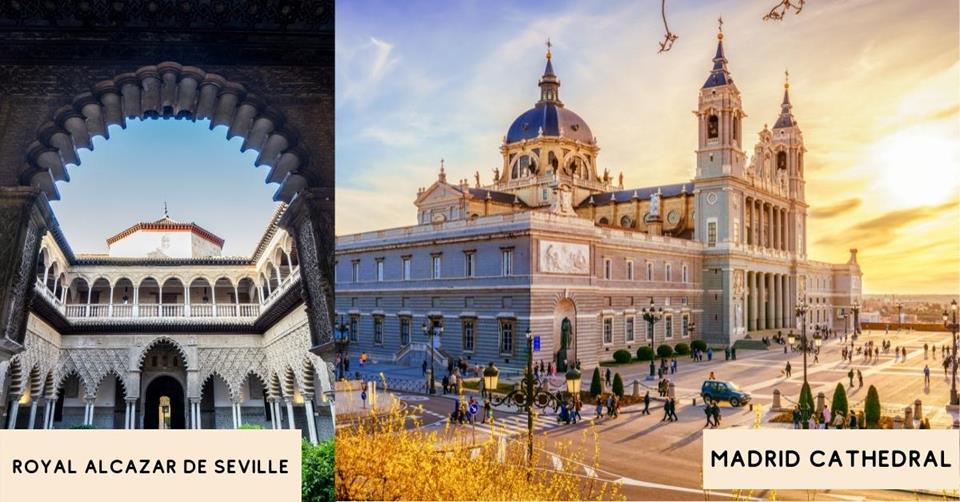
Things to do in Madrid
- Royal Palace – get your fast-access ticket
- Plaza Mayor
- Museo Nacional del Prado – purchase your ticket in advance
- Parque Natural de Peñalara and Sierra de Guadarrama National Park
- Visit Real Madrid’s Stadium (Santiago Bernabéu Stadium) – join a Bernabeu Stadium tour
- Buen Retiro Park and the Crystal Palace
- Puerta del Sol
- Fuente de Cibeles and Gran Via
- Temple of Debod
- Basilica de San Francisco el Grande
- Enjoy wine and tapas tasting – join a group tour
- Puerta de Alcala
- Watch a flamenco show with dinner
- National Museum of Romanticism
- Day trip to Avila and Segovia and visit historical sites or go to Toledo with a local guide
Accommodations in Madrid
- Affordable: Olblanc Plaza de Espana or Hostal Arrate
- Mid-range: II Castilla Madrid or Hotel Liabeny
- Luxury: Pestana CR7 Gran via Madrid or Palacio de Atocha
Seville for 3 days
Located within the province of Andalusia in Spain, Seville is best known for its flamenco culture. You can find plenty of flamenco bars in town. You can also visit many historical landmarks and museums to glimpse the town’s past.
The architectural landscape of Seville offers a mix of the old and the new, creating a beautiful contrast in the cityscape. If you prefer to see this region of Spain, perhaps a Southern Spain road trip would be an ideal adventure for you.
Seville is 532 km (330 miles) south of Madrid. You can book a direct train between Madrid and Seville called Renfre/AVE. The trip will take a little offer of 2.5 hours, you can also drive, which is about a little over 5 hours. A direct flight will take about an hour from Adolfo Suárez Madrid–Barajas Airport (MAD) to Seville Airport (SVQ).
Things to do in Seville
- Royal Alcazar of Seville
- Catedral de Seville
- Punta Umbria Beach
- Cascadas del Hueznar
- Real Alcazar
- Parque de Maria Luisa and Plaza de Espana
- Barrio de Santa Cruz
- Museo del Baile Flamenco
- Real Maestranza de Caballeria de Sevilla
- Palacio de la Condesa de Lebrija
- Metropol Parasol
- Torro del Oro
Accommodations in Seville
You can also check this list of best boutique hotels in Seville with swimming pools.
- Affordable: Hostel A2C or Pension Javier
- Mid-range: Hotel Casona de San Andreas or Cool Sevilla Hotel
- Luxury: Hotel Rey Alfonos X or Hotel Dona Maria
Granada or Malaga for 3 days
The city of Granada is like a Disney fairy tale that came to life. It is filled with cobblestone streets, snow-capped mountains, and enchanting fortresses. It is also notable for the abundance of Islamic art and architecture.
Granada’s excellent and unique identity sets it apart from many other Spanish cities. For this reason, the destination makes it a worthy addition to your 3-week itinerary in Spain. This city is known for its “free tapas” culture if you love tapas. If you sit in any restaurant, bar, or visit someone’s home, there are free tapas for everyone.
On the other hand, Malaga is another seaside city in the south of Spain. There are spectacular beaches, historical monuments, and varied museums. Pablo Picasso was from Malaga, when you explore the city, you’ll definitely see how proud this city of him is through displaying his art.
Both Granada and Malaga are on the east of Seville. Malaga is 205 km (127 miles) southeast of Seville, while Granada is 250 km (155 miles) east of Seville. A car will only take 2.5 hours to reach Granada from Seville and 2 hours to Malaga. There are direct trains to both cities from Seville but no direct flights to both cities.
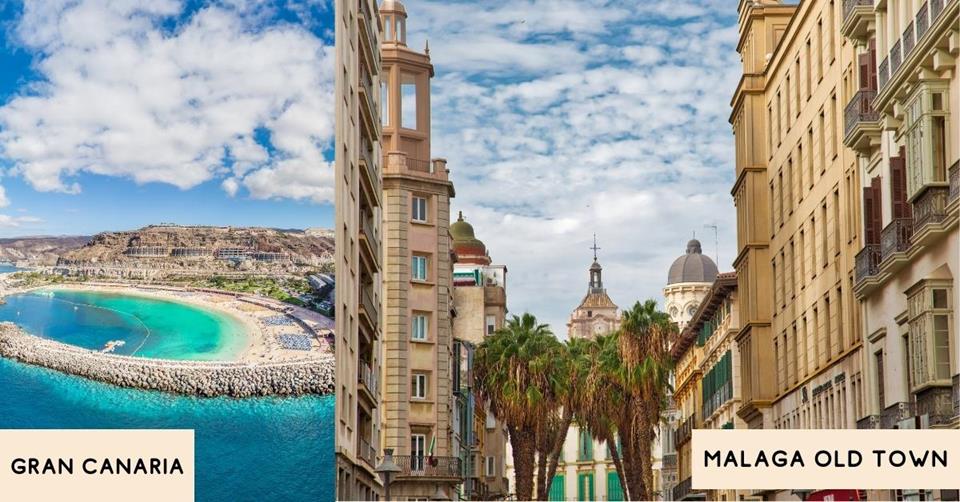
Things to do in Malaga and Granada
Since Granada and Malaga are not too far, you can easily plan day trips from both cities. You can also explore Malaga’s must-see spots on a 2-hour segway guided tour .
- Alhambra (G)
- Sacromonte (G)
- Alhambra (G) – check the tour price or do a day trip from Malaga
- Nasrid Palaces (G)
- Enjoy a flamenco show in a cave restaurant – book your table
- Salobreña Beach
- Sierra Nevada National Park
- Alcazaba de Malaga
- Torre Vigía De Cerro Gordo – sign up for a snorkelling and kayak tour
- Malaga Old Town/Marbella Urban Wall
- Boat trip to Paseo de Los Delfine – check the price
- Jardin Botanico-Historico la Concepcion
- Caminito del Rey – book a guided tour to cross the suspension bridge
- Playa de la Malagueta
- Museo Picasso Malaga – get your ticket with an audio guide tour
- Centre Pompidou Malaga
- Do tapas tasting – join a walking tour
- Festival de Malaga
- Day trip to Gibraltar – book a day trip including a St Michael Caves visit
Accommodations in Malaga
- Affordable: COEO Pod Hostel or Hotel Zeus
- Mid-range: Petit Palace Plaza Malaga or Be Mate Malaga Centro
- Luxury: Soho Boutique Castillo de Santa Catalina or Vincci Seleccion Posada del Patio
Accommodations in Granada
- Affordable: Urban Dream Nevada or Pension Venecia Gomerez
- Mid-range: Nest Flats Granada or Room Mate Leo
- Luxury: Candil Suite Origen or Hospes Palacio de Los Patos or Palacete (adults only)
Tenerife or Gran Canaria or Ibiza for 3 days
The best way to finish off your 3 weeks in Spain vacation is by visiting its most fabulous and beautiful islands in the northern part of Africa. West of the Sahara desert is the islands of Tenerife and Gran Canaria. Apart from magnificent beaches, these two islands also offer the best hikes in Spain and vibrant nightlife.
As one of the most popular destinations for holidaymakers in Spain, Tenerife is located in the Canary Islands. It is well-known for its natural beauty. The most notable feature of Tenerife is its volcanic peaks that create lunar landscapes and otherworldly natural features. It is also home to some of the country’s most unique geological gems.
However, Tenerife is a big island for a limited time. So, it’s best to decide which part you prefer. Whether it’s Tenerife North or South, either should work since both have their own airport to get in and out back to mainland Europe.
Gran Canaria, on the other hand, is a fantastic location for water sports and exploring nature, and it’s one of the most LGBTQ+-friendly across all of Europe. Spend your day either doing active sports or simply lying on the beach, enjoying a book, and drinking fresh coconuts.
Ibiza is not in the Canary Islands; it’s located east of Valencia. It’s well-known that Ibiza is an exciting destination when it comes to nightlife and all-night rave parties. It’s very suitable for young travellers and everyone who enjoys parties and delicious cocktails. If you just want a quick peek at Ibiza, you can also simply book a trip when you are in Valencia.
Getting to Gran Canaria or Tenerife
Tenerife has 2 major airports, Tenerife North (TFN) and Tenerife South (TFS). You should be able to get on a direct flight from Malaga both to the north and south, if not, you might have to connect in Madrid. The travel time is between 3-7 hours, depending on the connection.
Gran Canaria only has one airport (LPA), to get here from Malaga, you can get on a direct flight which is about 2.5 hours.

Things to do in Gran Canaria
- Pico de las Nieves
- Reserva Natural Especial de las dunas de Maspalomas
- Go scuba diving – book a tour
- Playa Puerto Rico
- Drive an ATV – enjoy a tour
- Roque Nublo
- Enjoy a submarine tour – read the reviews
- Palmitos Park
- Sign up for a morning cruise – check the price
Accommodations in Gran Canaria
- Affordable: La Hoyilla Hostel or Mountain Hostel Finca La Isa
- Mid-range: La Cason Canaria or Hotel Rural Hacien del Buen Suceso
- Luxury: Hotel the Lumm or Hotel Cordial or Wavia Hotel (adults only)
Things to do in Tenerife
- Lago Martianez
- Playa de Las Teresitas
- Mount Teide National Park
- Siam Water Park – get your tickets
- Whale and dolphin watching
- Museum of Science and the Cosmos
- Fuerteventura – do a 4×4 tour
- Cueva del Viento
- Masca Village
- Tabaiba Shipwreck/Pecio de Tabaiba
- Bajamar Natural Pools/Piscina Natural de Bajamar Teneriffa
- Sign up for a whale and dolphin watching tour or do a kayak tour while looking for dolphins and turtles
Accommodations in Tenerife
- Affordable: Albergue San Jose de Los Llanos or Hotel Las Canadas
- Mid-range: Hotel Adonis Plaza or Alua Tenerife
- Luxury: Hotel Hacienda del Conde or Gran Melia Palacio de Isora Resort & Spa
Things to do in Ibiza
- Join an all-inclusive boat party
- Platja de Cala Xarraca – Paul
- Cala Salada
- Platja d’en Bossa
- Cala Benirras
- Cala Bassa – book a 6-hour boat trip around Ibiza
- Cala d’Hort
- Ses Salines
- Hike Camino Al Faro De Moscater
- Faro de Punta Grossa
- Tore de Companitx
- Castell d’Elvissa/Castle of Ibiza
- Book a snorkelling and SUP paddle tour
Accommodations in Ibiza
- Affordable/Mid-range: Hotel Florencio or Lux Isla
- Luxury: Aparthotel Duquesa Playa or THB Los Molinos (adults only)
MUST-TRY SPANISH DISHES AND DRINKS
During your trip for 3 weeks in Spain, make sure you try the local dishes. You can taste so much food and see which ones are your favourite. The best way to do this is either by joining an affordable food tour or visiting at least 2-3 restaurants in each city you explore.
Spain has a rich culinary history. Many of the tourists who come to Spain seek out one of its many culinary specialities to get a taste of its rich culture. The dishes reflect the natural produce of the region where they come from and its cultural tradition. Discover the best dishes that you need to try when in Spain.

As the traditional and most popular dish in Spain, Paella is a rice dish cooked with various ingredients. It showcases local produce and fresh catch of the day.
Arroz Negro (or paella made with squid ink) is one of the most sought-after kinds of Paella. But you can also find seafood paella or paella Valencia, among other varieties of this dish.
Churros are fried, sugary sticks, probably Spain’s most notable dessert. This crunchy pastry is often dipped in hot chocolate or fudge. If you are looking for a dessert to cap off your meal, it is recommended that you order one.
As a dish that is made with ripe tomatoes, garlic, olive oil, cucumbers, and peppers, Gazpacho stands as one of the best Spanish cuisines. All of these ingredients are blended to create a smoothie-like consistency. This dish is best served cold and is perfect for summer. It is also a great dish to try for vegans and vegetarians.
Spanish Croquetas
The Spanish croquet is another must-try dish when you travel to Spain. This dish is Spain’s version of fried balls, but instead of meat, this can also be made with vegetables.
When looking for vegan options in Spain, make sure to ask for the meatless croqueta. They are served in various restaurants in Spain and meat. It is replaced with mushrooms, pine nuts, spinach, or blue cheese.
SUMMARY OF 3-WEEKS IN ITINERARY
Spain will spoil your senses with the most delicious food, best sights, and remarkable attractions you won’t find elsewhere. Spain is rich in history, medieval architecture, delicious dishes, fantastic beaches, and endless outdoor activities, you won’t run out of things to do in Spain.
If you are looking for a great beach destination for a 3-week vacation , make sure to consider Spain, and the destinations recommended here. I hope that you found this 3 weeks in Spain itinerary helpful.
SAVE THIS TRAVEL ITINERARY ON YOUR PINTEREST:
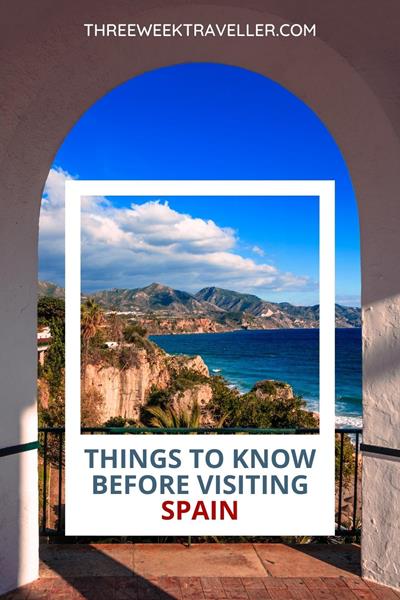
Wander-Lush
The Ultimate Spanish Road Trip Itinerary: Barcelona to Seville
Plan your dream road trip through Spain with this epic Spanish road trip itinerary! I’ll show you how to spend a perfect 3 weeks in Spain travelling from Barcelona to Seville, plus everything you need to know about renting a car to self drive in Spain.
I was part-way through planning a six-week Eurotrip with my partner when I became fixated on visiting Spain.
Spain had never really factored into my travel plans. But as soon as I realised just how much variety the country has to offer – from majestic mountain villages and enthralling cities to romantic small towns and a postcard-perfect coastline – not to mention the sheer number of historical and UNESCO sites held within its borders – I decided we should spend a whole three weeks in Spain.
Wanting to pack as much into our short stay as possible, we thought renting a car for a Spanish road trip would be the best way to see the main sights plus a few smaller towns.
We were right – the action-packed Spain itinerary we devised saw us criss-cross the country from north to south, taking in most of the country’s top attractions .

Spain is one of the top places for a self drive holiday in Europe. Both rental cars and petrol are relatively affordable. Travelling in shoulder season (November), we were often the only car on the road. For the most part, parking is cheap, even in hot spots like San Sebastian.
Best of all, having our own transport opened up a lot of opportunities to visit smaller towns and squeeze more into each day than our slow travel style would normally permit. Our trip was certainly fast-paced, but it was worth it to get a good overview of Spain in a short period.
This tried-and-tested itinerary for a three week self drive road trip across Spain includes my top recommended activities for key cities, ideas for where to break the journey, some handy Spain driving tips, and much more.
Please note: This post contains affiliate links, meaning I may earn a commission if you make a purchase by clicking a link (at no extra cost to you). Learn more.
Where to hire a car in Spain
Hiring a car in Spain is an efficient and affordable way to see a large part of the country in a short period of time. Since a lot of visitors drive in Spain, the market for rental cars is competitive, meaning you can usually get a pretty good deal.
We planned our Spain road trip from Barcelona, so we decided to rent our car on our last day in the city. I recommend collecting your car from Barcelona-Sants train station because it’s easy to get to using public transport, and easy to leave from to get to the highway.
There are two main things to consider when choosing a hire car: transmission type, and size of the vehicle. Manual cars are much more ubiquitous in Spain so it can be harder to find an automatic car to rent. In addition, you should prioritise hiring a small car that will be easier to park on the street and can better navigate narrow village roads (these were our two biggest qualms about driving in Spain!).
Discover Cars lets you easily browse and compare different rentals cars from a variety of international and local agents. It lets you choose the exact features you want, and offers a full range of price and date options so you can find the best value for money. Visit Discover Cars and plug in your dates to see what’s available .
At the end of the itinerary, I’ve included a few driving tips for Spain.
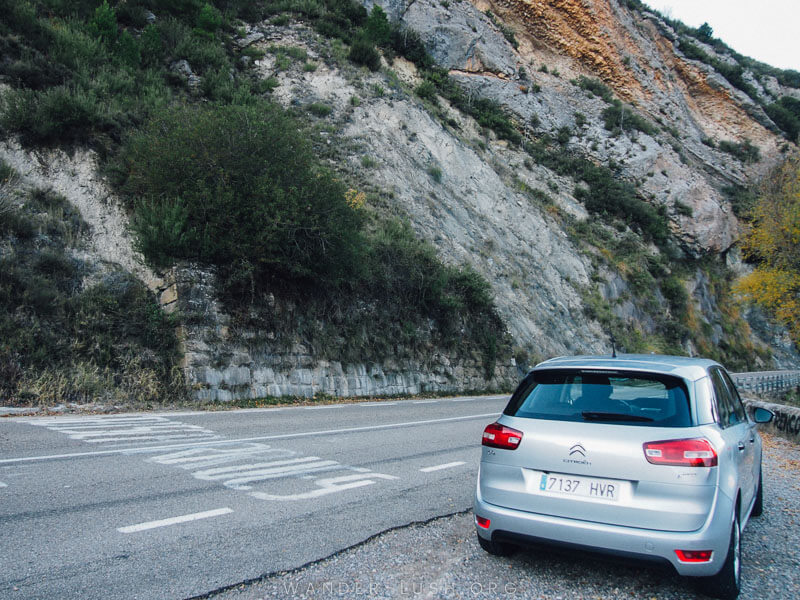
About this Spain itinerary
Looking back over our itinerary makes my head spin a little! We drove almost every day and covered a lot of ground, but by splitting the long drives up into smaller journeys, we still got to visit some interesting local towns.
Spanish highways are incredibly easy to drive on and the scenery is invariably stunning no matter where in the country you are. Because of this, driving never really feels like a drag – it’s all part of the experience.
We started our road trip in Spain from Barcelona and finished up in Seville. From there, we continued on to Tarifa by bus and caught the ferry to Tangier, Morocco. You can adapt this itinerary to create a loop, but I recommend paying the one-way car rental fee so you don’t have to backtrack. If your Spain trip ends there and you’re not continuing on to Morocco , you can fly straight out of Seville.
There are endless options and itinerary combinations for seeing Spain by car. I’m not saying mine is the best road trip in Spain – but I can tell you that it’s tried and tested. Of course there are some things missing (you can’t possibly see all of Spain in 3 weeks), but after I did this road trip, I felt like I’d seen the main highlights.
If I had my time again, I would extend our stay in Madrid by a few days.
A good way to save time is by taking advantage of the Spain day trips and tours mentioned in this itinerary. If you think there’s too much packed in, you can easily take out a few places and stay in certain locations for longer (Madrid and Granada would both be ideal places to extend your time).
How much time do you need to drive across Spain?
A Spain road trip can be as long or as short as you want it to be. As you’ll see from the map, we covered most of the country (apart from the north-west) in 21 days touring Spain by car.
Remember you don’t want to rush driving across Spain too much. Three weeks is the absolute minimum amount of time you need for a Spain road trip like this one – unless you’re prepared to seriously cut down on the number of places you visit.
This 3-week self drive Spain itinerary is fast-paced, but if it’s a once-in-a-lifetime trip to Spain that you’re planning, you probably won’t mind hustling to see as much of this beautiful country as humanly possible.
If you have less time in Spain, you can do a shorter itinerary that focuses on the North of Spain (Basque Country) or the South of Spain (Andalusia).
Spanish road trip route overview & drive times
Let’s start with a basic overview of our Spain road trip itinerary and the 17 cities, towns and villages we visited in Spain in 3 weeks.
Remember you don’t have to follow this itinerary exactly – you can use it as a Spanish road trip planner to pick and choose the destinations that most appeal to you.
- Days 1-3: Barcelona
- Day 4: Barcelona to Sos del Rey Católico via Zaragoza (400km; 4.5 hours of driving)
- Day 5: Sos del Rey Católico to Bilbao via Pamplona and San Sebastián (217km; 2 hours of driving)
- Day 6: Bilbao
- Day 7: Bilbao to Madrid via Segovia (400km; 4 hours of driving)
- Day 8: Madrid
- Day 9: Madrid to Toledo (72km; 1 hour of driving)
- Day 10: Toledo to Valencia via La Mancha (270km; 4 hours of driving)
- Day 11: Valencia
- Day 12: Valencia to Cartagena (270km; 3 hours of driving)
- Day 13: Cartagena to Lanjarón (330km; 3.5 hours of driving)
- Day 14: White Villages and the Sierra Nevada
- Day 15: Lanjarón to Granada (46km; 45 minutes of driving)
- Day 16: Granada to Córdoba (200km; 2.5 hours of driving)
- Day 17: Córdoba
- Day 18: Córdoba to Seville (145km; 1.75 hours of driving)
- Days 19-20: Seville
- Day 21: Depart Seville – or Seville to Tangier via Tarifa
This Spain itinerary covers a whopping 2,450km (1,523 miles). Remember that not all the driving is back-to-back, there are some rest days in between!
Spanish road trip map
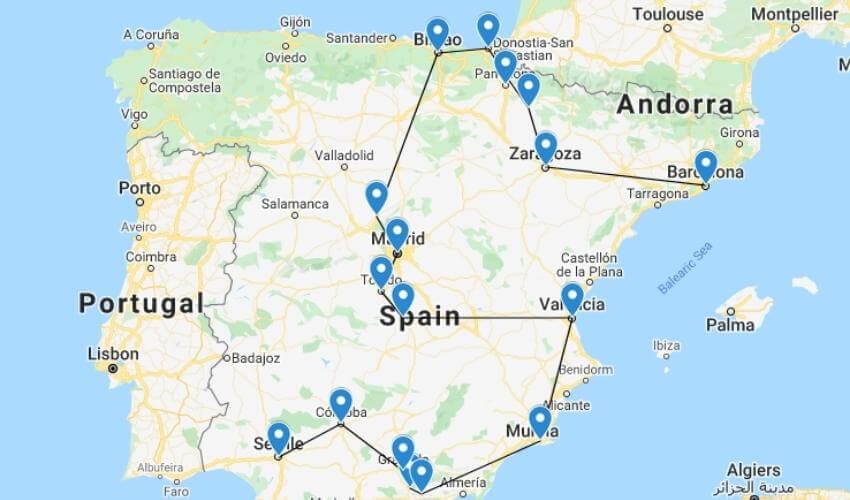
Detailed self drive Spain itinerary
This section includes a detailed day-by-day breakdown of our 3 weeks in Spain, including the best things to do in each city, where to stay, and where to break up longer drives.
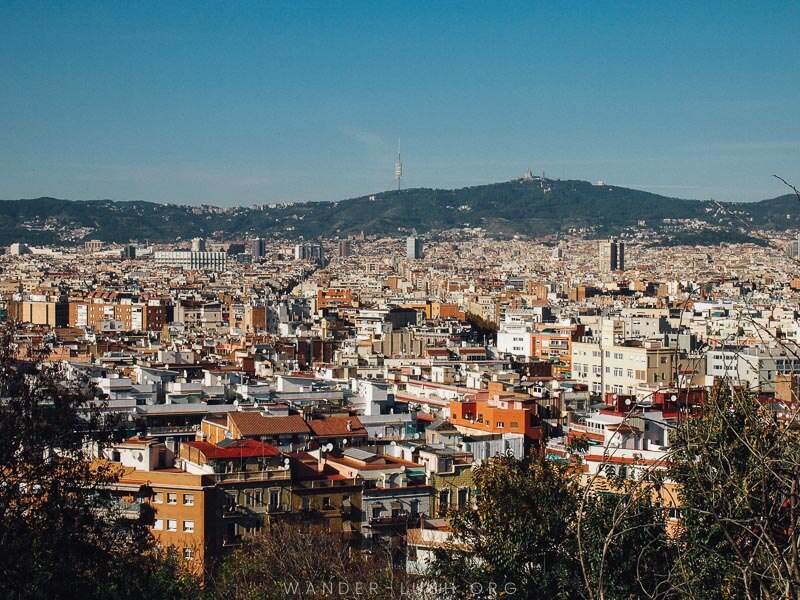
Vivacious Barcelona is the perfect place to start your Spain road trip itinerary. Capital of the autonomous Catalonia region and the second-largest city behind Madrid, Barcelona is quintessentially Spanish and offers a perfect introduction to many of the things that make Spain so great – incredible architecture, beautiful beaches, and fabulous cuisine.
On top of that, Barcelona is logistically the best place to start a trip through Spain. It’s home to an international airport, a train station with services from most other countries in the region (we arrived by night train from Geneva), and a ferry terminal.
I recommend spending at least 3 days in Barcelona to get a good feel for the city and see the main highlights. The city has a great public transport system, so you don’t need a car here – in fact, it would be a major burden.
I highly recommend picking your car up on the day you leave Barcelona. Most rental companies have offices at Barcelona-Sants, the city’s main train station. This is a good place to start as the traffic isn’t too hectic and you can easily get to the highway.
Where to stay in Barcelona
Barcelona is huge – where you stay can make or break your trip. Take some time to familiarise yourself with Barcelona’s inner-city neighbourhoods so you can make an informed decision.
Here are a few recommendations for where to stay in Barcelona – car or no car.
- Ayre Hotel Rosellón . Located in the shadow of the Sagrada Familia, you won’t find a better patio view anywhere else in Barcelona (just look at the pictures if you don’t believe me!). Parking at the hotel is guaranteed and only costs a modest 16 Euros extra per night.
- Barcelona Catedral Hotel . This modern boutique hotel has light-filled, spacious suites, a rooftop pool and patio, and offers free walking tours for guests. Note that secure parking costs a bit extra, and you’ll need to reserve a spot in advance.
- Motel One Barcelona-Ciutadella . Don’t let the name ‘motel’ fool you – this is a boutique hotel through and through. If you can tear yourself away from the trendy lounge-bar and rooftop terrace overlooking the city, it’s a short 20-minute walk to Las Ramblas. Private parking is offered at a nearby location and costs an extra 20 Euros.
- Unite Hostel Barcelona . My top budget choice in Barcelona, this boutique hostel offers dorms and private rooms, all bright, clean and minimally furnished. The yoga studio and co-working spaces are the cherry on top. Reserve on-site parking in advance for 18 Euros/night.
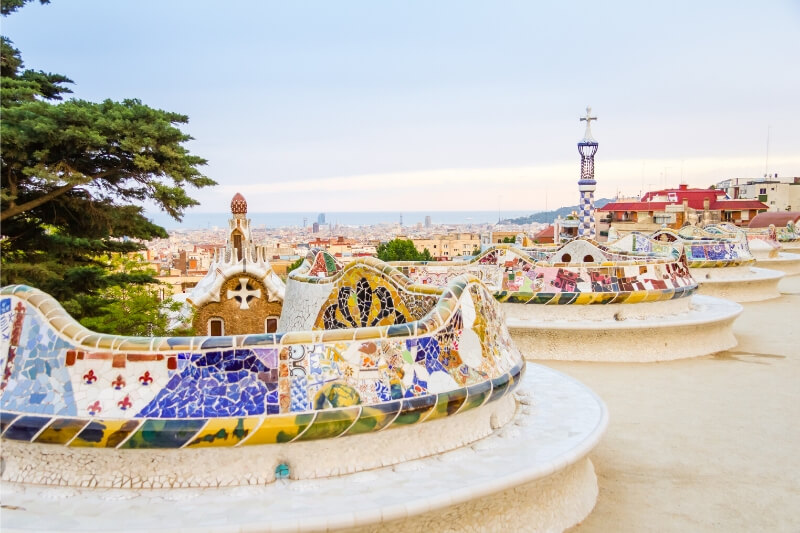
Things to do in Barcelona
In all honesty, planning a Barcelona itinerary can be a bit overwhelming. There’s just so much to see and do. I’m only recommending a few select activities and restaurants that we really enjoyed – know that there is a lot more out there!
Start by pounding the pavement on Sandeman ‘s free city walking tour . This will help you get your bearings while introducing you to some of Barcelona’s must-sees, including the Gothic Quarter and Barcelona Cathedral.
La Sagrada Familia , the grand cathedral designed by Gaudi, is the symbol of Barcelona. You should prioritise visiting on your first or second morning. Skip-the-queue tickets are essential – or else you risk spending hours waiting in line. Pre-buy your skip-the-line tickets for the Sagrada Familia online.
Gaudi’s other works in Barcelona, including the iconic Park Güell Monumental Zone (buy fast-track tickets here ) and Casa Batlló are absolutely worth a visit as well. Even if you’re not that interested in architecture, these buildings all capture the spirit of Barcelona and tell a fascinating story of Spanish and Catalonian history. The experience is even richer if you’re accompanied by a guide who can illuminate the symbology.

Ride an e-bike around the gorgeous Gothic Quarter to explore one of Barcelona’s most charming neighbourhoods. For a break from the hubbub, head for the hills and spend an afternoon wandering around the cactus gardens at Montjuïc . Take the cable car over La Barceloneta beach for fantastic views, and visit the beach itself if the weather is right.
Don’t skimp on the food, either! Barcelona is packed with incredible restaurants . We especially loved eating Spanish ‘ hamburguesas ‘ at Hamburguesería Bacoa and pigging out on homemade churros at Bar Churrería Layetana . If you’re a foodie, this market to table tour of Mercado de La Boqueria , Barcelona’s biggest produce market, is a must-do.
Take advantage of the free entry to Museu Picasso every Friday night – it’s busy, but it’s a wonderful experience. And for something truly memorable, try to see a gig at the Palau de la Música Catalana (we watched an unforgettable performance by the late, great Sharon Jones). If there’s nothing on, I highly recommend booking in for a short guided tour – it’s truly one of the most majestic buildings I’ve ever been in (aside from Sagrada Familia!).
Recommended day trips from Barcelona
If you decide to extend your stay in Barcelona, there are lots of fantastic day trip opportunities within a few hours’ drive of the city.
- Get your Game of Thrones on in charming Girona
- Visit family run wineries and taste tapas in the Penedès region
- Discover the mysteries of Montserrat solo or with a guide
No car? This 12-day journey around Spain by train , starting from Barcelona, takes in some of the country’s best cities and beaches.

It’s time to hit the road! After collecting your car in Barcelona, start heading due west towards the Bay of Biscay. The drive to Zaragoza takes 3 hours. If you want to make it in time for lunch, try to leave the city as early as possible (by 8am at the latest). That way you’ll also beat most of the traffic.
Zaragoza lies smack-bang in the middle of northern Spain. Capital of the autonomous Aragon region, it’s one of the country’s most underrated cities and an ideal place to break for lunch and a short walk.
On reaching Zaragoza, we stopped at a small tavern in the shadow of the Aljafería Palace and ate a bowl of fideos negros (black noodles simmered in fish stock). There are plenty of restaurants and gastrobars around the river, close to the historic centre. However, it might be tricky to find a car park, so I recommend heading to the city’s western fringe like we did.
Sos del Rey Católico

When I picture an archetypal Spanish town, the Sos is what comes to mind. This little village on the frontier of the Pyrenees is located another 1.5 hours’ drive north of Zaragoza, so I recommend leaving after lunch no later than 1pm to maximise your time in Sos.
Ferdinand II of Aragón, husband of Isabel I of Castilla and one-half of the most influential royal couple in Spanish history, was born here in Sos. The little town is loaded with history and packed with charm.
The town is petite and easily navigated during an evening or early morning stroll ; admire the flower boxes, pop in and out of charcuterie shops, and listen to the church bells toll.
We stayed a night at the Parador de Sos del Rey , which sits on a low rise overlooking the Sos’ ancient cobbled streets (you might recognise it from the 2017 film The Trip to Spain ) and had a very memorable meal at the Parador’s Cinco Villas-themed restaurant.
Where to stay in Sos del Rey: Hotels with parking
- Parador de Sos del Rey Catolico . It’s honestly worth the splurge to stay at this Parador. Set in a historic Aragonese mansion that overhangs Sos’s winding streets, it’s one of the most romantic hotels I’ve ever had the pleasure of spending a night in. Rooms are plush as, and the set dinner at the on-site restaurant is a must-try (I’ve never eaten so much food in my life). Parking on the grounds is free and easy.
- El Peiron . For a budget-friendly alternative, this hotel has a similar 17th century ambiance. Cozy rooms feature large beds and exposed stone walls. The location on Sos’s main street, close to some of the village’s best tapas bars, will make you feel like you’re part of the city (unlike the Parador, which makes you feel like absolute royalty). Free street parking is available near the hotel.

On your next full day of driving, break the 2-hour journey to the Bay of Biscay by stopping off in Pamplona for lunch. This will be your first taste of Basque Country tapas ! Pamplona is the perfect place to practice the art of ordering ahead of your arrival in San Sebastián.
Outside of the famous San Fermin (Running of the Bulls) cultural festival , which takes place in Pamplona every July, the streets are surprisingly peaceful and sparse. Bakeries and boutiques run the length of the main pedestrian drag and are well worth a browse.
San Sebastián

Most people head straight for San Sebastián’s pintxos bars , but don’t forget to take a stroll along the waterfront promenade , too. After a day’s drive, this is exactly what you need to stretch your legs and re-fuel.
We spent a few early evening hours in San Sebastián, and while I didn’t really fall head over heels for the town like I’ve known other people to do, it’s a worthwhile stopover on the way to Bilbao. If food is in your wheelhouse, you can easily switch your itinerary and stay in San Sebastián instead of Bilbao.

Bilbao and San Sebastián are only an hour’s drive apart, so you can plausibly stay in one city and visit the other as a day trip. If I had my time again, I would probably stay in San Sebastián instead.
The futuristic Guggenheim Museum is Bilbao’s main attraction, but I found the rest of the city a little bland. One full day is ample time to see the museum and explore Bilbao’s riverfront.
In 24 hours, you can discover the city by bicycle and tour a few of the key Game of Thrones filming locations around Bilbao. An in-depth Basque County gastronomy tour is worth considering if you’re particularly interested in food and wine (let’s face it, if you’re planning a trip around Spain, you probably are!).
Where to stay in Bilbao: Hotels with parking
- Hesperia Bilbao . These trendy self-contained apartments are a 10-minute walk from the city centre (just across the river from the Guggenheim) and feature everything you need for a comfortable stay in Bilbao. There’s even a Japanese restaurant and a rooftop terrace bar – because both those things are basically travel essentials nowadays. Secure parking can’t be reserved but is available at an extra charge.
- Ercilla Hotel . For something with a touch more old-world charm, this boutique hotel offers pretty rooms with herringbone floors and chequerboard tiles. The restaurant serves traditional Basque food, and there’s a panoramic bar here as well. Park on-site for 20 Euros (reservations essential).
- Parador de Limpias . If you don’t mind staying outside the city, this Parador is a 50-minute drive from Bilbao. The former summer residence of King Alfonso, the setting amongst private gardens and a protected woodland is just divine. Free parking is plentiful.

After a short but sweet introduction to Basque Country, it’s time to leave the coast and start driving inland towards Madrid.
Segovia is 100km shy of Spain’s capital city. Coming from Bilbao, you’ll naturally pass through it – so there’s no reason not to stop off and check out two of Central Spain’s most impressive historical sights.

Aqueduct versus alcazar – when an urban landscape is a battle between the most important Roman civil engineering work in Spain and a Moorish palace so beautiful that it’s instantly recognisable from pop-culture, you know you’re in for a treat.
Segovia is a complete contrast to Madrid. Park your car on the hill leading up to the aqueduct and ease your way into the capital by wandering around this charming town for a few hours first.

Climb the concealed staircase to the right of Segovia’s UNESCO-listed aqueduct for a different perspective on this feat of engineering. Visit The Alcazar , apparently Walt Disney’s architectural inspiration when creating Cinderella’s castle.
Between 10.30am and 4.30pm you can join a 60-minute guided tour of Segovia Cathedral , another of the city’s landmarks. This particular tour also allows you to climb the 500-year-old bell tower for a panoramic view of Segovia.
And as a reward for all that walking, treat yourself to a Pasteleria Limon y Menta , Segovia’s signature pastry. It’s lemony, it’s minty, and it’s wrapped in caramelised marzipan. Yum!
If you opt to drive straight into Madrid, you can always visit Segovia on a day trip.

Our first experience of Madrid was the nightmarish drive through the city at peak hour. Don’t make the same mistake we did – try to arrive in Madrid before nightfall!
Where to stay in Madrid: Hotels with parking
- Only YOU Hotel Atocha . The design of this jaw-droppingly beautiful hotel draws on the 19th-century building its housed inside. Deluxe rooms face onto an inner courtyard and are bright and airy as a result while still feeling private. There’s a cafe, bakery and lounge, and breakfast is served on the 7th floor with city views. The Prado Museum is only 900m away, making this a great choice for museum and culture lovers. Parking on-site is guaranteed and costs extra.
- Hostal Patria Madrid . Coming in at under $100 a night, this hotel is excellent value for money in Madrid. Rooms are basic but comfortable with Scandi-style furnishings, and the location on a popular cafe strip is perfect for hungry travellers. Parking (reservation required) costs a very reasonable 17 Euros.
- Parador de Alcala de Henares . If you want to avoid driving into Madrid (smart choice!), this Parador is 45 minutes outside of Madrid. The 16th-century convent building reminds me of a Silk Road Caravanserai. There’s an outdoor pool, and parking on the grounds costs a little bit extra.
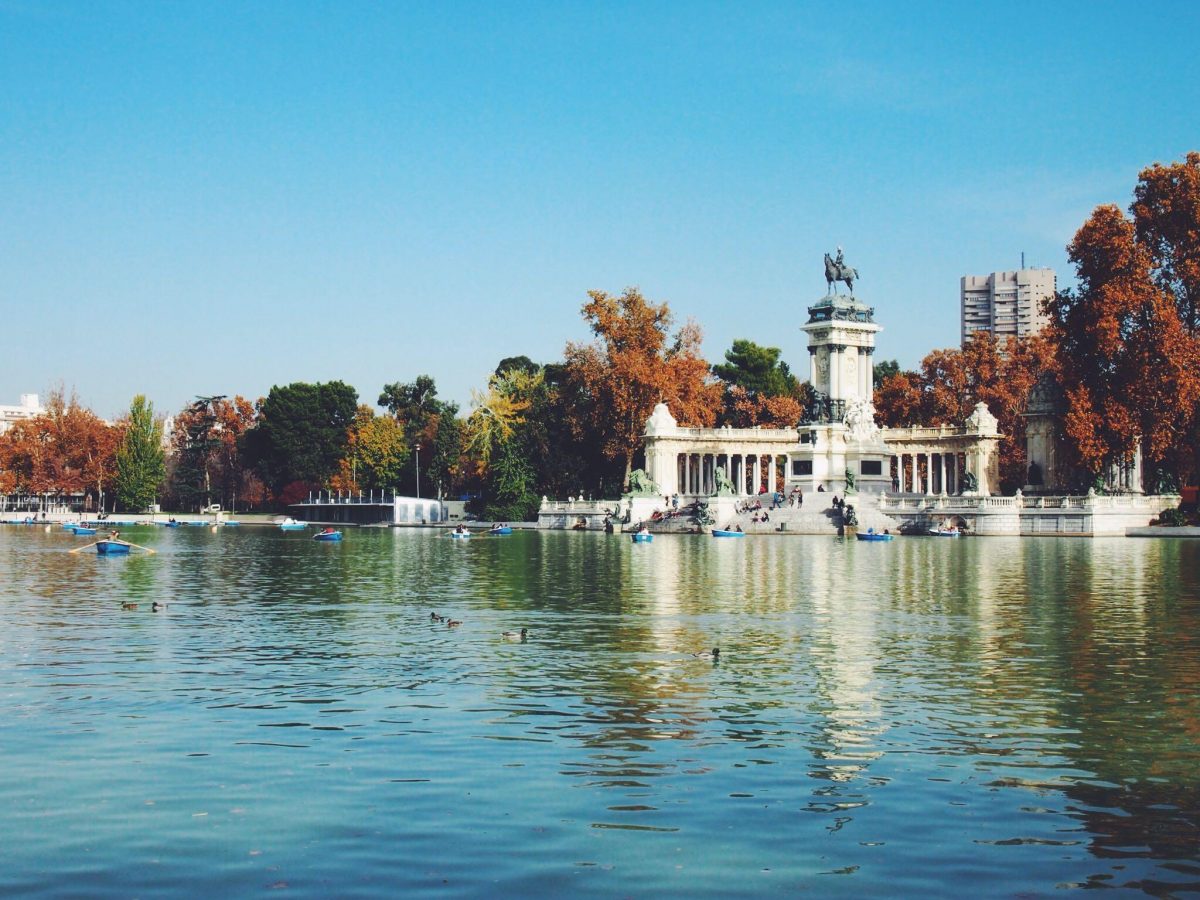
Things to do in Madrid
An easy walk or cycling tour through the city is the best way to see central Madrid. Make sure you explore the gorgeous Real Jardín Botánico , wander through the bookstalls that line Cuesta del Moyano , and top it off with sunset at the Temple of Debod , an ancient Egyptian temple that was dismantled, shipped to Spain, and reassembled in all its glory on a hill in the city centre. A live flamenco performance is the perfect way to end your first day in Spain’s capital.
For a dose of history and culture, visit Madrid’s four most iconic landmarks: The Plaza de Toros de Las Ventas , the Royal Palace , the Plaza Major , and of course the Prado Museum .
Here are my top tips for exploring historic Madrid:
- Join a tour of Las Ventas to access some of the building’s hidden nooks and crannies.
- Take in the scale of the magnificent Plaza Major on a bicycle. This 3-hour small group tour takes in many of the city’s highlights.
- Let a professional guide show you around the Throne Room, Banquet Hall and Private Royal Apartments inside the Royal Palace. This 2-hour tour is excellent value for money.
- Skip the line by buying your Prado tickets online in advance through Get Your Guide .
Recommended day trips from Madrid
- Visit the UNESCO World Heritage Site, Cuenca , and its amazing ‘hanging houses’
- See the ‘three cities’, Segovia, Avila and Toledo, on a day trip (a good option if you want to condense your Spain road trip itinerary and stay longer in Madrid)
- Tour the wineries around Madrid and taste the local drop
- Cast your eyes on the surreal landscape of El Escorial and the Valley of the Fallen

Leaving Madrid, start your journey to Southern Spain’s enchanting Andalusia region. Over the next 12 days, you’ll be driving from Madrid to Granada and Cordoba via some of the loveliest small towns and historical villages in the country.
The first of these, Toledo , is just an hour outside Madrid. After the chaos of the capital, it’s a salve. Toledo’s mix of old-world charm, literary heritage and multicultural influences makes it one of my favourite places in all of Spain. I highly recommend staying for at least one night.
Toledo is the first place where you can see, hear and smell the Middle Eastern/North African influence that becomes more and more pronounced the further south you travel. We had a wonderful introduction to Syrian and Turkish food in Toledo, which became our go-to cuisine for the remainder of our trip.
Where to stay in Toledo: Hotels with parking
- Hotel Santa Isabel . A great budget choice at under $40 per night, this charming guesthouse is right in the heart of Toledo. Private balconies overlooking the town rooftops and a central courtyard are terribly quaint. Rooms are a bit boxy, but nicely finished and clean. Reserve parking in advance for 12 Euros per night.
- Parador de Toledo . This is another great candidate for a little splurge. Set 4km from the centre of Toledo in a low-set historic building, rooms here are a bit more outdated than at other Paradors, but the outdoor pool and panoramic terrace are lovely. Parking is free.

Toledo is the spiritual home of Don Quixote , Spain’s literary legend. A great way to see the old town is by walking the Don Quixote Trail . Alternatively, let a Toledo local show you around on a private walking tour .
Fall in love with Syrian food at Posada El Cristo de la Luz , then down a sampler box of marzipan from Santo Tome (the signature sweets of Toledo).
For more Toledo inspiration, see this list of the top 10 things to do in Toledo .
Consuegra, La Mancha

I’m a huge fan of Miguel de Cervantes’ Don Quixote , but even if you’ve never read the book, a quick detour through Spain’s iconic La Mancha landscape, with its towering windmills and patchwork fields, is an absolute delight.
Leaving Toledo and driving east, aim to arrive in the small town of Consuegra in the early morning before the tour buses pull in at around 10am.
Stop at one of the provincial bakeries for a quick bite. You can then drive all the way to the top of the hill and explore the windmills on foot.

Spain’s third-largest city, Valencia has all the charm of Barcelona and all the amenities of Madrid with a laid back, beach-town feel. This is the Orange Blossom Coast , and the streets of Valencia are lined with citrus trees (which you must pick and sample – luckily our Airbnb came with a juicer!).
Valencia is also the traditional home of paella and Spain’s signature beverage, horchata. While we weren’t all that impressed with the City of Arts and Sciences , we loved cycling through the elongated Cabecera Park that runs through the heart of the city. (Perhaps we should have opted for the rooftop wine and tapas tour instead!) If you’re an outdoorsy type, you’ll adore Valencia.
Driving in Valencia is relatively easy compared to Barcelona or Madrid, so you can stay in the city centre without having to worry too much about traffic or navigating the roads.
Where to stay in Valencia: Hotels with parking
- HQ Rooms Apartments San Vincente . Spacious and featuring all the mod-cons, this self-containted apartment sleeps up to 8 people and comes with a large private balcony. It’s 1.5km from the centre of the city, and there are bicycles available to rent for a small fee. Parking costs an extra 15 Euros.
- Palacio de Rojas . 350m from Valencia’s Central Market, it doesn’t get much more inner-city than this. The canary yellow facade, the indoor-outdoor living spaces, the high ceilings and the heavy doors… This must be one of the most beautiful hotels in all of Spain. Seriously. Palacial apartments sleep up to 9 people and all feature a full kitchenette. Underground parking is available for an additional 15 Euros.
Things to do in Valencia
You’ll probably be quite content hiring a bicycle and exploring Valencia at your own pace. If you want a deeper look, try joining a private walking tour with a local .
For a hands-on activity, I highly recommend taking a paella cooking class and learning just why Valencia is the birthplace of Spain’s most famous dish. Head to the Plaça de Santa Caterina to try a glass or horchata (or two) at one of the open-air cafes. Horchateria Santa Catalina is my personal favourite.
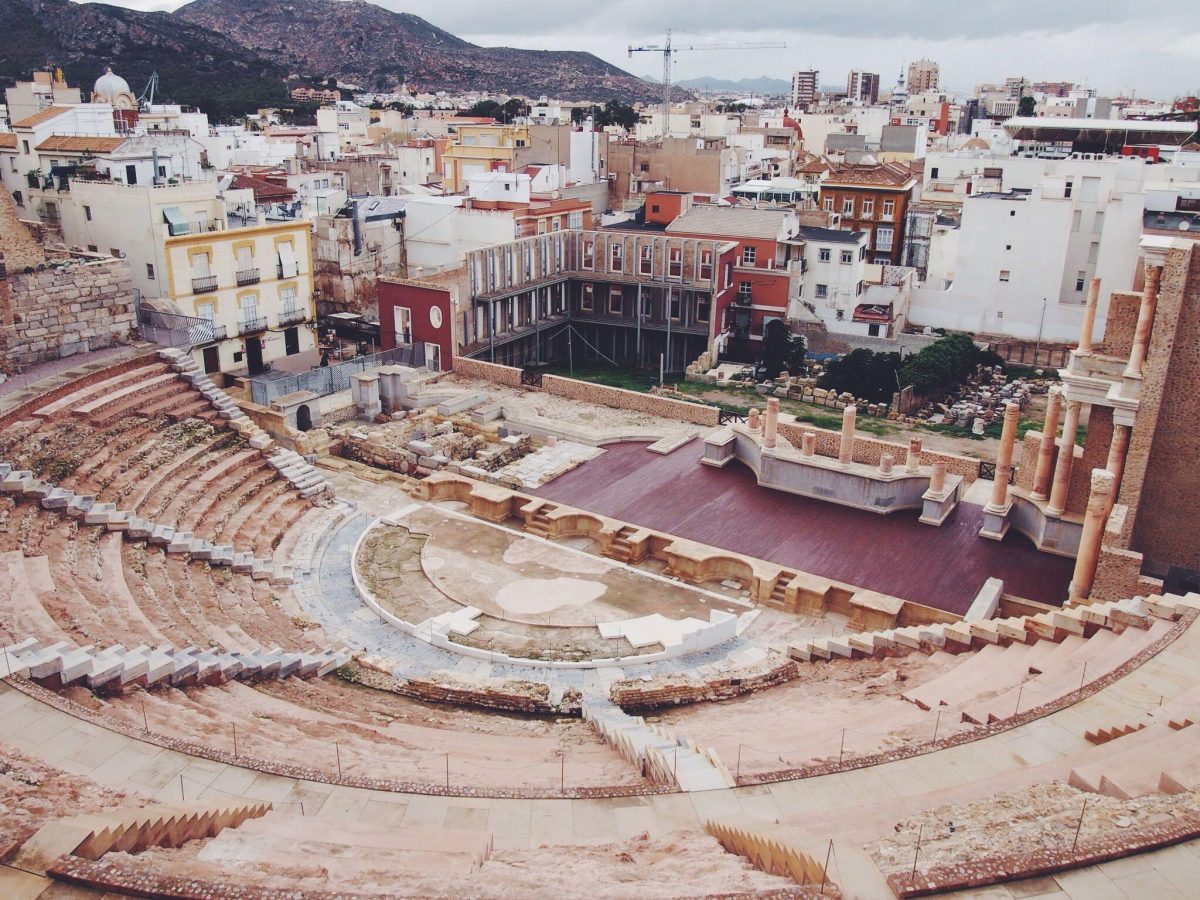
Three hours’ drive down the coast from Valencia, Cartagena is another of Spain’s most underrated cities. We rolled into the sleepy historic centre in the early afternoon and were greeted by a medieval festival, the annual Mercado Medieval (how’s that for timing!).
Catagena’s Roman amphitheater is one of the best-preserved in all of Europe, and exploring the state-of-the-art museum was honestly one of the most enjoyable ‘historical’ experiences I had in Spain. It’s fascinating to see how the city has been built-up around the ruins.
Cartagena is small so you only need a day or two at the most. Start by getting your bearings with a walk around the inner city. The food scene here is great, so I also recommend doing a gourmet tapas tour .
Where to stay in Cartagena: Hotels with parking
- NH Cartagena . Elegant rooms with a view of Cartagena port are the stand-out feature of this efficient hotel. It’s only 200m from the Roman Theatre but in a quiet corner of town, so you can still get a good night’s sleep. Reserve paid on-site parking at the time of booking.
The Sierra Nevada: Lanjarón and the White Villages

Leaving Cartagena behind, you’ll next be driving the coast of Spain (at least a portion of it) and dipping inland to visit one of Spain’s most beautiful natural landscapes, the Sierra Nevada.
Once you hit the mountainous Las Alpujarras region, you’ll realise what a blessing your hire car truly is. Navigating the windy, steep, narrow roads around the white villages was nail-biting at times, but I can’t imagine trying to get around any other way.
Base yourself in Lanjarón , the area’s most populous village and home to a number of quirky accommodations, including the healing retreat/yurt we stayed in.
Once a hippie mecca and still famed for its spring water and olives , Lanjarón is a gateway to the smaller villages of Pampaneira, Bubio and Capileira . If you can brave the altitude, add Trevélez (Spain’s highest settlement) to your driving itinerary.
Some of the villages take a good few hours to get between, especially in inclement weather, so I recommend setting aside at least two days to explore the area, more if you intend on hiking between the villages .

Where to stay in Sierra Nevada: Hotels with parking
- Hotel Alcadima (Lanjarón). Homely suites at this quaint little hotel are excellent value for money. Indoor and outdoor pools, plus a kids’ play area, make it a great choice for families. The restaurant specialises in roast lamb with cinnamon. Need I say more? Parking costs an extra 10 Euros.
- Enchanting Yurt (Lanjarón). One of the coolest Airbnbs we’ve ever stayed at, this whimsical yurt is set in an olive grove at the foot of the mountains. It’s absolutely magical, and the Israeli hosts are very kind and welcoming. Free parking is plentiful.
- Parador de Nerja (Nerja). Another town, another Parador! This one is a bit different because it’s set inside a modern building on a cliff top overlooking the ocean. An elevator ferries guests down to the nearby beach (how cool!). Private parking is available for an additional charge. Note that it’s a 60-minute drive to Lanjarón.

Granada boats a quixotic mix of Spanish and Moorish cultures. The Alhambra is an architectural triumph – if it’s not on your itinerary, you’re doing Spain wrong!
You need to buy tickets to the Alhambra and Generalife Palace and Gardens a day or two ahead of your visit (or a week in advance if you’re travelling in summer). The easiest way to do that is by booking online through Get Your Guide .
On the day of your visit, make sure you leave early to account for the time it takes to access the complex (which includes a long, beautiful walk through the forest if you’re using public transport).
Where to stay: Granada hotels with parking
- Eurostars Catedral . The exception location 70m from Granada Cathedral is only topped by the traditional coffered wooden ceilings inside some of the suites. Rooms are otherwise modern and luxurious with more subtle nods to the building’s history sprinkled throughout. Parking costs an extra 22 Euros per day.
- Anacapri . This 18th-century house turned boutique hotel wears its heart (and its history) on its sleeve. The inner courtyard is outstanding, and rooms are very comfortable. It’s even closer to the cathedral and just 20 minutes’ walk from the Alhambra, right next to the start of the pathway. No reservation is required for the off-site parking (an extra 20 Euros per day).
- Alhambra Palace . Just shy of the city walls to Granada’s iconic UNESCO attraction, this hillside hotel has spectacular views, Moorish-inspired decor, and of course, quick access to the Alhambra. Secure parking is off-site and costs 22 Euros.
Things to do in Granada
After the once-in-a-lifetime experience of The Alhambra, everything else pales in comparison! However, Granada has a lot more to offer, which is why I suggest staying an extra night (or even longer, if you can).
Discover the city’s most charming neighbourhoods , Albaicín and Sacromonte, on foot with a walking tour. Watch a traditional flamenco performance inside Albaycin, and treat yourself to an authentic Arabian hammam bath .
There is a secret sunset spot in the hills above Granada where you can watch the warm light bathe the entire Alhambra complex before someone flicks the switch and it lights up like a beacon on the hill. Don’t miss it!

From The Alhambra to Códoba’s Mezquita, a fascinating mosque-cum-church that is home to a set of much-photographed candy cane archways. Córdoba is an archetypal Andalusian city (my favourite in the region) and has many other offerings, including a pleasant waterfront and some incredible vegetarian restaurants.
Every year, Córdoba hosts the Patio Festival , which showcases the amazing indoor gardens that are a traditional part of every home here. Make sure you peek inside a few doorways as you’re wandering the town’s lanes. This is also a good place to catch a Flamenco/equestrian show – our pick is the Royal Stables of Córdoba .

Where to stay: Córdoba hotels with parking
- Hotel Boutique Patio del Posadero . This intriguing little hotel features bespoke rooms and a beautiful patio (as is the style in Cordoba). The outdoor swimming pool and terrace lounge are perfect for summer. Reserved parking costs extra.
- Hotel Cordoba Center . A bit further from the mosque, this ultra modern hotel sits on the city’s Golden Block next to the AVE Train Station. The 7th floor pool and Jacuzzi are particularly noteworthy, but it lacks the charm of some other Cordoba hotels. Non-reserved parking is located on site.
- Parador de Cordoba . It’s almost your last chance to stay in a Parador! Cordoba’s is a fine choice – another renovated summer palace, it’s located north of the centre and boasts a massive pool plus sprawling gardens (the grounds, Los Naranjos, are where the first palms brought to Europe were planted.) Rooms are extremely spacious and well-appointed. Parking is free.

Things to do in Córdoba
Join the official Mezquita tour (price includes entry) and see this incredible UNESCO mosque-cathedral up close. In the summer, cycle the waterfront on a bicycle tour , or visit seven of Cordoba’s most impressive patio gardens and learn about the history of the city’s courtyard tradition.
If you have an extra day, venture outside the city to see the impressive Azahara Medina .

An entire day can easily be spent inside Seville’s Alcazar complex , another incredible palace – this time in the Andalucian style – that mirrors The Alhambra in its layout and design. GoT fans will recognise the Alcazar as the setting for the Water Gardens of Dorne.
Seville is a sun-bathed walking city, and the Plaza de Espana , Barrio Santa Cruz and Parque de Maria Luisa are all worth a wander.
I found Seville a lot grungier than other places in Spain. The streets are filled with cool v intage stores and hip cafes , and the city has a great vibe.
We returned our rental car in Seville and got around the city very easily using public transport. I recommend you do the same.
Where to stay in Seville: Hotels with parking
- Hotel Las Casas de la Judería . If it’s atmosphere you want, look no further. This charming hotel is set with 27 traditional houses (yes, it’s big), all connected by courtyards and internal passageways. Traditional decor including antique furniture and French windows is straight from the history books, while the rooftop pool brings the property up to date. Some of the rooms are just spectacular – I couldn’t imagine a better way to end your Spain road trip than with a few nights here. The location in the old Jewish Quarter means there’s lots to be explored nearby, including the cathedral, which is just a 7-minute walk away. Off-site parking costs 24 Euros.
- Melia Sevilla . Modern, minimal and a complete contrast to the previous property, this hotel is centrally positioned off Plaza España. Twin hot tubs and a hamman round-out the ample services. Public parking near the hotel costs 24 Euro. Staff can help you coordinate, but I recommend you return your hire car before you check in.
- Hotel Rey Alfonso X . This trendy hotel features a summer pool that overlooks Seville’s oldest church. Business-like rooms are smart if not a little soulless. On-site parking costs extra (enquire at the time of booking).

Things to do in Seville
The Alcazar should be top of your list for things to do in Seville. This skip-the-line ticket includes a guided tour.
Marvel at Seville’s Cathedral and Giralda Tower , watch a flamenco show at Museo del Baile Flamenco (the birthplace of this Intangible Heritage icon), and walk through the gorgeous Santa Cruz Jewish Quarter (don’t forget your camera!).
If you want to get even further off the beaten path in Seville , I highly recommend this alternative market and walking tour .
Seville is a great place for a Spanish cooking class . This one shows you how to prep several popular Seville-style tapas , and includes bottomless sangria.

Recommended day trips from Seville
- The British Overseas Territory of Gibraltar is just a short drive from Seville
- See Ronda , a small town set on a dramatic gorge
- Village hop through the Andalusian countryside
- Visit the port city of Cadiz and the Moorish Jerez, two of Southern Spain’s most stunning cities
- Get another stamp in that passport! – take a full day trip from Seville to Tangier, Morocco
Quick tips for driving in Spain
Here are a few pointers to make your Spain road trip as smooth as possible.
Things to remember when renting a car in Spain
Obtain an International Driving Permit before you leave home. Most rental car companies require an IDP by law (you also have to carry your regular driver’s license).
Book your rental car well ahead of time , especially if you want an automatic transmission as they are in short supply. We could only find a few automatic cars available in Barcelona, and they were more expensive than manual. I highly recommend using Discover Cars to compare rental prices and reserve your car in advance .
Choose the smallest car possible. In between the narrow village streets and tight street parking spaces, you’ll want to go with the smallest car you feel comfortable with. Driving around Spain in a small car (a Hyundai or a Corolla, for example) is perfectly safe provided you stick to the highways and don’t go off-road.
Bring your own GPS (with maps for Spain and Portugal pre-loaded) to avoid the GPS rental fee. Alternatively, use your phone to navigate with Google Maps or Maps.Me – it works just fine, provided you have the map pre-downloaded for offline use or you have a Spanish sim card with plenty of data.
General driving tips & Spain road rules
Plan your route to avoid toll roads. Some tolls are very expensive – up to 20 Euros – but we managed to avoid most of these by taking indirect roads and alternate highways.
Avoid driving in the bigger cities , especially Madrid. Pick up and drop off your hire car from an office in the outer suburbs or the airport to avoid inner-city congestion.
Note the blood alcohol limit. If you plan on visiting any wineries while you’re driving across Spain, remember that the blood alcohol limit in Spain is 0.05% (or 0.01% if you’ve had your license for 24 months or less).

Tips for parking in Spain
Look for ‘Blue Zones’. If you’re visiting cities and towns for the day and need a place to leave your car away from your accommodation, you’ll need to get a grasp on how the street parking works in Spain. Blue Zones (portions of curb marked with a blue line) designate paid parking spots. Wherever you see Blue Zones, you’ll see a meter or automatic machine nearby where you need to register your car. Take the ticket and display it prominently on the dash, with the date and times face-up.
Yellow lines designate disable parking spots. You’ll need a displayed permit to park here. Other coloured zones vary from city to city but usually indicate Resident Zones. If you’re not registered to a nearby address, you obviously can’t park here.
Park during siesta hours. Depending on the city, metered parking is sometimes free between 2pm and 4pm Monday to Friday and after 2pm on Saturdays. If you want to save a buck, try finding a car park during siesta hours.
What to pack for your Spain road trip
A few of my favourite must-pack essentials to make your road trip around Spain comfortable, safe and hassle-free.
Travel insurance for Spain
The one thing I never travel without. When it comes to medical expenses, accidents, travel delays and the like, preferred partner for long-term travel insurance is SafetyWing .
When renting a car, make sure you read the PDS to see what you’re already covered for. I always recommend purchasing extra insurance just in case, either via the rental agent or through a provider such as Insurance4CarHire.
Handy gadgets
Travel adapters. If you carry a universal adapter, you’ll never get caught out with the wrong plug. This portable travel plug works in more than 150 countries (including Spain and the rest of the EU) and features 4 USB ports for charging multiple phones/iPads at once.
USB phone charger. Don’t let your phone run flat while you’re in the car. You can plug your regular charging cable directly into this Anker USB car charger . It works with most phones and iPads.
Car mount phone holder. Using a phone while driving is illegal in Spain. If you plan on using your phone to navigate around, you’ll need to use a mobile phone mount. This travel-friendly phone holder fits any phone or phone case, and has a 360-degree rotating cradle.
Lightweight cooler bag. An insulated bag to keep your drinks and road trip snacks cool is especially useful in summer. This simple family-size cool bag packs down into a neat, flat little bundle that you can easily squeeze into your suitcase.
Wine Wings. Whether you’re road tripping or not, these handy non-leak wine bottle protectors are one of my favourite travel items for Europe. Essential if you want to bring a few bottles of Spanish vino home with you!
Eco travel essentials
Refillable water bottle. It’s crucial to stay hydrated in Spain, especially in the warmer months. Tap water in most cities and towns is potable. As you drive through the mountains around the Sierra Nevada you’ll see fresh-water springs by the side of the road where you can fill up your water bottle (this was one of my favourite things about road tripping in Spain!). I highly recommend S’Well insulated bottles because they look good, stay cool for up to 12 hours, and they don’t sweat.
Reusable coffee cup. You’ll probably be drinking a lot of coffee in Spain. It’s always a good idea to bring a reusable cup that you can take with you in the car. This gorgeous gold barista-friendly travel mug is vacuum sealed (zero chance of a spill!) and will allow you to cut down on plastic and paper waste.
What to wear in Spain
Good walking shoes. Even if you’re on a Spain road trip, you’re still going to be spending a lot of time pounding the pavement (and cobblestone streets!). Comfortable walking shoes are absolutely essential. To cut down on luggage, we carry ‘stylish’ walking shoes in Europe that we can also wear out at night.
Sunglasses. Some highways in Spain are quite exposed – I guarantee you’ll be reaching for your sunglasses on the first day. Bring your favourite pair of polarized lenses, or pick up a pair of foldable travel sunglasses .
Loose, comfortable clothing. There’s nothing worse than feeling uncomfortable in the car. Pack a pair of travel leggings or yoga pants plus a few comfy t-shirts for longer driving days. A comfy travel cardigan like this one is a must-pack for winter in Spain.
Essential reading
A copy of Lonely Planet Spain. This essential guidebook for Spain is the perfect Spain road trip companion. As well as planning and logistics, it includes useful Spanish phrases and detailed information about Spain’s top tourist sites.
A copy of Back Roads Spain. This little book is a bit light on practical information, but it does contain some beautiful photos. Great inspiration for getting off the beaten track in Spain.
Spain paper map. Good for peace of mind if your sat nav fails you. Even if you don’t use it for navigating, you can still plot out your route and hold onto the map for a nice souvenir! This map is current for this year and covers both Spain and Portugal.
I hope you’ll agree that this is one of the best routes through Spain by car for first-time visitors who want to pack everything in. Are you planning a self drive Spain itinerary for your next road trip? Leave your questions in the comments!
Spanish road trip itinerary: Pin it!

50 Comments
This is such a great post, we did a very similar route over three months! We didn’t realise just how much we would fall in love with Spain.
Whilst in Spain, we were crashed into TWICE!!! both times when we were parked!! Although there is nothing we could have done to prevent this – I thought I would let you guys know! Spanish drivers can be crazy – even in a parking lot!!
Sorry to hear that Christie! Hope you still had a fun time!
Really love your post on spain. Just wondering if this will work also in winter in dec?
Hi Jaime, I don’t see why not – I was there at the start of winter and the weather was nice, roads quiet, etc. You might have to make some small adjustments for the mountain roads. Happy travels!
I travelled around Spain in a campervan from January to March this year and the weather was great. Even on the coldest days, the temperature was really mild and completely manageable. Bilbao was the only place that even felt remotely “wintery”, but with that being said, I’d take a Spanish winter over a Scottish winter any day!! I would 100% recommend visiting Spain over winter as it is not overcrowded with tourists and the weather is still good enough to do most outdoor excursions!
Looks wonderful! I recommend renting a car and driving off the road to get to know the culture and customs of people in the provinces. It is such a cultural and spiritual journey.
Amazing road trip! In Spain there is so many places to visit from the north with beautiful nature to the south with cultural impact. Love your style of writing.
Dear Emily, thanks for sharing your invaluable experience and tips. I’ve never been to Spain (but I will soon), except for the Canary Islands, so this thorough guide is just priceless while planning a trip. After seeing the super narrow streets on Tenerife, I can totally vouch for hiring the smallest car. We were lucky enough to hire a really small one while traveling around Tenerife. Otherwise, it would have been impossible to pass some of the roads, especially when there was a bus in our way.
Absolutely! We had a terrible (but also hilarious) experience with our car in Bilbao… Smaller is definitely the way to go in Spain!
Enjoy your trip!
Dear Emily, Thank you so much for sharing with us your great experience in spain, I’m very glad to read your trip report and happy to hear that you enjoyed it.
Regards, Hamid
Hey Emily, Love your travel blog. I was just wondering about the language barrier? My partner and I only speak English. Was it hard to communicate with people? Thanks!
You have nothing to worry about – English is widely spoken, even in small towns. For extra peace of mind, you could download Google Translate’s Spain module to use offline when you’re travelling.
I hope you have a wonderful trip!
Oh & We are planning to spend 2 days in Madrid and 2 in barcelona , which leaves us with 5 days for driving and moving around from madrid , throughout these Andalusian cities and reacb to barcelona. At what point do u think a train would be more convenient? Thanks again Emily 🙂
Wow your post was so helpful and informative! We are planning a 9-day trip to Spain. We will arrive in madrid and depart from barcelona. Starting in madrid , driving south (rent Car) to Toledo , Cordoba , Seville , Granada. We are not sure if we should continue driving from Granada towards Valencia then off to barcelona for the last 2 days. OR skip Valnecia all together, drop the car in granada and take a train to Barcelona. Do you habe any advice as to the best way to accommodate this itinerary? (In terms of making use of the beautiful towns and scenary, but not waste too much time on tje road!) thanks a lot , your input is appreciated.
Hi Marco, sorry for the late reply. I really enjoyed Valencia – don’t skip it! You can easily do the whole route by car and drop off your rental in Barcelona.
Enjoy Spain!
Your post information is very unique and useful for all readers.
Hi Emily! This is great! Thanks for putting so much effort !! What was you guys process for mapping the road and avoiding the tolls?
Hi John—if you Google ‘Spain toll map’ you’ll find a good road map with no toll roads marked out. We just planned our route according to that!
Hope that helps!
Great thank you! We have been traveling Europe for a little over a month now and going to finish the trip with a 10 day drive from Seville to Barcelona stopping a lot along the way! Will definitely use your post to help!
Sounds incredible! I’m very jealous. Enjoy—and please don’t hesitate to reach out if there’s anything else I can help with.
Great article! Thank you for sharing!
Hi Emily – thanks for this super helpful feature ! Just wondering what car hire company you used and if you have any recommendations on type of car Thanks 🙂
Hi Jess! Thanks so much for reading. I’m glad you found the itinerary helpful.
We were advised to go through Sixt—but unfortunately they didn’t have an automatic car available for our dates. We used Hertz in the end. We rented a regular sedan—we didn’t go off road at all, so it was fine. Even in the Sierra Nevada, you won’t need a 4WD as long as you’re sticking to the path.
I hope this helps! Emily
Thank you for your suggestion Emily!
Wonderful!road trip advice for Spain. Would you suggest me how much total cost to travel so that I would manage my budget accordingly. I would be grateful.
Depending on your travel style, I would recommend budgeting 50-120 USD/day.
I love your blog, I am traveling to Spain early May and currently preparing itinerary for a 16 day road trip. I will be travelling with my husband, we love to explore culture, local food and love nature and seneic places. As we will be little tight on schedule, we want to plan properly so that we can cover the most in 16 days. Please help me with your suggestions on the itinerary, we were planning to spend 5 days in San Sebastian + Bilbao. I am having second thoughts after reading your blog. We will fly in at Barcelona and fly out from Madrid. Below is the itinerary, let me know your thoughts
Night 1 : Barcelona – we will fly in late so not planing anything Day 1 : Roam around Barcelona Day 2: Leave for San Sebastein – stop over at Pamplona – night at San Sebstein Day 3: Explore San sebastein Day 4 : Leave for Bilbao, night at Bilbao Day 5 – Day 6 : Explore Bilbao and nearby. Is this too much for Bilbao? I found POIs that appeared seneic.. I am unsure if 3 nights is way too much for Bilbao Day 7 : Leave for Leon and stay there for a night Day 8 : Plan to spend 5 days in south to cover Seville, Gibraltar, Granda and fly out from Madrid
We are not very keen on Barcelona and Madrid. After reading your blog I am tempted to add Cordoba and Lanjaron to our plan..
I will be glad if you can help me here .. 🙂
Hi Namrata! Thanks so much for your message. Your trip sounds wonderful!
I personally thought Bilbao and SS were overrated—I much preferred Cordoba, and Lanjaron was absolutely beautiful. If you like scenery, you will love Lanjaron. I am less of a foodie so you will probably appreciate San Sebastian more than I did! I would spend less time in Bilbao, but that would just be my personal preference. I really encourage you to check out Cordoba—it was definitely a highlight of Spain for me.
I hope this helps! Have a wonderful time in Spain!
Wow! What a nice roadtrip, Emily. You did covered a large area of Spain and included areas that many travellers overlook. If you ever decide to do another Spanish roadtrip, I would recommend including Extremadura in your trip. It is the most unknown of all Spanish regions, totally overlooked by most foreign tourist, yet a fascinating area full of history, Unesco sites, the best ‘jamón’, castles, vast open spaces and empty roads. Cheers, Irene
Thanks, Irene! I just did a quick Google and Extremadura looks gorgeous! I will definitely keep it in mind for next time.
Cheers, Emily
We’re planning a 3-week trip to Spain this summer probably starting in early June. We are thinking of “winging it”. Flying into Barcelona, renting a car and just driving with an itinerary similar to yours. Do you think winging will be OK? We don’t want to plan staying in any one place for a specific number of days. If we come across a place we like we want to be able to stay there for as long as we want without affecting any reservations that otherwise would have been had. Do you think booking AirBnB’s on the fly will be an issue? With respect to car rentals, are we able to rent in Barcelona and return in Malaga for example? Thank you for posting your article. It’s a great help.
Hi Richard,
Thanks very much for your comment! Your trip sounds great. I wish we had more flexibility with our itinerary as there are spots we would have spent less time (Bilbao) and places where we would have loved to stay longer (Valencia, Granada).
I haven’t travelled in Spain during summer, but I would guess that things are a tad busier! With Airbnb, you should always be able to find something, even at short notice. The only restrictions will be your budget and the availability of car parking. We were on a tight budget, which is why we preferred to book in advance and secure rooms at a lower price. I have booked Airbnbs on the fly in other countries before without any issue—so it’s definitely possible. You may have to compromise on price and location, though.
We rented our car in Barcelona and dropped it off in Seville. There was no issue. We just had to pay a small premium for returning it in a different city, as is standard with most rental places around the world. So you shouldn’t have any problem with returning the car in Malaga.
I hope you have a wonderful trip! Please do let me know if there’s anything else I can help with.
Oh I keep rereading your report and seeing more each time. Thank you so much! We are going to Spain from 21st Sept until 17th Oct and driving three weeks of that. We’ve been to the major cities before (Madrid, Barcelona, Seville, Granada) so we are concentrating on smaller places, Jerez, Cordoba, Toledo, Salamanca, Zaragoza (where we’ll catch the annual festival!) etc. Still a little concerned about parking though. How did you manage? We also love apartments so we can visit the local markets and cook some of our meals at home so we’d love you to share your advice about really good airbnb’s. We have one in Jerez so far – haven’t got very far as you can see – and have fortunately found a hotel in Zaragoza with free parking during the festival. We’d really appreciate any other advice along the way. Here’s the general order: start Jerez, check out the white villages from there, Cordoba, Ubeda, Toledo, Salamanca, Burgos, Zaragoza… then somewhere in between and end at Barcelona airport to fly home. Lots of other little places to check out close to these towns but I think they will be our main stops (think…). Would LOVE your comments.
Hi Kathryn, your trip sounds great! We had a few parking dramas in the bigger cities but nothing too bad. I’ve just posted a list of the Airbnbs/hotels we chose to stay at in Spain – some are no longer listed, but there are a few still going. I hope this helps!
https://wander-lush.org/spain-best-airbnb-where-to-stay-road-trip/
Safe travels! Emily
Hey Emily, I plan to make the same road trip you have done in Spain with my wife in January. In which month you did yours ? I am not sure if the weather January is not very convenient for such trip !?
thank you so much in advance
BR Redouane
Hi Redouane! Thanks for your comment. That’s very exciting – I hope you love it as much as we did!
We did our road trip in November. I’ve never been to Western Europe in January, but I can’t imagine the weather would be too drastically different. We prefer the cooler weather, which is why we chose that month. Everything was a touch cheaper as well given that it’s shoulder season.
I hope this helps with your planning! Enjoy!
Hi there! Thanks for a great blog! This is what I love – discovering places off the beaten track. We are doing a 5 week trip with 3 kids taking our own car by ferry in July! The only thing I have planned as yet is that we arrive in Santander….! Would welcome air bnb recommendations but will touch base wth you as I get planning to see what you recommend. Have noted your recommendation for Córdoba. X
Thanks Aabida! Your trip sounds great. Please do get in touch if you want specific recommendations for Airbnb – we stayed at some great places.
Hi Emily, I’m traveling in southern Spain at the end of July and have booked a rental car. I’m concerned about parking in Granada and Cordoba (Granada especially as I’ll be there for a few nights. Any parking recommendations? Thank you!
Thanks so much for your comment. Your trip sounds wonderful!
We stayed at Airbnb apartments with private parking in both Granada and Cordoba. From memory, Cordoba was a bit tricky because the streets there are quite narrow so I would definitely check with your accommodation in advance.
Granada, however, had plenty of street parking. We parked and took public transport to/from town and the Alhambra. I dug up the link to the Airbnb apartment we rented – there was a lot of street parking in this part of town: https://www.airbnb.com.au/rooms/726540
Best of luck with the rest of your planning! Please let me know if there’s anything else I can help with.
wow amazing road trip! and the photos you’ve taken are really incredible.
Hello Emily I’m thinking of travelling to Spain in May 2017. Thanks for all your information. I like your intinery and will probably follow some of your guides. Did you book your airbnb before you commenced your trip and further did you do it online? Any tips or websites would help? Thanks for any help. Peter
Hi Peter! Thanks for reading.
Yes, we booked all our Airbnb accommodation online before we started the drive. Some places were excellent – others weren’t so good. If you go to Cordoba (which you absolutely should), please stay with Maria and Xavier. They are probably the best hosts we’ve ever had, and their place is incredible: https://www.airbnb.com/rooms/929791
We also stayed in one Paradore, which I highly recommend!
Have fun planning your trip and please let me know if there’s anything else I can help with!
Hi Emily We tried to contact these people on the AirBNB link and it says no longer available. do you know what happened ? Is there a way to contact then direct?
Hi Tom, which listing was it? I’ve recommended a few. If it’s not available, they may have taken the listing down. I don’t have direct contacts but if you let me know which one you were after, I can tell you the area and you can try searching for other properties nearby.
Oh my God! Spain is my dream. Soon I’ll visit this country. I’m really grateful for all this information. Unfortunately, I can’t be there all 21 days to explore everything you’ve write. But it’s an awesome purpose to return as soon as possible again. Thanks for sharing
Lovely photos. I stumbled upon your blog while researching itineraries for my next trip to Spain. My boyfriend is a huge fan of road trips and would very much like to drive down the coast, starting Barcelona and ending in Lisbon. I was just wondering whether or not you felt there was a significance cost difference between renting a car and taking local trains. Can you share your main reasons for choosing to drive through Spain? Also, I guess you were able to leave the car in a different city from where you began? Thanks 🙂
Thanks so much for your comment. I’m a huge fan of both trains and road trips – but I felt that having a car would be better for us because we wanted to check out some of the smaller towns and travel at our own pace. Spain is a perfect place to drive since the roads are very well kept and safe, and hiring a car was within our budget. I definitely recommend it!
Have an awesome trip, Emily
What a whirlwind trip to Spain. I’ve been to Madrid/Toledo/Segovia and Sevilla a couple of times. My husband and I are heading to Barcelona then Girona and small towns along the coast. I’m hoping to rent a car outside of Barcelona but am having a difficult time finding a reputable car rental company. Do you remember which one you used and were you happy with it? I’ve come across many complaints/scams.
Toledo is my favorite so far. Can you recommend any towns similar (southeastern Spain)? Thank you.
Hi Cindy, thanks so much for your comment!
A friend recommended Sixt – they have good rates and are reliable. But we had a bit of trouble finding a car at Sixt, because neither of us have a manual license (it’s difficult and more expensive to get an auto). So if you need auto, book ahead of time online. We went with Hertz in the end, and they were fantastic. We took our own GPS but the car had a built-in system as well.
As for towns in the southeast, Cordoba was my personal favourite. Don’t miss it! I would also recommend spending a night in Cartagena. There is plenty to do in Valencia – it’s a little bigger, but also lovely – and of course Granada.
Happy travels!
Leave a Reply Cancel reply
Your email address will not be published. Required fields are marked *
- Subscribe to future posts
Plan the Perfect Trip to Spain
For some, a visit to Spain is simple, a weekend on a beach on the Costa del Sol or a few days in Barcelona and that's all they are looking for.
But for the rest of us, there is so much to fit into a limited time that some hard choices will be necessary .
Spain is not a very big country if you compare it to, say, the United States, but it is quite culturally fragmented. Some things, such as free tapas with your drink, are only available in a limited area of the country.
Suggested Itineraries
If you know what you are looking for most out of your trip, check out these tips below on which city to start your trip in.
For Cheap Tapas
Choose Granada (fly to Malaga) Why? Spain is one of the few places you can get something for free, as there are many bars where you get a bit of food with every drink you buy. There are such bars all over the country, but the highest proportion of such bars can be found in Granada and other cities in the area (such as Jaen). Leon is a great city for this too.
For the Best Tapas
Choose San Sebastian (and nearby Logroño) or Seville Why? The gourmet tapas scene in San Sebastian and Seville vie for top honors in internationally acclaimed tapas. Logroño, close to San Sebastian, is a lesser-known but equally good challenger.
For Good Weather
Choose Andalusia , but it depends on so much. Why? Well, what's good weather? If you want to spend your time on the beach, you'll probably want to head to Andalusia, unless you're visiting at the height of summer, when it can be too warm here. Otherwise, if you want to go hiking in cool conditions, Galicia is your best bet, though it will probably rain.
For the Best Wine
Choose The Basque Country or Madrid Why? San Sebastian and Bilbao, in the Basque Country, are close to the Rioja wine region, but they also have their own wine: Txakoli. Madrid, as the capital, gets the best of the wine in the country.
For Architecture
Choose Barcelona
Why? One word: Gaudi.
Choose Madrid or Bilbao Why? The Reina Sofia, the Thyssen-Bornemisza and the Prado museums of Madrid and the Guggenheim in Bilbao.
Choose Barcelona Why? For its good access to the Pyrenees .
For Bullfighting
Choose Seville or Madrid Why? Bullrings can be found throughout Spain. But a bullring doth not a bullfighting town make. Bullrings sprung up throughout Spain under dictator Franco as a part of his attempts to bring tourism into Spain. The main places to see bullfighting are in Andalusia (particularly Seville) and Madrid. There is also a number of bullfighting festivals in Spain which are great places to catch a fight. TripSavvy trusts its readers to make their own decisions on the ethics of bullfighting as an attraction.
Unique Things
- Africa is just an hour away. There are plenty of options to take ferries from Spain to Morocco
- In theory, nudity is legal anywhere in Spain.
- Spain has a strong Muslim, Christian, and Jewish heritage.
- No one will tell you that you're lazy for having a sleep in the afternoon! The Spanish tradition of siesta ensures that.
- You can throw tomatoes at people and not get arrested. (As long as you do it at the right time .)
- You can celebrate the most reverent Easter celebrations in the world.
Where to Go and When
Spain can best be divided into four areas: north, south, east and central (western Iberia is Portugal, which is also worth visiting).
Central Spain , which is dominated by Madrid, is home to historic walled cities such as Toledo and Avila , the windmills of Consuegra and grand old cities like Salamanca , Segovia , and Leon .
The east coast is also famous for its sun, sea, and sand, but it also has Barcelona, with its fabulous modernist architecture, and Valencia , the birthplace of paella .
The south of Spain is all about Andalusia , with classic cities such as Seville, Granada, Cordoba, Jerez and Cordoba to visit. Eat classic tapas, drink sherry and explore Spain's centuries-long relationship with Islam at the Mezquita in Cordoba or the Alhambra in Granada. Plus there's also the beaches of the Costa del Sol .
The north is an undiscovered country for many visitors to Spain. But with the modern cuisine of the Basque Country (especially in San Sebastian), the Guggenheim Museum in Bilbao, the wines of La Rioja, cider in Asturias and the UNESCO-protected old town of Santiago de Compostela , there is so much to see in northern Spain. And don't forget all that seafood!
But when should you visit? For guaranteed good weather, the summer is best, though what you would consider 'summer' gets longer the further south you go. The big events of the year for visitors are Easter (Semana Santa), Las Fallas in March, the Tomatina Tomato Fight in August and the Pamplona Bull Run in July. But there is so much happening all year round .
Trip from Madrid
The capital of Spain, Madrid , is the center point of the country, quite literally, around which all else revolves. Most of the other major cities are on the coast, typically at least six hours away from the capital by car. Between these are a lot of agricultural villages and barren land, with Seville, Granada, Leon, and Salamanca the main inland cities of note.
Madrid is a good place to arrive, as the capital is well connected by train, bus and internal flights . But that isn’t to say you should hurry out of the country’s premier city. While Madrid isn’t in the league of other European capitals like Paris and London, it is a living, breathing city with every kind of bar , restaurant and leisure activity you could desire.
Madrid and Barcelona are obviously Spain's two most famous cities and if you can't decide between the two, then this is an ideal way to cover them both.
Nearby Cities
Madrid is a great base for day trips to the wonderful aqueducts of Segovia and the historical delights of Toledo , with El Escorial also a short train ride away.
Madrid's location in the center of Spain, as well as its good train connections, means you'll want to travel by rail from the capital. This isn't always true for other cities in Spain.
- San Sebastian
- Lisbon, Portugal
Trip From Barcelona and Valencia
For a more cosmopolitan experience, there is Barcelona in the northeast, in the community of Catalonia. The locals say it isn’t really Spain at all and, while this is not the time to get into a political discussion, Barcelona certainly does have a different feel to it from the rest of Spain. It's spectacular Gaudí architecture , solemn Barri Gòtic and lively Ramblas street are as iconic as you can get in Spain.
Barcelona or Valencia
There are more flights to Barcelona than Valencia, so it is more likely you'll arrive in Barcelona. Valencia is Spain's third city (by population) and, like Barcelona, is connected to Madrid by the high-speed train (it takes about two-and-a-half hours from both cities to reach the capital).
However, Valencia is not Spain's third city when it comes to tourist sights. This may be an attraction in itself as the small city center allows you to ignore the vast suburban sprawl outside it. But for a full and active trip, you'll get a lot more out of Barcelona than Valencia.
Barcelona is also much better connected to other cities in Spain than Valencia is.
Places to Visit
The top sights outside Barcelona are not cities, but rather the Montserrat mountain and the Salvador Dali museum in Figueres.
After that, you have Tarragona, famous for its Roman ruins, and Girona, which is known for its Jewish quarter .
How to Get to Other Cities From Here
Barcelona's location in the north-east of Spain means it's quite difficult to get to the other extremes of the country, though the high-speed AVE train helps for getting to Madrid and Seville. In many other cases, you'll want to fly.
Connect the dots with these routes.
The Big Three: If you're a city-type that wants to see Spain's biggest cities on your trip here, this Big Three Itinerary covers Madrid, Barcelona, and Valencia, the country's biggest cities by population, in a tight triangle that squeezes in a stop in Zaragoza too. Much of the journey can be taken by high-speed AVE train or by bus if you're on a tighter budget. There's also a Guided Tour of Madrid, Barcelona, and Valencia .
Barcelona to Seville: It's a long way from Barcelona to Seville and you miss out a lot of top sights if you fly direct.
Trip to Malaga or Seville
The tourist brochure image of Spain, with its flamenco dresses, bullfighting, and blistering hot sunshine is not as universal in Spain as many think but if you go to Andalusia, you won’t be disappointed. With the Alhambra of Granada , the Mezquita of Cordoba , and the, well, everything of Seville, there is more than enough in Andalusia to fill several vacations.
Most flights to Andalusia arrive in Malaga, though there are a few to Seville too, so you'll probably choose to base yourself in one of these two cities for most of your time in the south of Spain.
Seville or Malaga
Seville is a far more attractive city than Malaga , with better food and plenty more to do. However, you'll find fewer flights to Seville than to Malaga.
For me, the best thing about a flight to Malaga is that you can connect easily to Granada. In every other way, you are better off in Seville.
Cities to Explore Nearby
All of Andalusia is within reach of Malaga and Seville, while there is also the high-speed AVE train to Madrid from both cities.
Granada is the best option from Malaga, as it is just over an hour away. It also has good connections with Ronda and is slightly better than Seville for getting to Morocco.
From Seville, you have great access to the nearby cities of Jerez and Cadiz.
- Jerez and Cadiz
- Marrakech, Morocco
Suggested Itinerary: Andalusia
Andalusia has the highest concentration of tourist sights in the whole of Spain. The high-speed AVE train can take you from Madrid to Cordoba and on to Seville. After that, a stop in Granada to see the Alhambra is a must.
Trip to Northern Spain
To really experience the diversity of Spain, you have to explore Spain's northern-most regions – Galicia, Asturias or Basque Country. Galicia's national instrument is the bagpipe, while in Asturias you are more likely to find cider than sangria , not what tourists usually expect of Spain!
The City You Should Base Yourself in
This will depend on where you can get flights to. There are airports all along the north coast in Vigo , Santiago de Compostela , A Coruña , Asturias, Santander, and Bilbao , plus Biarritz in France and Porto in Portugal, but most of these are small airports with few flights. If heading to the Basque Country, you're most likely to find flights to Bilbao, if heading to Galicia your best bet will be to Santiago, though you might need to fly to Porto.
How to Get Around
Galicia is well connected by train, with a fast, cheap line connecting A Coruña to Santiago de Compostela and Vigo. If traveling between northern Portugal and Galicia, you'll need to change in Vigo.
And then there's the Basque Country. Bilbao and San Sebastian are, the two main cities, are close together, with regular buses connecting the two. There are also bus and train services to the Rioja wine region.
Asturias, between the two, is a less well connected, with mainly bus services to connect you to the east and the west (trains in Asturias mainly head south to Leon, also great for tapas, and Madrid).
How to Get from City to City in Spain
The Best Time to Visit Spain
Best Spain Tours Starting From Madrid
Top 15 Events in Spain in August
The Very Best of Spain's Cities, Regions, Food, and Drinks
Top 12 Day Trips From Malaga, Spain
Guide to Bus and Train Travel in Spain
How to Travel From Seville to Cordoba by Train, Bus, and Car
Best Internal Flights in Spain
Where to See a Bullfight in Malaga, Ronda, or the Costa del Sol
How Long Should You Spend in Each City in Spain?
The 10 Best Traditional Festivals to Experience in Spain
Spain's Must-See Sights and Attractions: City by City
19 Regions and Islands of Spain: From Worst to Best
The Best Cities in Andalusia
How to Get From Valencia to Cordoba, Seville, Granada, and Malaga


The Ultimate Spain Road Trip Itineraries: Routes, Sights, Guides, Maps And More
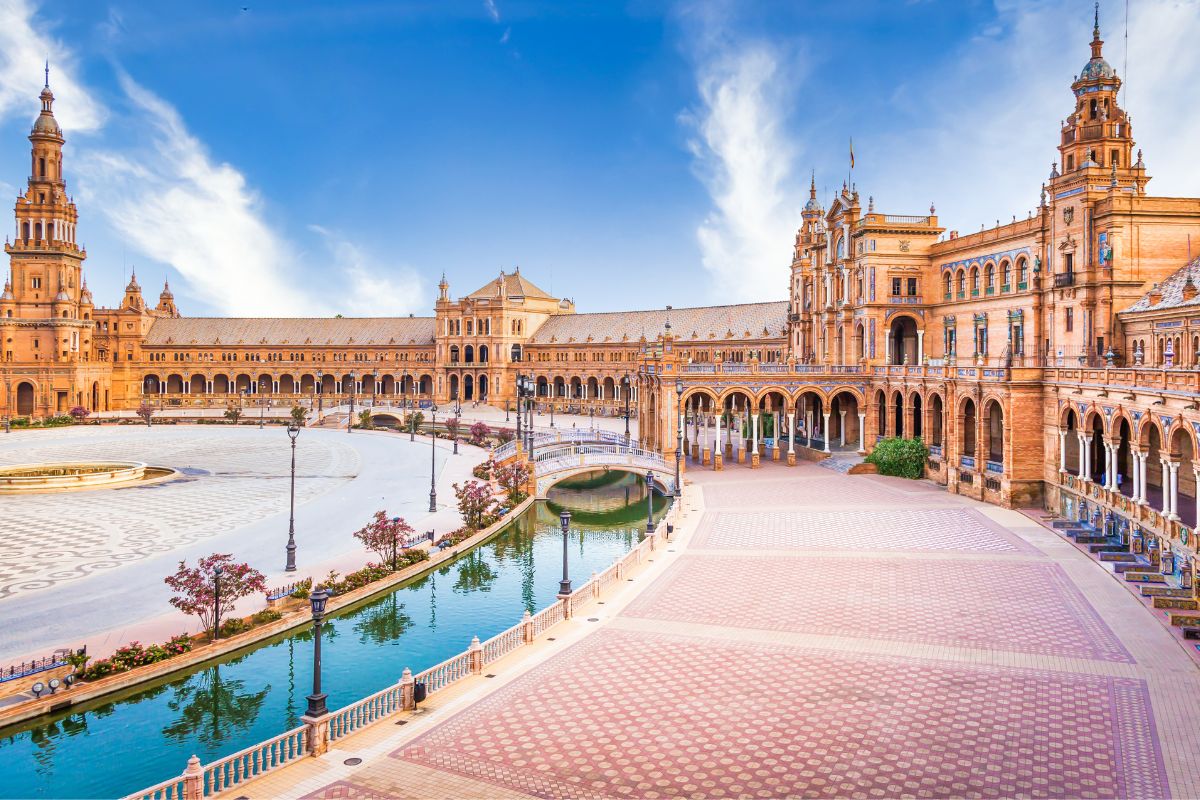
From San Sebastian’s world-famous food scene and the attractions of Barcelona, to the incredible museums of Madrid, history of Granada and beaches on the Costa del Sol, this Spain road trip has it all!
Road tripping past perfect beaches, huge mountains and ancient monuments sounds like a pretty perfect holiday doesn’t it? If you’ve dreamed of exploring Spain, this guide is guaranteed to help you plan your trip.
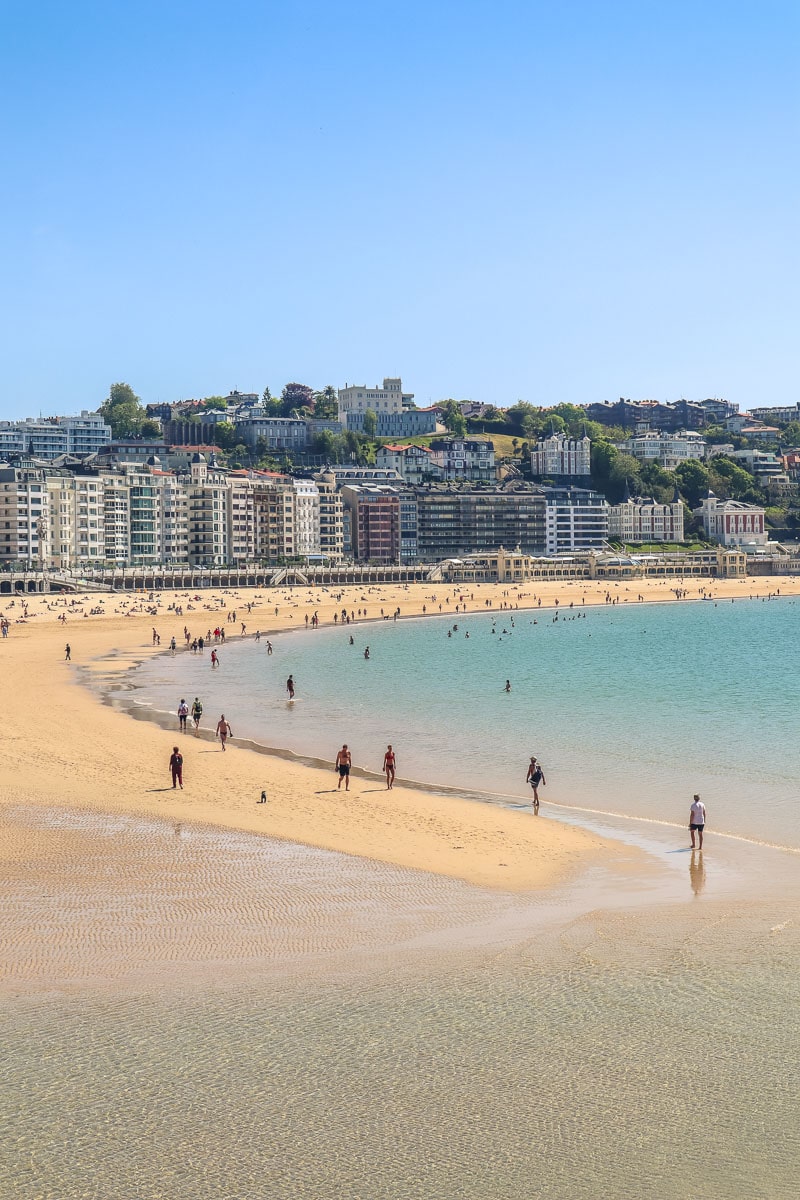
It’s the country I’ve visited the most in the world. Why does it keep me coming back for more? Because it’s so varied. I love the fact that you can spend mornings exploring pretty Medieval cities, lunchtimes feasting on plates of tapas, afternoons on the beach and evenings enjoying the nightlife.
In the south of Spain you can even ski in the morning in Sierra Nevada and then hit the beach on the Costa del Sol in the afternoon – how amazing is that?
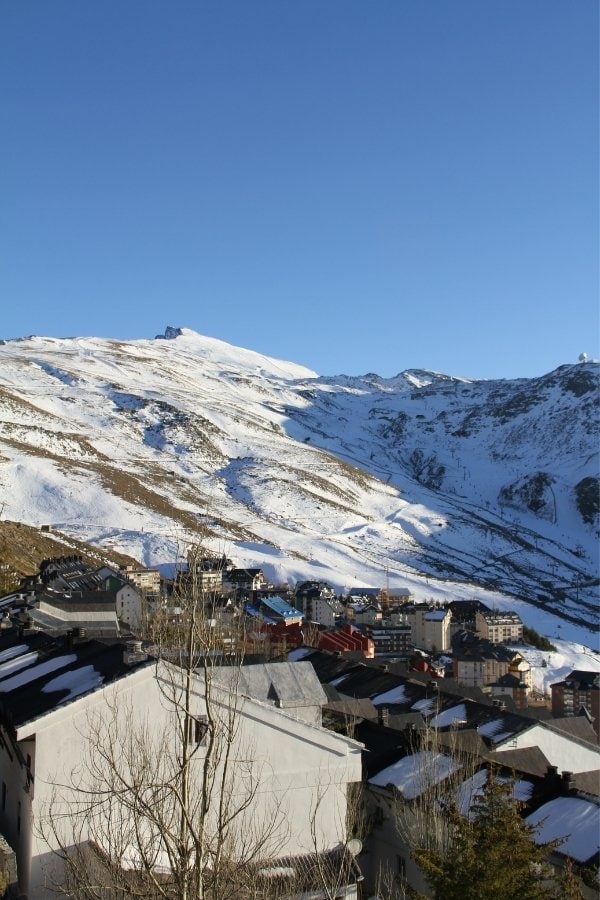
Whether you’re interested in art, architecture, history, food or fashion, a trip to Spain will no doubt appeal.
If you’re interested in art, you’ll enjoy visiting Barcelona’s Picasso and Miro Galleries, the architectural wonder that is Bilbao’s Guggenheim Museum, Madrid’s impressive art collection at the Prado Museum and the modern artworks in Malaga’s Pompidou Centre.
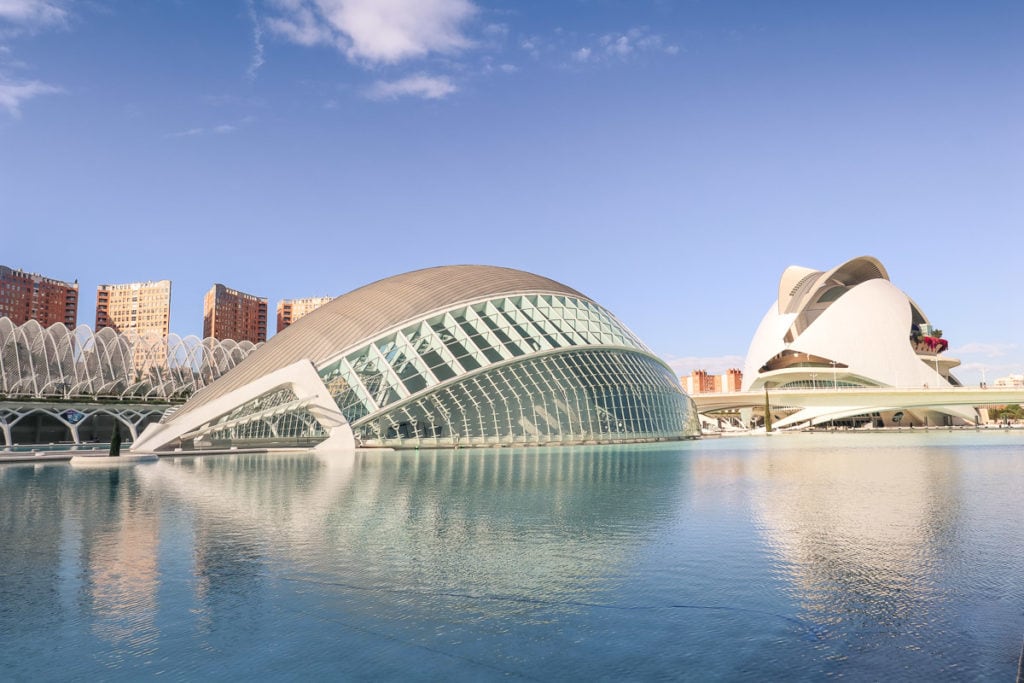
If you enjoy the great outdoors there are plenty of beautiful landscapes in Spain . You could hike in Ordesa y Monte Perdido National Park in the north, explore Valencia’s Turia Gardens, explore Murcia’s weird and wonderful sandstone wonders at Bolnuevo or even ski in Sierra Nevada.
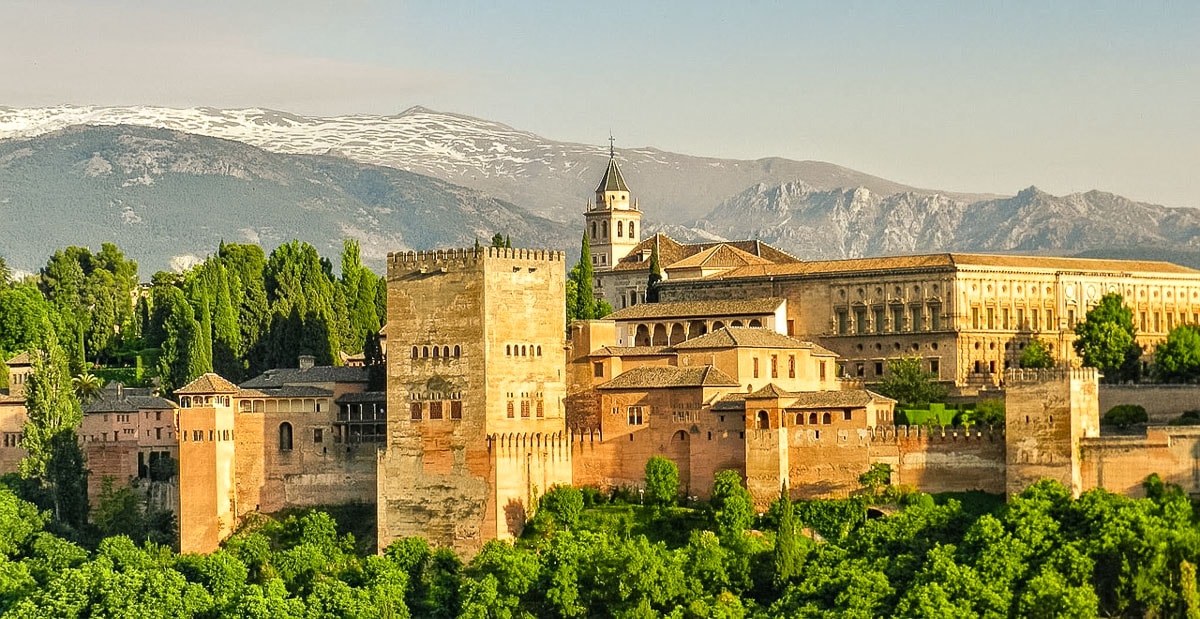
I’m a firm believer that the best way to get to know a country is through its cuisine, and in Spain, you’re in for a treat! San Sebastian in the Basque Country has the most Michelin-starred eateries per capita in Europe. There’s a great culture across this region for pintxos – small dishes often showcasing local ingredients.
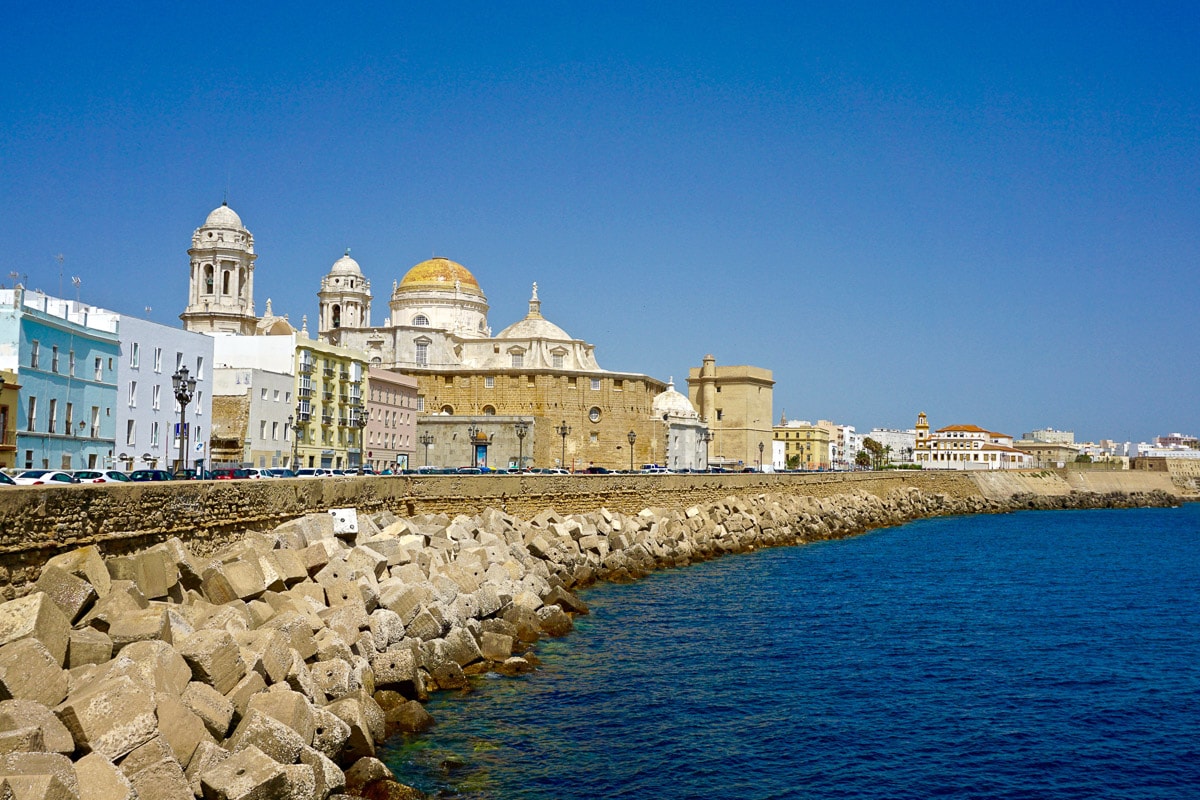
Head south and you’ll enjoy plates and plates of delicious tapas. From Spanish hams and cheeses, to griddled peppers, calamari and fresh fish, there’s so much to taste along the way,
And the best part about a Spain road trip? The freedom! You don’t have to stick to the obvious routes. I’d 100% encourage veering off course from time to time.
Often it’s when you decide to travel slowly and go off the beaten track, you start stumbling across hidden gems. You’ll take a wrong turning and end up in an authentic Spanish town that isn’t in any of the tourist guide books!
Spain is often associated with summer beach holidays, but it’s worth remembering that many of the interior parts of the country offer just as much natural beauty, with vineyards, mountains, canyons, olive groves and whitewashed towns.
So, rather than create one epic Spain road trip, I’m diving it in tow: a northern Spain road trip and a southern Spain road trip . That way you can just pick one and break the country up into manageable chunks. If you’ve got a while, then simply join the two up and continue on from Salamanca to Madrid.
Click through to take a look at each itinerary, and figure out which one is right for you…
The Ultimate Spain Road Trip Itinerary
From sampling some of the best Spanish food in the Basque Country and enjoying the vibrant colours of Barcelona, to visiting the Alhambra in Granada and relaxing on the beautiful beaches on the Costa del Sol, it's time to plan the ultimate Spain road trip!
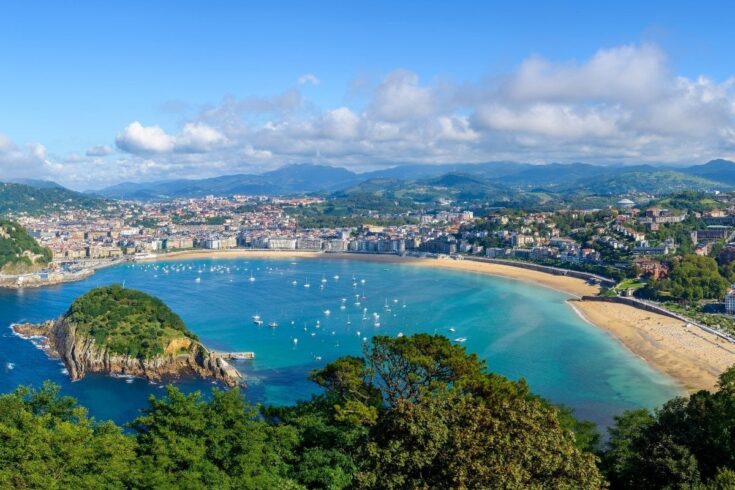
The Ultimate Northern Spain Road Trip: Routes, Sights, Guides, Maps And More
From Catalonia’s unspoilt coastline and Aragon’s scenic architecture to quaint cities in the Basque Country, this northern Spain road trip offers something for everyone.
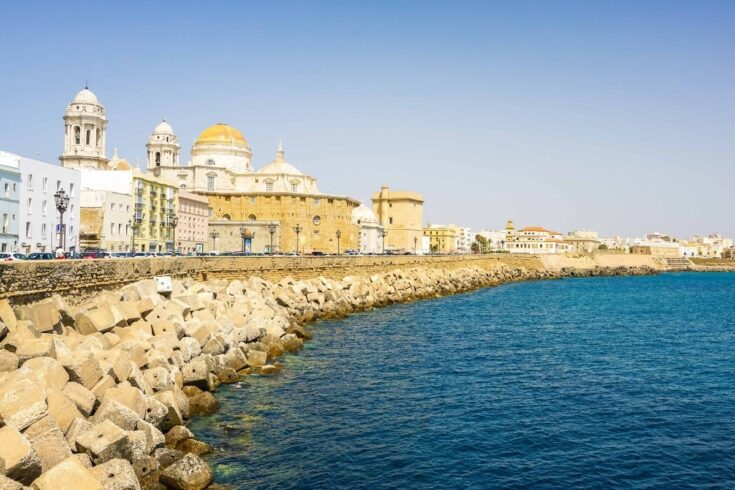
The Ultimate Southern Spain Road Trip: Routes, Sights, Guides, Maps And More
From the historic cities of Seville and Cordoba, to the natural beauty of Ronda and the spectacular beaches of Cadiz and Valencia, this southern Spain road trip offers something for everyone.
When Is The Best Time To Visit Spain?
You might think that Spain has a Mediterranean climate, but that’s only true for the southern parts of the country. Spain’s location and geography means that the north has a cooler climate and the east around Murcia has a more arid climate. Obviously the mountainous areas in the Pyrenees and Sierra Nevada are completely different too.
Temperatures vary greatly by region, but as a quick example, you can expect temperatures as low as -10 in around Sierra Nevada (in the mountains near Granada) in January, and as high as 40°C in July in cities such as Seville. Temperatures in the south remain mild in winter, making destinations along the Costa del Sol including Malaga and Marbella, great options for a winter holiday.
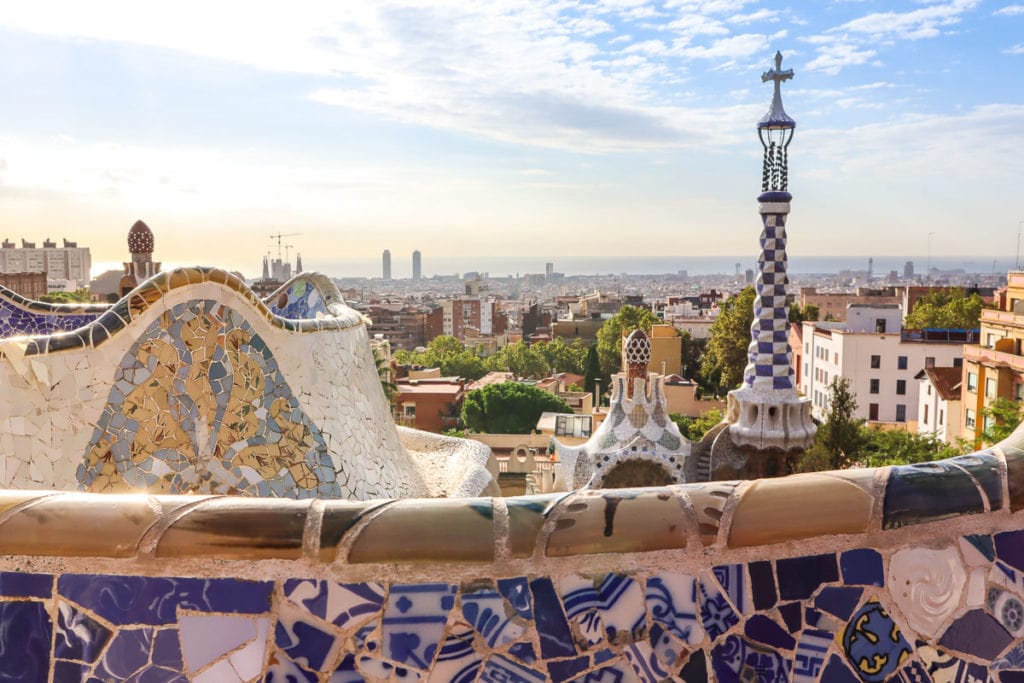
If you’re wondering when is the best time to visit Spain, I’d suggest planning a trip between April and June, or between September and October, just after the peak summer season.
The weather tends to be consistent in these months and you’ll skip the peak season so should benefit from lower prices and fewer people.
What to pack for your road trip
If you’re wondering what to pack for your trip, this guide to road trip essentials has you covered. From portable chargers to ways to stay entertained on long journeys, it’ll help you create your road trip packing list.
I hope you’ve enjoyed checking out my Spain road trip itineraries. Let me know where you decide to go and what your highlights are!
Chloe Gunning
With a passion for food, fun and adventure, Chloe is the content creator behind one of the UK's top travel blogs Wanderlust Chloe. From volcano boarding in Nicaragua, to sailing around Sicily and eating her way around Japan, her travels have taken her to some of the coolest spots on the planet. Named Travel Influencer of the Year in 2022, Chloe regularly works with a number of tourism boards, producing inspirational travel content across multiple platforms. Find out more about Chloe here.
Leave a comment Cancel reply

Spain Road Trip - The Ultimate 2 Week Itinerary
Start your road trip from barcelona.
With this road trip spanning the length of Spain, you can start at either end, but we often find ending in a hotter place more sun and sea works better.
The first few days you can take a bit more history and culture, visit sights and museums before heading for more relaxed scenery driving along the Costa del Sol towards the end of your trip.
Day 1: Barcelona - Fly in, sightseeing & seafood dinner
This epic Spanish road trip starts in the Catalan capital - Barcelona.
One of the best things about going on a road trip to Spain is the weather - check out the best time to visit Spain to pick your month of travel. Catalonia is beautiful and captivating all year round - so get ready for the adventure of a lifetime.
If you've arrived with your own car, our advice is to park it up for a few days at the nearest underground car park as you won't be needing it around town.
If you plan to hire a car, don't bother picking one up until day 3. While there is ample parking around the city, much like most of Spain, getting around on foot or using the relatively cheap metro system is a lot more convenient and relaxing.

Where to stay in Barcelona
There's a huge choice of hotels and villas to stay in when visiting Barcelona, some of them considerably more expensive than others.
A top tip is to stay somewhere within a short walk of the main sights such as La Rambla and La Plaza Real and near the old port - this is where you'll be spending a lot of your time and where the best restaurants in town are.
I would highly recommend the Onix Liceo - it's located in the Gothic Quarter, right near Las Ramblas, the city centre and the Old Port. It's really good value for money too - especially for somewhere so central. If you're looking for the perfect hotel to stay at in Barcelona, this is it.

The majority of car rentals are really close at the Placa dels Paisos Catalans so this is handy for getting your Spain road trip underway on day 3 as you can just walk across with your bags.
Having checked into your hotel and dropped your bags off, it's time to go see what this crazy (in a good way) city has to offer, so head on down towards the Plaça de Catalunya at the top end of Las Ramblas.
Walk along Las Ramblas and explore the Gothic Quarter
The two streets and the wide promenade in-between are the true heart of Barcelona. Street artists line the pavement, eager to do a caricature of you, while street dancers, human statues and various other forms of entertainment vie for tourists' attention.
The first day is always a great opportunity to relax before your Spanish road trip really gets underway so take your time as you stroll around.

Walk halfway down Las Ramblas until you get to the Liceu metro station and turn left into the Gothic Quarter, the ancient part of the city which forms the main part of the Old Town.
One of the first things you'll see is the Barcelona Cathedral. This majestic dark stone structure is a beautiful example of fine Gothic architecture and - miraculously - seems to be somewhat off the tourist radar, making the visit that much more peaceful.
As you wander around the twisting streets of the area, head towards the sea until you reach Port Vell. This marina used to be the busiest trade port of the region and today serves as a yacht harbour.
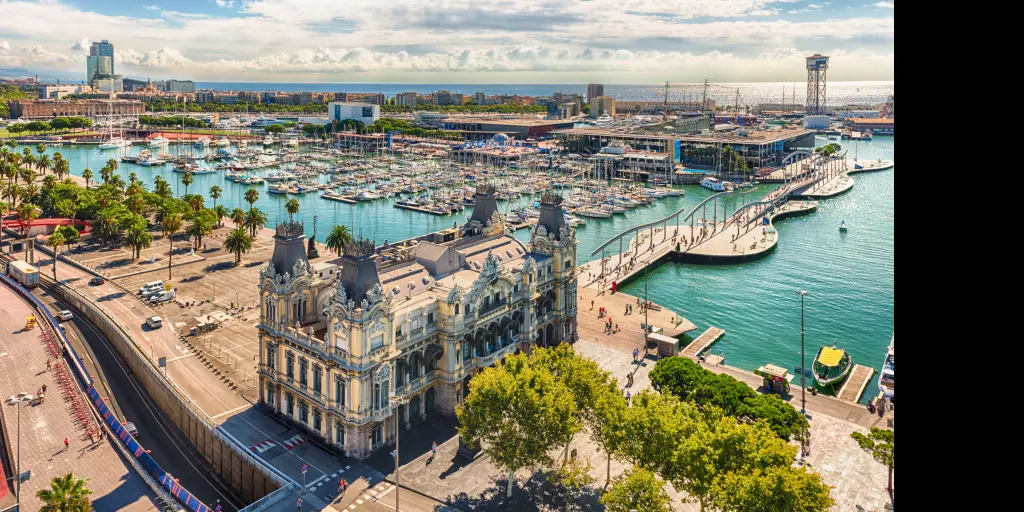
Here you'll see a large brick building which houses the Museu d'Història de Catalunya, which gives a somewhat unique perspective on the region's continuing fight for independence as well as the history of the Catalonia's relationship with other parts of Spain.
For a spot of late lunch just before you go into the museum, you can't do much better than walk into the small Barceloneta district right behind the building.
Here you'll find a large number of bars and restaurants with all manner of Catalan tapas on offer.
Grab dinner in Barcelona's Port Vell
Barcelona has a famously fabulous dining scene, and there's a multitude of outstanding restaurants dotted around the city to choose.
The majority of these are located within walking distance of Las Ramblas, with a few further afield.
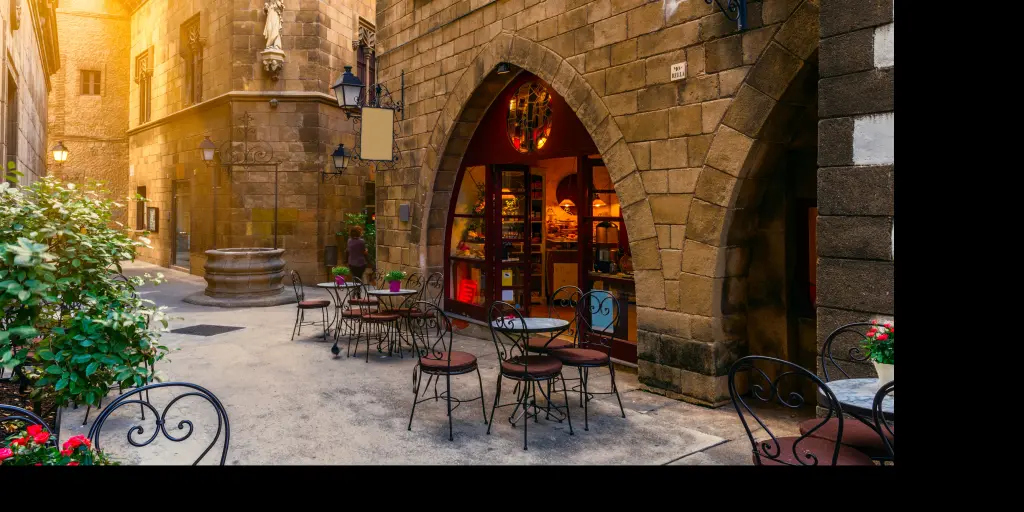
If you fancy some fish and a romantic table in the cool evening sea breeze then return to Port Vell and pick one of the dozen restaurants serving the freshest seafood in town.
Day 2: Barcelona - More sightseeing, tapas & hiking
Visit the gaudi's buildings and sights.
I know you're probably thinking that it's time to get going on your Spain road trip, but Barcelona is worth spending a full day after your arrival - you'll be very glad you did!
Your second day in Barcelona is perfect for a stroll around town taking in some of Gaudi's most famous sights. The key sights are relatively close to each other and all of them are not too far from your hotel, so it will be an easy walk!
Begin the morning in style and find a traditional café on your way to Passeig de Gràcia.
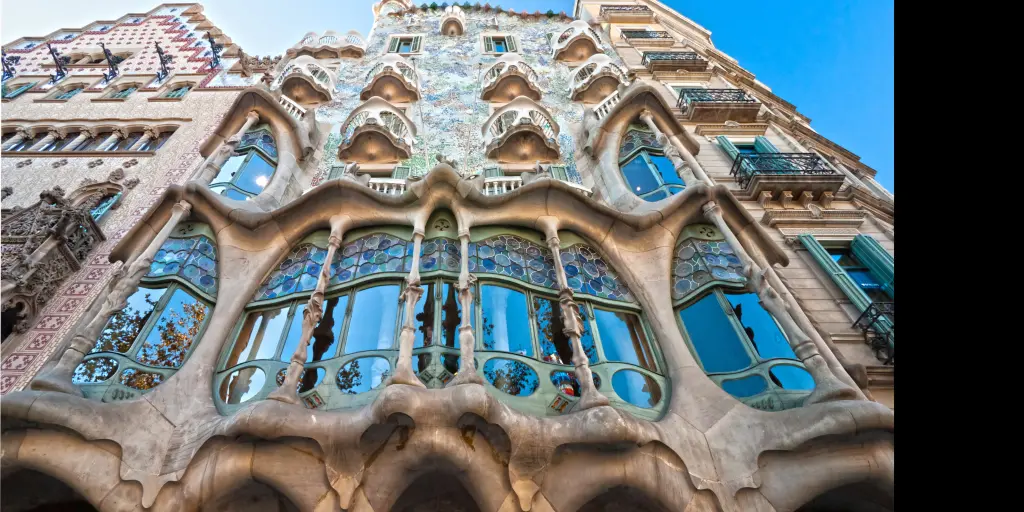
As you make your way through town, you will notice that most street crossings in Barcelona form octagonal squares and these are the best place to equip yourself with some bakery produce and fresh orange juice. If you're feeling peckish, you can indulge in one of the famous crêperies.
The first stop on your route will be the Casa Milà on Passeig de Gràcia. This famous apartment building was designed and built by Gaudi.
Just as impressive on the inside as the outside, it's worth going in to see the layout of the skeleton-like structure and get a good view of Barcelona from the wavy rooftop.

Once you're back outside, head north east on Carrer de Provença. Keep going in a straight line over the Avinguda Diagonal and you will very soon see the Sagrada Familia.
This truly unique Gothic Cathedral is still under construction, with decades of work yet to be completed; nevertheless, it's one of the most unique and jaw-dropping cathedrals in the world.
The amount of detail on the facades is astonishing, and everything from the interior decoration to the columns, towers and the naves is unlike any other in the world. You won't see another cathedral like it on your road trip through Spain... or anywhere in the world.

It's worth sitting down in one of the nearby coffee shops for a moment or two to take in the magnificent sight and do a spot of people watching before carrying on with your Barcelona tour.
Your next stop is the famous Park Güell, which is just a short walk up the Carrer de Sardenya. It's free to enter, so be prepared for crowds if you plan to visit over the weekend.
Once you're inside, have a wander and explore all the bizarre ins and outs of the park. Everything from the asymmetrical houses by the main entrance through to a large pagoda inside was born in the mysterious depths of Gaudi's brain.
Indeed, he used to live in one of the houses on the Park's grounds and frequently relaxed here himself. Be sure to walk to the highest point for fabulous views over the city.
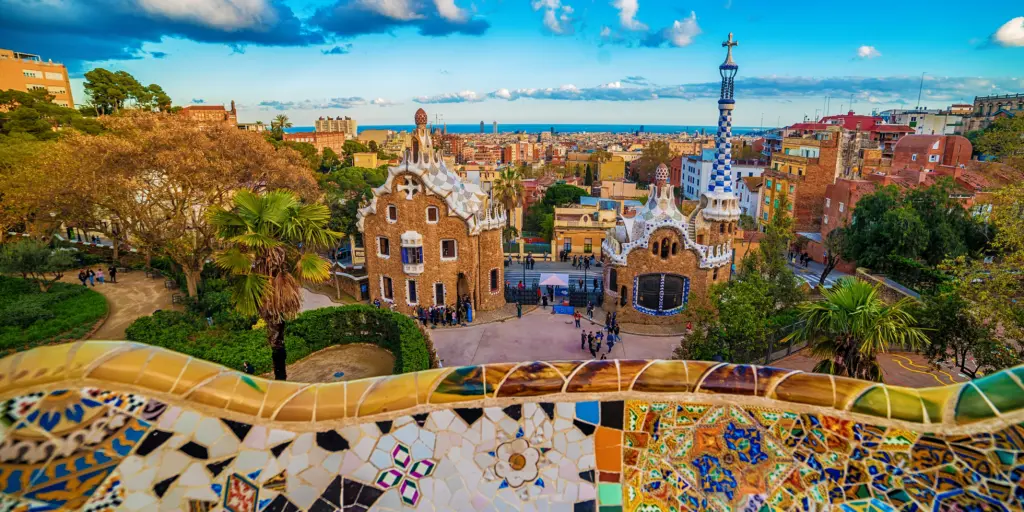
Lunch in Barcelona the Spanish way
You could spend hours discovering new bizarre things in Park Guell, but at some point your appetite is sure to kick in.
Lunch options are fairly broad around the area, with a number of great restaurants located nearby the park.
Alternatively, you can learn from the locals and stock up on some local Iberico ham, bread, olives and cheese and have a picnic in the warm sunshine somewhere within the park. Remember that Day 3 is when the Spain road trip properly starts and if you are going to stop for a picnic on the way to Valencia, plan ahead to not eat the same packed lunch two days running!

Walk up Mount Montjuïc
As the afternoon passes by and dusk approaches, it's time to head over to the last sight of the day - Mount Montjuïc, right across the other side of town.
The walk will take about an hour and a half, although the metro option is fairly straight-forward with a direct line from the Lesseps stop nearby to Poble-sec at the foot of the Montjuïc Park.
Take your time to climb to the top of the hill, where a number of monuments built for the Olympics are dotted around the green park.
The views over the city of Barcelona are spectacular from here, so spend a few minutes figuring out where you've walked and finding your hotel roof. If you walk on a little further, you can see past the Barcelona bowl and map out the route for your Spain road trip first leg towards the mountains in the distance.
On your way down, make sure you pass the Montjuïc Fountain to watch the water and light display that takes place every half hour starting from 7pm - it's worth it. Note that the shows don't happen Monday to Wednesday, so plan your route accordingly.
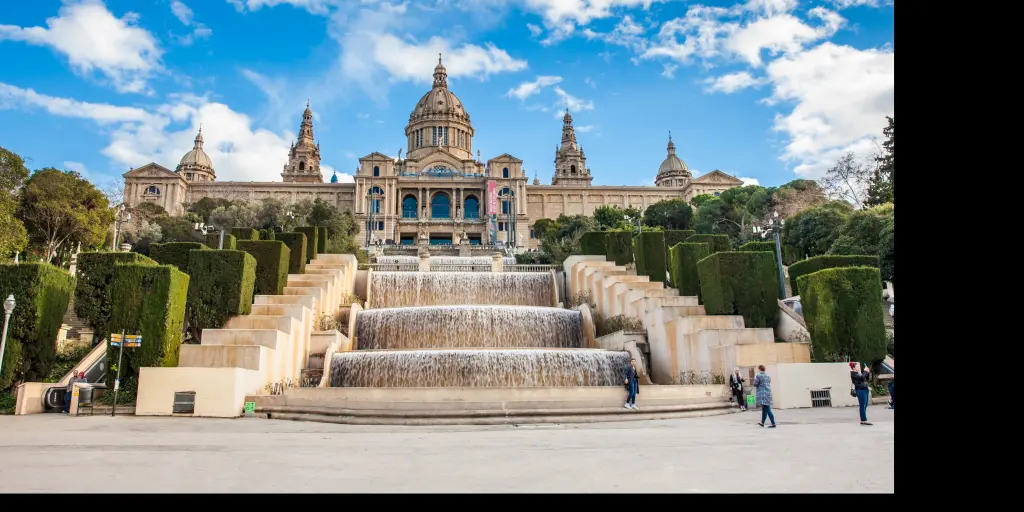
By the end of the display you will be ready for a hard-earned spot of relaxation before freshening up and heading out to town for food. Perhaps a hearty steak dinner?
Drive from Barcelona to Valencia
First stop on the way is Valencia - a historic trade city on the Costa Blanca.
Day 3: Drive from Barcelona to Montserrat to Valencia
Distance: 265 miles
Visit Montserrat Monastery to kick-start your Spain road trip
Wake up, have some breakfast and check out of your hotel. This is a road trip after all, and it's time to hit the road!
Once you've loaded your luggage and set up the GPS, drive inland. The first stop on your Spain road trip itinerary is the majestic Montserrat Monastery.
This unbelievably beautiful secluded establishment - home to Benedictine Monks - is perched atop a picturesque mountain in-between two peaks.
Here, you will see stunning interior decorations and a number of highly prized religious relics.
Driving-wise, you have a choice of going up the mountain and parking close to the Monastery, or parking at the bottom and taking the train.
The train provides great views down the mountain and of the Monastery itself, so that's our preferred option.
Beware that if you choose to park at the top, you will still have to walk a fair bit uphill to get to the monastery.

The drive from Barcelona to Valencia along the coast
The drive to Valencia along a toll road will get you there in around 3 and a half hours and is a perfect way to kick off the driving on your Spain road trip. If you want to stop for lunch along the way, your best bet is to stop in Tarragona soon after you get to the coast on your way south.
The majority of other towns along the route are fairly uninteresting, with a score of high-rise hotels lining the shore and a distinct lack of restaurants and views.
Tarragona, however, is an ancient city rich in history and culture. A decent range of restaurants in the town centre will offer plenty of choice before you jump back on the AP-7 on your way to Valencia.
If you have time for a detour, hop off the motorway (remember - you'll have to pay the toll!) and check out the Pont del Diable - the Les Ferreres Aqueduct is right by the Tarragona junction. If you head into the city, there is a large amphitheatre and ruins of a Roman Forum to see.
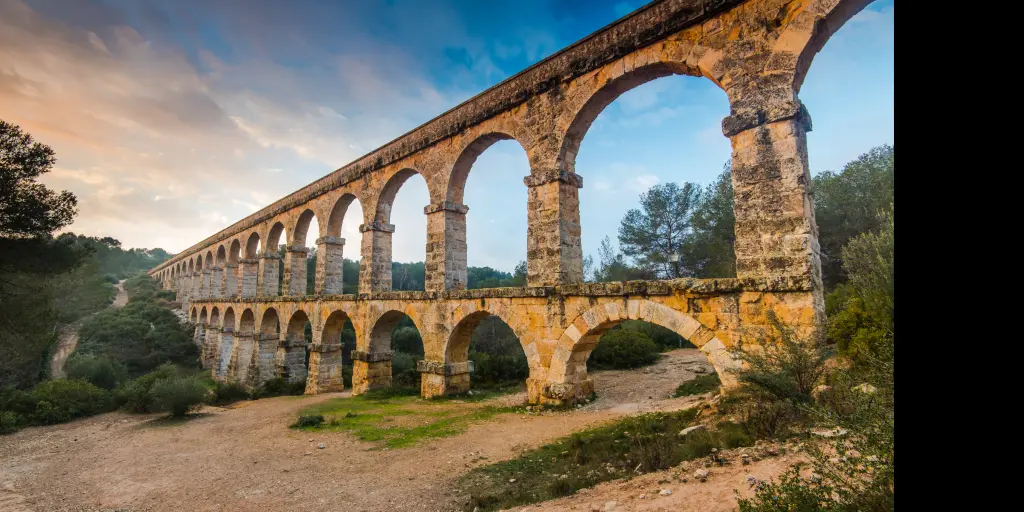
As you arrive in Valencia, you will notice that the city's Old Town is strikingly different to the rest of the city. The city centre is confined by a river to the west and a long green park that also used to be a riverbed before the river was diverted in the fifties.
As with most Spanish cities, vast numbers of affordable underground car parks are provided, so find one near your hotel and dump the car for two days as you won't be needing it to get around.
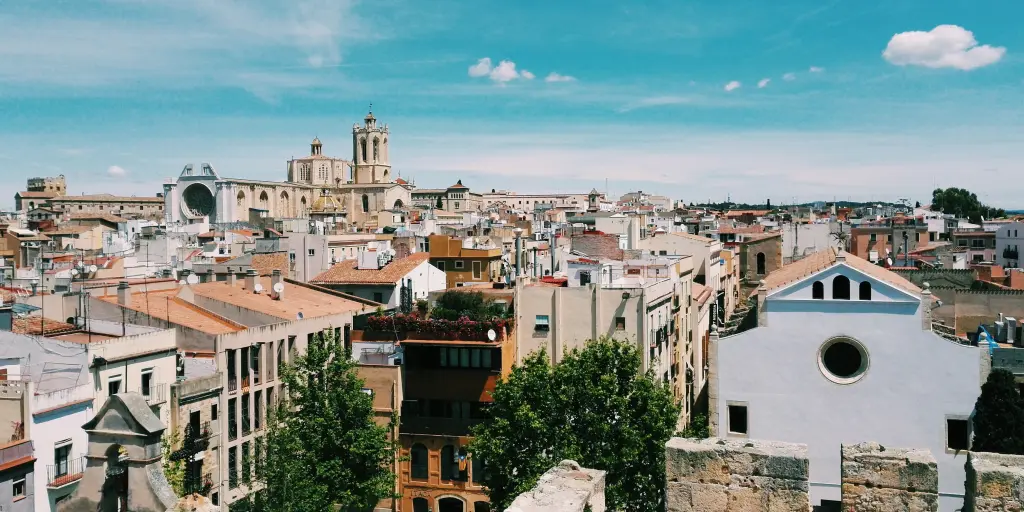
Where to stay in Valencia
Now that you're travelling by car, you'll want to pick a hotel with parking or somewhere nearby a car park.
Silken Puerta Valencia is a sleek and modern hotel with super comfortable rooms and the perfect location on the east side of Jardin del Turia. It is easy to drive to from the V-21 and it has FREE on-site parking, which is ideal for road trippers.
The rooms are super reasonably priced (especially compared to other hotels nearby) and the breakfast is truly outstanding.
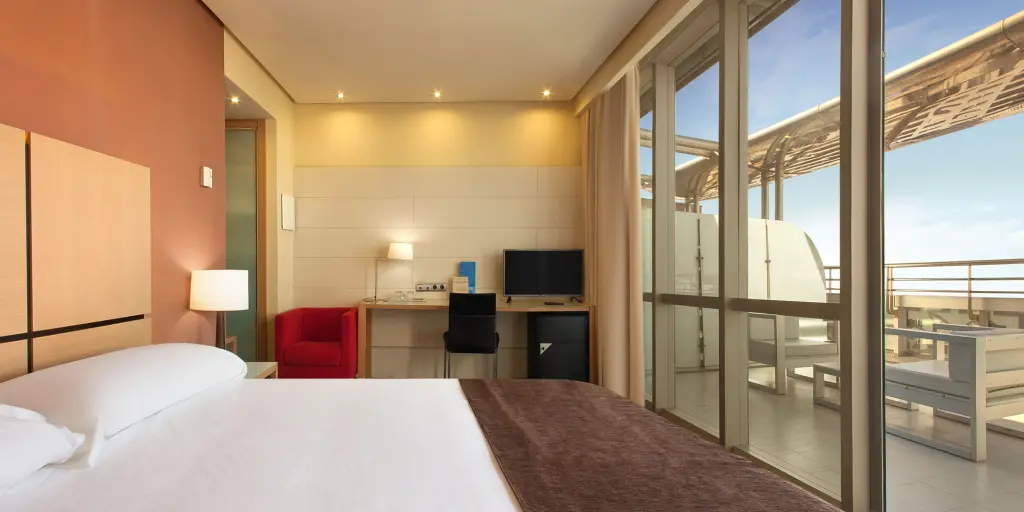
Day 4: Valencia - Market, Old Town and aquarium visit
Explore valencia old town and visit the market.
With only one full day to be spent in Valencia, you really ought to get yourself out of bed at a reasonable hour and head into town for some traditional Valencian breakfast.
Make your way towards the Mercado Central in the heart of the city (it's a 30 minute walk or a 25-minute bus ride) and stop in a cafe along the way for a couple of churros (traditional doughnut-like treats) and a coffee or a large glass of blood orange juice.

The town of Valencia is miraculously unpopular with tourists - which makes it a very appealing Spanish road trip destination!
Compared to most other Spanish cities, you will rarely see a tour guide leading a stampede of visitors here.
The only ones who make it this far away from Granada and Barcelona can typically be found in a queue outside the Oceanogràfic first thing in the morning, which is exactly why the best time to go is later on in the day.
Despite its somewhat under-the-radar status, Valencia is one of the most beautiful Spanish cities. Its Old Town is full of narrow streets criss-crossing through a mix of architecture from across the centuries.
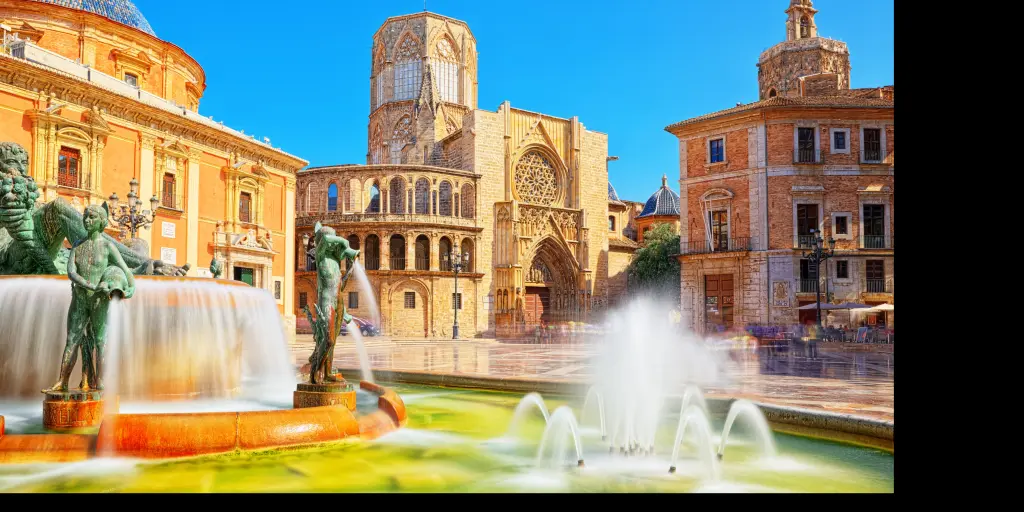
The market, one of the oldest in the country, sells a wide range of fresh produce and local delicacies. Our top tip is to try the dozens of varieties of ham and stock up on your favourite snacks for a picnic later on in the day.
Once you've purchased everything you want and are ready to move on, exit onto the Plaça del Merkat and pay a visit to the UNESCO-listed Lonja de la Seda across the street, which is free to enter.
This grand Gothic building once functioned as a Silk Exchange. Inside you'll see beautifully decorated walls, floors, ceilings and carved columns indicating the power and wealth of Valencia in the 15th and 16th centuries.
It's fascinating to see the sheer difference between the two historic trading hubs only yards away from each other.

To round off the morning, walk the short distance towards the Valencia Cathedral. This beautiful and - to a degree - austere structure can be somewhat tricky to find, as it's closely surrounded by buildings on all sides.
The Cathedral is known for holding the most likely true Holy Grail - the cup from which Jesus drank at the Last Supper.
We'd highly recommend you pay the €2 to climb up the Cathedral's tower, as the views that open up over the city and the busy harbour are truly stunning. It's quite a walk to the top (205 steps), so make sure you've done your stretches before you make the attempt. You can even plan the next leg of your road trip through Spain as you look towards the hills in the distance!

Have a picnic in the Jardín del Turia
The Cathedral is only a stone's throw away from the Jardín del Turia. This vast green belt around Valencia's Old Town used to be a river until the source was diverted following a flood in 1957.
Today this park has everything from a roller skating park to football pitches and large chess sets. This is exactly why you bought the picnic ingredients at the market earlier on in the day.
Not every part of our Spain road trip has to involve driving, so a stroll is in order. The gentle walk down to the Ciutat de les Arts i les Ciències will take you around 45 minutes, so you'll be able to pick the best spot for lunch on your way.
The park's chilled out vibe, away from the humdrum of the city, combined with the smouldering Valencian sunshine will make for a great meal alfresco.
Mingle with sharks at the Oceanogràfic
The Oceanarium is located on a large and relatively new site called the City of Arts and Sciences. The entrance is easy to miss as it is relatively small, with almost the entire structure buried beneath the ground.
Tickets are expensive but well worth it, as this is one of the best and largest marine parks in the world.
A major highlight of the attraction is a long tunnel that takes you through a tank, with various species of shark swimming alongside swarms of multicoloured fish. Dolphin shows are held regularly, so check the schedule when purchasing your ticket.
Closing times vary, with doors shutting at 6pm during the winter and as late as midnight during the summer months.
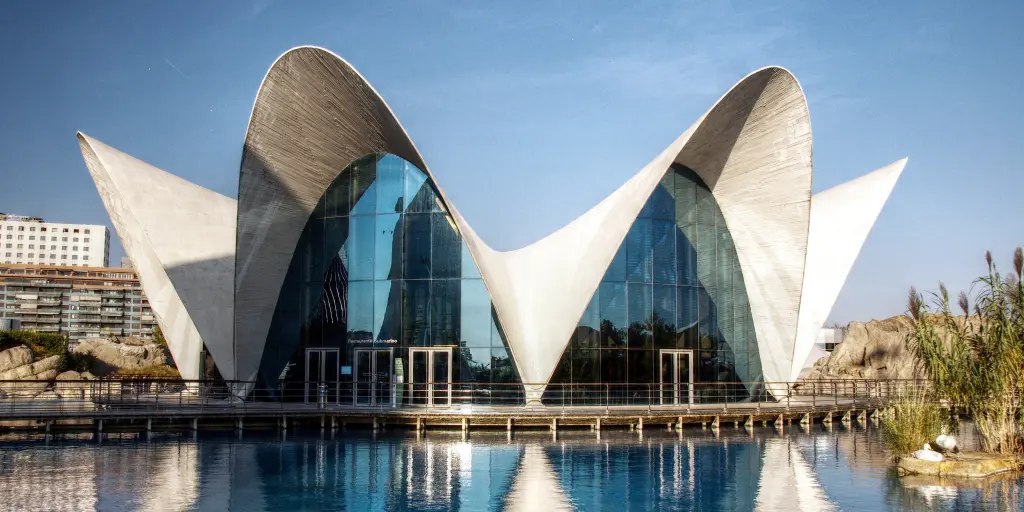
Where to go for dinner in Valencia
Once you've haddock a whale of a time, it's time to find a plaice for dinner (just couldn't resist the op-perch-tuna-ty for a fish pun!)
Your best bet is to head back into town and go towards the Plaza del Ayuntamiento. There is a very broad selection of restaurants in that part of the Old Town, with a large number of them specialising in the local specialty - fresh fish.
Of course there are other options around, but you would be doing yourself a real disservice if you do not try a good fish restaurant in Valencia.
Spain road trip arrives in Granada
Having seen the best of Valencia, it's time to scale some mountains and head towards the sunny province of Andalucia with its endless beaches and beautiful white villages.
First stop on the way is Granada - one of our favourite Spanish cities that just feels great on every single visit.
Day 5: Drive Valencia to Granada via the Sierra Nevada
The drive down from Valencia to Granada is almost a mini Spain road trip in itself. It involves following the coast south to Alicante, before heading west and going over the snowy peaks of Sierra Nevada to Granada on the other side. This may sound like an ominous route, but it's actually easy and relaxed.
Once you leave Benidorm in your rear view mirror (it's really not worth stopping for), and head past Murcia, you will suddenly notice an eerie silence.
Given that the next 70 odd miles are pretty much an empty desert on a mountain plateau, nobody other than you seems keen to drive along this route.
This complete absence of other people is perfect for a relaxing drive in some of Spain's most fantastic scenery. Contrary to any fears you may have had, the road is straight and great for driving. The snow-covered mountain peaks form a gorgeous backdrop, and you're likely to have the road almost to yourself all the way there.

Going on a Spain road trip and spectacular mountain views was maybe not the obvious association, but there are few things better for a relaxing drive.
Now we obviously do not condone speeding, but you're guaranteed to be pleasantly surprised by how quickly you get to Granada - just be careful to stay within the speed limit for the two speed cameras on the way. They're clearly marked by three separate signs, each indicating exactly how many metres separate you from a €400 speeding ticket.
We know that you might have already had more picnics on this trip than you did over the course of the last decade, but we promise that this is the last one.
Every now and then you'll come across a rest area by the side of the road which often coincides with a Mirador - a great view of some beautiful landscape.
Take your pick of the pit stops and park up to have your lunch at one of the wooden tables designed exactly for this purpose.
Where to stay in Granada
If you want to stay in central Granada, at the heart of the action, head to the boutique Hotel Palacio Santa Ines.
Tucked away in a narrow street in the historic centre, the Hotel Palacio de Santa Ines consists of two revamped 16th-century buildings designed in the traditional Mudejar style.
With its tranquil inner courtyards, lovely spacious rooms and super convenient proximity to the Alhambra fortress and the Granada Cathedral, it's the perfect place to rest for a few nights.
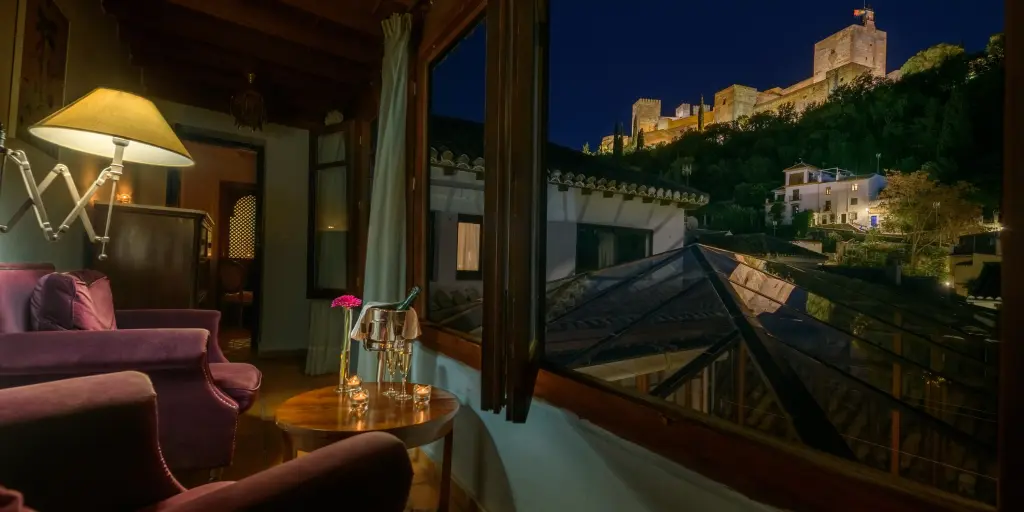
The only issue with staying in central Granada is parking.
Luckily, the hotel has thought about your Spanish road trip needs and has partnered up with two nearby public car parks, who offer a special rate just for their guests. Simply park your car and bring your parking ticket to the hotel (they'll even reimburse you for a cab ride if the car park is too far to walk).
The hotel will stamp your ticket with a lower daily rate (€19.50 for 24 hours). Simple as that!
Head out to enjoy a tapas dinner in Granada
After dropping off your bags, go out to enjoy the evening in this awe-inspiring city. We recommend a walk around the compact town centre, which is rife with cheap and cheerful tapas restaurants.
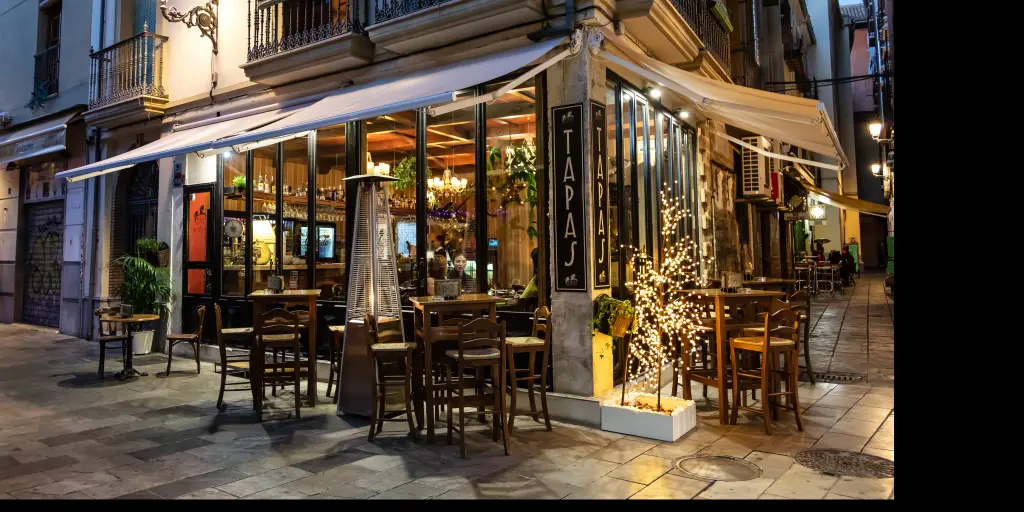
For a cosy, relaxed option, head towards Plaza de las Pasiegas. Here you will find a quaint and unassuming little restaurant called Rollo offering a number of quirky dishes.
Our tip? Try the crunchy pancakes made with tiny prawns... delicioso!
Day 6: Granada - Visit the Alhambra fortress
Spain has culture in abundance, so you simply can't ignore it! As one of the most famous and recognisable tourist attractions in Spain, the sprawling Alhambra palace is a symbolic icon of the country. It's positively enormous, so you'll need almost an entire day to see all the various sites around this old Moorish palace complex.
Spain road trip top tip : Be sure to book your tickets ahead of time (see the official Alhambra website for details) as during peak season the limited daily allowance can be sold out weeks in advance. You can't miss out on visiting the Alhambra.
There are buses that can take you to the Alhambra entrance, but the walk up the hill is not strenuous and will make for a pleasant 20-minute stroll.
Start at buy buying an ice cream on the corner of Plaza Santa Ana, where you'll find flavours ranging from marshmallow to kiwi fruit, and head up the Cuesta de Goméres through the park at the foot of the Alhambra walls.
Once you've made your way to the Alhambra's main entrance at the far side of the complex, head right past the queue of ticket hopefuls to one of the yellow machines, insert the card used in pre-booking, and walk straight in.
Pay attention to the time you selected for entering the Nasrid Palaces and be there around 25 minutes early to join the queue.
Other than that, take your time to explore the various sights and take pictures of the sprawl of Granada below you, with the majestic Sierra Nevada mountains in the background.
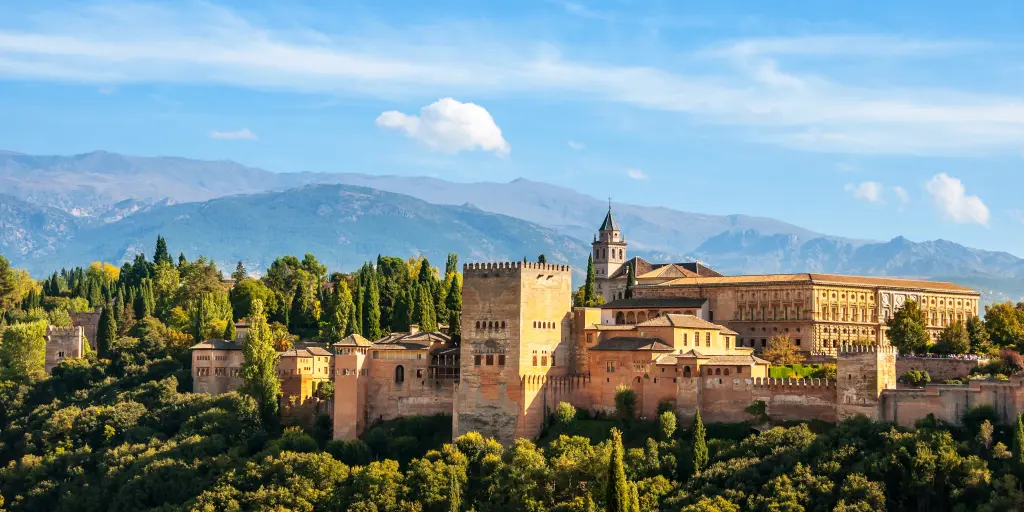
Enjoy (free) tapas for dinner
Spend your time relaxing in the evening. If you want a taste of typical local food, head for Calle Navas, right in the centre of the Old Town. This narrow street is home to dozens of small family-owned restaurants serving all manner of Andalucian and general Spanish cuisine. The tables in the street are great as the cool breeze and night sky will are a perfect compliment to your bottle of Rioja.
You will probably have tried a lot of tapas on this road trip through Spain, but Granada is known as the city of free tapas. This means you can eat very cheaply if you play your cards right. Most restaurants will give you a free tapa for each drink you order, with each tapa increasing in size as you go on.
To get the most bang for your buck, order a ca ñ a of beer (small glass) as opposed to a tubo (big glass). You'll finish the beer quicker, which means more tapas!
Day 7: Granada - Explore Old Town & Albayzin
Your second day in the city can be spent wandering around the medieval streets and seeing more of the 'real' Granada.
There are a number of distinct areas, with the west part predominantly devoted to typical high street shops. The area around the Cathedral has a large number of restaurants, so study the menus on your way around to pick out your evening meal.
Visit the Cathedral and Capilla Real
The north side of the Cathedral has a large spice stall offering every spice you've ever heard of and then some - this can be an attraction in its own right!
Once you're done smelling the various beans and roots, visit the Cathedral itself and the adjacent Capilla Real. These grand buildings are an archetypal example of southern Spanish church buildings - rich in history, with elements of the Moorish culture making their way into traditional European architecture.

Once you've done your sightseeing, head up the Calle Reyes Católicos towards Plaza Santa Ana - the town's main square, located directly beneath the Alhambra's walls.
Pay attention to one of the city's highlights: the green man traffic light at all pedestrian crossings. This green man is like no other, with a very unique moonwalk impression indicating when it's safe to cross the road.
Walk through the Albayzín neighbourhood
From Plaza Santa Ana, walk past the Church onto the Carrera del Darro. This street runs next to the river Darro, which is home to a large feline colony that spends its time roaming through the shrubs.
A little further along is a small square to your right lined with restaurants that offer a great opportunity for lunch. Take a break from tapas by ordering the fritto misto - a selection of various battered fish and seafood.
Next stop: the Albayzín, the quarter that runs uphill from this street on the opposite bank to the Alhambra.
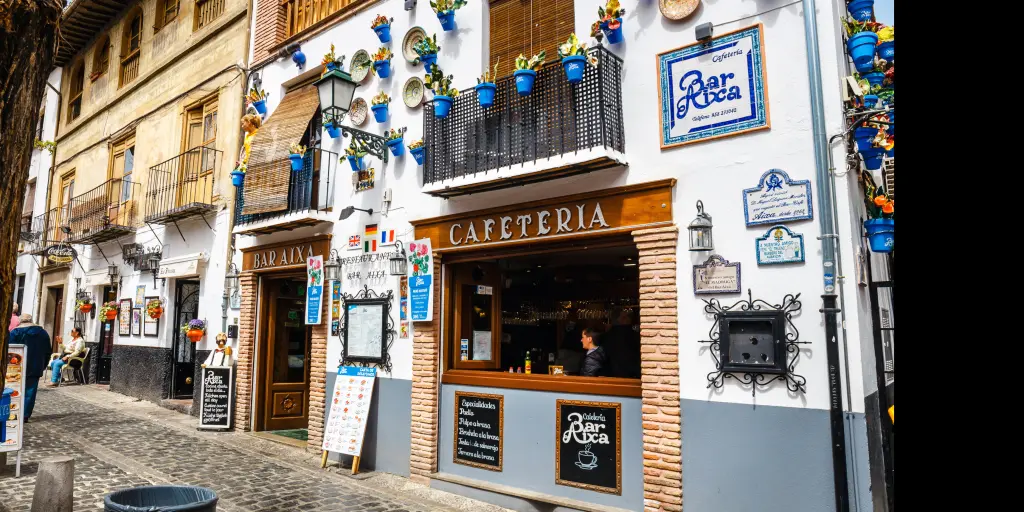
Take your time to wander through this ancient part of Granada, which is home to a vast number of small artisan shops selling everything from unusual metal work to traditional Moorish clothing.
If you head all the way to the top, the Mirador de San Nicholas is a great place to take in the views and snap some stunning shots of the Alhambra.
Day trips along the Costa del Sol
This might just be the best bit of the entire road trip through Spain. Yes - you'll be visiting some of the most amazing cathedrals and historic cities in the world, but there are few things that put as wide a smile on your face as cruising along the Costa del Sol.
The majority of the Costa has two roads running along - the free slower road along the shoreline and the fast toll road further inland.
Unless you're in a hurry or driving back to the airport, I'd stick with the coastal road for the views.
First stop is Benahavis via Malaga.
Day 8: Spain road trip continues from Granada to Benahavis
Once you have retrieved your car after breakfast, it is time to plough on with the Spanish road trip and make the short journey towards Malaga.
Once again, you will find mostly empty roads until you get close to the costas. You will know you're close to the city once the road suddenly dives down at a steep angle, and lush green vegetation appears in place of the arid rocky landscape.
As you descend towards the sea, you'll notice that the weather on the coast is mild in comparison to the hot inland Andalucia. If you don't notice this the first time round, you definitely will when you visit Cordoba.
Have a wander around Malaga
As you're passing right through Malaga, you might as well stop and have a wander.
The two forts overlooking the city are the best place for a quick break. The Alcazaba is the best preserved Moorish fort in all of Spain, and it sort of feels like the Alhambra's little cousin. The Castillo de Gibralfaro is set slightly higher and also offers brilliant views of the city and the Costa del Sol.
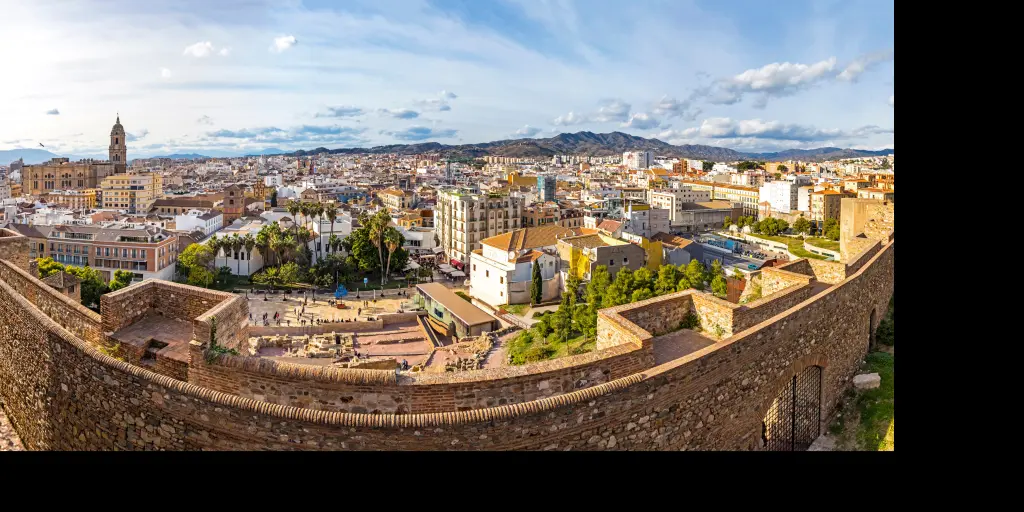
Spend a few hours in the city of Malaga itself. It may have a reputation as stag do-central, but this historic settlement is worth seeing in its own right.
The city centre is a tangle of cobbled streets, secret nooks and crannies and countless restaurants surrounding the Malaga Cathedral.
With tourists often passing Malaga by in favour of the Costa del Sol's many other attractions, take advantage of the atmosphere and treat yourself to lunch overlooking the marina, with the sun shining above you.
Spend the night in the white village of Benahavis
Getting to Benahavis is relatively straight-forward. You have a choice of the toll road AP-7 and the free A-7. The free road is more than good enough and takes a much more scenic route once the two split at Mijas. It also benefits from frequent exits, allowing you to stop along the way when you see a spot you like the look of.
The village of Benahavis is set in the Sierra de las Nieves mountains rising up from Marbella.
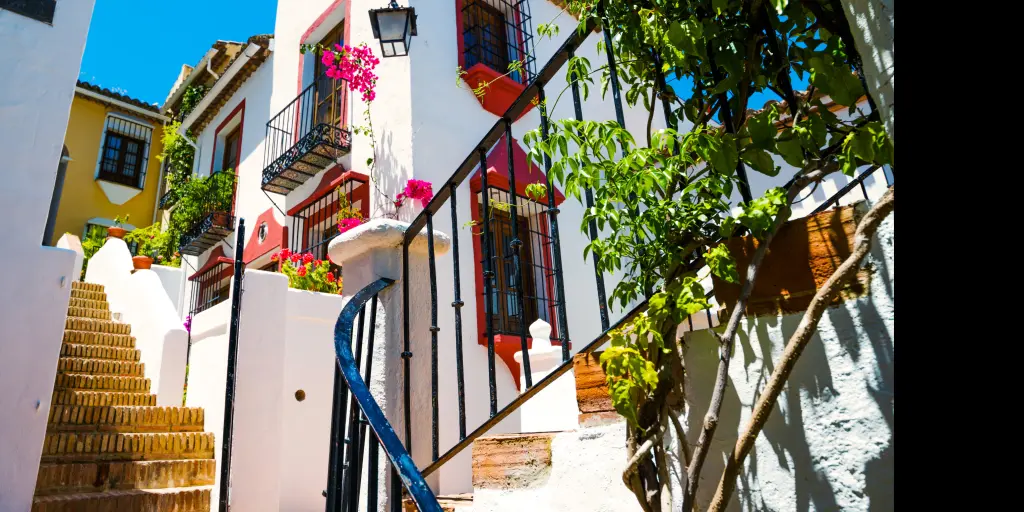
With only a 10-minute drive separating you from the beach, you benefit from staying in the culinary capital of the Costa del Sol, while also getting away from the huge package holiday hotels in the large resorts down below.
The peace and tranquillity will make for an enjoyable few evenings, and the choice of great food will make you want to come back time and again.
Where to stay in Benahavis
The best hotel to stay in the quirky Amanhavis right in the centre of Benahavis .
Set around a traditionally designed courtyard, each room has a unique theme around medieval Christian and Moorish influences. There are a lot of steps in-between the rooms and you can have dinner in the best restaurant in town in the court yard by the pool!
You can park your car for free along a couple of streets 50 yards down the hill from the hotel.
Day 9: Day trip from Benahavis - Visit Nerja and Marbella
Day 9 is perfect for seeing what the Costa del Sol is all about so this is the day your Spanish road trip takes you up and down the coast.
After a late lie-in, get in the car, put your windows down (and roof if you've got a convertible) and head down towards the sea.
Turn east along the coast and make your way past Malaga to the town of Nerja. This beautiful town takes a prime spot on the Andalucian coast and is steeped in history dating back to pre-Roman times.
Wander inside the ancient caves.
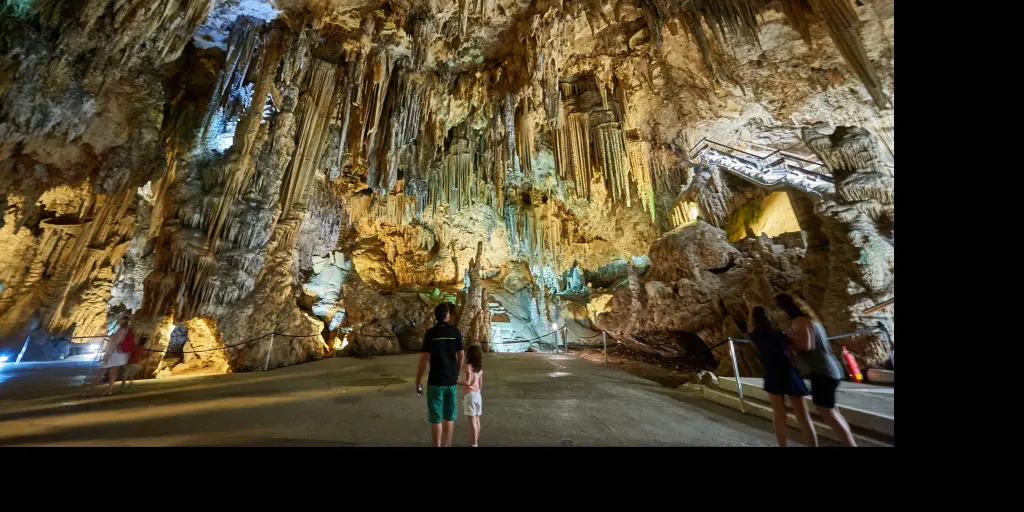
One of the main sights is a set of caves discovered in 1959.
The Nerja Caves were home to some early humans and neanderthals, with skeletal remains found throughout the linked caverns. Visitors can observe archaeological finds inside ranging from natural rock formations to prehistoric fossils and paintings.
The town of Nerja itself is a charming spot to get out and explore. Be sure to head to the elevated Balcon de Europa - a viewing platform built on top of the Nerja cliffs - for sensational views of the coast.
Two old cannons standing here remind you of the town's historical past, and the benches are a great place to enjoy an ice cream.

Drive to Marbella: the playground of the rich and famous
A late lunch is a good idea in Andalucia, as dinner is traditionally eaten later on in the evening.
Once you've seen enough of Nerja, hop back in the car and make the return trip down the coast to Marbella. No road trip in Spain is complete without driving up and down the Costa del Sol so head on right back along the beachfront.
Getting back to Marbella will take around an hour and a half. This famous resort is well-known for its beaches and countless hotels, but the Old Town is great for a midday stroll.
Park up underneath Paseo de la Alameda and cross the road to get into the historic part of town. There is a broad selection of restaurants with tables on every square, so take your pick and have some lunch here. Some of the restaurants do amazing sizzling prawns if you fancy a bit of seafood.
A number of shops sell everything from furs (no, really) to beach accessories.
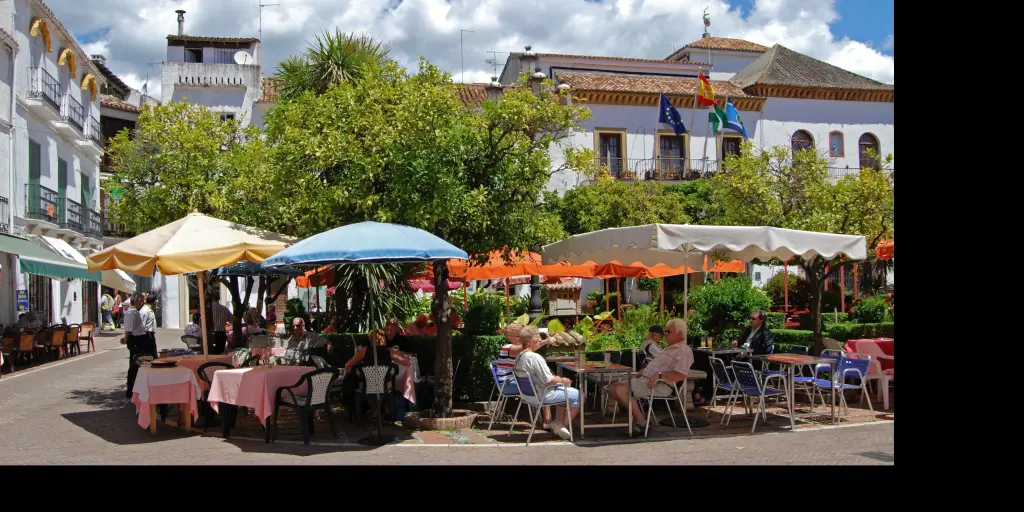
After having passed through Marbella, it's time to head to Puerto Banus only minutes away up the coast.
This is Costa del Sol's playground of the rich, with ridiculously expensive yachts in the harbour and an equally elaborate display of supercars parked next to them.
Top tip: Restaurants and shops here will sting your wallet, and the parking charges are insane. If you do want to grab some lunch, head to the west end of the marina (the one with the biggest boats) - there are a couple of spots that are less busy with reasonably priced menus.

Here's another insider tip for your road trip in Spain - park up for free at La Playa Fantastica - the closest beach to Puerto Banus.
Come back out of Puerto Banus and turn right onto the A-7 motorway towards Malaga. Stay right and take the right turn onto the N-340 towards Marbella.
As you come off onto the N-340, take the first turning right onto a narrow lane running towards the sea, then take the second street on the right and follow it down to the beach. You can park your car here for free for as long as you like and have access to one of the best beaches in the area with a great beach bar.
Puerto Banus is a mere 200 metres away, so you can stroll along at your leisure to have a closer look at how the other half live and inspect the exotic automobiles.
Spend the afternoon and early evening relaxing on the beach with the odd cocktail thrown in before making the 10-minute trip back up into the seclusion of Benahavis.
Enjoy dinner back in Benahavis
Freshen up in your hotel room before making your way through the narrow streets to select your restaurant for dinner.
Note that with many visitors coming from resorts up and down the coast, going out a little later can mean a less busy and more relaxed atmosphere.
Day 10: Road trip along the Costa del Sol to Casares and Ronda
Drive to casares - one of the most beautiful 'pueblos blancos' in spain.
Today shall be the day of the Mirador . This Spanish word encompasses everything we like about driving up into the Andalucian mountains, as there are frequent labelled roadside stops allowing you to take in the magical views.
You could break tradition and set off on this leg of your Spain road trip before having breakfast to get down to Estepona.

This relatively quiet resort town has a number of cafés and bars on the seafront where you can pause and indulge in a couple of waffles covered in chocolate sauce.
Be sure to fill up the car before heading off the main road and up towards Casares, as petrol stations off the coast are few and far between.
Casares is pretty much postcard-perfect, with neat white houses built into the mountains.
With a population of just a few thousand people, the town is definitely small, but it has a surprising number of nice restaurants and hotels to choose from.
When you arrive in Casares, park your car and head towards Plaza de España, which is the focal point of this small community.
To get some great views, make your way up the narrow street next to the Virgin del Rosario Chapel and keep heading uphill until you reach an old fort at the top.
If you walk a bit further along, you will come to a viewing platform set above a sheer cliff face. From here you'll likely see a number of falcons and kestrels up close and personal - and the views of the town below are simply spectacular.

Head to Ronda and walk along the bridge
Once you've got your snaps and feel that you've seen all there is to see in Casares, it's time to hop back in the car and make your way further inland to the majestic town of Ronda.
This unique Andalucian town is placed on top of two plateaus with sheer rock cliffs down to a river valley below. The scenery is incredible from every angle and the town itself is a real marvel too.
Parking can be troublesome, so grab any spot you see once you get near the centre. Large underground car parks are available further out, but are a fair walk from the centre - we like the Parking Martinez Astein - it's about 10 minutes' walk down the main shopping street, but easy to get in and out of.
The main attraction of the city is the Puente Nuevo - the newest and most striking of the town's three bridges across the Guadalevín gorge.
This unbelievably beautiful structure took 42 years to complete and is one of Spain's most famous sights. The view that opens up from the top of the bridge is impossible to describe and pictures do not do it justice - it's just one of those places that you have to see for yourself. If there's one place that makes your Spain road trip worth it, this is it.

Once you've gotten over the quiet gurgle of the river below and the amazing views, it's time to pay attention to the rest of the historic town and there's definitely a lot to see.
The ancient cobbled streets are home to a number of museums and a bullfighting ring which you can visit. There are also plenty restaurants that are perfect for a late lunch.
A few restaurants on the south side have rooftop or terrace seats with views over the gorge and the bridge, which can make your meal a lot more romantic.
Once you feel the need to get back and relax by the pool through the late afternoon, it's a comfortable drive along a stunning road through the mountains, which comes out almost directly at Benahavis.
Your last night on the Costa del Sol ought to be celebrated with a couple of cocktails and a fabulous dinner in the calming sea breeze.
Spanish road trip ends with Cadiz, Seville and Cordoba
The last stint of this journey will take you inland as you drive up to Seville and Cordoba via Cadiz.
Don't be fooled by driving north - this is going to be the hottest part of the drive so get some water in the car. Seville and Cordoba are only an hour apart but could not be more different. You'll see how Seville's grand wide avenues with a distinctly European feel compare to Cordoba's narrow winding streets and a Moorish style.
Day 11: Drive from Benahavis to Gibraltar, Cadiz and Seville
First on the menu is a spectacular drive along the coast, a quick detour into Gibraltar and a day full of amazing views.
Driving from Benahavis to Gibraltar is fairly straight-forward until you get to the narrow streets of La Linea de la Conceptión on the Spanish side of the border. Here, you will undoubtedly join a huge queue waiting to enter.
Many people choose to park up and walk in, but with the main part of town fairly far down, we'd recommend waiting in the queue which moves along swiftly enough and driving through.
Make sure that your passports allow you visa-free entry to Gibraltar as it is outside the Schengen zone.
Climb up the famous Gibraltar Rock
There are two distinct parts to Gibraltar and you can choose how to split up your morning.
The main town is a throwback to England of a few decades ago, which is a very unique cultural experience. You will notice a lot of expensive cars and shops selling watches and jewellery for the wealthy beneficiaries of Gibraltar's favourable tax system.
The town itself, however, is more shabby chic than flamboyant, complete with iconic British red phone boxes dotted around.
For the more adventurous types, the Gibraltar Rock is a popular destination, with a cable car taking you to the top.
At the highest point you'll find the remains of an ancient Moorish castle, with a series of linked tunnels below called the Galleries. Look out for the enterprising monkeys that populate the area and are particularly keen on anything shiny they can get their hands on.

Visit the ancient city of Cadiz
On your way up to Seville, you absolutely must stop off at Cadiz.
This radiant city is the oldest in modern Europe, with history going far back into pre-Roman times. The main part of the city is located on a thin strip of land stretching out to sea, with a stunning yellow stone Old Town centred around a Cathedral.
Oddly enough, Cadiz attracts virtually no tourists whatsoever, so you are free to roam at your own leisure and visit some genuine Andalucian shops and cafés without having to distinguish them from tourist traps.
Enjoy the views from the top of Cadiz Cathedral
We highly recommend visiting the Cathedral and climbing up the tower to get a great view over the town and surrounding water. Spanish road trips tend to involve climbing huge cathedral towers in every city you visit, but it's really worth it!
The Panorama from the top of the Poniente will leave you breathless and also give you the opportunity to plan your route towards the Santa Catalina castle.
The walk there is along a narrow route that comes off the beach and heads several hundred metres into the sea, towards the fort built to protect the city from English attacks.
While you can't enter the venue, which is used exclusively for social events and concerts, the walk itself is a great way to chill out in the cool of the Atlantic waves, get a great view of the city, and have a swim in the locals' favourite relaxation spot.
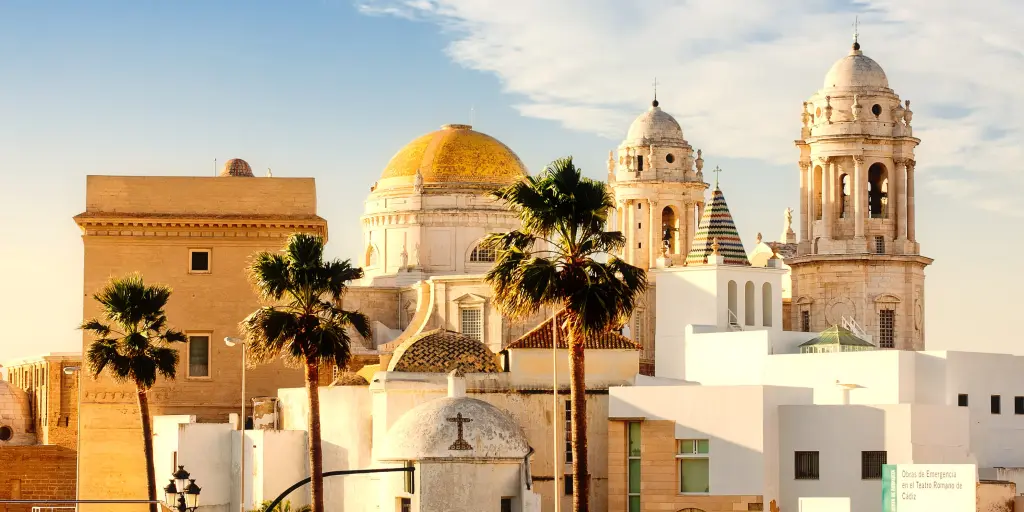
Drive to Seville in time for dinner
The final stint of day 11 of your Spain road trip is getting to Seville. This will take you just over an hour and you should comfortably arrive in time to unpack, find a place to park your car and scour the surroundings for a great restaurant.
We would highly recommend finding Calle Mesón del Moro for some of the best restaurants in town, although beware that some of these may be fully booked on Friday and Saturday nights.
Where to stay in Seville
Our pick for the very best place to stay in Seville is Posada del Lucero - an elegant 16th-century inn that's been refurbished with all the modern amenities you could possibly want.
This hotel is situated near all the best shopping streets, just north of the historic sights and right next door to Metropol Parasol - the iconic massive wooden structure that locals have nicknamed "the Mushrooms".
The stylish minimal exterior of the hotel contrasts with what you'll find inside: two beautiful courtyards flanked by marble columns and sleek arched doorways.
There's also an amazing roof terrace with a plunge pool and a bar where you can enjoy drinks with a view.
Navigating the streets of central Seville can be the toughest of this Spanish road trip The hotel doesn't have its own parking, but there is a decent public car park nearby just one block up the road so head there as you drive in.
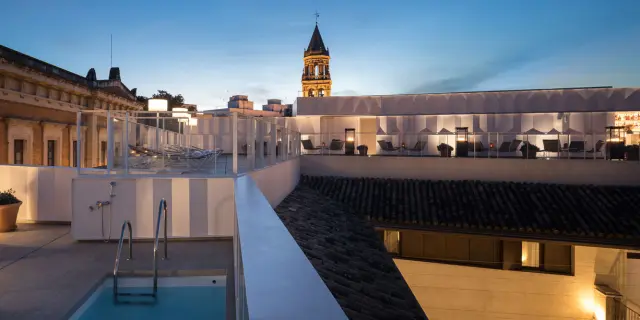
Day 12: Seville - Walking tour of all the best sights
First stop: plaza de españa.
The grand architecture and wide streets of Seville are more reminiscent of major European capitals than Andalucia, giving the city a distinct allure.
There is a lot to see around town, so get yourself out of bed at reasonable time and head down to Plaza de España. This vast open space was built in the 1920s in the middle of the Parque de María Luisa in time for the 1929 World Fair.
The large exposition building is now chiefly used for Governmental functions, but you can still go up the grand stairs for a better view.
The square itself is a semi-circle with fountains in the centre of a large paved area. Be sure to check out the perimeter of the Renaissance-style square, which is lined with Province Alcoves named after each of Spain's regions, complete with a mosaic depiction of each province.
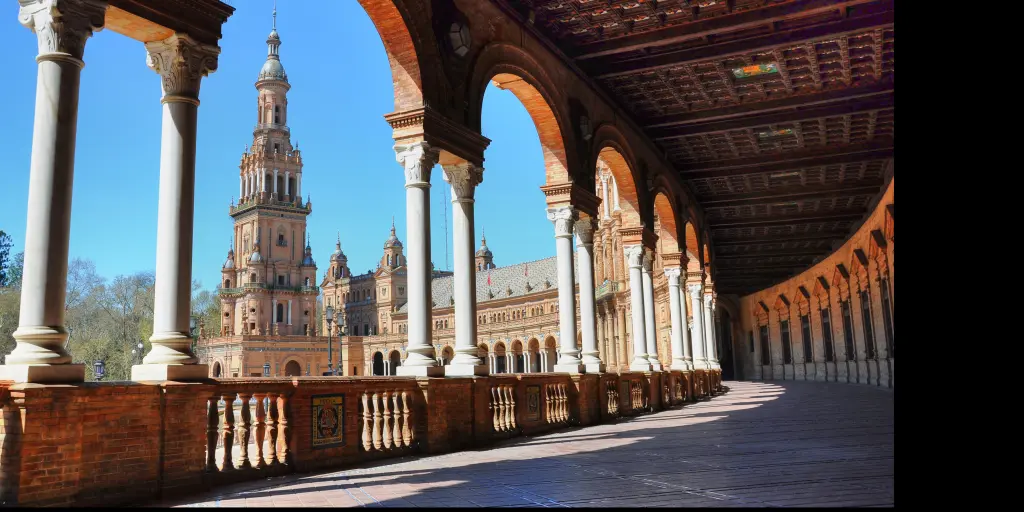
Visit Seville's Real Alcazar
The Alcazar is probably Seville's best-known attraction, famed for its unique fusion of Moorish and Christian architecture.
Originally built as a mudejar fort, it has been converted into a Royal Palace and comes complete with stunning internal courtyards, romantic baths and grandiose apartments.
Along with the Jardines Reales Alcazares gardens around the back, this palace is guaranteed to leave you speechless.
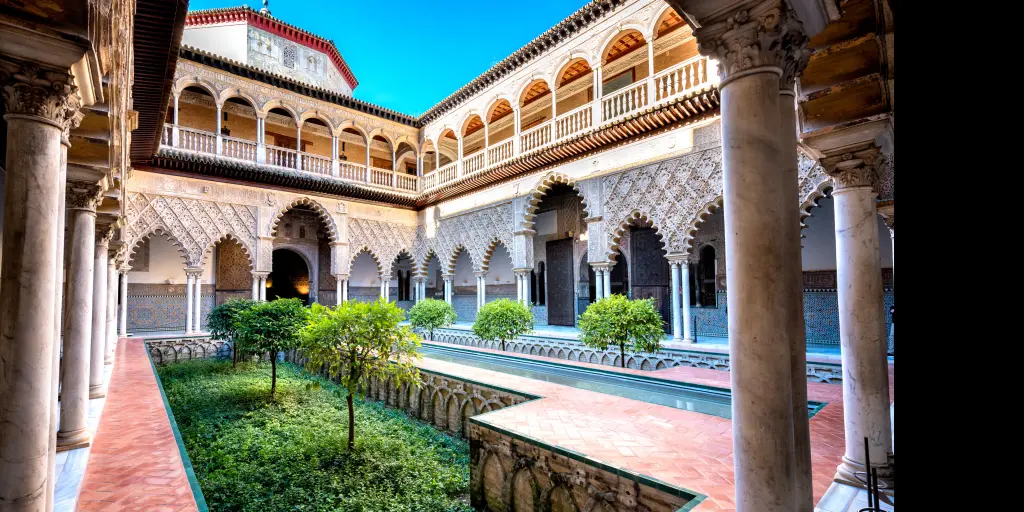
See the largest Gothic church in the world
Last but not least on your long excursion around the city is the Seville Cathedral.
As it's only a few yards away from the Alcazar, you might want to have a spot of lunch before going inside. We would recommend crossing to the other side of the Cathedral square and stocking up on traditional local black squid paella on Calle Argote de Molina.
The cathedral itself is a masterful example of Spanish Gothic architecture and is the third largest church building in the world.
The interior's opulence has traditionally been a symbol of the wealth and power of the Catholic church, so you simply must go in and take in the sight for yourself.
Note that much of the altar and surrounding parts were completely rebuilt at the turn of the 20th century after the main dome collapsed in the 1888 earthquake, but despite this, the Cathedral remains staggeringly beautiful.
Be sure to climb up the cathedral's famous main tower, the Giralda.
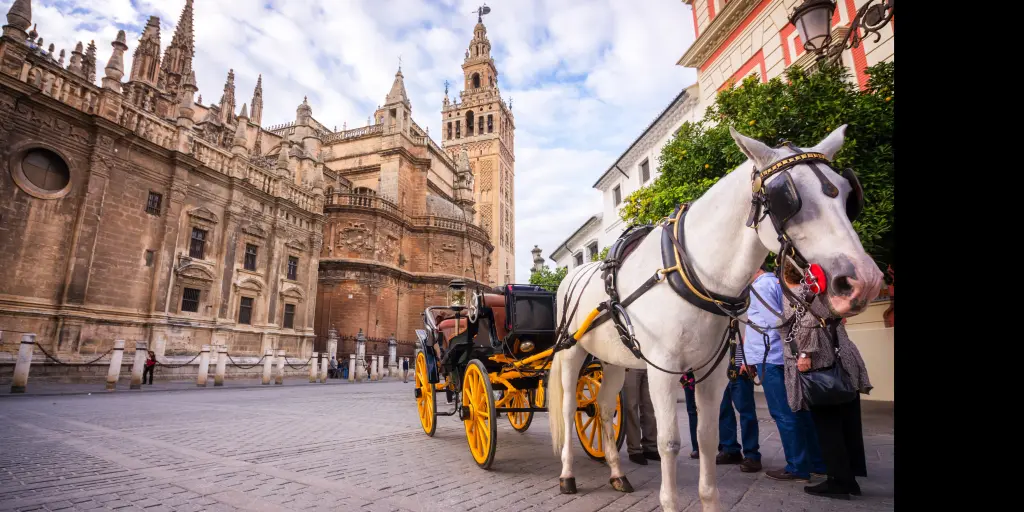
Day 13: Last full day of the Spain road trip - day trip to Cordoba
On we go with the last leg of our Spain road trip.
If you thought that Seville is hot during the summer months, wait until you get to Cordoba. The city boasts Europe's hottest summer climate, and you can expect to feel it hitting you square in the face as you get out of your air-conditioned car.
The city centre is fairly compact, so your best bet is to drive towards Avenida de la República Argentina/Paseo de la Victoria and park on the street.
Explore Cordoba's top attractions
The first stop on your Cordoba tour is the Cathedral of Cordoba - aka La Mezquita. This stunning piece of architecture is probably the most impressive sight on this road trip through Spain.
This unique cathedral in the centre of the city was built on the site of a grand Moorish mosque. When it was constructed, La Mezquita defied tradition, incorporating much of the Mosque's design into the Cathedral structure.

This melange of cultures reflects the history of Cordoba, which has been characterised by two religions living side by side for centuries.
The ancient city of Cordoba is surprisingly unlike any of the other major cities in Andalucia.
The ancient Moorish influences are considerably more evident here, the narrow streets, low-rise buildings and shops looking more like northern Africa than Spain.
Be sure to pass through the Jewish Quarter to see beautiful white-washed houses set out in an impossible maze.
Cordoba used to be Europe's biggest city in the early medieval period, and it was Spain's capital during the days of the Roman Empire.
This vast historical importance means there are dozens of sights and museums to visit all around town. Many of these focus on archaeology, although there are other culture-based ones such as the Casa de Sefarad in the Jewish Quarter, where you can learn about Cordoba's Jewish community throughout history.
How to spend your evening in Seville
At the end of your day out, hop back into the car and return to Seville for the last night of your road trip - Spain has been well and truly conquered.
If you feel like treating yourself, Seville has plenty of outstanding restaurants.
If you fancy some traditional local cuisine, look no further than the Eslava in San Lorenzo, which has the town's best choice of tapas. For something a little bit more exotic, try the Az-Zait - the food here is fantastic, but it is also one of the pricier options around.
Day 14: Seville - Eat a meal at the market & fly home
The last day of your stay is likely to be cut short by the need to get to the airport or get started on your drive back home.
Malaga airport offers the most flight options out of Andalucia so consider options from there. Madrid airport is over 5 hours away so it's not a great option.
If you've hired your car in Barcelona, all major car hire firms have depots right by the airport, so make your way straight there.
If you have a bit of time to kill before leaving, make sure you go and wander through Calle San Pablo and the surrounding streets for a bit of shopping and some great cafes.
For one last taste of authentic Spanish life, walk across the Puente de Isabel II bridge and head to the large market on the right. Here you'll find a great choice of cured meats and other traditional produce.
Pick up a couple of snacks and souvenirs to remind you of your lazy trip along Spain's Mediterranean coast!

Tips for your Spanish Road Trip
Almost all cities in Spain have a network of underground car parks right in the centre - don't be afraid to follow signs for the centre of the city and dip into one of the car parks to check out the sights.
The motorways and dual carriageways in Spain are some of the best in Europe - the surfaces are typically very good, traffic is generally sparse and you can literally pay to go faster (speed limits are higher on toll roads)!
To get all the details, read our Driving in Spain guide with a lot more about local rules, speed limits and general quirks.
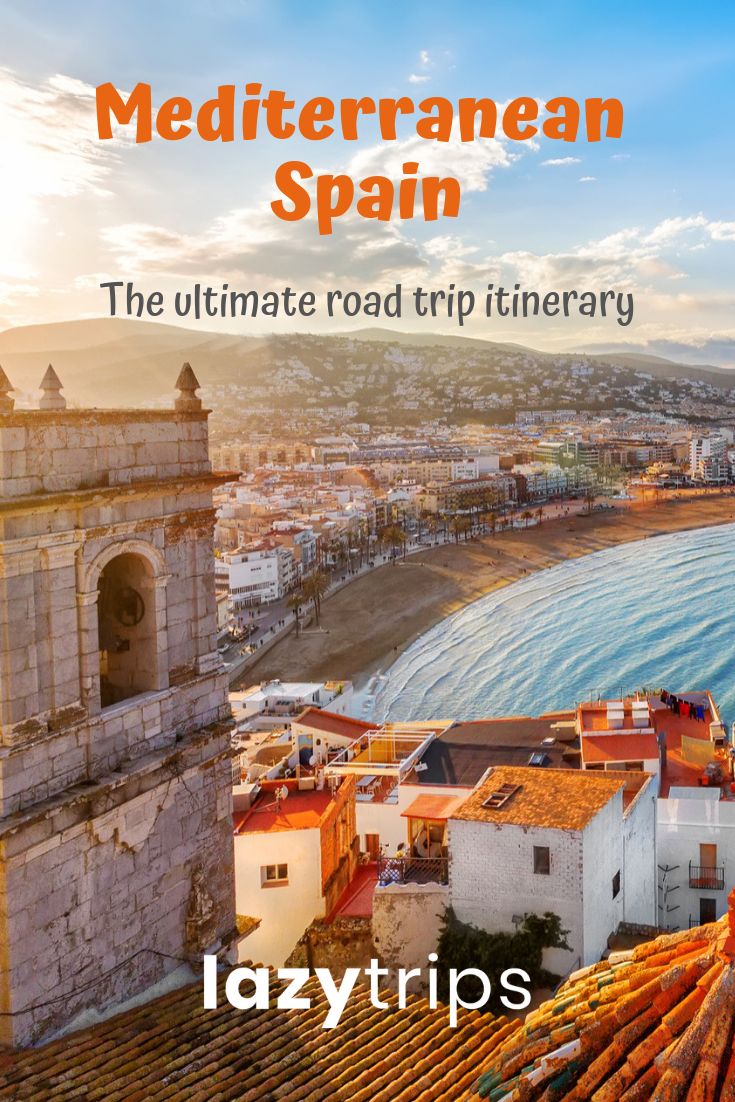
Join our email list!
By joining our email list, you give LazyTrips permission to use your email for sending you newsletters, emails and updates including for marketing purposes. Your email will not be provided to third parties.
Related posts

Nomadic Matt's Travel Site
Travel Better, Cheaper, Longer
Spain Travel Guide
Last Updated: April 18, 2024
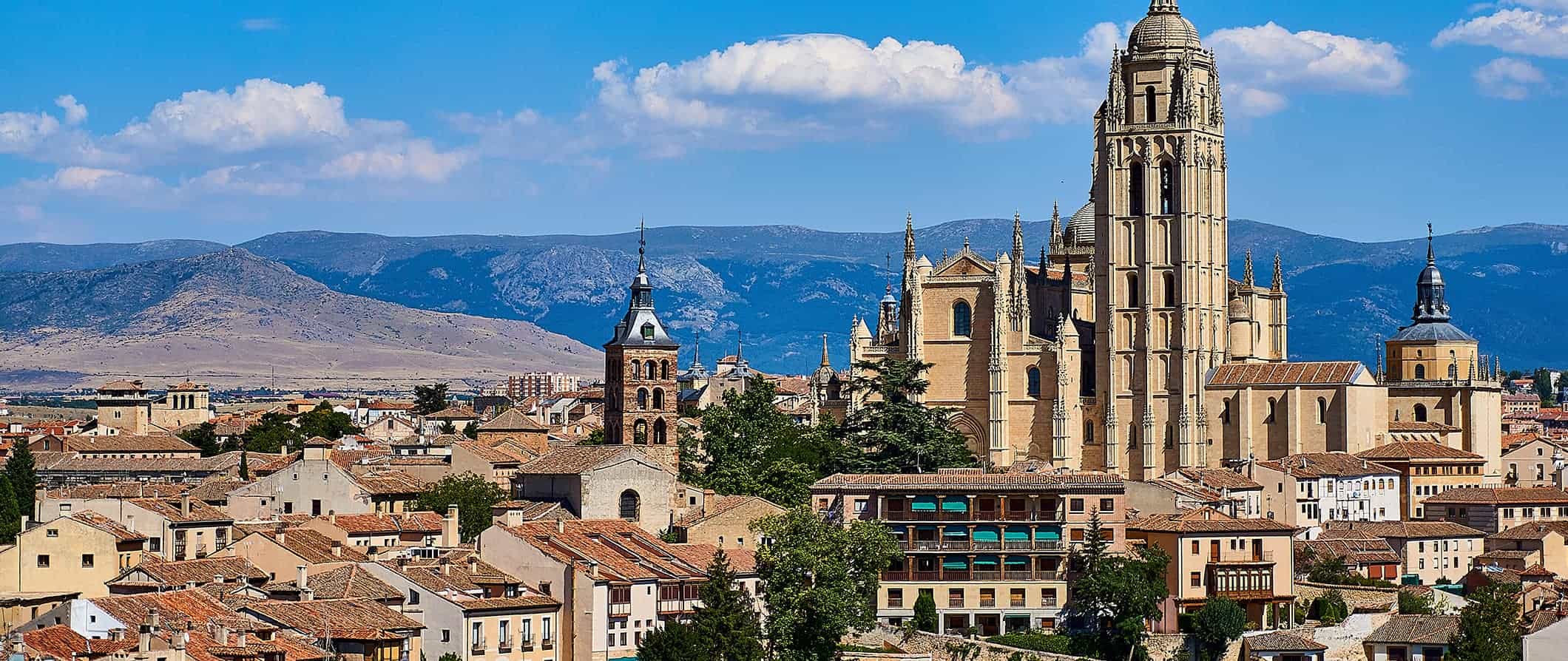
Spain is a country that moves slow. This is the land of the siesta. It’s a place for foodies, night owls, history buffs, religious pilgrims, and anyone not in a rush to do just about anything!
It’s a huge country with a lot of variety: Madrid and Barcelona are hip and energetic cities, Granada has a Moorish touch, Valencia has its own vibe, Catalonia has its own language and culture, and the Basque region (an autonomous community in northern Spain) feels like you’re in an entirely different country.
And, as an added bonus, Spain is an incredibly affordable place to visit. I’ve been traveling to the country for over a decade and I never break the bank while I’m there. It’s really easy to get by on a budget.
This budget travel guide to Spain can help you plan your trip, save money, and make the most of your time in this vibrant country.
Table of Contents
- Things to See and Do
- Typical Costs
- Suggested Budget
- Money-Saving Tips
- Where to Stay
- How to Get Around
- How to Stay Safe
- Best Places to Book Your Trip
- Related Blogs on Spain
Click Here for City Guides
Top 5 things to see and do in spain.
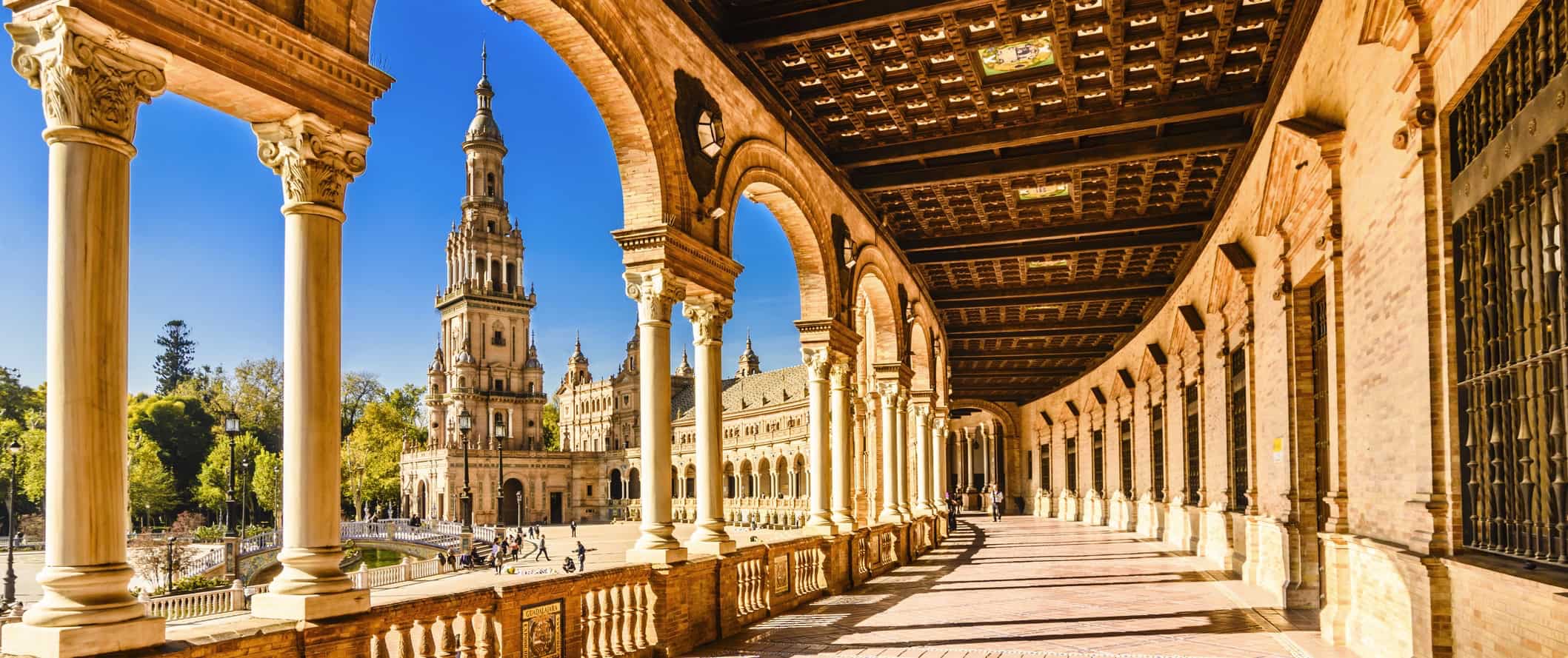
1. Enjoy Barcelona
Barcelona is famous for its all-hours partying, late-night meals, and historic streets. Embrace the nocturnal lifestyle and you’ll fit right in. Don’t miss the Museu d’Història de la Ciutat — it’s one of the best in Europe and contains the largest Roman excavation outside of Rome itself. Other highlights include the Picasso Museum (Museo Picasso), where you’ll need some time to peruse 5,000 or so of the artist’s works; the towering and iconic Basilica De La Sagrada Família , one of a number of striking buildings across the city by famous architect Antoni Gaudí; Barri Gòtic (the Gothic Quarter), where winding streets create a welcome maze built for wandering; and finding your way through the actual labyrinth that is the city’s oldest green space, Parc del Laberint d’Horta.
2. Explore the history of Granada
Granada is one of my favorite cities in Spain. It’s a place where culture, architecture, and ideas from North Africa and Europe collide in a unique way, and no trip to the south of Spain is complete without a visit. Don’t miss the Alhambra, a UNESCO World Heritage Moorish palace and fortress built in the 13th century, and the Fajalauza ceramic factory, which dates back to 1517 and still remains in the same family. There are also a number of cathedrals and monasteries, including the peaceful Monastery of San Jeronimo, with leafy cloisters and a lavish chapel (5 EUR). Be sure to watch a flamenco show while you’re here (they’re usually around 20 EUR) and visit a Moorish tearoom for mint tea (locals recommend it with plenty of sugar).
3. Wander Madrid
Madrid , the capital of Spain, is famous for its museums, tapas, and nightlife. Like Barcelona, this is a city that doesn’t get going until midnight, which makes for quiet mornings with empty streets if you want the city all to yourself. Make sure you visit Museo Del Prado, one of the largest art museums in the world (get skip-the-line tickets from Get Your Guide ), and the Royal Palace — with nearly 3,500 rooms, it’s the largest palace in all of Western Europe. Other highlights include the Temple of Debod (an Egyptian temple from the 2nd century BCE), El Retiro Park (a UNESCO World Heritage Site), the 15th-century Plaza Mayor, the city’s central square, and El Rastro market every Sunday — a mix of flea market finds, clothing, and jewelry.
4. Revel in La Tomatina
La Tomatina is an epic hour-long tomato fight that draws upwards of 20,000 people to the small town of Buñol (only 9,000 people live in the town itself). Started in 1945, this festival is held on the last Wednesday of August, and over 360,000 pounds of tomatoes are thrown during the event. It starts when water cannons fire, and it ends after exactly one hour. It’s the most amazing and messy festival I’ve ever been to! (Tip: Stay in Valencia for more overnight options.)
5. Discover Seville
Other things to see and do in spain, 1. lounge on the costa del sol.
Hang out on the beach and enjoy the laid-back lifestyle for which Spain is famous. This slice of southern Spain is renowned for its beaches, nightlife…and tons of tourists. That said, it’s still a fun place to eat great food in seaside restaurants (the region is famous for pescaito frito , or deep-fried fish), enjoy watersports in the clear Alboran Sea, drink sunset cocktails, and relax on beautiful beaches. Malaga is one of the go-to destinations on the coast, but I think there are better places further down, like El Bajondillo’s white sand beach and the incredible seafood surrounding La Carihuela beach. To beat the crowds, visit during the shoulder season. The weather will still be warm, but it won’t be as crowded.
2. See Valencia
Valencia is a pretty amazing town. Initially, I wasn’t attracted to Valencia — I simply went for the tomato fight in nearby Buñol (most participants use Valencia as their base during the festival). However, Valencia grew on me as I explored the city, as it makes for a quiet stop between Spain’s more lively cities. Originally a Roman colony and once the capital of Spain, it has delicious seafood, a unique local paella (rather than seafood, the recipe uses chicken, rabbit, and beans), a popular soccer club (Valencia CF), and a giant food market (Mercado Central) housed in an extravagant domed building that looks like a cathedral. It’s a cool city that straddles the past and future with historic streets, futuristic museums — there’s literally a museum focused on “enlightenment and modernity,” and an awesome seaside boardwalk that passes plenty of great tapas spots and the historic fishing district of Cabanyal.
3. Walk the Camino de Santiago
El Camino de Santiago, or The Way of St. James, is one of the most popular pilgrimage routes in the world. The path most people take, the French Way, runs from the border of France all the way to Santiago de Compostela in northwestern Spain. Stretching 800 kilometers (500 miles), you need around a month to complete the entire route. The mostly flat Camino is best done in May¬–June or September–October (July and August are both very busy and very warm). If you have the time, it’s a really great way to see the country and some of the less-visited areas of Spain. Of course, you can also walk sections of it if you just want to see what it’s like on a day hike.
4. Tour the islands
Spain has some of the most beautiful islands in all of Europe. Unsurprisingly, during July and August, they’re crowded and expensive, so try to avoid peak season. If you love beaches, surfing, hiking, or cycling, then be sure to hit up Gran Canaria, a UNESCO Biosphere Reserve filled with beautiful landscapes and wildlife, including dolphins. If you’re coming to Spain to party, a stop in Ibiza for its all-night clubs is a must. Other islands worth checking out are Tenerife (home to Teide National Park and the highest peak in Spain), Majorca (for turquoise water and medieval architecture), and La Palma (a certified Starlight Reserve). Ferries from Barcelona and Valencia run frequently from late spring to early summer. In the winter, ferries only run a few times a week.
5. Visit Gibraltar
Bordering Spain on the Iberian peninsula, Gibraltar has actually been an overseas territory of the United Kingdom since 1713. It’s known as “The Rock,” owing to the 426-meter-high (1,397-foot) limestone ridge that dominates the island — you can ride a cable car to the top, or get great views by climbing the 18th-century Mediterranean Steps. There’s an interesting mix of cultures here too, with influences from Britain, Spain, and North Africa. With sunny days year-round, views of two continents (Europe and Africa), wildlife galore (including Gibraltar monkeys, which are actually Barbary Macaques and the only population of wild monkeys in Europe). There are also plenty of sandy of beaches and caves to explore (St Michaels Cave is probably the most popular), it’s a small swatch of land with enough to see and do to make a short visit worthwhile.
6. Play in the Sierra Nevadas
This mountain range, located within Spain’s largest nathional park, is in southeastern Spain near the Mediterranean Sea. It’s the perfect place for summer hiking, winter skiing, and exploring small towns year-round. The area is one of the prettiest and most rugged regions in Spain and one of the better areas for outdoor activities in the country. There are plenty of trails ranging in length and difficulty, as well as the possibility for guided tours. Popular hikes include Mulhacen (6 hours), El Chullo (4-5 hours), and Pico de Veleta (4-5 hours). Lift passes for skiing at Sierra Nevada resort in the winter start at around 50 EUR per day.
7. Visit San Sebastián
Known as Donostia in Basque, San Sebastián is at the center of the Basque area of Spain. This place has killer nightlife and beaches (La Concha beach is the most popular), as well as loads of history throughout the city. It was founded in 1180 in the area that’s now become the Old Quarter. = The architecture — a cool mix of 16th-century Gothic churches, 19th-century mansions, and ultra-modern buildings — makes it one of the most beautiful and unique cities in all of Spain. For stunning views of the coast, hike up one of the 4 trails of Monte Urgull, located at the tip of La Concha. The city sees a fraction of the visitors compared to c Madrid or Barcelona so it’s much less crowded (and less expensive ). The regional Basque cuisine here is delicious, so be sure to take a food tour while you’re here.
8. Admire the Great Cathedral and Mosque
The Mezquita de Córdoba (Cathedral of Our Lady of the Assumption) is by far the most exquisite example of Muslim influence in Spain. Located in Córdoba just east of Seville, its giant arches, jasper columns, marble floors, richly gilded prayer niches, and the awe-inspiring domed shrine of Byzantine mosaics take you back to when Córdoba was under Muslim influence in the 12th century. Admission is 13 EUR and skip-the-line guided tours are 24 EUR.
9. Unwind in Salamanca
Salamanca seems to be in the middle of nowhere (it’s 2.5 hours northeast of Madrid by car), but it’s worth the detour for the history (it dates back to the Celtic era), and its historical Old Quarter which is a UNESCO World Heritage Site. The university town has a mix of small-town atmosphere, great nightlife, and plenty of backpackers. In the old quarter, join the other tourists trying to spot the frog carved into the 16th-century university facade — said to bring professional success. The main square, Plaza Mayor, is one of the largest in Spain and is great for soaking up the city, and the nearby cathedral is gorgeous. It’s actually two cathedrals —an Old, from the 12th and 13th centuries, and New, from the 16th — joined together.
10. Hike the Pyrenees
The majestic mountain chain that walls off France is laced with medieval villages, high mountain walking trails, and great skiing. It’s also the traditional start of the Camino (see #3 above). You can hike through the Pyrenees on one of three established routes, but it takes most people almost two months to complete the entire trek (choose spring or fall, summer will be extremely hot). Of course, you can also just hop on the Camino for a single-day hike or weekend hiking trip along one of the moderate routes. If you don’t want to go solo, you can take a full-day hiking tour of the Pyrenees from Barcelona with Get Your Guide .
11. Visit the Guggenheim Museum
One of the most famous museums in the world, the Guggenheim Museum Bilbao (a port city in northern Spain) always has some interesting exhibitions on modern art (including a permanent sculpture, “Snake,” that’s made of hot-rolled steel and spans more than 100 feet long!). There is also the iconic (and giant) spider sculpture outside the museum, and pieces by Rothko hang inside. Even if you’re not a modern art fan (I personally don’t love it), it’s still worth stopping by because the building is art itself. Frank Gehry, arguably one of the most famous living architects, designed it to have an eye-catching, undulating style, and the grand atrium alone is worth a visit. Admission starts at 16 EUR.
12. Explore Basque Country
Basque Country is an autonomous region in Spain, a place with its own unique culture and heritage. (The Basque people inhabited the area before Spain became a nation.) Located in the northeast corner of the country, you’ll notice the cultural and linguistic differences as soon as you step foot in the region. If you’re into off-the-beaten-path locations, be sure to tour Basque Country, which offers coastal areas, small towns, and mountains. Don’t miss the 153-year-old La Bretxa market in San Sebastian (open every day except Sunday), the Gothic-style St. Mary’s Cathedral in Bayonne, and Le Grand Stroll in Biarritz while you’re here. (The start of the Camino passes through the area as well.) La Rioja wine region can also be found in Basque Country — try its famous drink, a white wine called txakoli . Expect lots of seafood, lamb dishes, and pintxos (Basque tapas).
For more information on specific cities in Spain, check out these guides:
- Barcelona Travel Guide
- Granada Travel Guide
- Madrid Travel Guide
- Seville Travel Guide
- Valencia Travel Guide
Spain Travel Costs
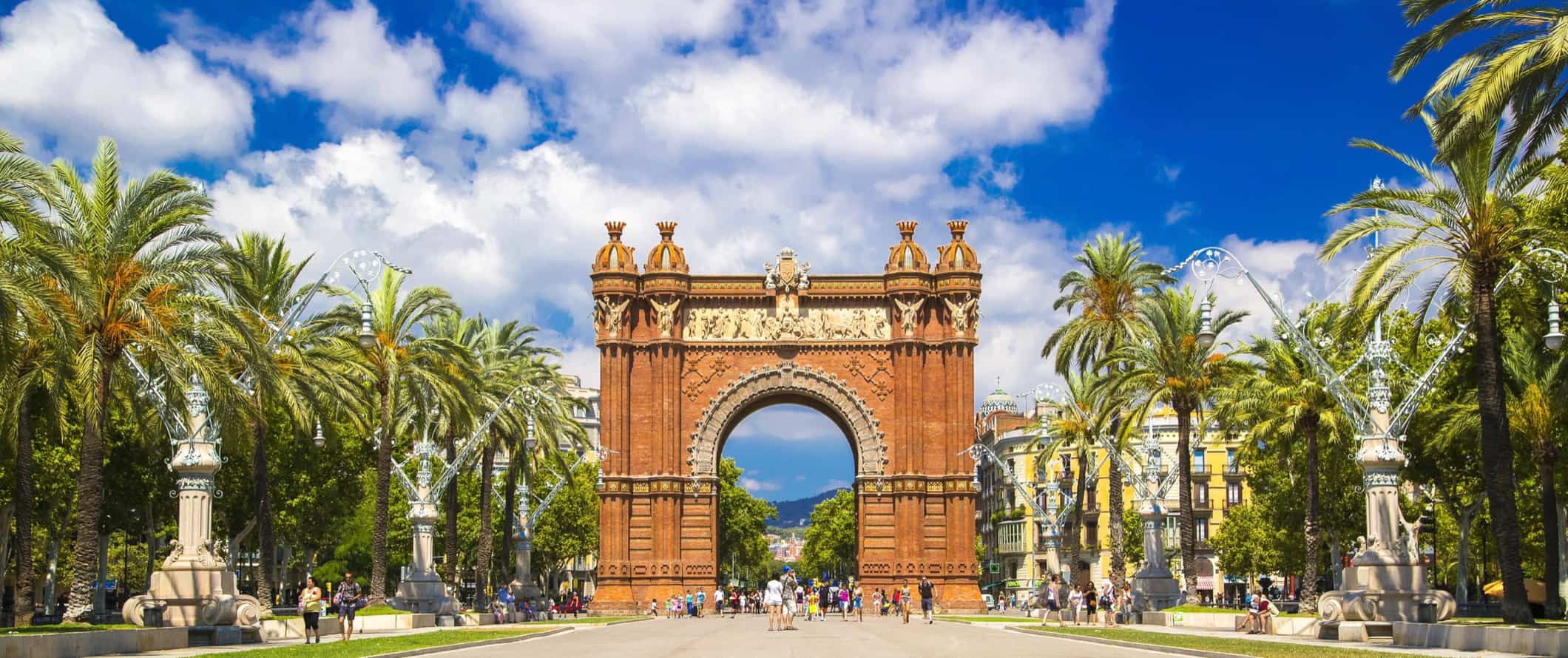
Budget hotels begin around 125 EUR for a twin or double and go up from there. Prices are slightly lower outside of the major cities and tourist areas but are about 20-30% higher during peak season. For larger cities during the summer high season, expect to spend closer to 200 EUR or more a night.
Airbnb is common in most major cities, with a private room starting around 60 EUR per night. For an entire home or apartment, expect to pay at least 120 EUR per night (often double that in the big cities or during peak season).
For those traveling with a tent, there are hundreds of campsites across Spain. Campground costs around 20 – 40 EUR per night. They can be as low as 5-10 EUR for a basic tent plot without electricity, while other costlier sites (around 50 EUR per site) often include extra luxuries like a pool, electricity, and Wi-Fi.
Food – Spain has a strong food culture. Meals can last for hours, and dinner often isn’t served until after 8 p.m. Each region in the country has its own local dishes and food culture, but there are some common favorites, like paella (originally from Valencia), gazpacho, churros, jámon ibérico (cured pork), patatas bravas (fried potatoes with sauce), gambas al ajillo (garlic shrimp), and tortilla (Spanish omelet).
You can usually find tapas and sandwiches for 5–10 EUR. Assembling a meal of tapas at a casual bar usually costs around 15-20 EUR, including a glass of wine. Cheap fast food (think McDonald’s) costs around 9 EUR for a combo meal. Chinese food is around 10 EUR for a main dish, while pizza costs 10-14 EUR.
Beer is 3–4 EUR, a glass of wine is 2-4 EUR, and a latte/cappuccino is around 2 EUR. Bottled water is about 1.50 EUR. (In general, tap water is safe to drink in Spain.)
A decent casual restaurant meal costs around 25-30 EUR with a drink. If you go out for paella, drinks, or appetizers, plan to spend around 35-45 EUR for a meal.
Spain has a lot of expensive restaurants if you want to splash out. Meals at finer establishments begin around 55 EUR.
If you plan on cooking your own food, groceries cost around 45-65 EUR per week. This gets you basic staples like pasta, rice, seasonal produce, and some meat or seafood. You can find the cheapest (and freshest) produce and meat at local markets.
Backpacking Spain Suggested Budgets
On a backpacking budget of 90 EUR per day, you can afford to stay in a hostel dorm or private Airbnb room, cook most of your meals, limit your drinking, take public transportation to get around, and do mostly free activities like free walking tours and relaxing in the parks. Add at least 20 EUR per day to your budget if you plan on drinking or partying a lot.
On a mid-range budget of around 215 EUR per day, you can stay in a private room in a hostel, or a 2-star budget hotel, eat out at inexpensive restaurants for most meals, have a few drinks, take the occasional taxi, and do more paid activities like cooking classes and museum visits.
On a “luxury” budget of 350 EUR or more per day, you can stay in a nicer hotel or entire Airbnb apartment, eat out regularly, drink more, take more taxis, and enjoy more guided tours. This is just the ground floor for luxury though. The sky is the limit!
You can use the chart below to get an idea of how much you need to budget daily. Keep in mind these are daily averages — some days you spend more, some days you spend less (you might spend less every day). We just want to give you a general idea of how to make your budget work. Prices are in EUR.
Spain Travel Guide: Money-Saving Tips
Overall, Spain is pretty affordable. While accommodation costs in most touristy as well as larger cities have risen greatly in the last few years, everything else is still affordable. Individual city guides have more specific information on how to save in each city, but here are some general ways to save money while traveling around Spain:
- Get the menu of the day – Most restaurants offer a cheap and filling “menu of the day” ( menu del dia during lunch for around 10–15 EUR per person. They are a good way to save money while enjoying some delicious Spanish food. Wine or water are generally included, too. Look for more crowded spots — that’s how you know the food is good. Skip eating out for dinner — it’s too expensive!
- Eat free tapas – In some cities (like Granada), you can find bars where free tapas are given out when you order drinks. Bounce around the bars to eat cheap while enjoying a few drinks.
- Stay with a local – Couchsurfing is a great way to save money on accommodations while also getting some insights from locals. You might have better luck in the larger cities, but be sure to book early as the major cities also see the most requests.
- Take the bus – While the train system is fast, it’s expensive, with high speed trains double (or more) the cost of buses. If you have the time and want to save money, take buses to get around the country. It will take longer but, if you’re on a budget, it will be worth it. And look at booking your tickets online and in advance — it can save you money.
- Get a city pass – Most of the major cities have multiple museums, attractions, and activities worth checking out. Buying a city pass — like the Madrid City Card (from 8.40 EUR) or Malaga–Costa Del Sol Sightseeing Pass (starting at 14 EUR) — can save you money on these activities and also get you free transportation. These passes will save you a lot of money if you’re planning on visiting the major sights.
- Ride a bike – Tourists can use public bikes in cities such as Madrid and Seville for a daily or weekly fee. Take note, Barcelona’s red city bikes (Bicing) are for residents only, but you can find shops that offer daily or weekly bike rentals.
- Use BlaBlaCar – This app connects you with drivers who have room in their cars for additional passengers. Drivers are vetted and verified, so it’s a cool way to get out of stuffy trains and buses, meet interesting characters, and take a mini road trip. It’s one of my preferred methods of travel for medium- and long-distance trips.
- Bring a water bottle – The tap water here is safe to drink, so bring a reusable water bottle to save money and reduce your plastic use. Spain now offers more water fountains and bottle-filling stations than in the past. LifeStraw is my go-to brand as their bottles have built-in filters to ensure your water is always clean and safe.
Where to Stay in Spain
Spain has plenty of budget-friendly hostels and hotels all around the country. Here are some of my recommended places to stay:
- HelloBCN Hostel (Barcelona)
- Hotel BestPrice Gràcia (Barcelona)
- OK Hostel (Madrid)
- Petit Palace Puerta del Sol (Madrid)
- The River Hostel (Valencia)
- Red Nest Hostel (Valencia)
- Oasis Backpacker’s Hostel (Seville)
- Onefam Centro (Seville)
- ECO Hostel (Granada)
- Hostal Antares (Granada)
For more places to stay, check out the city specific destination guides.
How to Get Around Spain
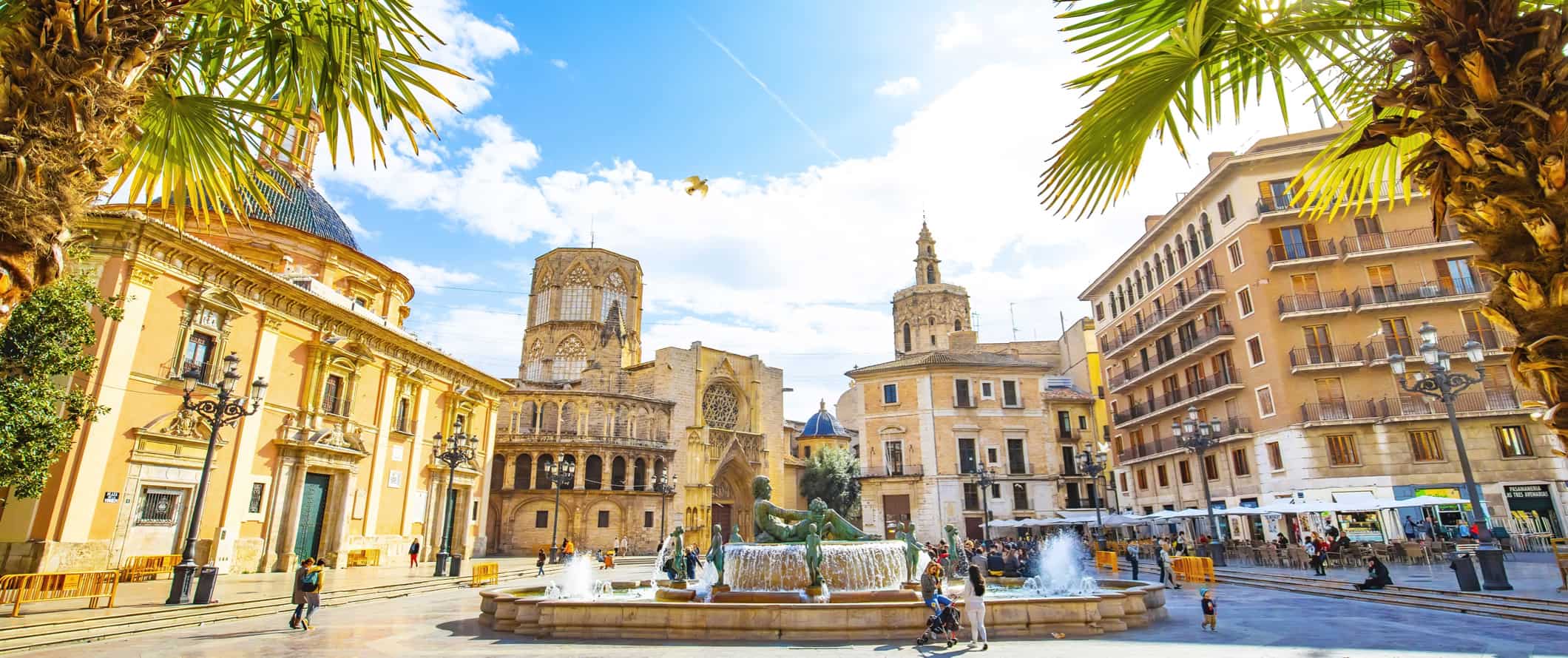
Bus – The bus is the cheapest option for getting between cities in Spain. FlixBus has tickets starting as low as 6 EUR. Most buses come with outlets and free Wi-Fi. A 9–hour trip from Madrid to Barcelona starts from about 35 EUR, while the 4–hour trip between Seville and Granada costs around 25 EUR. Alsa is another popular bus company for travel throughout the country.
Trains – RENFE is the national rail line in Spain. High-speed trains are more expensive, but you can travel between Madrid and Barcelona in just 2.5 hours. Even on the more expensive high-speed train, however, you can find tickets from Madrid to Barcelona for as low as 55 EUR during off peak times in the offseason. The trip from Madrid to Seville is around 2.5 hours and costs 35 EUR, while Madrid to Valencia is just under 2 hours and costs 30 EUR.
To find routes and prices for trains around Spain (and Europe), use Trainline .
A Eurail Pass , which allows travelers to explore Europe by providing a set number of stops in a specific time period, might also be a good option depending on your plans. For more information, here’s a detailed breakdown of how Eurail passes work and can save you money .
Flying – If you’re pressed for time and are looking to hop from one city to the next, a budget airline. You can find really cheap fares on most routes.
However, be aware that you have to pay for all the extras on these cheap flights (such as checked baggage, picking your own seat, etc.) So, while flights are cheap (Madrid to Barcelona can be found for as little as 65 EUR round trip), the little expenses add up. And when you factor in getting to/from the airport, most flights really aren’t much faster than the train.
Car rental – Car rentals can be found for as little as 25 EUR per day for compact vehicles when booked in advance. Make sure to check if the car is standard or automatic when reserving. Renters will need an International Driving Permit prior to book. The minimum age for renting a car is 21. For the best rental car deals, use Discover Cars .
Ridesharing – If your schedule is flexible, use a ridesharing service and catch rides with locals between cities. Drivers are verified and it’s perfectly safe. BlaBlaCar is the biggest company.
When to Go to Spain
Spain is lovely year-round, but the peak season — meaning, busiest and most expensive— is in the summer, from June to August. Popular destinations like Barcelona and Ibiza experience a massive influx of tourism — so much so that Barcelona’s residents have started clamping down on overtourism. Accommodations in the larger cities require serval months of advance booking is summer, and small shops may be closed in August for family holidays. The weather is fabulous this time of year, with high temperatures well into the 30s°C (90s°F)
The temperature in Spain doesn’t often drop too low, with winter temps between 4-10°C (40-50°F) country-wide. However, Northern Spain does sometimes experience snowfall — especially in the mountainous areas. While I wouldn’t aim to visit in the winter, if you’re already in Europe, this is going to be one of the warmer destinations on the continent, especially in the south. Madrid and Barcelona have plenty of holiday festivals in December and early January for Christmas and Three Kings Day. If you are in Spain during the holidays, visit a bakery to try traditional, seasonal desserts.
The shoulder seasons (spring and autumn) are great times to visit. Tourist sites are less congested (think Gaudi attractions in Barcelona)and prices are a bit cheaper, especially accommodations in Barcelona or Madrid. Temperatures are pleasant, although it’s not exactly beach season. Beach destinations like Ibiza and Mallorca tend to get very quiet during this time, but there is still plenty to see and do around the rest of the country. If you plan on outdoor activities or hiking the Camino de Santiago, this is the time of year to do it.
How to Stay Safe in Spain
Spain is pretty safe to visit. Violent attacks are uncommon, and the country is safe for solo travelers However, petty crime is really widespread and pickpocketing is very common in the larger cities, especially near major tourist sites (such as La Rambla in Barcelona) and on public transportation. Always keep your valuables secure and out of sight when on public transportation and when out and about. The thieves here are incredibly quick here. Report thefts to the local police, or ask your hotel or hostel how to file a report.
Be extra careful in Barcelona, especially in high season, where people may try to snatch your phone on the street or grab your stuff in crowded subways (pickpocketing is not as bad elsewhere in Spain). Also, never leave your backpack, phone, or laptop out and unsecured when at a cafe or restaurant. They can disappear in the blink of an eye.
Scams are also very common, especially in the larger cities (not that common though in smaller cities). Keep an eye out for kids in groups who might try to distract you before lifting your wallet, as well as people who might offer to “help” carry your luggage or take your photo, only to expect a hefty tip as thanks. You can read about common travel scams to avoid here .
Solo female travelers should generally feel safe here. However, the standard safety precautions apply (always keep an eye on your drink at the bar, never walk home alone at night while intoxicated, etc.). Many hostels also have female-only dorm rooms. For specific tips on staying safe, check out one of the many solo female travel blogs on Spain. They’ll be able to provide specific advice that I, a man, can’t.
If you experience an emergency, dial 122 for assistance.
Always trust your gut. Make copies of your personal documents, including your passport and ID, and keep them separate from your originals. When you’re walking around, take minimal cash and one form of ID.
The most important piece of advice I can offer is to purchase good travel insurance. Travel insurance protects you against illness, injury, theft, and cancellations. It’s comprehensive protection in case anything goes wrong. I never go on a trip without it as I’ve had to use it many times in the past. You can use the widget below to find the policy right for you:
Spain Travel Guide: The Best Booking Resources
These are my favorite companies to use when I travel. They consistently have the best deals, offer world-class customer service and great value, and overall, are better than their competitors. They are the companies I use the most and are always the starting point in my search for travel deals.
- Skyscanner – Skyscanner is my favorite flight search engine. They search small websites and budget airlines that larger search sites tend to miss. They are hands down the number one place to start.
- Hostelworld – This is the best hostel accommodation site out there with the largest inventory, best search interface, and widest availability.
- Booking.com – The best all around booking site that constantly provides the cheapest and lowest rates. They have the widest selection of budget accommodation. In all my tests, they’ve always had the cheapest rates out of all the booking websites.
- HostelPass – This new card gives you up to 20% off hostels throughout Europe. It’s a great way to save money. They’re constantly adding new hostels too. I’ve always wanted something like this and glad it finallt exists.
- Get Your Guide – Get Your Guide is a huge online marketplace for tours and excursions. They have tons of tour options available in cities all around the world, including everything from cooking classes, walking tours, street art lessons, and more!
- The Man in Seat 61 – This website is the ultimate guide to train travel anywhere in the world. They have the most comprehensive information on routes, times, prices, and train conditions. If you are planning a long train journey or some epic train trip, consult this site.
- Rome2Rio – This website allows you to see how to get from point A to point B the best and cheapest way possible. It will give you all the bus, train, plane, or boat routes that can get you there as well as how much they cost.
- FlixBus – Flixbus has routes between 20 European countries with prices starting as low 5 EUR! Their buses include WiFi, electrical outlets, a free checked bag.
- SafetyWing – Safety Wing offers convenient and affordable plans tailored to digital nomads and long-term travelers. They have cheap monthly plans, great customer service, and an easy-to-use claims process that makes it perfect for those on the road.
- LifeStraw – My go-to company for reusable water bottles with built-in filters so you can ensure your drinking water is always clean and safe.
- Unbound Merino – They make lightweight, durable, easy-to-clean travel clothing.
- Top Travel Credit Cards – Points are the best way to cut down travel expenses. Here’s my favorite point earning credit cards so you can get free travel!
- BlaBlaCar – BlaBlaCar is a ridesharing website that lets you share rides with vetted local drivers by pitching in for gas. You simply request a seat, they approve, and off you go! It’s a cheaper and more interesting way to travel than by bus or train!
- Take Walks – This walking tour company provides inside access to attractions and places you can’t get elsewhere. Their guides rock and they have some of the best and most insightful tours in all of Spain.
Spain Travel Guide: Related Articles
Want more info? Check out all the articles I’ve written on Spain travel and continue planning your trip:

The 7 Best Hotels in Madrid
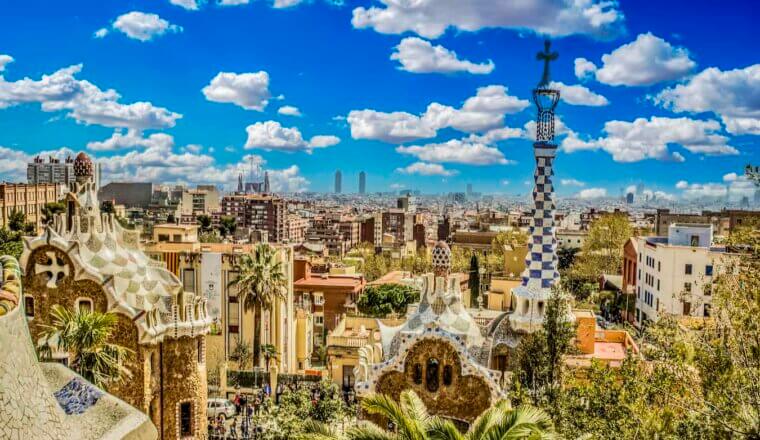
The 7 Best Hotels in Barcelona

The Best Walking Tours in Barcelona
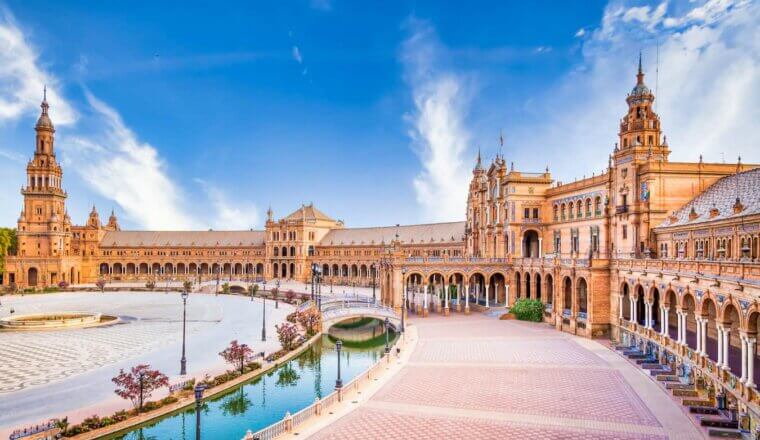
The Best Walking Tours in Seville

The Perfect 3 Day Granada Itinerary
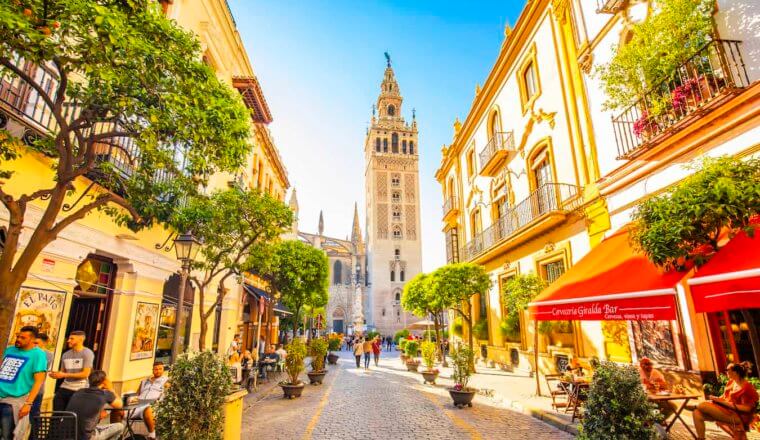
The 7 Best Hostels in Seville
Get my best stuff sent straight to you, pin it on pinterest.
- Where To Stay
- Transportation
- Booking Resources
- Related Blogs
Search the Site

- Accommodation
The Ultimate Spain Road Trip Itinerary
A road trip in Spain – just the mere mention conjures up images of scrumptious tapas, ambrosial wine , affectionate and fun-loving people, pristine beaches, stunning landscapes, and architecture that spans pretty much all ages.
Today, we take you on a journey from Andalucía in the South of Spain all the way up to Figueres in the North-East with a suggested itinerary for a Spanish road trip that will let you savour the best of what Spain has to offer. Expect to see sights like this:

I would like to add that this was a “birthday trip” for Savi, so the idea was to hit as many carnivals and festivals in Spain as possible. Besides having tons of fun, this also made us see the real Spain and helped us understand local culture.
Spain Road Trip Itinerary
- Day 1: Fly from London to Malaga and pick up rental car
- Day 2 – 4: Malaga and some gems of Andalucia
- Day 5: Drive to Valencia via Granada
- Day 6 – 7: Explore Valencia and get bruised by tomatoes in Bunol and coloured by red wine in Valencia
- Day 8: Drive to Figueres
- Day 9 – 11: Explore Figueres and the surrounding areas
- Day 12: Fly back to London from Barcelona
Total distance : Approximately 2,000 Kms including the day-trips

Malaga and Costa Del Sol (4 days)
Malaga is a party-hub and a popular beach-side resort on the Southern coast of Spain. Popular with British tourists, it’s quite cheap to get to Malaga from London. To avoid the commotion, we opted to stay in an adjacent village called Benalmádena – great choice. The beach was quieter and nicer as compared to the one in Malaga and it was just a short drive from the centre of Malaga.
A major reason for us to fly into Malaga was to attend the annual carnival in Malaga, also known as Feria De Malaga. People take to the streets and the Feria grounds as early as 10 in the morning. There’s wine, there’s tapas, there’s dancing, and there’s a lot of happy people. We spent the entire day and the evening partying with the locals.
Read more about our exploits at the Feria De Malaga (opens in a new tab).
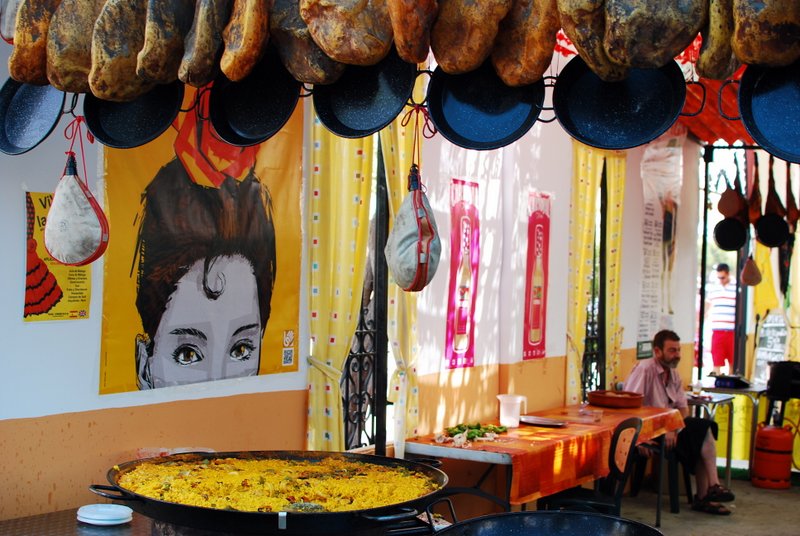
The following morning (what with the hangover!) we decided to enjoy a leisurely Spanish breakfast coupled with a strong cortado (espresso with little milk) and make friends with some locals. Morning well spent, we got into our car, put on our favourite road trip playlist over at Argus, and off we went to explore the surreal rock formations near the quaint village of Antequera. The layered rocks are a sight to behold and the neighbouring village of Antequera is right out of a Spanish fairy tale – cobbled streets, majestic churches, street side cafes, and a towering castle.
Read more about our adventures at the surreal rock formations in Antequera (opens in a new tab).

It’s not possible to visit South of Spain and not visit the mighty Alhambra. Make a day trip out of it, and instead of taking the highway, opt for what is now called the “old road to Granada”. The serpentine road will take you through vineyards, rustic houses, treacherous mountains, and our favourite, Rio Frio, a tiny hamlet which is known for Trout fishing. We’ll be writing a detailed post on this day trip soon, so watch this space.

Accommodation in Malaga
Like we mentioned before, we stayed in Benalmádena , a 20 minute drive from Malaga. The village and the beach were definitely quieter than Malaga, especially in the carnival season. You can compare and book a hotel here .
Valencia and Bunol (3 days)
Valencia is a bustling city and it’s easy to spend a couple of days just walking around countless Plazas (squares), sampling tapas in hidden tapas bars, and sipping on the local drink, Horchata, a traditional beverage made of ground almonds. The highlight of this segment of our road trip, however, was the day we spent in the tiny village of Bunol, made famous by the annual Tomato throwing festival, La Tomatina. Thousands of visitors descend upon this otherwise sleepy village to partake in the biggest food fight in the world. How could we have stayed behind? We can safely say we came out with a lot of bruises and an aversion to tomatoes, at least for the next couple of days. If you can, definitely plan your Spanish road trip so that you can enjoy the madness in Bunol. La Tomatina festival takes place on the last Wednesday of August each year.
If you do make it to Spain during the last week of August, don’t miss out on the wine fight that happens in Haro near Valencia . Participants pour wine all over each other using water pistols, glasses, and buckets at the La Batalla del Vino festival. Expect unending dancing and revelry.
Recommended Reading : Our experience at the Tomato throwing festival, La Tomatina (opens in a new tab).

Accommodation in Valencia / Bunol
We would recommend staying in Valencia instead of Bunol – Bunol is a tiny village and accommodation options are limited. Valencia has tons of places to suit all budgets and needs. You can compare all hotels and book here .
Figueres and Costa Brava (3 days)
Figueres is known for the The Dalí Theatre-Museum , which is the largest surrealistic object in the world and houses the largest collection of Dalí’s paintings and sculptures. It’s easy to spend an afternoon in the museum. Owing to the popularity of the town, accommodation is sometimes difficult to come by, so it’s best to set base in one of the neighbouring quaint villages like St. Miquel De Fluvia.

There is no dearth of picturesque towns in the Catalonian region, Cadaques being one of the most popular ones. For us, however, the medieval town of Besalu and the seaside town of Begur stole the limelight. This region boasts of some of the most spectacular drives and scenery in Spain, not to forget vast expanses of sunflower fields.

On the last day of our road trip, we spent the entire afternoon lazing on one of the hidden ‘Calas’ (coves) that are commonly found in Costa Brava. Looking back on the last 10 days, we realised that we had seen so much, met such amazing people, eaten some of the best tapas, and sampled lush wine. The following day we drove to Barcelona to catch our flight back to London.
Accommodation in Figueres / Cadaques
We stayed in a tiny village called St. Miquel De Fluvia. To be honest, you won’t go wrong if you choose any village/town to stay in this region. If you don’t mind the crowds, then definitely go for Cadaques . If you’d like to be in a quieter place, then look for a hotel or apartment near Figueres .
The next road trip to Spain, this time through central Spain, is currently being planned as we pen this post 🙂

- We opted for self-catering apartments in Malaga, Valencia, and Figueres. The cost was roughly £15 per person per night on an average. You can find more details in our Where To Stay In section .
- Car rental in Spain is cheaper than other European countries. We paid £15 per day for a 5-door economy car from Hertz. There was NO one-way drop-off fee when renting with Hertz.
- There are two kinds of highways in Spain – Autopistas and Autovias. The former are mostly toll roads, so if you want to save some money, use the Autovias which have a lower speed limit.
- All towns and cities are well connected by road and it’s easy to drive in Spain. As always, it’s handy to have a GPS during your road trip, especially if you like to take detours to discover hidden gems like we do.
- For your visit to The Alhambra, book in advance as the tickets run out fast. The combined ticket to Alhambra, Generalife, and the Nasrid Palaces costs around 14.50 Euros per person. Keep in mind that you have to choose the time of your visit to the Nasrid Palaces when booking the ticket, so plan your day-trip accordingly.
- Entrance to The Dalí Theatre-Museum is 12 Euros per person, but in summer, there is an option of a night time visit, which comes highly recommended from us. Tickets for the night time visit cost 13 Euros per person. It’s strongly advised to book in advance.
We have been to Barcelona and Madrid on city-breaks in the past, so we wanted to do a road trip that would take us to some offbeat places in Spain, and this particular itinerary did not disappoint. From grand palaces to barren deserts, from windy beaches to the snow-capped mountains of Sierra Nevada, we saw it all.
If you are planning a road trip in Spain, you can read all our posts about Spain here (opens in a new tab).
If you love driving as much as we do, you should definitely check out our epic Iceland road trip (opens in a new tab). We can guarantee you that you will be tempted to pack your bags and leave for Iceland 🙂
Drop us a line if you have questions about planning and places to visit – we’d love to help. If you have done a road trip in Spain already, share your tips with us in the comments below 🙂

Previous Post
Offbeat London – Alternative Things To Do In London

Visiting Saigon’s China Town – Travel Fashion in Vietnam
151 thoughts on “ the ultimate spain road trip itinerary ”.
I haven’t done a road trip in Spain, but watching “Spain: On the Road Again” has made me long to go on one to last for weeks, driving, photographing, eating (rinse & repeat). Fantastic! I’ll have to keep your post in mind!
Wouldn’t that be amazing ? We would love to spend 3-4 weeks (or more) driving through Spain. We absolutely love Spain !
Hi is Spain a good idea in January around 19-26th jan.. I’m planning to travel for my anniversary
Yes. Spain will be nice in January too, albeit a bit cold.
Spain Spain Spain !!! I so badly want to be a part of the Tomatina festival some day 🙁 🙁
You should go in 2014 – you’ll love La Tomatina. Maybe you can do a similar road trip to what we did 😉
Planning a similar list part of our bucket list.A bit older but looking forward to the adventure
Tell us how it went 🙂
Great job guys! I’ve been longing for Spain for a few years now and have it on my list for the next few years. Will definitely keep this in itinerary somewhere safe for future. Can I ask, how did you find driving in Spain vs driving in the UK?
If you haven’t driven in Europe before, then you might find driving on the other side a bit tricky to begin with. But you soon get used to it. Driving in Spain was fine as long as you stay out of busy cities. Spanish countryside is very beautiful 🙂
Well done! I will add this into our “to-do” list. Looking at all these road trip posts, I am desperate for one. Have you guys ever done a road trip through French alps?
Hey Snigdha,
We love driving wherever we go – we have driven in the South of France in the French Riviera but didn’t go further north. That post will be up on the site soon )
Yes, this is on my to-do list so badly! Great idea for a road trip, thanks 🙂 I’ll be looking to do something like this in the next year or so.
We are sure you’ll have an amazing time in Spain. Everything about the country is gorgeous.
Ooh, fun! Where are you planning to go for your central Spain road trip? I lived for three months in Merida, the capital of Extremadura, a town full of Roman ruins which receives so few tourists it’s almost like you have them all to yourself most of the time. And I had no idea car rental was so cheap there…if only I could remember how to drive!
Car rental was in fact super cheap. So much so that we had to check twice that the rental agency hadn’t made a mistake 😉 We’ll go to Madrid, Salamanco and Toledo. Merida sounds amazing – we’ll definitely factor that in. Cheers for the tip !
In 2008, I met my then 21 year old son at the Madrid Airport. We rented a car and did a 4 night trip that was a loop with stay-overs in Segovia, Salamanca and Toledo (with a day stop in Avila). Between Avila and Toledo, we drove through the Gredos Mountains. This was a reasonable itinerary for the amount of time we had. My son did the driving. I thought it was because he liked to drive. I only learned later that the only thing he hates worse than driving is the thought of me driving.
That is quite a funny story. I’m sure you guys have a good laugh about it now. The places that you visited sound so amazing – we will be covering those on our next road trip in Spain 🙂
Gadhe !Awesome website! Just started going through it to plan my trip to Spain in end-of-June/first-week-of-July for work+leisure.. Too bad I will miss both the bull run and tomatina, but can’t change my travel dates.. 🙁 Expect a lot of queries from my end! :))
Thanks a lot 🙂 Of course – let us know what all questions you have and we’ll help you plan an amazing itinerary for Spain 🙂
and this post goes in my Life’s top 10-to-do list !!!
Priyadarshini that’s a good choice for a top-10 list. It was definitely one of the best road trips we have done.
What’s so great about Spain is that you never run out of things to do. Most of the great stuff is hidden in the small towns anyway! My favorite villages are Mondoñedo (Lugo), Cangas de Onís (Asturias), Garganta la Olla (Cáceres) and my boyfriend’s hometown, San Nicolás del Puerto. Pueblos have the cheapest food, the best fiestas, and the cutest grandpas!
All the villages you mention sound amazing. For our next road trip through Spain, perhaps 😉 I completely agree about the cutest Grandpas 🙂
We love Malaga too – The Carnival of Malaga should not be confused with the Feria which you went to in August. Carnival is in February – Both are great parties!!!
Thanks guys ! Your tips came in very handy. Yes, we are also planning a trip to Malaga during the Carnival in February:) Absolutely loved Malaga and the Feria
I love Spain!! You guys should definitely try going to Seville and Ronda sometime. They’re both beautiful and for Ronda, you can even do just a day trip. We drove from Granada to Seville and took a 4 hour break in Ronda.
We have been to Seville – way back in 2009. We were completely bowled over by the city. It’s one of our favourite places in Spain. We really wanted to visit Ronda on this trip, but since we had to go up north and attend the La Tomatina Festival in Bunol, we had to give Ronda a miss this time. Will definitely go there next time. Thanks for the heads-up 🙂
savi and vid awesome job. Spain has been on my mind for a long long time and this is how we’d exactly want to do it. I am going to keep this bookmarked for future use 🙂 Love the name, the content everything about this site. Thumbs up from me !!
Thanks Sneha 🙂
We loved this road trip through Spain and are planning another one for next year 🙂
Hi guys, great post! I did a 6 day road trip a few years back starting in Malaga and going to Ronda, Marbella, Casares, Granada, Gibraltar, Las Alpujarras and Nerja. I loved Analucia – definitely my favourite part of Spain. The moorish history, mountain towns, hiking and white washed buildings were incredible. Looking forward to reading about your next trip!
Your trip sounds amazing Katie. We love Spain 🙂
the name says it all . Spain seems to be definitely ultimate.. !!! everything from tomato fight to scenic beaches .. all looks amazing !!! 🙂
What a great itinerary, and beautiful pictures! Was the first European country I visited, so it has a special place in my heart. I only went to Valencia and Madrid, but I’ve been dying to go back ever since. Hopefully one day I’ll be able to do a trip as cool as this!
Hannah Spain is one of our favourite countries. We’ve taken a number of trips in Spain, but this road trip itinerary ranks right up there as our favourite one 🙂
What was the total cost incurred during the road trip? Was communication ever a problem?
Hey Anmol, the cost of a road trip in Spain depends on the place you’re flying from and the accommodation you choose. Just drop us an email with the details and we’ll get back with an estimate of costs 🙂 Communication isn’t a problem. One can get away with English in most places
An indepth exploration of Spain (beyond Barcelona, which we’ve visited) is high on our travel wishlist. The Alhambra and Grenada (and Seville and Madrid) is calling to us! But we’d prefer not to deal with the stress of driving. Hopefully Spain has a good train system like the rest of Europe?
Spain does have a decent rail system but it’s possible to explore a lot more with a rental car. The Alhambra and Granada are gorgeous – you must explore them soon 🙂
I haven’t done a road trip in Spain (yet), and after reading this post, it’s now on my bucketlist!
Spain is one of our favourite countries for a road trip Valerie – one is almost guaranteed perfect weather, scrumptious food, and picture perfect villages in every corner of Spain 🙂
I was planning a 10 days trip to spain with friends.We have for 5 places in mind.Barcelona,madrid,valencia,ibiza and formentera.Could you please suggest best road trip possible from these 5 places.I was thinking of barcelona to madrid..
We’d suggest driving from Barcelona to Malaga (along the coast, via Valencia) and then flying to Ibiza. To be honest, 10 days might not be enough to enjoy all these things, but if you must, drive from Barcelona to Malaga over 6 days and spend 4 days in Ibiza and Formentera.
This looks like a perfect itinerary for a road trip!! I will be going to Spain in Winter with my family and I think theres a high probability of us using your suggested itinerary. Too cool to be missed! 🙂 Thank you for this!
Nurin a couple of our readers have followed the exact same itinerary and they loved it. We hope you have a great time too 🙂
Great post! I’m planning to do a coastal road trip similar to yours but in the last week of dec and into January. Have you been to Spain during those times? I heard the winter on the Mediterranean side is quite mild. Any advice would be appreciated. Thanks! Ps did you pass by any vine regions on this road trip?
Thanks ! Glad you like it. You’ll have a great time in Spain. We have never driven there in December, but I’m certain that as long as you don’t go up the Sierra Nevada, you should be fine. Winter will be mild (around 15 degrees Celsius). We once went to Seville (south of Spain) in December and it was amazing. As for vine regions, we did see some near Almunecar – initially we had planned to visit Bodega of Horacio Calvente (very close to Almunecar) but thanks to my constant stops for taking pictures, we had to skip the detour to the vineyard since we had to drive a long way to Valencia that day.
Have a great trip and let me know if you have any other questions 🙂
Hey guys – Enjoyed reading your travelogue. One question though – Do you guys have an international driving license or will the Indian driving license work for car rentals in Spain? I am planning to follow the same itinerary in Q1-2015 🙂 Cheers!
Hey Akash – the Indian driving licence works well 🙂 Have fun in Spain
I recently discovered your blog and I am honestly addicted to it! I love travelling so much… I just wanted to ask you, I am planning a holiday to Spain as I have never been, which one city would you recommend? I love your pictures with the sun flowers and beautiful postcard beaches, but ideally would like to go somewhere with a lot to do (kid friendly things) as I will be going with my family and we all like different things. Your response will be much appreciated! 🙂
Hey Shazia – we’re sorry for the late response. If it’s your first time in Spain, then Barcelona is a great city to begin with. The city itself offers lots of kid-friendly activities and the sun-flower fields that you love are just an hour’s drive away 🙂
Hi guys, I’m from India and live in Delhi. My wife and I are planning a short road trip in spain around end May 2015. I would really appreciate it if you could share your email or telephone number with meso that I could connect with more details. My email is [email protected] thanks guys
Hey Sanjeev – drop us an email using the ‘Contact Us’ button you see on the top right 🙂
Hey Guys, great job on the blog!
Me and my future wife are gonna be travelling to spain for my honeymoon. Were renting a car and wanting to hit all the hot spots and gems in southern spain. Any ideas on where we should be going? We originally planned on flying into Barcelona and driving south but Im thinking we should be flying into Malaga first. Is there a language barrier in the large/small towns. My fiancée has celiac disease (gluten-free), do you think it will be difficult for us/her at restaurants. If so what option/route should we go? Thanks Tony
Hey Tony – English is widely spoken (and understood) in Malaga. Communicating gets a bit harder as you go deeper into the countryside, but it’s nothing a few fervent hand gestures can’t solve 🙂 There are a few speciality restaurants in bigger cities but it might be hard for your fiancée to find food in restaurants in smaller villages. But there are always supermarkets and there’s nowhere better than Spain for dozens of picnics in the countryside 🙂 Hope you have an amazing honeymoon
Hi guys, We did a Spain road trip as well.. And your blog really helped us. We wouldn’t have discovered cadaques without you guys! I am completely hooked to your posts !
Aww thanks Shilpa – so good to know! We hope you continue to enjoy our adventures around the world 🙂
Hey Savi Vid,
Am I glad that I found this post 🙂 we are three families with teenage children from India planning a road trip in Spain in the second half of June. We have 7 days with us and plan on doing Barcelona to Valencia to Madrid.
Can you recommend if hotels are a better option or apartments ? Also the area which is central and good to stay. Also the absolutely must visit places in these cities ? Will appreciate your inputs !
Hey Reena – I think apartments are always better when you’re travelling as a family 🙂 We booked some great ones through Air B&B and GoWithO. You can check out detailed reviews of all our accommodation in Spain in our ‘Accommodation’ section here: https://www.bruisedpassports.com/category/where-to-stay-in
I’m so glad to chance upon your site as your experience would hopefully help me with my itinerary. I am planning to rent a car in Madrid and drive up to Barcelona and then back, with a stopover at Zargoza.
Here’s the thing that makes me think twice about driving. Is it really that bad to drive in the city? Understand parking will be bad but i’m searching for apartments via airbnb that offers free parking space. Is it advisable to drive in the city to places of interest or should i just park my car and use their public transport? Hear from you soon!
In places like Barcelona and Madrid, it can be tricky to drive in the city, especially in office hours. Many of the places in Madrid and Barcelona are well connected by public transport so you should just use that when you can. For driving a bit out of town or for day trips, you can use the car 🙂
He, we are planning to visit Spain and start from Barcelona for about 10-12 days and mostly a road trip… What are ideal days to be at each location.. Cities which we want to cover are Barcelona, Valencia, Seville, Costa Brava, Madrid Ibiza and granada.. Please help
You shouldn’t try to visit all these places in one trip – Ibiza is an island so you will have to take flights to and from. We would recommend 2 days in Seville, 1 day in Granada, 3 days in Madrid, 2 days in Barcelona, 3 days in Costa brava. You can leave Valencia and Ibiza from this trip or it will become too hectic.
Hope this helps.
I’ve been planning to do a roadtrip like this one…seems amazing!! I have finally a starting point in Spain and you made it easy for me to want to go. I’m portuguese and I’m planning to start in Portugal and go to Spain through the South. Since I have time I want to continue and go through the north to Pamplona, San Sebastian Vigo and back to Portugal. Do you have any recommendations to these areas? Are you considering to do a roadtrip in Portugal? We have amazing places that you would enjoy also.
Hey Pedro – we loved driving around in Portugal but we’re yet to write about it (we visited Portugal before we had our blog, so it’s one of those stories that never got written!). Pamplona is a great area, less touristy and every bit as amazing as the rest of Spain. Try to rent a cottage/apartment in the countryside – it makes for a perfect base to explore the area
Savi & Vid – if you like the occasional nature tour, check out SpainBirds, they offer several different guided tours (in English) to national parks or wilderness areas in Spain to spot local birds and if you are lucky to see an Iberian lynx. They also go to Morocco…cool! A thought for your next trip to Spain. You can learn more about SpainBirds and other eco tour companies by country destination on my new directory website, EcoTourLinQ.com. also @EcoTourLinQ Cheers!
Hi Savi & Vid,
This road trip looks enchanting. I was planning to go to Spain with my family and 6 month old nephew. Since we have never been to Spain before, is it possible to add Madrid and Barcelona to this itentiary? Do recommend.
Madrid might be a bit out of the way (or not if you have 4-5 extra days) but Barcelona can definitely be added – it was on the way from Valencia to Figueres but we didn’t stop there this time as we have been there before 🙂
Hope you have a great trip.
Amazing.. I also read ur Iceland trip.. Thanks a ton.. Now.. I m planning Spain by road in September.. 15 days.. Starting around Sevilla.. Upto barcelona.. Ibiza for a couple of days.. Harley or car? What do u suggest Thanks again
Whatever floats your boat, Tarun 🙂 We really can’t comment on that – depends on your tastes and travel style. All we can say is that irrespective of what you choose, you will have a great time in Spain 🙂
Hi Savi and Vid,
Nice post there. I am visiting Barcelona for four days in the first week of September along with a friend. We have already booked a car (a convertible BMW, thanks to much cheaper rental prices than other countries!) and would like to do some rugged road trips instead of just spending time within the city. So we were planning to drive all the way down to Valencia with little stops here and there and then of course come back to Barcelona as we have our return flight from there. (I might get to meet a friend at Valencia, so can’t change the route)
So I have come across names like Sitges, Montserrat, Tarragona, Peñíscola, etc. What stops would you suggest me? We could do some onward and some on our return.
Any kind of suggestion for this driving route would be really helpful. Thanks buddy.
Warm regards, Lalit
We didn’t stop at many places in that stretch because we wanted to get to Figueres from Valencia. We had lunch at Peniscola and it was nice.
Have a great trip – with that car and the sea on one side, it can’t really go bad 😉
Hello, coming all the way from Australia and planning to travel around Spain and Portugal for about 18 days, starting probably in Madrid or Barcelona. Must see San Sebastian and would like to see the coast,places of beauty, not toooo touristy. What would you recommend? We are in our late 50’s, fit and healthy, can get around but don’t want to ride pushbikes! We would prefer to drive, stop, look around, have a bit of lunch, drive some more, look around some more, stop again, settle for a night or two in palace of interest and then go again. Many thanks, Sue
Perhaps you could start in Barcelona, spend a few days in the city, rent a car, drive to Cadaques or a neighbouring village, spend a couple of nights in Costa Brava. Then drive to Zaragoza or Girona depending on what you prefer and on towards San Sebastian. We haven’t explored the northern part of Spain so won’t be able to comment much.
We definitely recommend Costa Brava though 🙂 Some parts might be touristy, but some are absolutely amazing. We really enjoyed Besalu and Begur. Just rent a car and explore – you’ll definitely come across a hidden gem – Spain is full of those 🙂
Hope this helps. Have a great trip in Spain 🙂
hey guys…great post !!! I think you guys can help me out. Me and my wife are landing to Valencia in early feb. We have 3 days of work there. After that we want to extend our trip for another 6 days to other parts of spain. Now we should add Barcelona side to it or go for andalucia and Marbella/Malaga. We are more interested in spanish culture, food and wines. We will prefer a self driven car with scenic beauty and stopovers at beautiful villages. What do you suggest.
Hey Nitin – both areas have their pros and cons but you should choose Andalucia and Malaga if you enjoy scenic drives and culture 🙂 There are tons of incredible villages and gourmet tours along the way
Hi guys, Have just discovered your website whilst looking for a good guide book to Spain. My husband and I are planning a road trip through Spain, driving down from France and heading to the south of Spain as quickly as possible(although I am tempted to get some info on flights and hire cars after you saying how cheap that is) We spent 4 days in Seville just before Christmas and loved it, and we are particularly interested in places that have had major peninsular war connections. Any suggestions woud be gratefully received! Alison
How about driving down the eastern coast of Spain – Girona, Costa Brava, Valencia, Almeria, Granada, and Malaga. To really enjoy this stretch, you will have to dedicate close to 10 days or so 🙂
Hi! Can we drive around with an Indian license?
Hey Richa – yes you can drive in Spain with an Indian driving license 🙂
I dont think you can drive with an Indian Driving Licence. Right now I am in Spain only for holidays and have got my International Driving Permit. I came to this conclusion after too much of search and gather info from so many people. Some car companies like sixt dont care what licence you have but if you would caught by the cop then you will have to pay hefty fine. According to my information, only EU countries issued licences are valid to drive in Spain.
Hey Nitin, an International Driving Permit is nothing but your licence translated into English. Since all driving licenses in India are already in English, we don’t think it should pose a problem. However I’d like you specify that we’ve never been stopped by the cops, so we can’t base this on experience. It’s best to verify this with local authorities before renting a car 🙂
Hey Savi Sid
I have rented a car from Gold car and specifically asked if IDP is necessary. Their reply was that the car rentals just required the regular licence in English but if in case you get caught by the cops then you will be in trouble. So I would recommend to get IDP to avoid the problems and Richa getting IDP is not a big deal in India. I got it in one day only with the validity of one year. The one thing I found strange that the Gold car rental company asks for atleast one year driving experience. Otherwise they dont give you the car.
Where is the first picture taken? I am looking into a road-trip through the south of Spain and want to go to as many beach towns as possible.
Hey Lizzy – the first photo is from Cadaquez 🙂 Have fun in Spain
Need Help in building by itinerary for spain in may. its a 10 day trip..please help. i will land and depart from madrid
Hey Vineet – you’ll find all our favourites above. Just pick and choose the towns/cities you find interesting and cover those in the 10 days you have 🙂 Cheers
Hey guys !! We are planning for Road trip through Spain this July August. Will really appreciate the guidance for Route, Things not to be missed, must visits, and accommodations… Trip duration is no bar for us… We can spend put o 3 weeks !!
Hey Sriram – we’ve written everything about our favourite route, things not to be missed in Spain and the accommodation in our articles. Just go through them when you have a moment 🙂 Here’s the link: https://www.bruisedpassports.com/category/spain
Hi We are planning a road trip spain and love the idea of road trip . how did u guys get the driving permit for spain .we r from delhi and dont have international driving permit . Althou we did a road trip thru new zealand 4 years back but they accept indian driving licences. Please help.Plan to go in sept . Also did u do skydiving and scuba if so …please share ur experience
Hey Rashmi – we used an Indian Driving License in Spain. It worked ok 🙂 September is a great time to go to Spain. We didn’t go skydiving or scuba diving in Spain.
Thanks a ton …ur blog is super cool and inspiration for travel adventures . Mite keep bugging u guys till I go to Spain .but just wondering if Ibiza and Majorca will be worth a visit in sept. Also is staying in Marbella as a base in Malaga a better option.
Thanks Rashmi – hope you have an amazing time in Spain. Ibiza and Majorca are great during September – however do beware it is still tourist season, so they will be quite busy. As for the better base out of Malaga/Marbella, that depends purely on what you have planned for your time in Spain 🙂
Hey Savi, do u advise a road trip from Malaga to Barcelona with a one night stop ever in between , maybe at valencia
Hey Rahul – you could definitely do that but do beware that you’d be driving for the majority of the time. This itinerary won’t leave you with any time to explore the places along the way
Hi I just came across your link while trying to plan a road trip to Spain.may be you can suggest what is the best wat to plan it we are planning to leave from NJ to Barcelona on sept 1st & return on Sept 7th.we would like to see Barcelona,Valencia,Sevilles,Grenada not sure if we have enough time to do Madrid also. I am open to suggestions & alternate cities if it comes highly recommended. Thank You
Hey Poonam – think that’s a LOT to fit in a week. You’ll end up spending most of it in transit. We’d suggest sticking to Barcelona, Valencia, and Costa Brava (gorgeous beaches). If you want, you could add Zaragoza to your itinerary instead of Valencia. Hope this helps 🙂
Hiiii guys.. love love your blog. Thank you for all the information you provide, so helpful!! We are planning a trip to Spain in December and were planning to do Madrid – Seville – Granada – Valencia – Barcelona. We were thinking of driving from Seville – Granada – Valencia. Would you recommend the drive? Is it beautiful or should we rather take the AVE?
Thank you in Advance! Manika
Hey Manika – that’s a great drive. Try driving by the coast as far as you can and you’ll love it 🙂
Thank you! Let me check Maps, i think i saw AP7 being the coastal route 🙂 Thanks Again!!
But, is December a good time to drive here? Wouldn’t it be windy and hence too cold, to be at the beaches? Thanks.
Yes December will be a bit cold for the beaches – we did this road trip in August!
Hey, just came across your link , very interesting and inspiring to do a road trip , just wanted to check how safe it is to drive around in Spain and do u think Madrid can be included in a 10 -12 day trip Thanks
It’s absolutely safe to drive around in Spain. Yes, of course you can definitely include Madrid on this trip 🙂
Hi, I sent a private message few days back, don’t know if you received it.
Hey Payal – we wrote back to you. Hope you got it ok
Hi Savi Vid,
glad that i found your trip internery ,, just let me know how about parking facility in spain ..can we park nearby attraction we visit?
Hey Jaya – parking varies from place to place. Generally parking in larger Spanish cities is expensive but plentiful. Hope this helps 🙂
Thanks so much for your detailed blog! My friend and I are planning a trip to Spain this April. I have a few questions!! My first two questions are about the Andalucia region specifically, because this is where we will be renting a car! 1) How is the terrain in the countryside? Is it steep/mountainous? We’re a little scared to drive in mountainous areas, especially if there’s no fence on the side of the road! 2) How are the drivers (in both the city and the country)? We’re from the states and drivers here are pretty tame, so we do not have much experience driving with aggressive drivers. 3) We are thinking of driving from Granada to Gaucin/Ronda/Grazalema area (to do some hiking). Then from there to Jerez de la Frontera. And finally from Jerez to Seville. Any general suggestions about the itinerary?
Next I wanted to ask about Costa Brava. My friend and I are thinking of renting a small boat to navigate around the coves. Is there a lot of boating traffic in this area? Would you say this is a good and safe way to get around the coves, or do you guys have any other suggestions? Thanks!!
The terrain is not very difficult to drive on, even when driving through the mountains. The drivers are absolutely fine and drive in a sane fashion. Your route sounds fantastic – try and drive on the old road to Granada (I believe your friend Divya messaged regarding that on another post).
As for Costa Brava, we didn’t hire a boat to explore the coves so can’t comment on that. Sorry 🙂
Have a great trip
hey hi how much did this road trip in spain cost?
Hey Anchal – the cost depends on the kind of hotels you choose and the place you’re flying from. But once you’re there expect to spend around $100 per day on fuel, car rental, food, activities etc
Hello! Thank you for your post. We are six friends travelling to Spain in May 2017. We land in Barcelona and take from Madrid. After spending 5 nights in Barcelona we plan to hire a self-drive a car to costa brava. There we are staying for a night and doing scuba diving next morning and spending the day there. Next Morning we plan to leave south for Valencia and drop the car there. From Valencia we would like to go to Seville. Since we are in our early 20’s and not having much experience in driving we want to avoid driving for long distances.
My questions are. 1. How much will car rental from Barcelona to Valencia cost which can accommodate 6 adults with 6 suitcases and handbags? Which car can you suggest? From where in Barcelona should we rent a car?
2. Is it a good idea to go to costa brava only for scuba diving?
3. How is the journey from Costa Brava to Valencia? Is it a costal drive?
Hey Yash – I don’t think most cars would accommodate would that much luggage with 6 adults unless it is a mini van. I’d suggest renting 2 4X4s. We use a price comparison engine to get the best prices. Here’s the link: http://www.economybookings.com/?lang=en&btag=bruisedp
Costa Brava is great for Scuba Diving and Costa Brava-Valencia is a beautiful costa drive.
Thank you for sharing your post! This is so very helpful as I’m currently trying to plan a road trip down the coast of Spain. I was wondering how long in advance you booked your car rental through Spain? It caught my eye that you didn’t pay a one-way fee, which is rare and something I was hoping to jump on as well. Any tips on renting a car? I have a rather large group of 6 that I’m planning for, so it’ll be an adventure!
You’re welcome 🙂
We booked the car 6 weeks before our trip and were happy that we didn’t have to pay a one-way fee. A lot of car rental agencies have these offers from time to time as they need to relocate the vehicles so they’re happy to waive off one-way fees 🙂
Hope you have a great trip 🙂
Hola Savi-Vid, Lovely pics there. What time of the year did you make this trip? We are contemplating if August is a good time for a road trip on the southern coast. Gracias!
We did this road trip in the carnival season – end August. As you can see, we had a great time. It can get really hot in places in August, but overall it was amazing!
We are planning a road trip to Spain this July 2017, So could you help us in brief the places we should cover, we are there for 9 days with both start and end point in Madrid. Barcelona is a must in our list. Also if you could suggest us a good festival/carnival around that time as we are going to miss La Tomatino.
Hey Rahul – we’ve mentioned all our favourite carnivals and places in Spain in this itinerary. You can pick and choose the ones that suit your interest. July isn’t carnival time, so there are a few going around.
Hi Guys! First visit to your site by searching for Road Trips to Spain. Interesting stuff here. Nice to see what you guys are doing. We are 4 adults & are planning a Spain holiday. Were looking at 2 days driving in Spain and then flying to Ibiza & Barcelona. For 2 days, what area of Spain you would recommend; to do a road journey? Though seeing your above Road trip itinerary: THE ULTIMATE SPAIN ROAD TRIP; I feel like just copying & pasting it. But people in the group want to do Ibiza.
Hi Anubhav,
Thanks for dropping by. To be honest 2 days isn’t a lot to enjoy a road trip in Spain. However, you could rent a car in Barcelona and drive up to Costa Brava and spend a couple of days driving around that area – it’s beautiful 🙂
Have a great trip.
Hey guys! Really liked the site. can you please tell me more about Valencia to Barcelona road trip? Like if it has scenic roads and sea side roads? or its just normal drive!
You can opt for the coastal route – it’s a great drive but I wouldn’t call it spectacular. You should drive to the north from Barcelona (towards Cadaquez) – that’s an amazing drive!
Hey! Loved yoour post and have aleady started planning a road trip. I understand that yoou’ll stayed at Benalmadena and did day trips in your car to Malaga, Antequera, Granada and the beaches. Could you please tell me what the car parking scene was like in these various places (Malaga, Antequera, Granada (Alhambra) and the various beaches)? Is it possible find free parking and if not, how much should one expect to shell out for parking? Also, diid your apartment in Benalmadena offer free parking? I understand that staying away from Malaga city would be comparitively cheaper and would offer parking as well.
Hey you can find free parking in quite a few places but even if you don’t it’s not so expensive (around a euro per hour if it’s not bang in the town centre). Even in Malaga city you can find many apartments with free parking 🙂
Hey guys! This is the first time I have visited your site at the recommendation of a colleague. I have been wanting to do Spain for the longest time and this post has really gotten me excited. However, would you recommend doing an 8 days trip instead of a 12 days road trip? Also, is it safe to drive around with a 3 year old?
Yes, it’s safe to drive in Spain as long as you pay heed to simple rules and common sense 🙂
Yes you can definitely do an 8 day road trip – just cut out the places that don’t tickle your fancy 🙂
Is valencia better or Ibiza? Planning for Sept. Please recommend.
They’re both very different. Of the two we like Ibiza better
Hi guys, is there an entry ticket to the feria in Malaga? Also how good was it? Should I be mentally prepared for over priced food/drinks?
Hey there – no entry ticket to the street parties. A small entry fee for the actual Feria and drinks etc are priced a bit more than usual but not crazy overpriced!
Hey Guys. I am biggggg fan. Getting married in Nov. was planning a road trip to Portugal and Spain from end Nov to mid dec . Do you think it will be a good idea ?
Yes a road trip in Spain and Portugal is always a good idea 🙂
Hi guys, We are going to Spain and Lisbon for 8 days on our honeymoon, the entry point is Madrid and exit from Lisbon. We were hoping if we can do the road trip in Spain but don’t know if it would be possible in such a short duration. Can anyone please suggest any itinerary?
Hey you can always tailor the drive according to your preferences and days at hand 🙂
Spain v/s East Europe? Your pick? (For a vegetarian adventurous crazy foodie)
Spain is better as vegetarian food is more accessible
Hello We are a family of 7 traveling to Barcelona on April 1 and leave April 10, 2019. We are interested in driving from Barcelona to Gibraltar then back to Barcelona. Can you help with best route And stops so we get to see as much as possible. Also what is a good company to rent vehicle in Barcelona
Hey unfortunately we haven’t driven that route, so will be unable to advise!
Hello Savi and Vid!
Please keep inspiring us with your stories!! We are planning a trip to Spain this summer (Barcelona, Ibiza, Granada and Madrid). Can you help us with any specific not to miss things/food/places around? It would be great if you can direct us to any of your blogs on these places 🙂
Hey Reemki – instead of particular restaurants I’d suggest trying some fun local dishes. You can find suggestions here: https://www.bruisedpassports.com/wheres/best-things-to-eat-in-spain
First of all, I love your blog and have been following it for quite a while! 🙂
I am planning a trip to Spain in May and would love to have your inputs/suggestions.
My itinerary currently looks like this – Barcelona (4 nights) -> Malaga by flight (2 nights), which would include a day trip to Granada -> Seville by road (1 night) -> Madrid by road/train (2 nights)
Have a few questions for you guys:
1) What do you think of the itinerary? Do you guys think 1 night would suffice in Seville and 2 nights in Malaga? 2) Is driving around in Spain easy, if you’ve never driven in Europe? 3) Where did you guys stay in Spain? Do you recommend booking an Airbnb or a hotel? 4) Is Madrid worth the drive? FYI I’m traveling to Spain for the first time
Sorry for bombarding you guys with so many questions, but I would love to hear out your suggestions on the points above. Please let me know! Would really appreciate it.
Cheers! Aashray
Here you go: 1) Looks good. I’d say spend 2 nights in Seville and 2 in Malaga especially if you;re going to Granada 2) Yes it is. Just get used to it on the first couple of days 3) We’d suggest AirBnB 4) Yeah why not? Madrid is nice
Hope this helps 🙂
Hi Savi and Vid – Thank you for sharing the guide, so informative . Trip looks so satisfying.
I am actually looking out for Spain + Portugal guide for the months Nov – Jan If you can share any listing of festivals around the this time that would be great.
Looking forward.
Hey Shivani – unfortunately most festivals happen during summer months, so you will only find Christmas Markets in the bigger towns around that time 🙂
Hey Savi and Vid, Hope you are enjoying at home in Delhi.
I am a avid follower and you are my first travel blog I refer to before travelling anywhere. Going to Spain in July, and this is my first trip to Europe. I wish to see Madrid, Barcelona and will surely follow this road trip (duh?!). Can you suggest something where I can include Madrid and Barcelona also and what all to cover there? If you have an itinerary for there as well.
Hey Prerna – you can easily include Barcelona and Madrid in this itinerary. However would suggest renting a car on your last day in Barcelona as it is really hard and expensive to find parking in the larger cities 🙂
we are planning a road trip in Spain in the last week of October, what would you suggest ?
Great time to go – the tourist hordes have calmed down. The only con is some of the beaches might be quite chilly to swim etc
- Pingback: How To Prepare For A Road Trip In Spain
Leave a Reply Cancel reply
Your email address will not be published. Required fields are marked *
Yes, add me to your mailing list.

Get our Rail Planner app
Plan your trip, get extra discounts, and show your Pass as you go.

Our favorite spring routes
Celebrate spring with these 7 off-the-beaten-path train routes

All about seat reservations
Everything you need to know about booking your seats

Alternatives to Busy Routes
Travel between popular European cities without seat reservations

Through our Chatbot in the bottom right corner.

Ask the Community
Browse questions from fellow Eurail travellers, or ask your own!
- Plan your trip
- Suggested Itineraries
Spain Itinerary
- Order overview
- Reservations overview
- My Trips & Travelers
- {{translatedTraveler}} {{#promotional}} {{currencySign}} {{standardPrice}} {{/promotional}} {{quantity}}x {{currencySign}} {{finalPrice}}
- Child {{childPasses}}x FREE
- {{translatedPassType}}
- {{translatedValidityPeriodDescription}}
- {{translatedClass}}
- Remove Pass(es)
- {{variant.localizedTravelPackDescription}} {{quantity}}x Free
- {{variant.localizedPassUpgradeDescription}} {{quantity}}x {{currency}} {{price}}
- Your order will arrive by {{expectedDeliveryDate}} 1 x {{currency}} {{price}}
Your cart is empty
Spain by rail is a breeze with its network of fast and modern trains. You'll see wine regions, small villages, and sunny beaches - all on a single train ride. Our Spain travel itinerary has lively cities, delicious cuisines, and great opportunities for fiestas . Whether you're backpacking in Spain, or going on a flashier trip, you'll love the exciting cultural offerings!
Itinerary in short
Cities visited in this trip: .
- Barcelona, Spain
- Valencia, Spain
- Madrid, Spain
- Seville (Sevilla), Spain
- Malaga (Málaga), Spain
Click here or on the map to view this route in our Trip Planner

For this itinerary we recommend:
- Eurail pass: Spain
- Travel days: 4 days within 1 month
Most of the high-speed trains in Spain require reservations. These reservations are not included in your Eurail Pass. Make sure to book your seats in advance, there are limited seats available for Eurail Pass holders. It's also possible to avoid reservations altogether, simply by taking regional trains .
Barcelona, Spain
Barcelona has a Mediterranean climate, a cosmopolitan atmosphere, and an endless list of things to do. Antoni Gaudí’s architectural work is all around you, from Park Güell to the Casa Batlló , and the incredible Sagrada Familia . Enjoy the vibrant atmosphere of La Rambla (Las Ramblas), a lively pedestrian boulevard. Stop at La Boqueria Market and lose yourself in the maze of food stalls. Then relax on the white sand beaches of Barceloneta , and congratulate yourself on a great start to your trip.

From Barcelona to Valencia
Travel time:
Reservation needed:
Barcelona Sants
Reservation required
Valencia, Spain
Valencia Joaquin Sorolla
Valencia is one of the oldest cities in Spain. Its sights range from ancient Roman structures, to the futuristic City of Arts and Sciences . Walking through the city is like taking a time machine through architectural history! Tuck into Valencia’s signature dish of paella. Still hungry? Sample the food at Mercado Central , one of the longest running markets in Europe. Valencia Cathedral is just minutes away – a trip up its tower will give you a beautiful view over the city. Round up your day by people-watching in the Turia Gardens (Jardines del Turia).
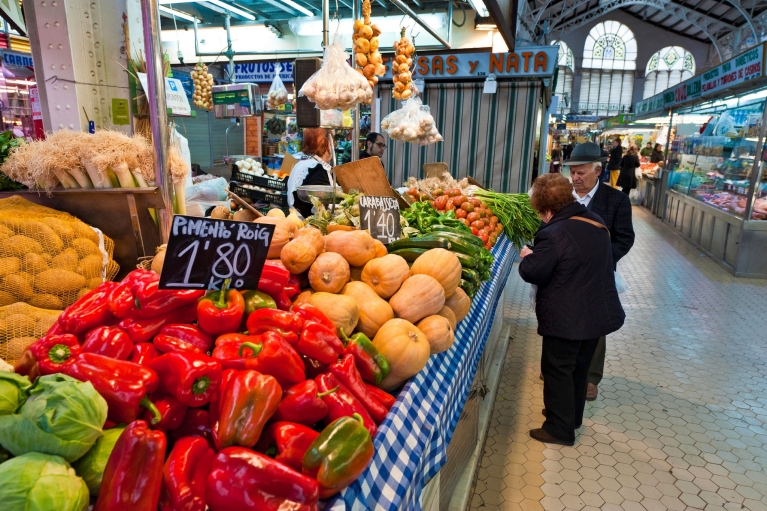
From Valencia to Madrid
Madrid, spain.
Madrid Puerta de Atocha
Spain's capital buzzes with culture and energy. There's no shortage of things to add to your Madrid itinerary! Stroll along the Art Walk and explore numerous museums, including the world-class Prado . Then check out the nearby Retiro Park (Parque del Buen Retiro). Las Ventas Bullring - the birthplace of bullfighting - will get your heart pumping. Learn the history of this controversial Spanish tradition, or watch a torero (bullfighter) in action. Fans of European football shouldn't miss a trip to the Santiago Bernabéu Stadium, home to Real Madrid.

From Madrid to Seville
Seville, spain.
Sevilla Santa Justa
Seville (Sevilla), Spain
Portuguese explorer Ferdinand Magellan began the first voyage around the world in 1519, and it all began in Seville. This city is a place for true world travelers! Home to flamenco dancing and tasty tapas, you can easily immerse yourself in Spanish life here. Start with the colorful Calle Betis , which runs along the waterfront and is lined with restaurants, bars, and clubs. The Alcázar of Seville is worth a visit, as is the large and distinctive Metropol Parasol wooden structure.
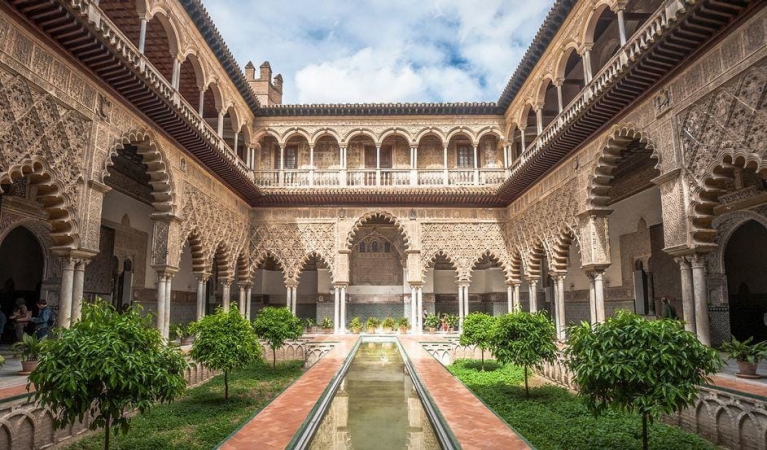
From Seville to Malaga
Malaga, spain.
Málaga-María Zambrano
Malaga (Málaga), Spain
Malaga is a stunning coastal city of sun and sand. It seamlessly combines natural beauty with a rich history and a modern skyline. The 11 th century Moorish castle of Alcazaba can be found in the middle of the city. Below lie the remains of the old Roman Theater (El Teatro Romano), which is free to visitors. After gazing in awe at the ancient ruins, fast forward to the 20 th century. Pablo Picasso was born in Malaga, so it's fitting to tour the Picasso Museum ! Then it’s time to complete your Spain trip with a visit to one of Malaga’s famous beaches .
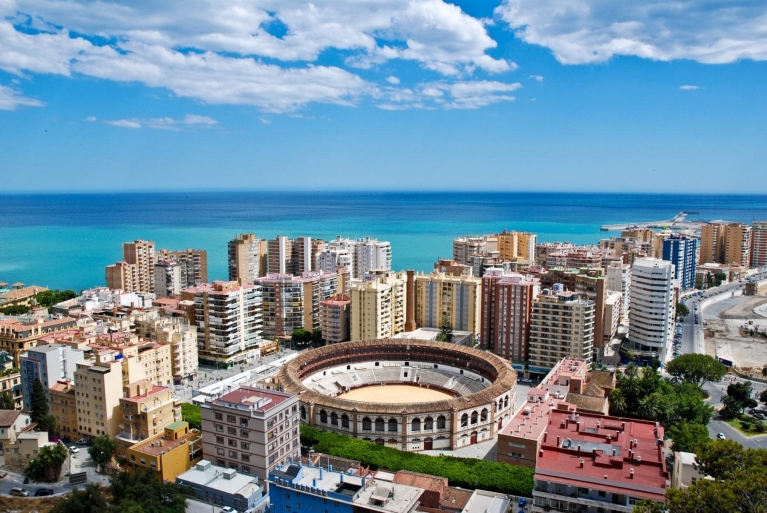
Get ready to discover Spain by train!
Change of currency.
You cannot change the currency once you have a Pass in your cart. Remove the Pass, and then change the currency on the website header.
- How To Travel Get Around...
How to Travel & Get Around in Spain

From the wild shores of the Atlantic to the azure coves of the Mediterranean , the Pyrenees to the Sierra Nevada – there is much to see in Spain . Public transport has come along in leaps and bounds in recent years, with high speed trains, internal flights and bus services being some of the easiest ways to get round.
Did you know – Culture Trip now does bookable, small-group trips? Pick from authentic, immersive Epic Trips , compact and action-packed Mini Trips and sparkling, expansive Sailing Trips .
Travelling by plane

There are over 40 airports dotted across mainland Spain and the islands, many of which have regularly scheduled external flights as well as internal flights. The largest airports are those of Madrid Barajas and Barcelona El Prat which have the most frequent flights in and out of the country.
Flying is the fastest and often cheapest way to access the Balearic Islands , Ceuta, Melilla and the Canary Islands. A flight from Barcelona to Ibiza takes just one hour, while a flight from Madrid to the Canary Islands will take around three hours. When travelling to the Canary Islands remember that the time zone changes from GMT+1 in mainland Spain to GMT+0.
Travelling by train
RENFE is Spain’s national train network which operates regular services across the country with high-speed, regular and suburban train lines. The train lines were vastly modernised in recent decades and today the system is generally efficient and reliable. Train lines also operate with neighbouring Portugal and France, although a train from Paris to Madrid will take around 10 hours, so this is not always the fastest way to get in to the country.
The best way to travel long distances in Spain is to book the high-speed train or AVE (Alta Velocidad) which run between most major cities. A train ride from Barcelona to Madrid covers some 500km (311 miles) in just 2hrs 40 minutes, while a train from Madrid to Seville takes around the same time.

There are a number of regional train companies which work in parallel with RENFE to offer suburban and local lines. In Barcelona the FGC trains (Ferrocarils de la Generalitat de Catalunya) provide regular connections to the suburbs as well as places such as the Montserrat mountain and monastery, a popular tourist site. In the Basque Country, Euskotren operates services between the San Sebastián and Bilbao to just over the border with France.
When travelling by train it’s important to buy your tickets in advance, especially for AVE trains and long distances as a seat reservation is necessary on many routes. There is also a financial incentive to book in advance, as tickets are often considerably cheaper if booked online or in the train station before the travel date. Be sure to check the calendar as bank holidays may affect regular services.
Travelling by bus
Getting the bus is one of the cheapest ways to get around Spain – although for long distances it is not always the most comfortable. It’s also one of the easiest ways to access off-the-beaten-track destinations and rural areas where there are no train lines.

There are often a huge number of routes departing from main cities and connecting to smaller towns in the surrounding countryside. These routes are popular with workers and as such there are often more services during the week than at weekends. Most cities and larger towns will have a bus station (look for the ‘ estación de autobuses ‘) from which buses depart and from where tickets can be bought in advance for certain routes. On the vast majority of buses, tickets can be bought from the driver when accessing the bus.
There are many bus companies operating across Spain, often with more than one operator in any given area. One of the easiest ways to find the right provider for you is to use a website such as movelia.es which offers services by most of the main bus companies in the country.
Travelling by car
Last but not least, hiring a car is another great way to get around in Spain as it allows you to plan your own route and follow your own pace. There is a vast network of motorways known as ‘ autovías ‘ which can be identified by an A letter at the beginning of the road number. Some of these roads are toll roads called ‘ autopistas ‘ – in which case they are identified by the letters AP – so be sure to have either a card or cash to pay for your journey.

A cheaper but slower option is to stick to the normal roads which often run parallel to the motorways but do not allow cars to drive as fast and are not always in as good condition. The speed limit on A roads and AP roads is 120km/h (75 miles/h) whereas on standard roads the speed limit is 90km/h (56 miles/h) unless otherwise indicated (and in town the speed limit is 50km/h (31 miles/h)).
Be aware that hotels in towns and cities will often charge you up to €25 per night to keep your vehicle in parking. Public parking lots are cheaper but can still be up to €15 per night depending on where you are.
¡Buen viaje!
Since you are here, we would like to share our vision for the future of travel - and the direction Culture Trip is moving in.
Culture Trip launched in 2011 with a simple yet passionate mission: to inspire people to go beyond their boundaries and experience what makes a place, its people and its culture special and meaningful — and this is still in our DNA today. We are proud that, for more than a decade, millions like you have trusted our award-winning recommendations by people who deeply understand what makes certain places and communities so special.
Increasingly we believe the world needs more meaningful, real-life connections between curious travellers keen to explore the world in a more responsible way. That is why we have intensively curated a collection of premium small-group trips as an invitation to meet and connect with new, like-minded people for once-in-a-lifetime experiences in three categories: Culture Trips, Rail Trips and Private Trips. Our Trips are suitable for both solo travelers, couples and friends who want to explore the world together.
Culture Trips are deeply immersive 5 to 16 days itineraries, that combine authentic local experiences, exciting activities and 4-5* accommodation to look forward to at the end of each day. Our Rail Trips are our most planet-friendly itineraries that invite you to take the scenic route, relax whilst getting under the skin of a destination. Our Private Trips are fully tailored itineraries, curated by our Travel Experts specifically for you, your friends or your family.
We know that many of you worry about the environmental impact of travel and are looking for ways of expanding horizons in ways that do minimal harm - and may even bring benefits. We are committed to go as far as possible in curating our trips with care for the planet. That is why all of our trips are flightless in destination, fully carbon offset - and we have ambitious plans to be net zero in the very near future.

Guides & Tips
Reasons why you should visit la rioja, spain.

Places to Stay
The best hotels to book in catalonia.

The Most Beautiful Train Stations in the World

The Best Private Trips to Book for a Foodie Adventure

The Best Hotels to Book in Salou, Catalonia

Top Tips for Travelling in Spain

The Best Places to Travel in June

Reasons Why You Should Visit Andalucia, Spain

See & Do
Getting a taste of picasso in malaga.

The Most Unique Temples and Churches in the World

Bars & Cafes
The best wine bars in la rioja, spain.

The Best Private Trips to Book for Your Spanish Class
Culture trip spring sale, save up to $1,100 on our unique small-group trips limited spots..

- Post ID: 1475587
- Sponsored? No
- View Payload
- Skip to primary navigation
- Skip to main content
- Skip to primary sidebar
Tall Girl Big World
Germany & Europe Travel
- Switzerland
- Massachusetts
- North Carolina
- Puerto Rico
- Washington DC
Southern Spain 2-Week Itinerary: A Road Trip Through Andalucía
Created On: August 7, 2022 | Updated: January 27, 2023 | 5 Comments
Planning a trip to Andalucía? This southern Spain 2-week itinerary will take you through the best cities and towns in Andalucía. Even better, you can get to all the places via train if you don’t want to rent a car!
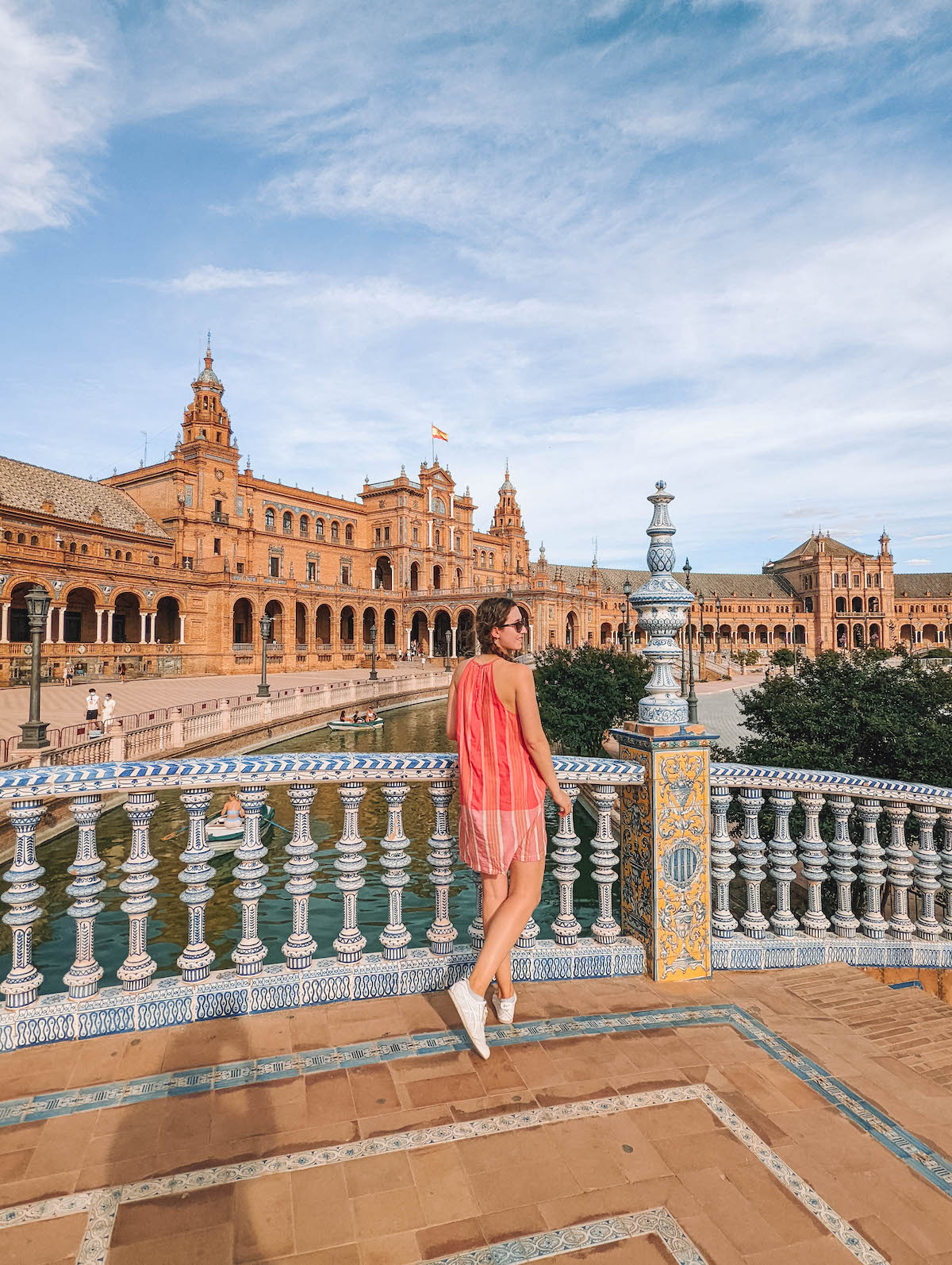
Madrid and Barcelona may be the best known cities in Spain, but my heart belongs in Andalucía!
After the Muslims invaded Spain in 711 AD, they called the southernmost part of the country “Al-Andalus.” Near the end of Reconquista — a war between the Christians and the Muslims to gain total control of Spain that spanned seven centuries — Al-Andalus was the last remaining portion of the country that still belonged to the Muslims.
The centuries spent under Muslim rule has imbued the entirety of present day Andalucía with a unique culture you won’t find elsewhere. In each city of Andalucía, you’ll find mosques-turned-churches, stunning Mudejar architecture, and a cuisine that combines ingredients and flavors from both cultures.
While you could plan a 2-week trip to Spain anywhere you’d like, I highly recommend spending your time exploring Andalucía. 2 weeks in southern Spain will give you a taste of Spanish culture as a whole while offering a more nuanced experience wholly unique to Andalucía.
Below is a Spain itinerary for 14 days. I’ve gone into as much detail as possible about what to do in Andalucía, but you’ll notice that I’ve included links to my detailed city guides as well — otherwise this blog post will turn into an e-book!
How Many Days Do You Need in Spain?
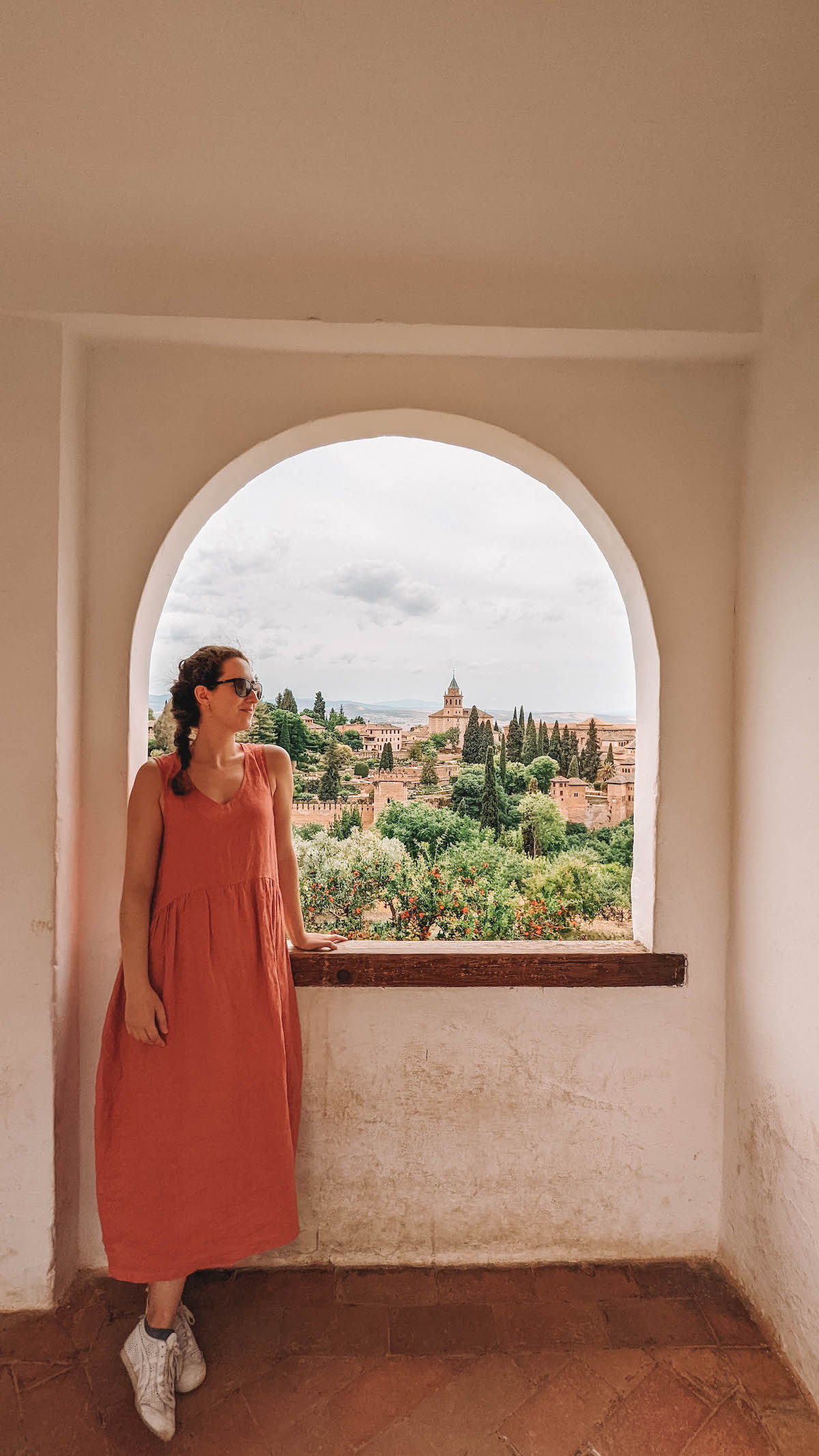
In a perfect world, we’d all be able to spend 3+ months in Spain to fully immerse ourselves in the culture and see the main sights. However, that’s not how life works and I know your vacation time is limited.
2 weeks in Spain is just enough time to see three to six cities and towns — the exact number depends on how many activities you pack into your days and the size of cities you visit. (This itinerary comfortably fits five major cities in Southern Spain!)
I’ll focus solely on the main cities in Andalucía in this itinerary. I’m of the opinion that it’s better to focus on one specific area rather than waste time traveling from one end of the country to another just to see the big cities.
You could of course adjust this itinerary to spend just one week in Spain if that’s all the time you have. If that’s the case, I think your best call would be to visit Seville and Granada if you’ve never been to either!
What’s the Best Time to Visit Spain?
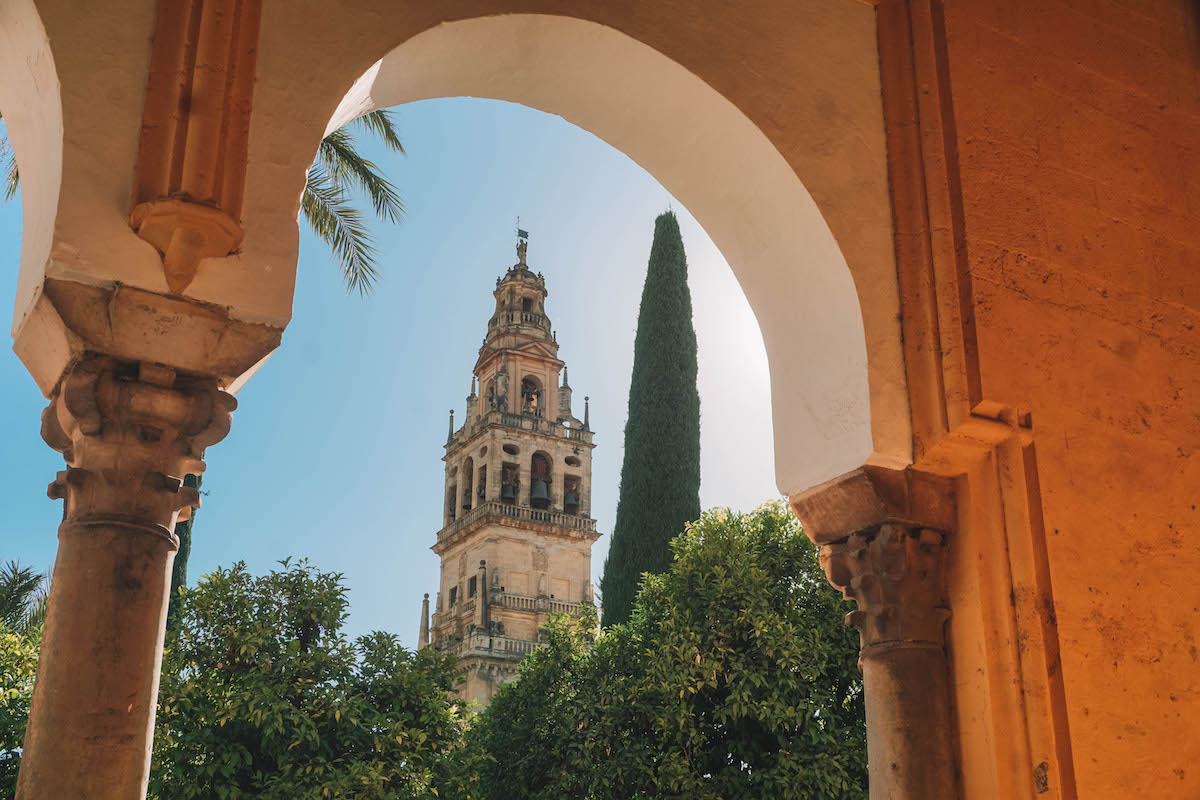
I recommend planning a trip to Andalucía during shoulder season (March / April or September through November) . I visited southern Spain at the end of May, thinking I’d beat the worst of the crowds and would experience cooler temperatures. Wrong! It was 90ºF+ most days and major attractions, like the Alhambra in Granada, were packed with people.
The next time I visit Spain, I plan on going in the early spring!
Overview of This Spain 2-Week Itinerary
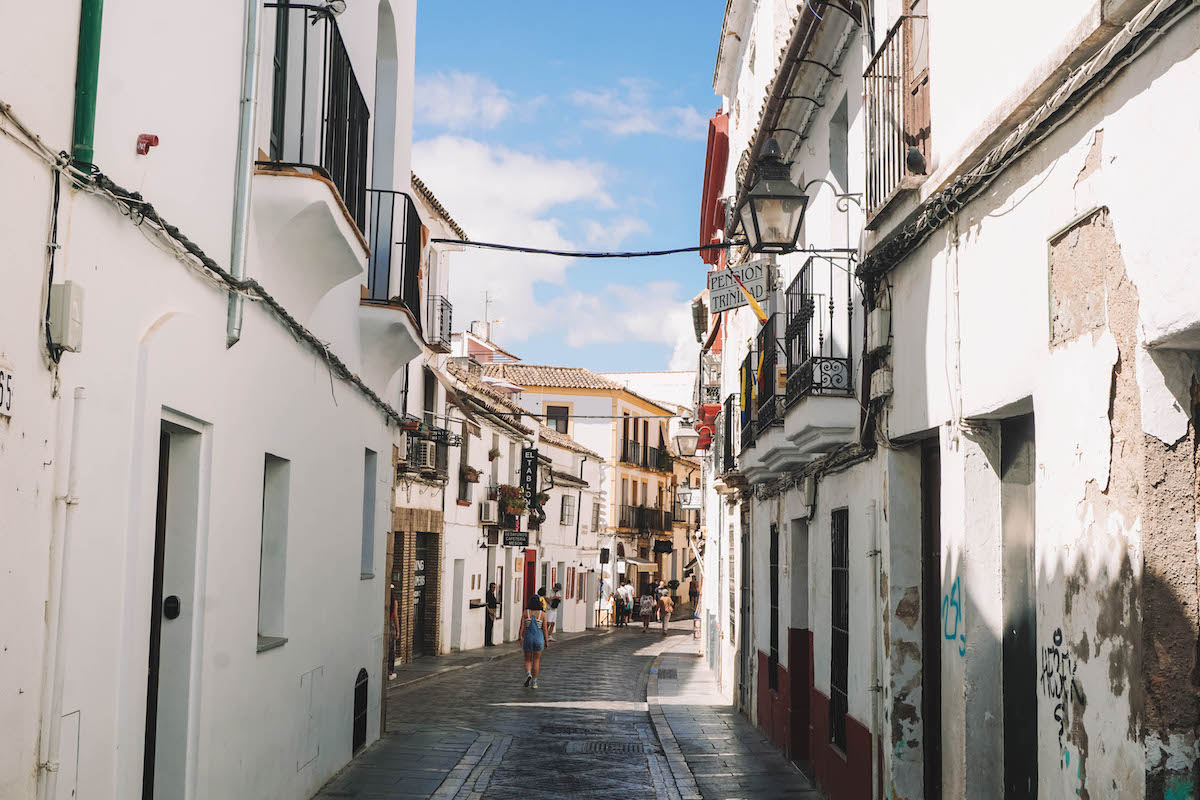
You’ll note that I didn’t include Barcelona or Madrid in this southern Spain 2-week itinerary. You can OF COURSE visit one or both of these cities, but I prefer to travel a little slower these days. If I’m going to go to Barcelona or Madrid, I’d rather have at least 5 full days in each place — which would have eaten into most of my 2-week trip to Spain!
So know that there are no itinerary police holding you accountable. Travel wherever you want, but I think this is the best 2-week Spain itinerary for those of you (like me!) who want to visit lots of different cities and see a variety of sights without having to run yourself into the ground each day.
All that being said, here’s an overview of this 2-week Andalucía itinerary:
- Days 1 – 3: Málaga
- Days 4 – 6: Granada
- Days 7 – 8: Córdoba
- Days: 9 – 10: Ronda
- Days 11 – 13: Seville
Day 14 has been left blank to account for travel between cities. It’s better to have a little wiggle room in case your arriving flight is delayed, you miss your train, etc.
Where Should You Start and End a 2-Week Trip to Spain?
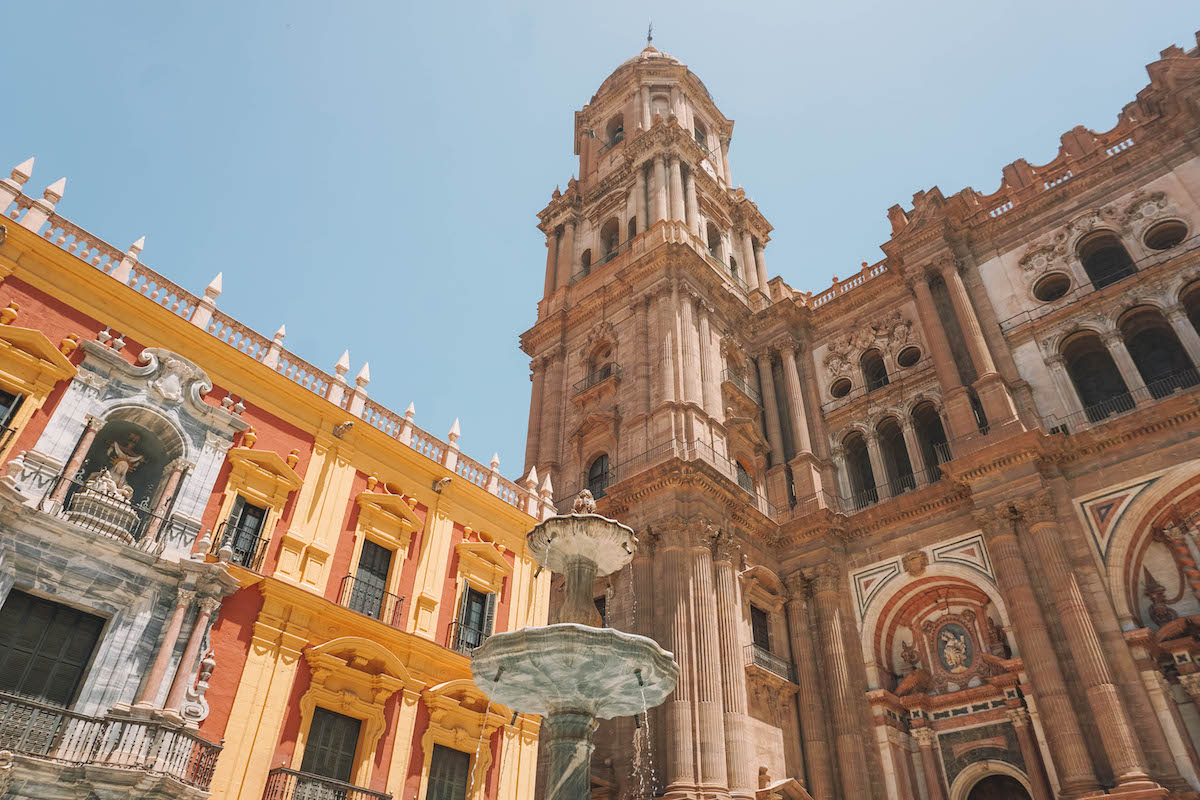
This southern Spain 2-week itinerary begins in Málaga and ends in Seville. You could also flip flop the itinerary if you find better flight prices flying into one city versus the other.
Or, you may find it easier and cheaper to fly into Madrid and then drive or take the train to Málaga to start your 14 days in Spain. That will obviously add on time and eat into your trip, but sometimes needs must!
Car, Bus, or Train? How to Get Around Southern Spain
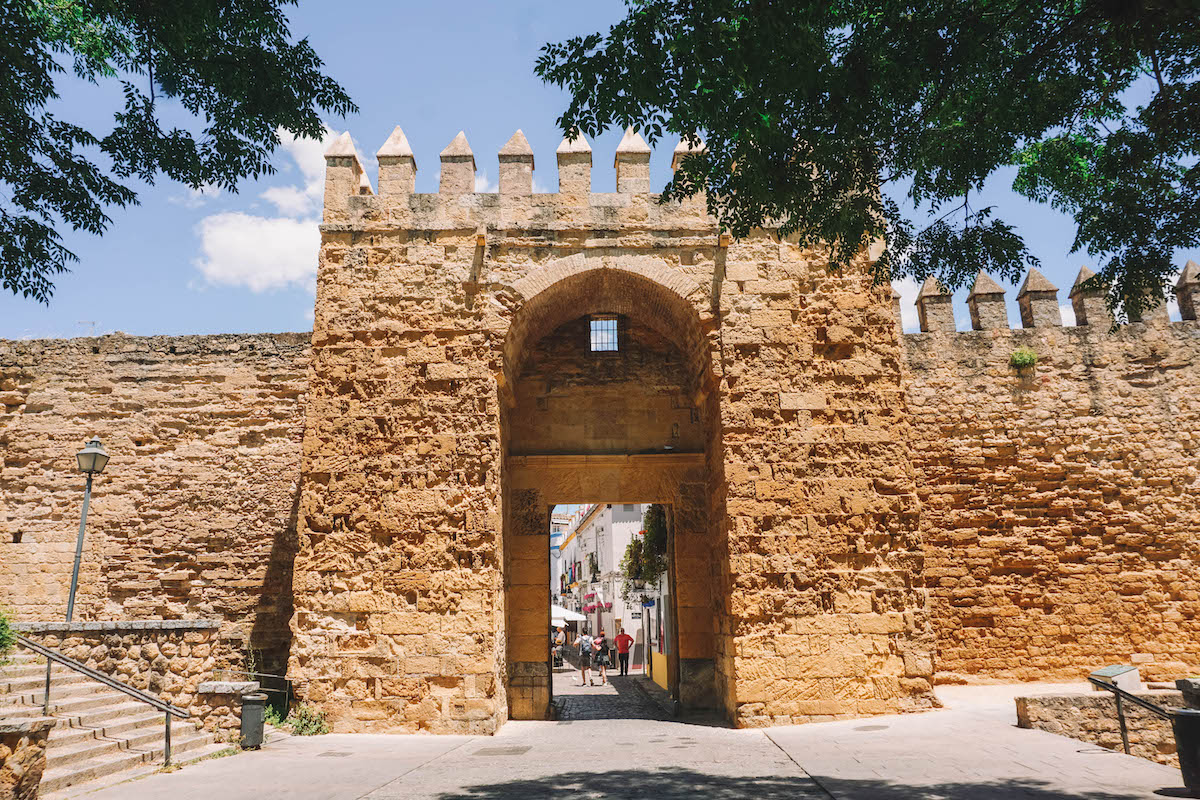
Most itineraries I referenced for planning 2 weeks in Spain suggested renting a car to traverse Andalucía. They said it was easier and quicker to do so, but I had zero desire to spend extra money on a rental car, nor did I want to deal with parking in foreign cities on my own.
I was worried that taking a train around southern Spain would prove confusing or time-consuming, but it was actually so incredibly easy and affordable!
From my personal experience, I can assure you that this 2-week Spain itinerary can absolutely be done by train! The longest train journey is just under 3 hours, and it will be at the end of your trip.
Note that many of the trains leave either first thing in the morning or in the late afternoon. I recommend boarding the morning trains (none require you to get up ridiculously early, don’t worry!).
Also, you should plan to arrive at the train stations 20 to 30 minutes before departure. In Spain, you’re required to go through a quick security check before boarding your train. They’ll X-Ray your suitcase and check your ticket, and then you’re off!
Lastly, please note that I walked from the central train stations to each of my hotels and AirBNBs. So know that the train stations of each city listed in this 2-week Andalucía itinerary are very close to the city centers!
Best Way to Book Train Tickets in Spain
The Renfe website (i.e. the Spanish railway’s official website) is an absolute nightmare to use. Every time I tried to book a ticket, the site crashed.
Save yourself a major headache and book your train tickets through a third-party provider like Omio . I did manage to book a couple tickets through Renfe after much hair-pulling, as I noticed that Renfe sometimes had additional train times listed that weren’t shown on the Omio site. So check both sites, but book through Omio if possible.
Of course, you can also wait to book your tickets in person at the train stations. There are ticket machines everywhere and they’re easy to use. The prices may be more expensive day-of, but it would give you the flexibility to alter your itinerary if that’s important to you.
Southern Spain 2-Week Itinerary
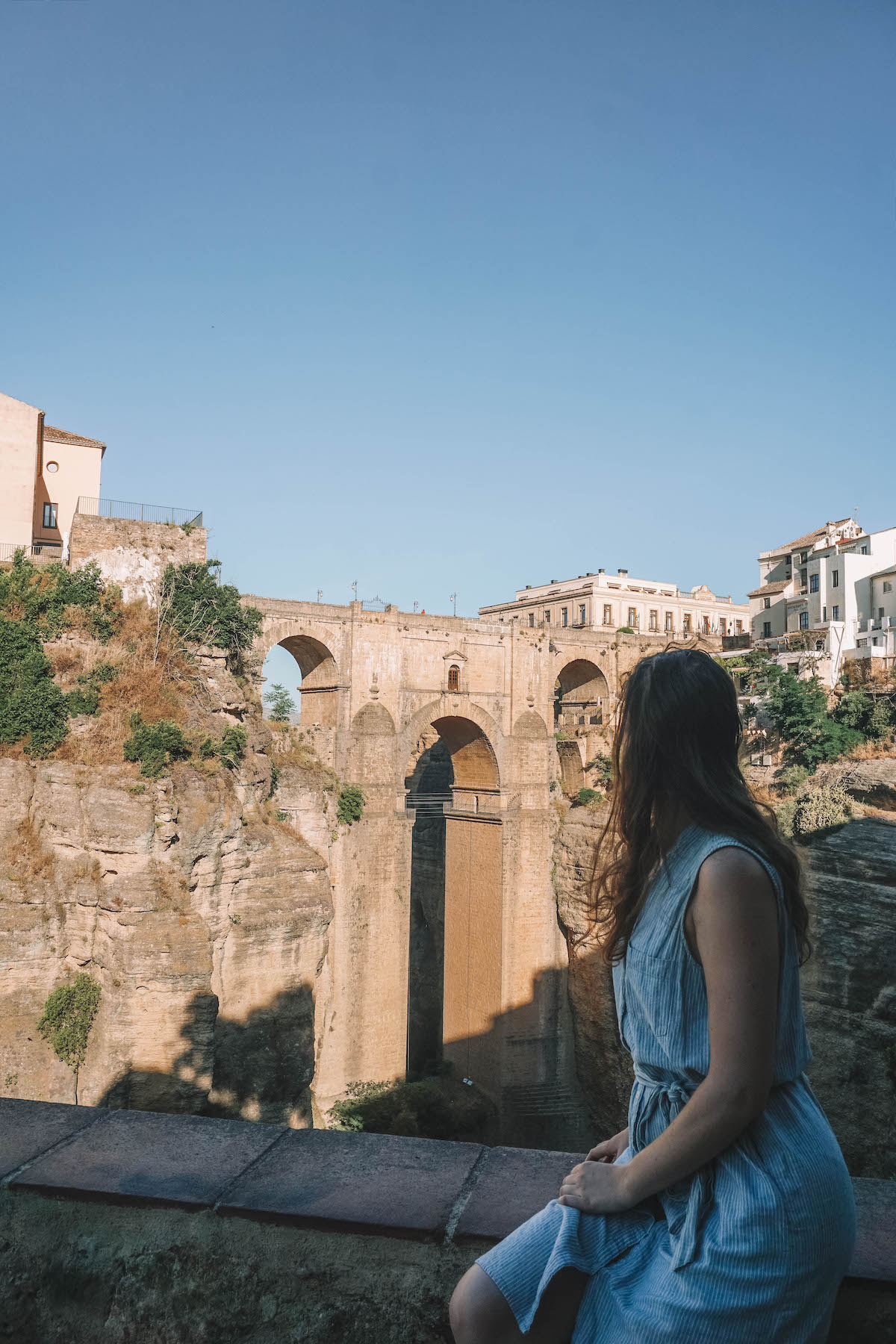
I’ve already given quite a few tips for making the most of your 2 weeks in Southern Spain, but here are a few quick reminders before I FINALLY dive into the full itinerary.
First and foremost, you can get to all of the cities mentioned on this itinerary via train. No need to rent a car!
Second, you can mix and match this itinerary as you see fit.
Thirdly, I’ve given broad overviews of each day’s activities but have linked to my ultra detailed city guides in each portion of the itinerary. Read those posts for more information on the individual attractions. I wanted this itinerary to be, well, an itinerary (i.e. a broad overview of how to plan a 2-week trip to Spain).
Spain Itinerary Days 1 – 3: Málaga
One of the gems of southern Spain, Málaga is a gorgeous port city that boasts one of the biggest and best preserved Old Towns I’ve had the pleasure of visiting. Málaga is also the birthplace of Pablo Picasso and Antonio Banderas, and the locals are very proud of their famous sons!
Of all the places in Andalucía, Málaga is one of the better ones for understanding how the Romans, Muslims, and Catholics shaped the region’s culture. The absolute top attractions in Málaga are undoubtedly the beautiful cathedral, the Alcazaba, and Gibralfaro Castle.
Below is a bulleted itinerary for 3 days in Málaga, but you can read LOTS more about the specific attractions in my full Málaga city guide .
Day 1 in Malaga
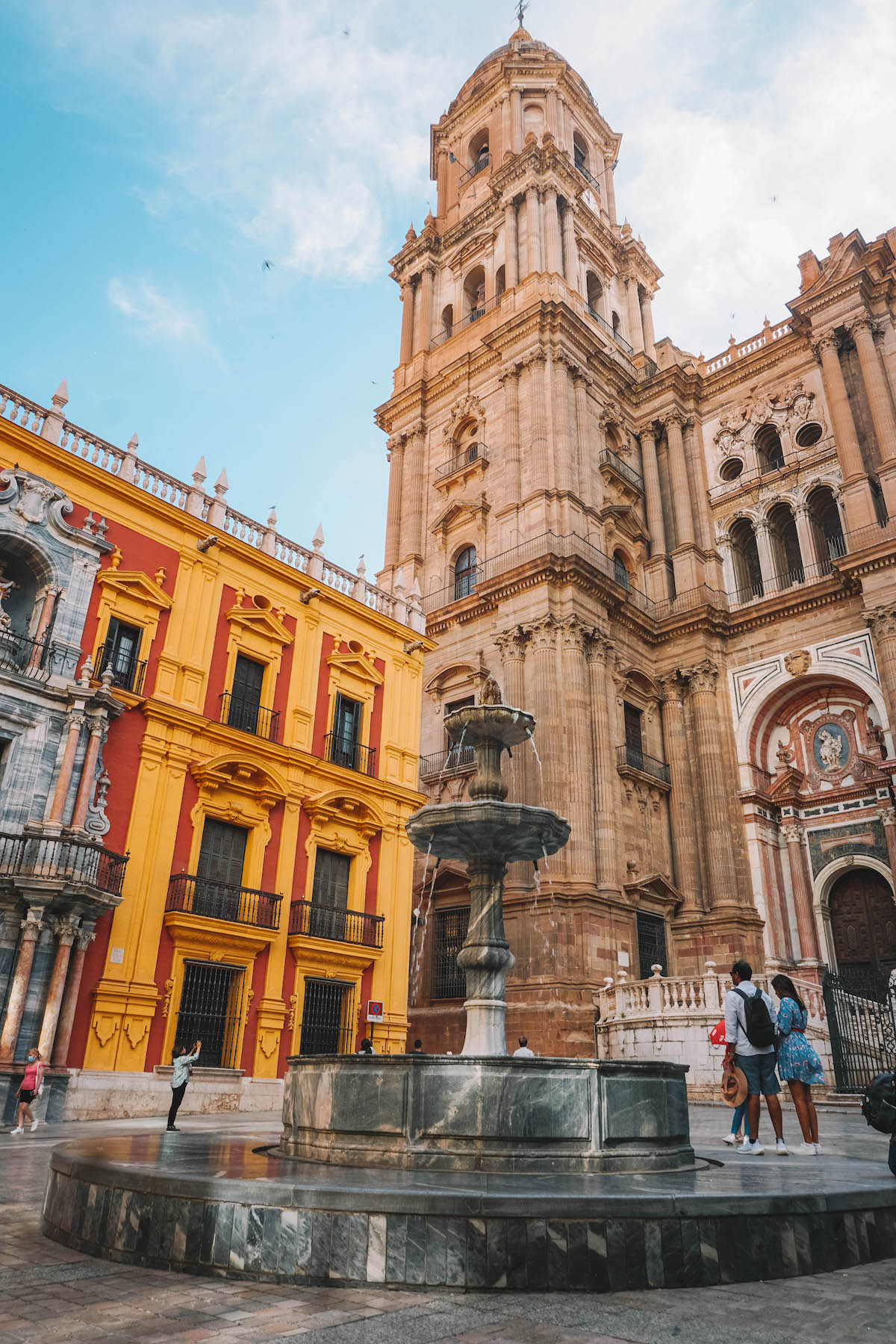
Free walking tour — Malaga Adventures has a detailed 3-hour, free walking tour of the city center. This is the best way to learn about the history of the city, plus it gives you a chance to ask a local for restaurant and activity recommendations!
Cathedral and rooftop (shown above) — Nicknamed La Manquita (little lady with one arm), Málaga’s cathedral took more than 200 years to get to its current state … and it was never finished! It’s one of the most stunning cathedrals I’ve visited, and I highly recommend paying extra to climb to the rooftop for an unparalleled view of both the unfinished cathedral and the city center.
Malaga Museum — Housed in what was originally the city’s customs house, the Malaga Museum is a small but impressive museum that boasts a variety of art and artifacts meant to give visitors a closer look into the city’s past.
Explore the Old Town — After packing your brain with key historic facts, enjoy window shopping getting lost in the Old Town! Calle Marqués de Larios is one of the most expensive shopping streets in all of Spain, and there are many more side streets to discover.
Day 2 in Malaga
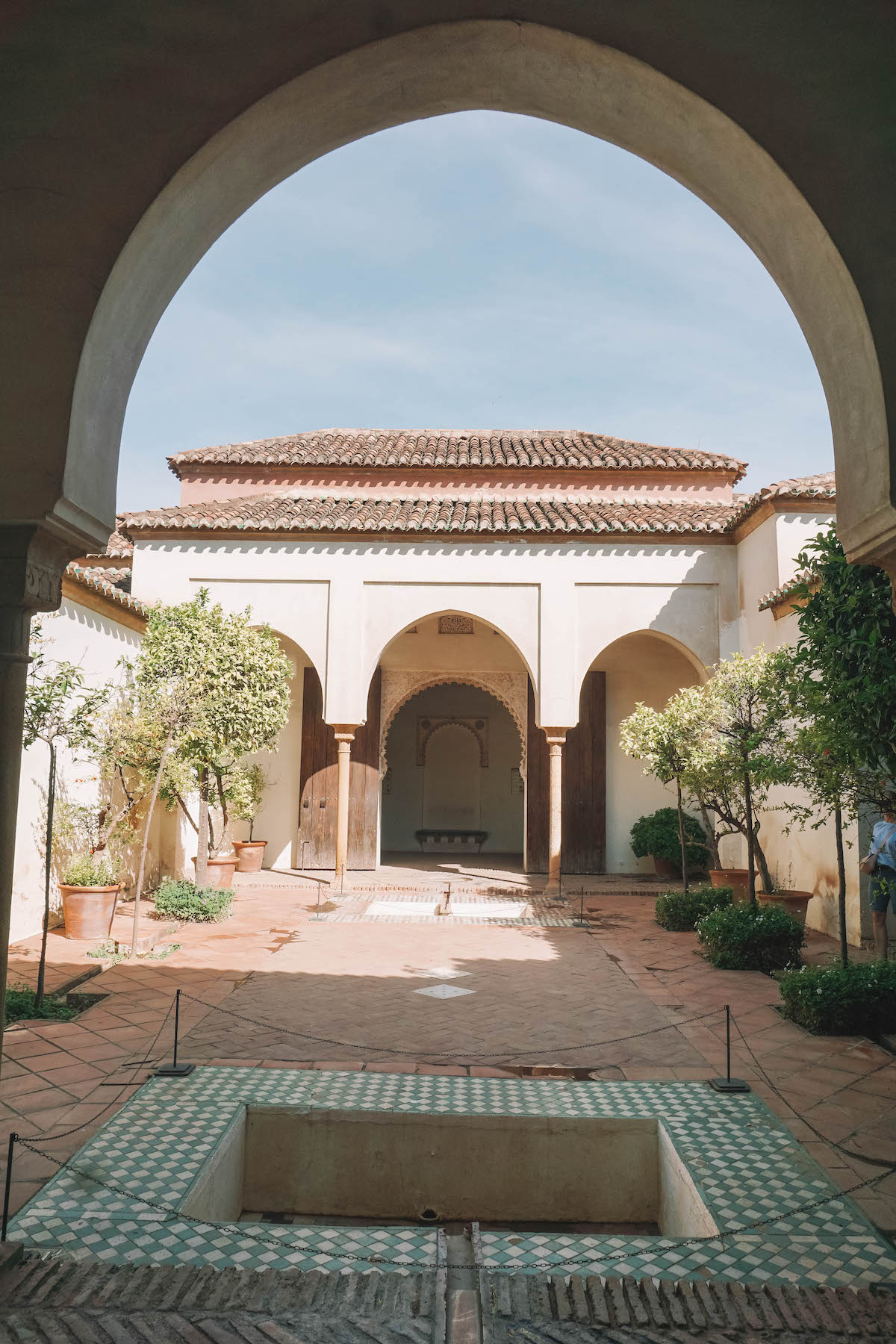
Alcazaba (shown above) — A former Muslim fortress that was built in the 11th century as a means of defending the port. The interior of the fortress has lots of hidden gardens and babbling fountains, and is a surprisingly peaceful place to visit.
Roman Theater — Built by the Romans in the 1st Century BCE, the Roman Theater is now in ruins. The city has built platforms over the ruins so you can walk directly over them and get a sense of how the theater must have operated in its heyday.
Gibralfaro Castle — Gibralfaro Castle was built in the 1300s to improve the city’s defenses. Like the Alcazaba, the castle was built by the Muslims. The views from the castle’s parapets are absolutely stunning!
Picasso Museum — The perfect place to escape the afternoon heat! Picasso was born in Málaga, and this museum owns more than 230 of his works of art. If Picasso doesn’t pique your interest, I can also highly recommend the Carmen Thyssen Museum as an alternative.
Day 3 in Malaga
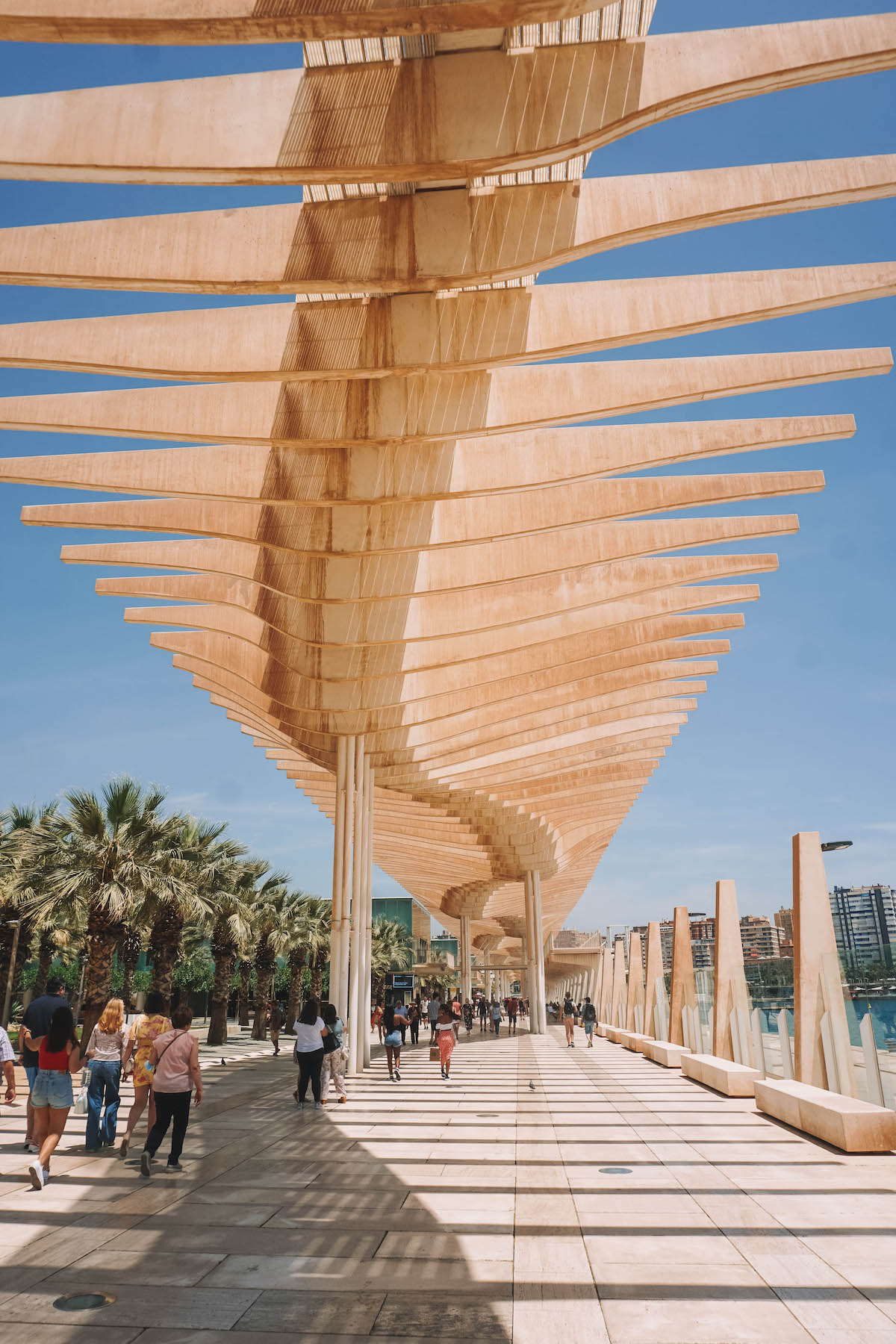
Muelle Uno (shown above)— A section of the port of Málaga that’s been transformed into an open-air shopping and dining center.
Playa de la Malagueta – The local beach! It can become crowded in the summer, so arrive early to claim a spot. You can spend the morning here, or the entire day. OR enjoy a walk along the sand before continuing with the attractions below.
Mercado Central de Atarazanas — A covered market in the city center with vendors selling fresh produce, seafood and meats, dried fruits, and almonds. Grab some fresh fruit, almonds, and other nibbles here to take with you to the gardens!
La Concepcion Botanical Gardens — An underrated Málaga attraction! The gardens are located on the historic La Concepcion. After touring the various gardens, I recommend finding a spot in the shade to enjoy your snacks from the market and maybe read a book or call home, if desired.
Spain Itinerary Days 4 – 6: Granada
Granada was ruled by the Muslims for centuries and was the last city in Spain to fall back into the hands of the Catholic monarchy in 1492. Granada is home to one of the top tourist attractions in all of Spain: the Alhambra.
Many people visit Granada as a day trip from Seville or Málaga, but I don’t recommend doing that as there’s SO much more to do and see than simply tour the Alhambra.
Below you’ll find an itinerary for 3 days in Granada. For more details on the individual attractions listed below, check out my full Granda city guide .
Day 1 in Granada
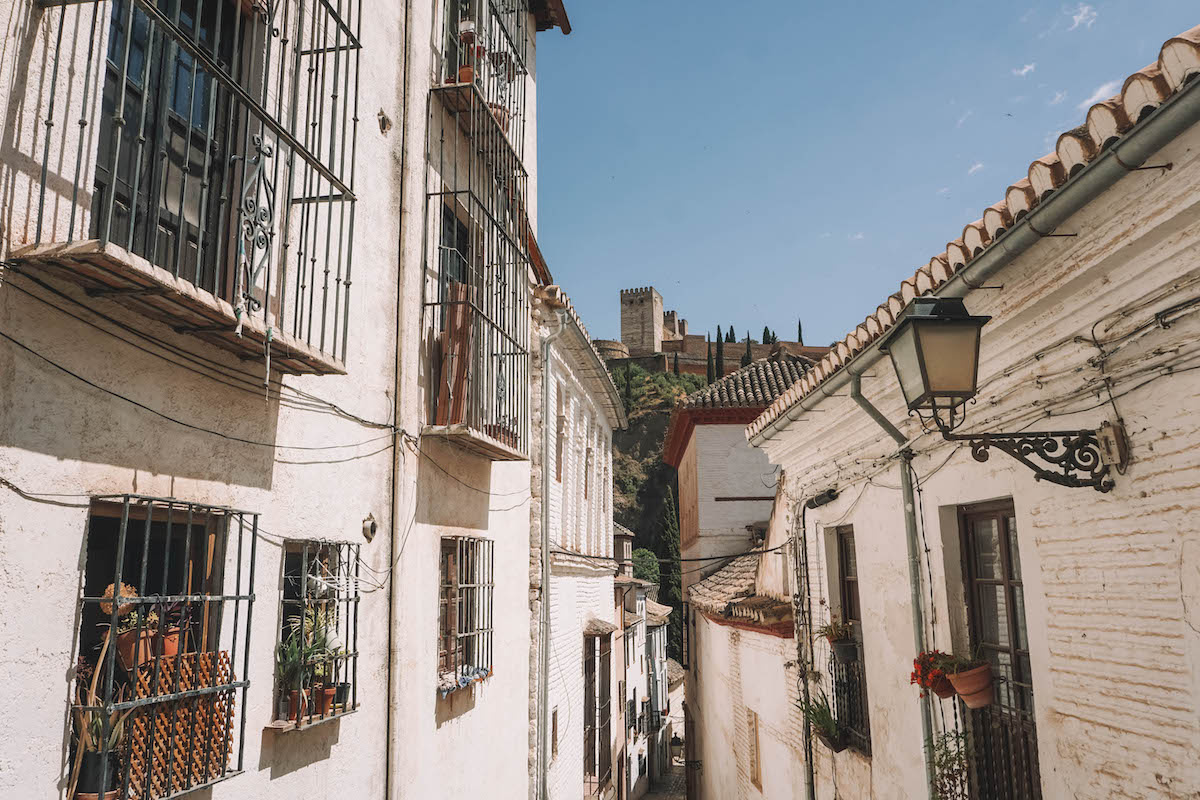
Cathedral — Built on the site of the Great Mosque following the Catholic reconquest of Spain. The cathedral contains a unique blend of architectural styles, but it was built mostly in the style of the Spanish Renaissance.
Guided walking tour — Granada has a long history, which you won’t learn about simply by visiting the main tourist attractions. Walk in Granada offers a more traditional pay-what-you-want walking tour, as well as a walking tour of Albaicin and Sacromonte. Choose whichever interests you more!
Sacromonte / Albaicín (shown above) — The “Old Town” areas of Granada directly facing the Alhambra. They’re mostly residential, but there are many white-washed alleyways to meander through as well as scenic overlooks ( Miradors ) offering up spectacular views of the city.
Bañuelo — An 11th century Arabic hammam (bath house) that’s been beautifully preserved.
Sunset — Most itineraries say to watch the sunset from Mirador San Nicolas, but it fills up quickly and is noisy and crowded. Instead, watch the sunset from Mirador de la Vereda de Enmedio, Mirador Placeta de Carvajales, or Mirador Sacromonte.
Day 2 in Granada
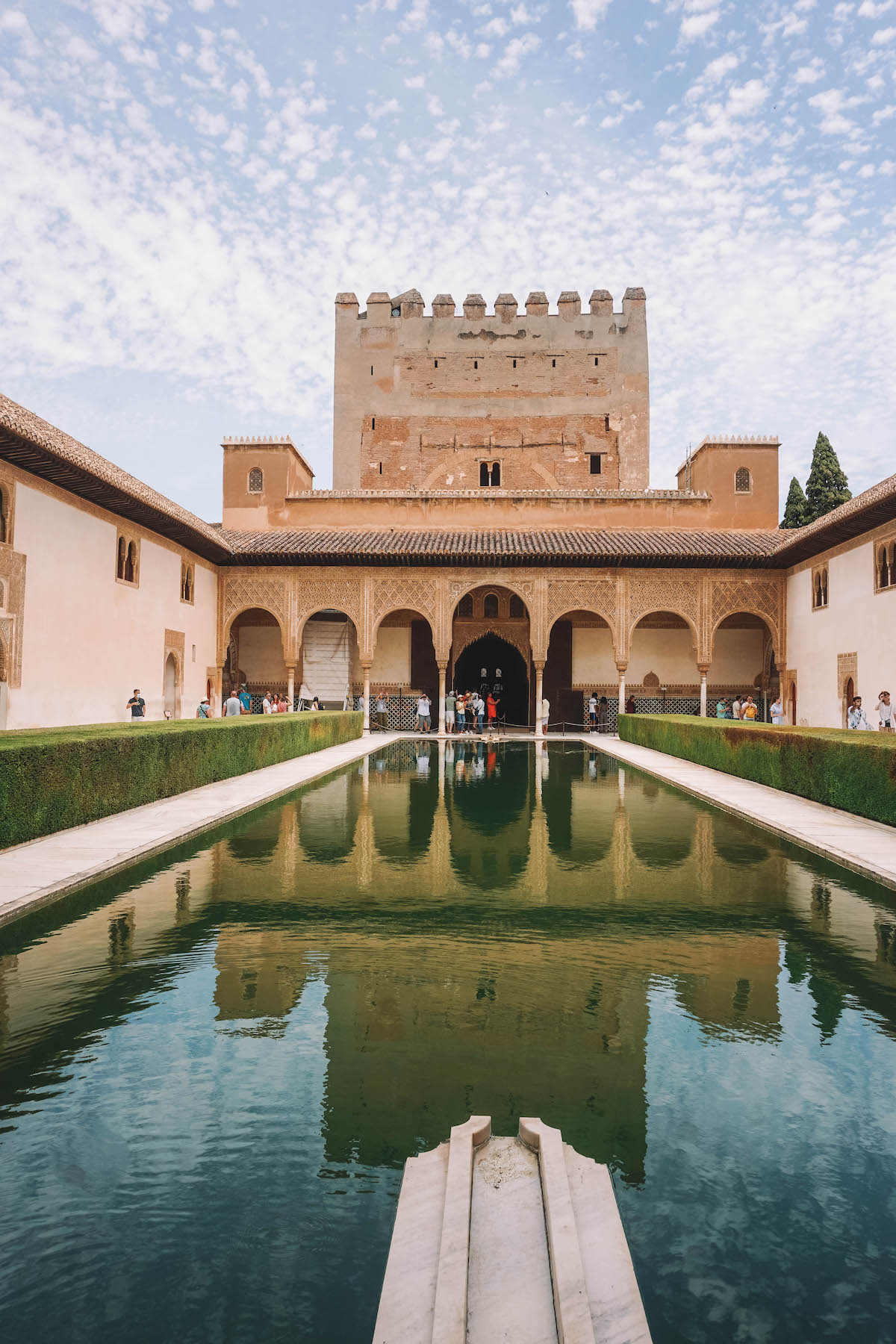
Alhambra (shown above)— The top attraction in Granada! It’s a massive complex that was originally built in the 9th century as a military fortress, but it was expanded upon over the centuries to also serve as the royal residence.
Rest! — Even if you visit first thing in the morning, you’ll be wiped after walking for hours around the Alhambra complex in the sunshine. Schedule a rest period into your day to ensure you don’t become overheated. (Seriously, please do this! Even if it’s just relaxing at a cafe for an hour with a cold drink.)
Window shop and explore some more — Popular shopping streets include the Reyes Catolicos, Carrera del Darro, and Calle Calderería Nueva. If you’re up for a little adventure, try to find a local convent or monastery selling sweets! (Check out my full Granada guide linked above for info on where I bought my convent cookies.)
Flamenco show — You can’t leave Granada without attending an authentic flamenco show in the caves of Sacromonte! The local style of flamenco is called Zambra, and the entire performance is absolutely electrifying.
Day 3 in Granada
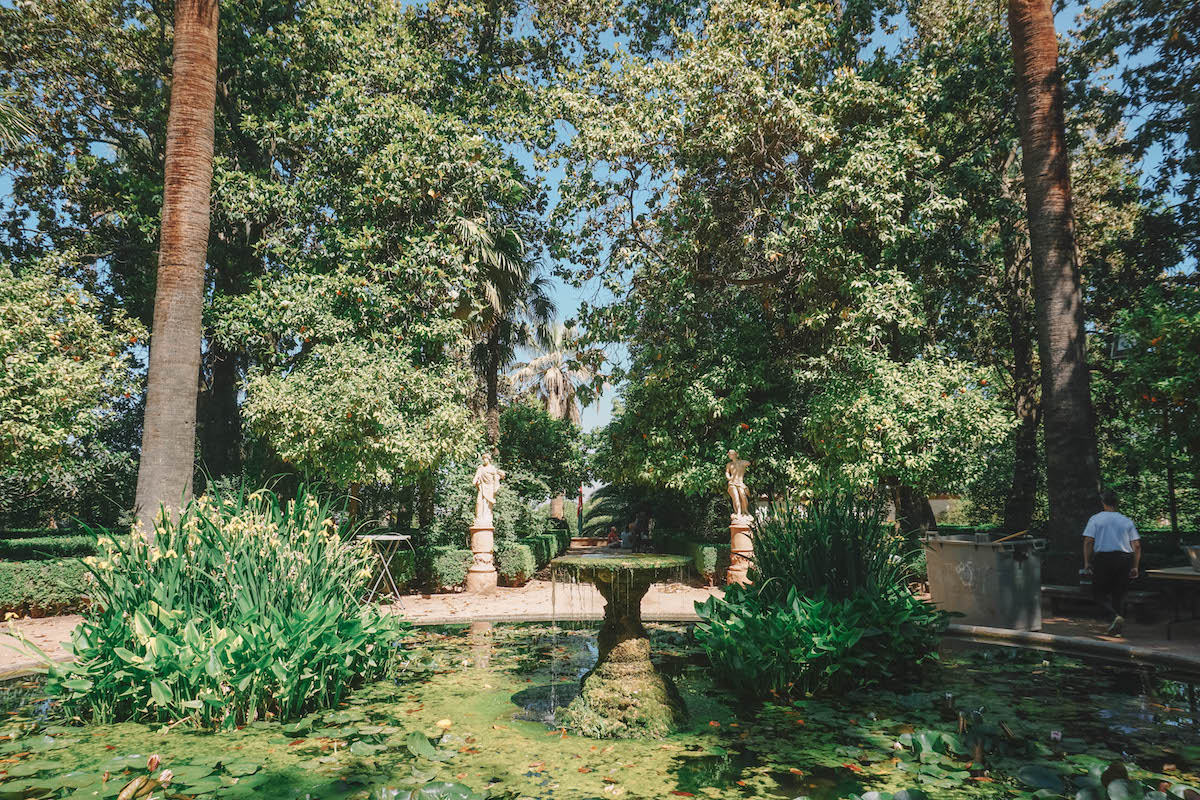
Carmen de los Mártires (shown above) — A stunning 19th century mansion with a sprawling park and garden complex.
San Jeronimo Monastery —The first monastery to be built in Granada after the reconquest of Spain by the Catholic monarchy.
Monasterio de Nuestra Señora de la Asunción (“La Cartuja”) — A lavishly decorated Spanish Baroque church atop a hill just outside the city center. Emphasis on “lavishly decorated.” This place is insanely beautiful! If you don’t have the time or desire to visit both monasteries on today’s itinerary, pick this one over San Jeronimo.
Spain Itinerary Days 7 – 8: Córdoba
Córdoba was formerly the capital of Islamic Spain and was also once the largest and most advanced city in all of Europe. Today Córdoba is best known for its Mosque-Cathedral, “La Mezquita,” which integrated the original mosque architecture with the Christian cathedral built on the site.
There are enough attractions in Córdoba to fill two leisurely days of adventuring, but one full day will also give you enough time to see the main sights. If you want to alter this itinerary for 2 weeks in Southern Spain, this is one place you could do it.
For more information on the Córdoba attractions listed below, check out my full Córdoba city guide.
Day 1 in Córdoba

Mosque-Cathedral ( Mezquita ) — A former Islamic mosque that was converted into a Catholic cathedral in the 13th century. The original mosque architecture has been integrated into the cathedral, rather than destroyed and built over.
Flower Street — A quaint white-washed alleyway near the Mezquita lined with bright blue flower pots. A great photo opp!
Roman Bridge (+ Calahorra Tower, if desired) — The Puente Romano was first built in the 1st century by the Romans. The view from the opposite bank makes for a great photo! Calahorra Toweris a fortified gate along the bridge that now houses the Museo Vivo de Al-Andalus.
Alcazar of the Catholic Monarchs — A fortress that also served as a palace. It’s where the Catholic monarchs Ferdinand and Isabella lived for eight years during the Reconquista. The interior of the fortress isn’t anything to write home about, but the gardens are beautiful!
Almodóvar Gate — One of only three remaining medieval city gates. Walk through the gate to reach the former Jewish Quarter, where there are lots of shops and restaurants.
Day 2 in Córdoba
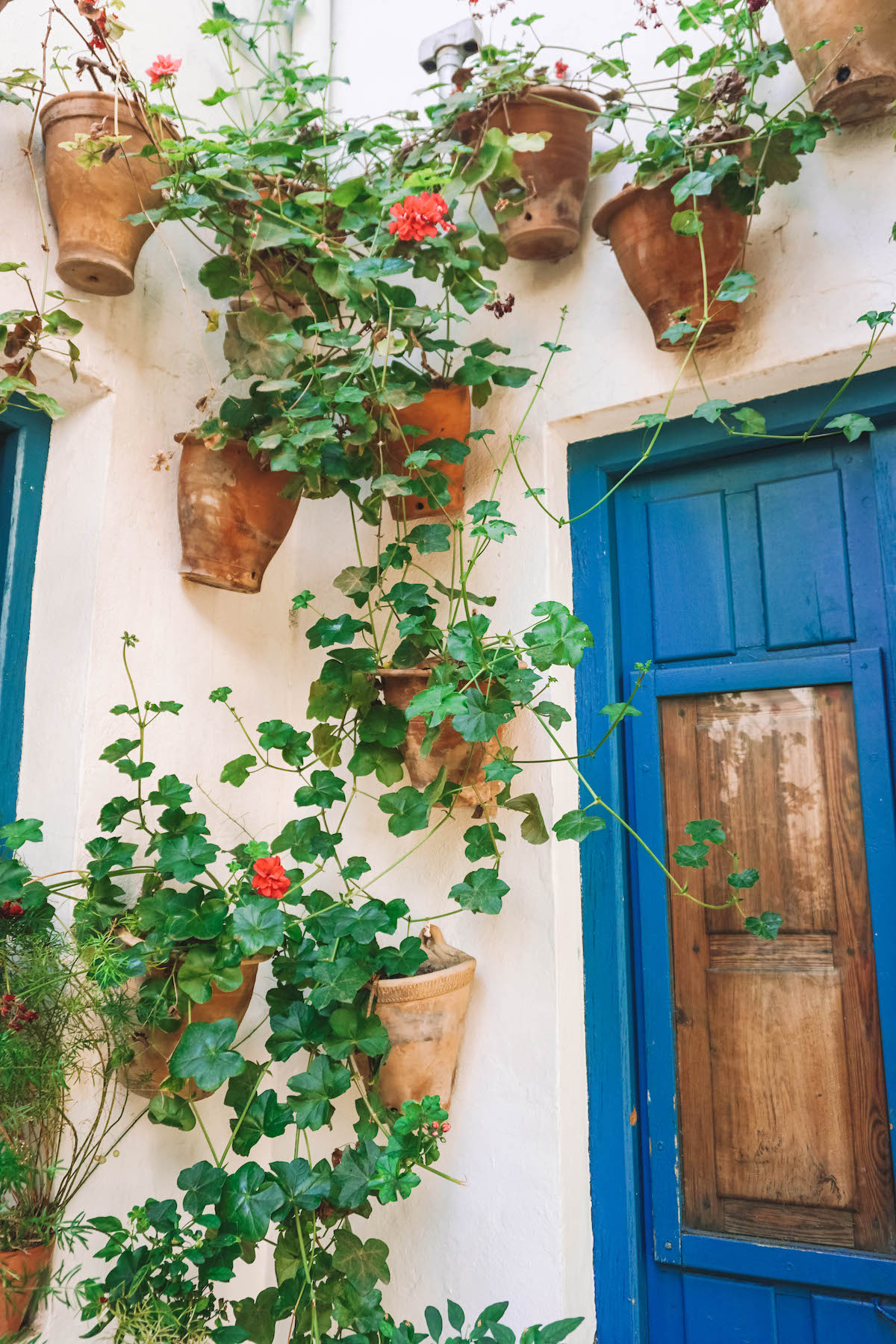
Palacio de Viana (shown above)— A 15th century palace with 12 stunning patios (the lush inner courtyards that Córdoba is known for!).
Templo Romano — Ruins of what was once the largest Roman temple in the city.
Plaza de las Tendillas — Nearby square with a fountain and pretty cafes.
Window shopping in the Old Town b— Return to the Old Town to shop, grab a drink, or enjoy an afternoon siesta back at your hotel.
Plaza de Corredera — A residential square with bars and cafes at street level. It’s fairly quiet during the daytime, but at night it’s packed with locals all chatting over their drinks. This is a relaxed, family-friendly spot, not a party destination!
Spain Itinerary Days 9 – 10: Ronda
Ronda is one of the prettiest towns in all of Spain! The Old Town is set high above the El Tajo Gorge and connects to the modern part of the town via the 322-high Puente Nuevo bridge. This was one of Ernest Hemingway’s favorite haunts, and the town’s iconic bridge is said to have inspired scenes in his novel, For Whom the Bell Tolls.
Like Córdoba, you could get away with one full day in Ronda if there are other cities you’re dying to pack into your 2 week-trip to Andalucía. However, my two days in Ronda were some of the most magical of my entire 2 weeks in Spain! The town’s small size makes it perfect to explore at your leisure.
For lots more detail on the Ronda attractions I’ve shared below, read my full guide to Ronda .
Day 1 in Ronda
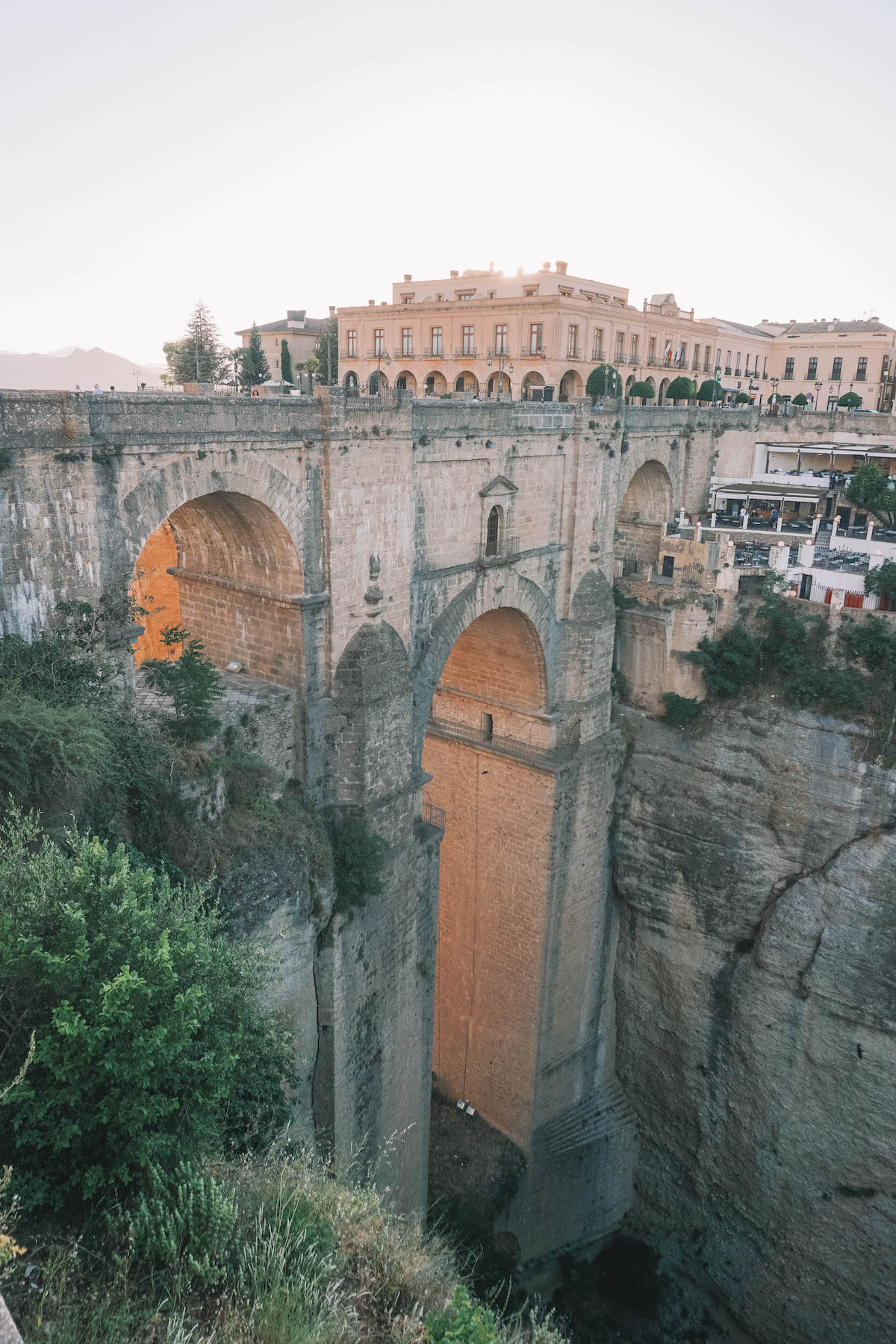
Bullring — The oldest and largest in all of Spain.
Mirador de Ronda overlook (shown above, right) — Near the bullring. It’s a gorgeous vista with views of the surrounding countryside.
Puente Nuevo (shown above, left) — The main attraction of Ronda. Words can’t describe how beautiful this bridge is! (In my full guide linked above, I’ve also shared my favorite spots to photograph the bridge.)
Murallas de la Cijara (old city walls) — The best preserved section of the old city walls is near the Puerta de la Cijara.
Arab baths — 13th century Arab baths that have been lovingly preserved and restored.
Walking tour — End your first day in Ronda with a guided walking tour of the Old Town. The tourism board offers a 90-minute tour that I highly recommend!
Day 2 in Ronda
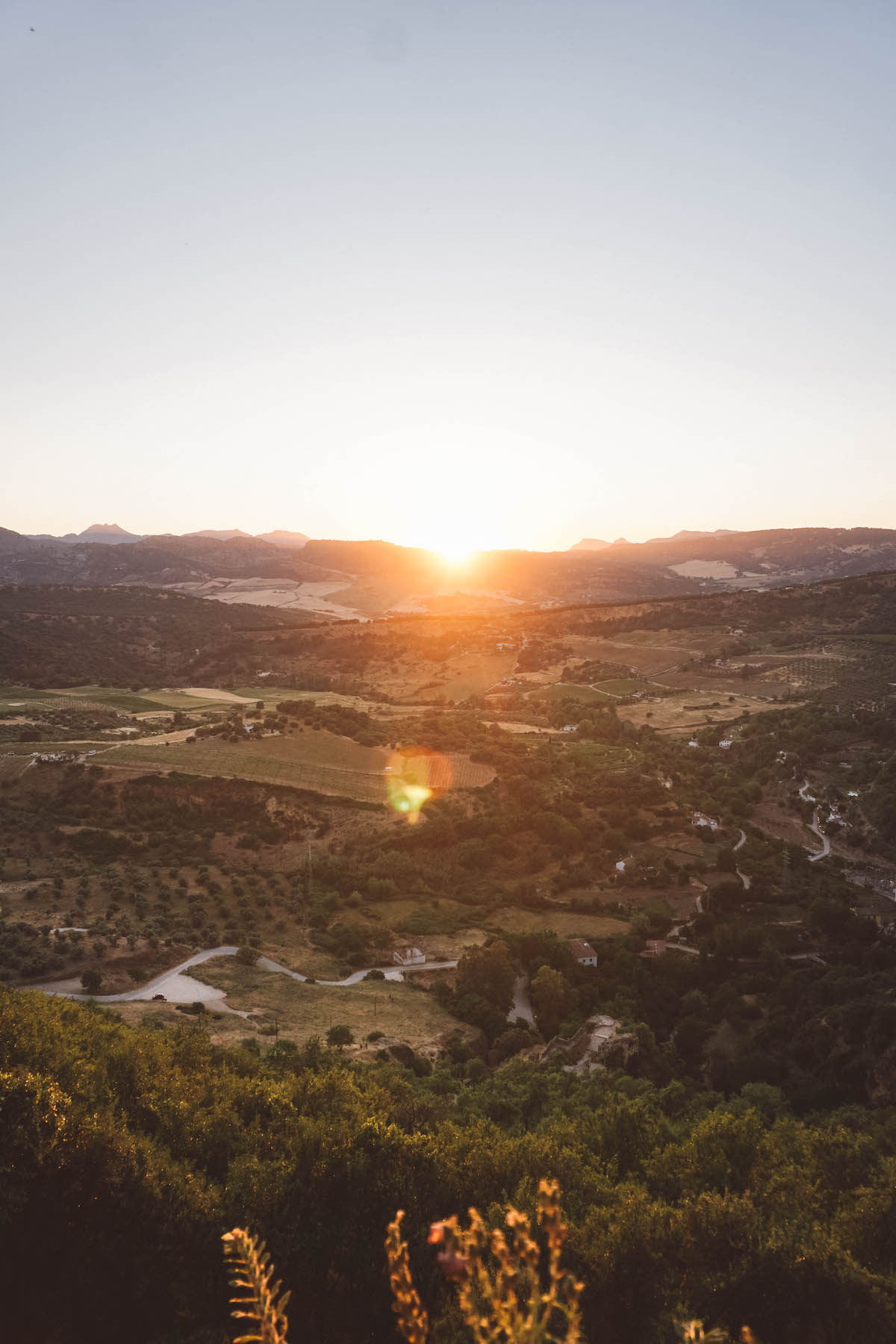
Jardines De Cuenca — Lovely hanging gardens on terraces set over the El Tajo gorge, facing the bridge. This is a good spot to come in the morning to photograph the sun rising over the bridge!
Puente Viejo — Another pretty (albeit less impressive) bridge in Ronda.
Collegiate Church of Santa Maria la Mayor — The inside of the church isn’t that impressive, but the viewing decks from the rooftop offer an amazing view of the Old Town and surrounding countryside.
Casa Museo Don Bosco — An old home-turned-sanatorium that operated until 2008. The home is very small, but the gardens with their cliffside views are the main attraction.
Sunset — You could watch the sunset by the Puente Nuevo bridge, but I recommend finding a quiet spot to sit at the Plaza de María Auxiliadora.
Spain Itinerary Days 11 – 13: Seville
Seville flourished under Muslim rule and rose to further prominence under the Catholic monarchy following the discovery of the Americas. Much of Spain’s trade with the Americas was facilitated in Seville, making it the country’s richest city for nearly 100 years.
Seville is the most diverse city on this southern Spain 2-week itinerary, both in terms of attractions and the local culture. It’s also the biggest city on this itinerary, so if you have the time and desire you can certainly spend more days here either to explore the city more in depth or to take day trips.
Read my full Seville itinerary for more details on the attractions listed below!
Day 1 in Seville
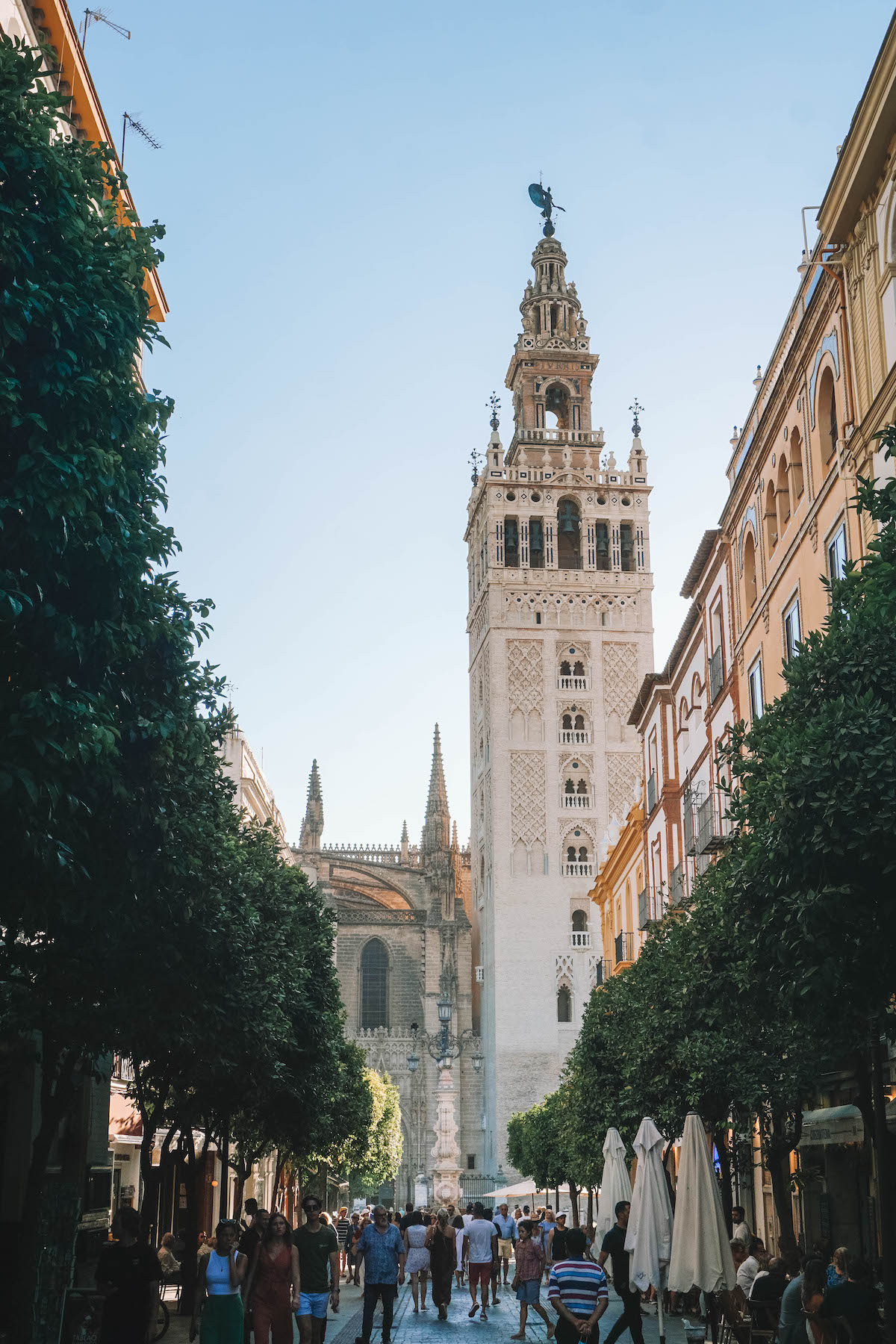
Royal Alcazar — A palace complex originally built by the Muslims to offer them a more strategic position next to the port (i.e. where the city’s wealth flowed in). Arrive first thing in the morning to avoid waiting in a long line.
Cathedral (shown above, left)— The largest Gothic cathedral in the world, and the third largest in general!
Giralda Tower — The symbol of Seville! La Giralda was originally the minaret of the mosque that stood on this site. In the 17th century, the cathedral’s bell tower was built atop the minaret.
Maria Luisa Park — Palace gardens that were donated to the city and transformed into a sprawling public park. The park is divided into smaller gardens and gathering areas, making it a fun spot to explore.
Plaza de España (shown above, right)— End your day here to watch the sunset! The Plaza de España was built for the Ibero-American Exhibition of 1929 and was designed to showcase Spain’s accomplishments in industry and architecture.
Day 2 in Seville
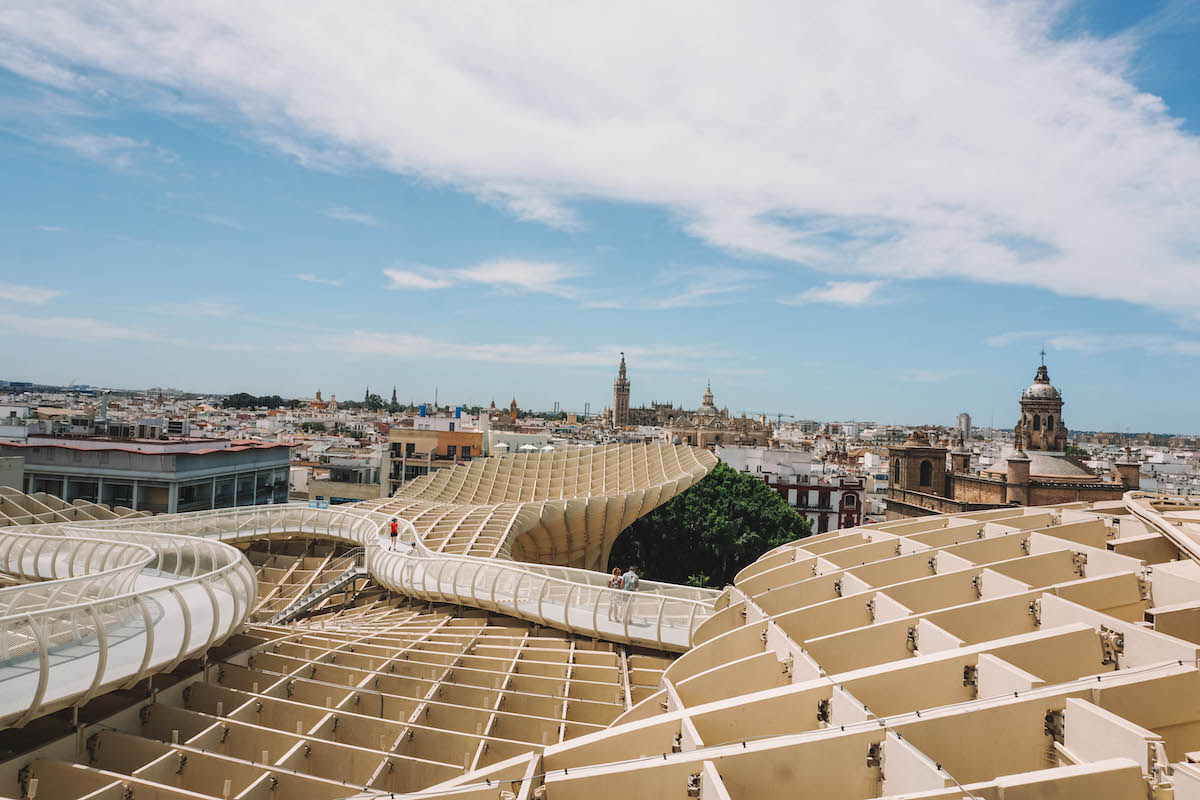
Setas de Sevilla (shown above)— A wooden structure in Encarnacion Square that has a walkway and viewing platform on top. If it’s not in your budget to ascend to the viewing platform, the structure is still really cool when seen from below.
Lebrija Palace — A 16th century palace that was heavily renovated in the 20th century to accommodate a private collection of ancient Roman mosaics. If you love house museums, you MUST come here!
Collegiate Church of El Salvador — A pretty Baroque church that was built on the site of what was the Great Mosque in Muslim Seville.
Museum of Fine Arts — An art museum housed in the former La Merced convent. This is a great spot to end the afternoon as a means of escaping the heat!
Day 3 in Seville

Walking Tour of Triana — The free Sandemans walking tour of Triana offers a unique perspective on Seville’s 2,000-year history.
Mercado de Triana — A covered market selling fresh produce and seafood. There are also restaurants inside, which is where I recommend grabbing lunch today.
Archivo de Indias — Free to enter! The Archives of the Indies houses 80 million pages and maps (all original!) relating to Spain’s massive empire from the 18th to 19th centuries.
Casa de Pilatos (shown above)— A 15th century palace decorated with azulejo (Spanish glazed tiles).
Free time to explore! — Seville is walkable, and there’s a lot packed into the city center. Give yourself some free time to wander the streets and enjoy your final afternoon in Spain.
Adios, Andalucía!
Hopefully this southern Spain 2-week itinerary have given you plenty of information — and then some! — to make planning your vacation easier. If you have any questions about planning a trip to Andalucía, don’t hesitate to leave me a comment below!
Don’t forget to follow me on Instagram to keep up with my daily adventures in Berlin and beyond!

More Places to Visit in Southern Europe:
- 3-Day Florence Itinerary: The Best Things to Do!
- Best Things to Do in Corfu, Greece
- What to Do & See in Athens, Greece
- All of my Europe travel recommendations!
Reader Interactions
Leave a reply cancel reply.
Save my name, email, and website in this browser for the next time I comment.
This site uses Akismet to reduce spam. Learn how your comment data is processed .
Comments & Reviews
October 18, 2022
Do you commercially run such tours? We are on the wrong side of 65 (esposa/mi) and never been to Europe. I enjoyed reading your summary. I’ve been put off some “tours” by people complaints. Cost is also a factor, many seem for royalty we’d feel uncomfortable in such company. I say this if we decide to do less with quality but the upper middle class would be far to… Regards Tony
November 9, 2022
Hi Tony, no, I do not provide any kind of travel planning or tour services. Right now I just provide awesome, free guides online right here on my blog 🙂 Hopefully you’re able to visit Spain soon though!
May 20, 2023
Very impressive, thanks for sharing!
December 16, 2023
Awesome , information . What hotels do you recommend? We are planning to do this in March.
December 29, 2023
Hi Sonia! How exciting that you’ll be visiting southern Spain in March, I think you’ll have an amazing time! Unfortunately I can’t recommend any specific hotels because I stayed in AirBNBs throughout my stay. However, let me know if you’d like general recommendations for areas of the cities to stay in and I can provide info on the neighborhoods I was in.
- About Claire
- Get in Touch
- Read the Blog
- Privacy Policy
Keep Up With Latest Travels!
Subscribe to the newsletter and join me on all the latest adventures, travel tips and more!
Taking the train in Spain - all you need to know

Apr 3, 2024 • 15 min read
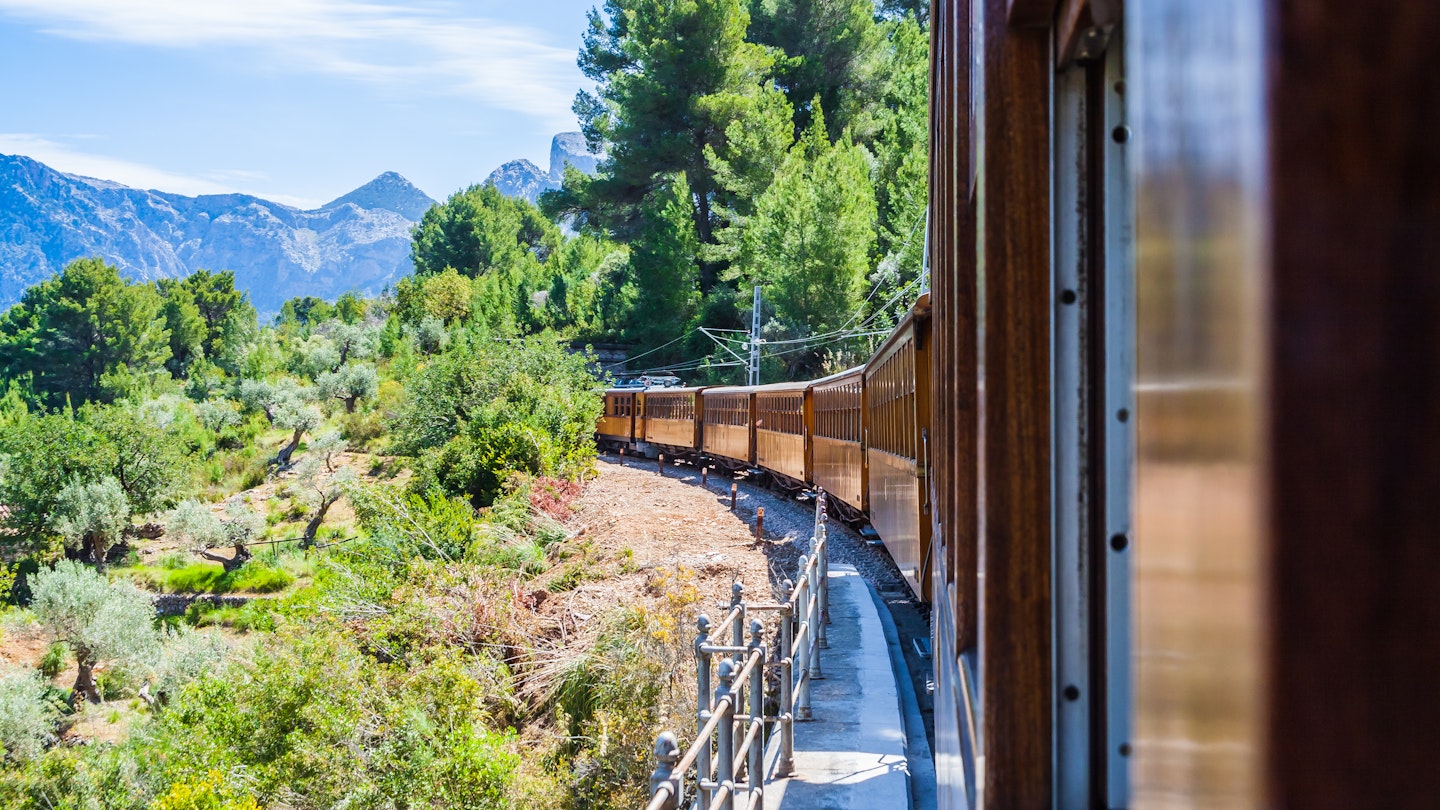
The vintage train from Sóller to Palma de Mallorca is one of the most scenic rail routes in Spain © Shutterstock
Spain boasts Europe’s longest high-speed rail network, second only to China globally, and its trains are exceptional and far-reaching. In one day, you could gawp at Gaudí’s architectural genius in Barcelona , be whisked by rail to Madrid ’s museums, and still arrive in Seville for a sunset flamenco show.
Not that it’s all A to B whirlwind rail routes. There are some outstanding scenic train journeys to slow down and enjoy the Spanish pace of life, whether trundling along the northern coast’s narrow-gauge tracks or meandering into the mountains. And with some new low-cost operators now on the scene, exploring Spain by train has never been more affordable.
With over a thousand stations and thousands more daily departures, getting around Spain by train is a straightforward joy rather than a stressful necessity. Seat reservations on most services guarantee uncrowded carriages, Rioja-serving cafe cars provide perfectly wine-paired panoramic views, and electric-powered trains make journeys even more sustainable. What’s not to love? Here’s everything you need to know to plan a train trip in Spain like a pro.
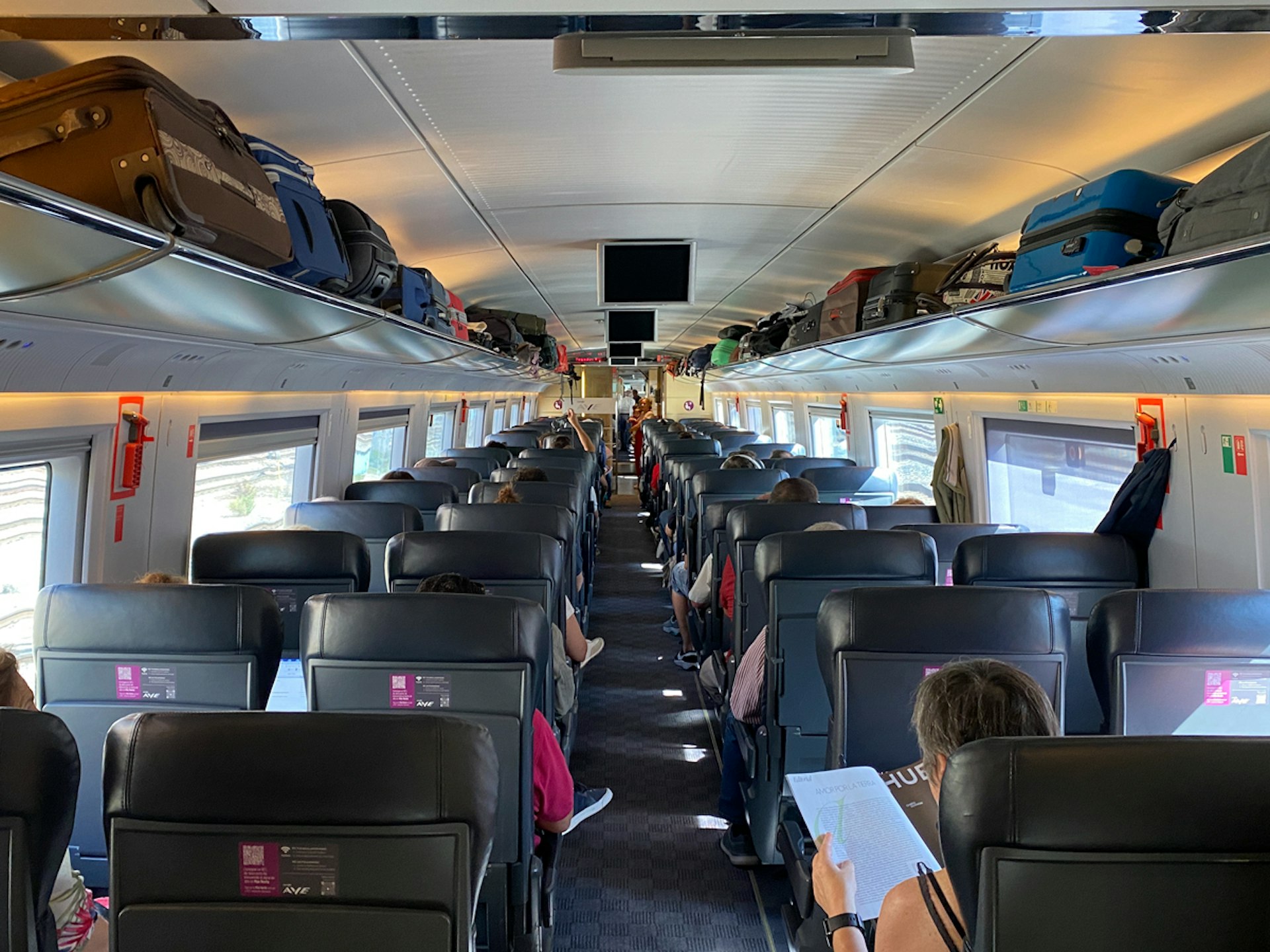
Train services are generally excellent in mainland Spain
You can traverse all four corners of Spain by train, usually on swift, reliable, well-maintained carriages. Few areas aren’t covered by at least a regional service. And where there are coverage gaps, buses will usually take you the final stretch to that pretty medieval village. While strikes can occur, they are rare, and minimum service levels are generally guaranteed. Compensation payments are offered for delays over one hour, which helps keep timetables on track.
Renfe is Spain’s national railway company, operating everything from non-stop regional capital connections to short-hop commuter services. Iryo and Ouigo provide low-cost competition on the main high-speed intercity lines, with the latter’s double-decker trains being a welcome addition.
While the numerous names for differing service and train types can be confusing, the trains in Spain can generally be divided into three categories:
- High-speed, mainly long-distance (larga distancia) services link many major cities, mainly via Madrid. These full-service trains can reach 310km/h (193mph) and include Renfe’s AVE (Alta Velocidad Española), its new no-frills Avlo counterpart, and Iryo and Ouigo. There’s an ever-growing network of high-speed routes , including the popular Barcelona–Madrid, Madrid–Seville, and Madrid–Valencia lines.
- Mid-distance services – although they can sometimes cover long distances and reach speeds of 250km/h (155mph) – make up the majority of other major routes. Renfe services these under names including Media Distancia, Avant and Alvia. Intercity and Regional Exprés services are somewhat slower but only call at major stations. Popular routes include Madrid– Toledo , Granada–Seville, and the Euromed coastal service between Barcelona and Alicante . Nearly all long and mid-distance services use sleek, modern carriages.
- Slower trains , including Regional, Proximidad, and Cercanías commuter services (Rodalies in Catalonia), complete the network. The older Cercanías AM trains, previously FEVE, mainly operate on the northern coast’s picturesque narrow-gauge tracks.
Nearly all large and medium-sized train stations are staffed and contain shops or cafes. High-speed train stations operate similarly to airports, with luggage security scanners and boarding gates. It’s advisable to arrive 20–30 minutes early, especially as boarding can close five minutes before departure. The bonus is you’ll have time to admire the stations. Some, like Toledo’s Mudejar-style ticket hall and art nouveau Bilbao Concordia , are attractions in their own right.
There are tourist trains and unique rail services too
In addition to standard train services, Spain has an exceptional selection of specialist rail routes known as “ tourist trains .” These range from seasonal, short routes, such as the scenic Tren dels Llacs in the Pre-Pyrenees, to indulgent, multiday sojourns like the luxury Transcantábrico train hotel. There are currently no standard domestic night trains.
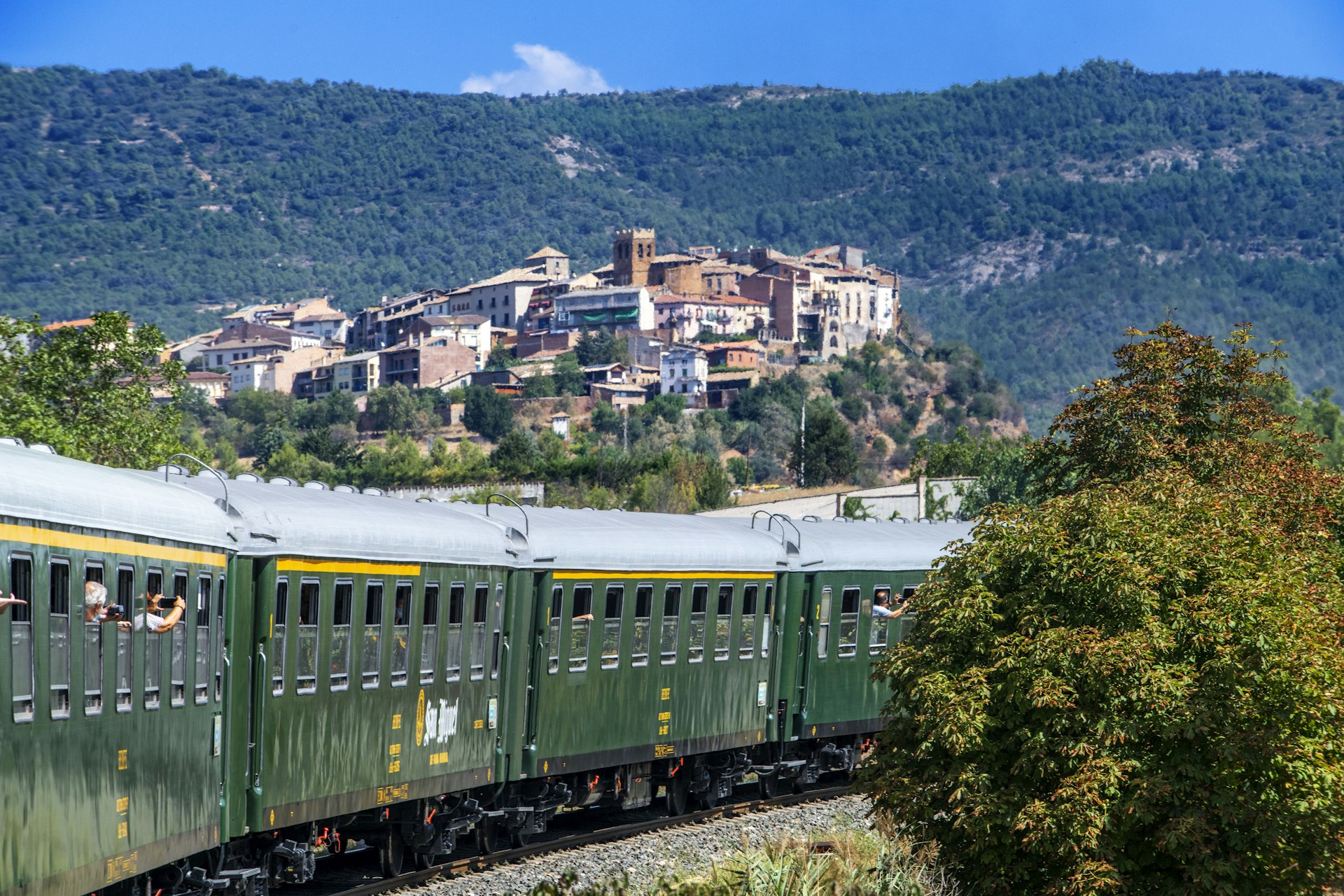
International and island rail routes are limited
Away from the mainland, the rail situation is starkly different. The Canary Islands have no train services, and only Mallorca in the Balearic Islands has limited rail connections . These consist of three short, modern lines and the vintage Sóller train.
Traveling to and from France by train is possible on France’s TGVs (from Paris) and Renfe’s International AVE services to Marseille and Lyon . Fares start from €29. You can also cross via Hendaye in the Basque Country or take the slower, scenic sleeper service via the Pyrenees . The Trenhotel (night service) between Madrid and Lisbon has been discontinued, leaving the Tren Celta between Vigo and Porto and the slow route to Lisbon via Badajoz as the only connections with Portugal . Work continues on improving the tracks to accommodate a direct, high-speed link between the two Iberian capitals.
Book ahead to save money and guarantee your seat
Spain’s rail operators all use dynamic pricing for high-speed and long-distance services. Therefore, early booking is advised, especially as seat reservations are mandatory. Advanced Avlo tickets between Madrid and Barcelona start from €7, with Ouigo and Iryo also offering competitive pricing on primary routes. A same-day ticket can sometimes cost more than 10 times more than booking in advance. Prices are less competitive on routes solely operated by Renfe.
When booking tickets online to or from major cities, use the dropdown city name followed by todos (all) to check for direct and affordable tickets from all stations. Provide the Passport or ID number of the photo document you’ll be traveling with, as tickets are personal. The second surname can be left blank – Spanish people take both their father's and mother’s surnames. Tickets can be printed, collected at self-service machines, or displayed as QR codes on mobile devices. Overall, Ouigo and Iryo's websites are easier to navigate than Renfe's, which can be glitchy. While most people would recommend using a third-party booking service – handy for comparing prices between all operators – direct reservations avoid booking fees.
Even short-distance, popular services with fixed fares (some mid-distance and regional trains) can fill up. I’ve previously struggled to get last-minute weekend tickets on the Madrid to Toledo route. Secure all tickets ahead if your vacation coincides with a major holiday such as Easter (Semana Santa) or Christmas, including around Three Kings Day on January 6.
Iryo and Ouigo release tickets many months ahead. Renfe’s tickets should be available at least 60 days ahead, but this isn’t always true. Check regularly in the months leading up to your departure and sign up for newsletters on the three websites to receive ticket availability and discount updates.
Occasionally, two single fares (ida) can be cheaper than a return (vuelta) . Reservations can also be made at station ticket machines (in English) or staffed desks. Larger stations may have separate sales points for particular types of tickets.
You’ll always be assigned a mandatory seat reservation. However, if you’d prefer to select your own to guarantee a window, you can change it for a nominal fee. Confusingly, Renfe’s website has this step after choosing a payment method.
Cercanías and Cercanías AM tickets can’t be purchased in advance and should be purchased at the ticket office, self-service machine, or onboard from the conductor when traveling from the tiniest unstaffed stations. This is the only time you’re allowed to board a train without a ticket.
If you wish to upgrade from basic class (básico) on high-speed routes, you can choose from Elige, Elige Confort and Prêmium on Renfe, or similar options on Iryo. Upgrades can include access to premium station lounges, at-seat food service, and more spacious seats. Solo travelers may want to upgrade to enjoy an individual seat in the 2+1 configured carriages. Ouigo allows these seats as a paid add-on without upgrading.

Discounts and offers: know your benefits and bring ID
Much noise was made about the launch of Spain’s fixed-price travel pass . Yet this system, established to offer discounted fares on repeat return trips, is primarily aimed at locals and commuters.
Renfe does offer a Spain Rail Pass for travelers , covering between four and ten journeys. However, depending on the routes you plan to take, pre-booking discounted, advanced fares can be cheaper. Some region-specific options exist, such as the better value three-day Galica Rail Pass .
Other discounts available on Renfe include:
- Small group discount when booking four or more travelers together.
- Seniors discount, up to 40%, for over 60s. However, this requires purchasing a card ( La Tarjeta Dorada ) in person before making the reservation. Advanced, discounted fares can be better value.
- Youth Discounts for under 25s with a European Youth Card or suitable International Student Card. A digital card can be purchased online by citizens of most countries.
- Babies travel for free, as do children, although the age cap varies between operators.
Considering an Interrail or Eurail pass? Check on any savings first. All high-speed trains in Spain require seat reservations, an additional cost not included in these passes. Avlo, Iryo, and Ouigo are likewise excluded, and these cheaper advanced tickets may be better value than using the pass, though there is less flexibility.
Money-saving tip: high-speed trains include a free local ticket
If you’re traveling on a high-speed AVE or long-distance service operated by Renfe or Iryo, Combinado Cercanías is included. This allows for free use of local Cercanías trains to reach your departure station and again on arrival. Scan the QR code at barriers, or use the PDF code to get a zero-priced ticket at Cercanías’ self-service machines.
Seat reservations ensure most train journeys don’t feel crowded
Traveling by train in Spain is so enjoyable because all long and mid-distance services require a seat reservation. With no congested corridors or jostling vestibules, these trains never feel crowded, even when full. However, some regional and Cercanías services can be packed, particularly around commuter hours and Friday and Sunday evenings. You might want to avoid peak times or, when available, pay for a regional service seat reservation.
Plan around major events and regional holidays during your trip, such as Semana Santa, when ticket demand and crammed suburban trains are common. Trains in Spain operate every day of the year, though some services may finish earlier on public holidays. If you’re traveling on weekends or during holidays, check onward public transport in advance as small, rural stations may have a reduced weekend bus service.
Train can be the fastest, most affordable transport method
Using the train in Spain can be quicker and cheaper than flying. For example, a flight from Madrid to Barcelona takes 1¼ hours compared with 2½ hours by high-speed rail. But once you factor in security checks, out-of-city airport transfers, and runway taxi times, the overall journey length by plane becomes longer.
Driving distances are considerable. The same journey by car will take closer to seven hours. It’s unquestionably worth renting a car if you’re planning a road trip , but generally, long-distance jaunts are best by rail.
Most train terminuses are connected to city buses and, in larger metropolises, commuter rail or metro systems. Barcelona-El Prat Airport and Madrid–Barajas Airport are on the train network. If you wish to visit smaller towns or villages that are not on the train network, consider other ways to get around Spain .

Onboard facilities differ between service types
All of Spain’s high-speed train services are spacious, comfortable, clean and well cared for. Carry-on luggage can be placed in overhead racks, while storage areas at either end of the carriage accommodate bulkier luggage. Popular services (especially on Friday and Sunday evenings) can quickly fill, and train staff will usually assist in rearranging suitcases to fit. Cercanías services can be more dated and crowded and often lack enough dedicated luggage space.
If you’re traveling by bicycle, check the luggage policies of Renfe and Iryo . In some instances, bikes must be disassembled or an additional fee paid.
The dining carts on Spain’s trains are typically stand-up, cafe-style rather than seated dining carriages. They’re good for stretching your legs or getting an alternative window view, but dining at your seat table is often more comfortable. A selection of hot meals, snacks and drinks – usually all of decent quality – are available, and certain ticket types offer pre-ordered meals served at your seat. Iryo has particularly impressive dining options .
On some routes, a trolley service may be provided in addition or as an alternative. Mid-distance and Avlo services have vending machines rather than dining carts. Bringing your own food and even alcohol onboard Renfe’s services isn’t a problem.
Complimentary (sometimes patchy) wi-fi is provided on Iryo and Renfe’s high-speed services, alongside entertainment portals accessible on your device. Ouigo charges per connection. Plug sockets (F-type) are available at seats on high-speed and mid-distance trains. Nearly all trains, except commuter services, have toilets.
Plan the perfect train trip with these scenic routes and tips
The most popular train routes for travelers in Spain are the high-speed connections that rocket between Seville, Madrid, Barcelona and Valencia. But riding the rails in Spain isn’t only about barrelling between urban sprawl. These are some of our favorite scenic rail routes worth planning into your trip.
- Santander to Oviedo : Cross the lush landscapes of Northern Spain on this slow, scenic rail route using Cercanías AM’s narrow-gauge tracks. This six-hour journey provides some of the expensive Transcantábrico Train’s panoramas for a bargain €16.55. There are no seat reservations, which is handy, as you can switch sides to marvel at both the sparkling Bay of Biscay and the mighty Cantabrian Mountains , Spain’s answer to the Dolomites.
- Barcelona to A Coruña : Once served by the discontinued sleeper Trenhotel, this is one of Spain’s longest rail routes, taking nearly 14 hours. The 9:05am Alvia departure can be affordable to cross seven of Spain’s autonomous communities. Pack snacks and pay for a window seat (ideally on the right) to see the full scope of Spain’s landscapes, from arid pastures and fertile farmlands to the verdant Galician Massif . Consider hopping off a few stops early in Ourense to use the town’s free-to-access thermal pools the following morning.
- Granada to Almería : Leaving the magnificent Moorish Alhambra behind, set off across western Andalucía towards the coastal city of Almería. It’s a showstopping three-hour journey traversing the foothills of the Sierra Nevada, snow-capped peaks looming beyond, before cutting through carpets of cork trees. Book a late afternoon departure for ethereal golden light, or take two single tickets to plan a lunch pause at Guadix, best known for its cave houses.
- Palma de Mallorca to Sóller: Step onboard the rickety, wooden carriage of Ferrocarril de Sóller , constructed in 1912, for a one-hour-long trundle from Mallorca's capital to the pretty port town of Sóller. En route, you’ll wend through the Tramuntana Mountains, unlit tunnels, and citrus groves close enough to touch. All seats are excellent, but you might want to stand in the open-air platforms between carriages.
- Zaragoza to Canfranc : A one-way ticket on this twice-a-day, 2½-hour regional train costs just €16.90, and you’ll get plenty of panoramas for your money, especially after Huesca when the tracks slowly climb up into the Pyrenees. Our resident rail expert, Tom Hall, calls it one of Europe’s best train routes , partly because the landmark Canfranc Station has recently been reborn as a grandiose hotel .

Station tips when traveling Spain by train
Most large cities have multiple train stations, so always confirm departure points. When traveling to dedicated AVE stations outside major cities, check the station’s distance from the city center and pre-plan your connecting travel. Some stations, such as Antequera ’s Santa Ana, can be as far as 15km (9 miles) from the Old Town.
Spain’s largest stations, such as Madrid Atocha and Barcelona Sants, can be confusing due to split-level and separated boarding areas for different services. Don’t be afraid to ask for help navigating the station. A quick flash of your ticket will soon have you pointed in the right direction.
All major stations have cafes and kiosks where you can pick up food, although preparing a train picnic from a delicatessen might be preferable. Still, a quick tapas in Atocha's Tropical Garden, even if the pond-residing turtles have now been rehomed, is a solid start to any journey. If you’re on a connecting service with time to explore beyond the station, most larger terminals have lockers or left luggage desks (consigna) .
Many stations are accessible, but there’s room for improvement on older services
Adif, the agency in charge of Spain’s rail infrastructure, provides in-station and boarding assistance for travelers with accessibility needs via the Acerca service, offered at 145 stations.
When booking tickets online, H seats – accessible spaces that can anchor a wheelchair – can be requested on the opening screen, and Acerca assistance can be requested later in the booking process. A minimum of 12–48 hours' notice is stipulated, depending on the operator. However, in larger stations, staffed service centers can usually provide support without pre-booking if you arrive and register at the desk ahead of travel. Check which facilities are available at each station on Adif’s website .
In addition to offering boarding support (many train types require a stair-climber lift, not just a ramp, while others like Avlo have level boarding), Acerca can provide technical aids for hearing and a guided sight service. Contact Adif Acerca for information on induction loop systems or to discuss alternative routes should your planned journey include a non-accessible station without in-person assistance. Tactile paving, step-free access, and elevators are installed at most major stations, and nearly every train has a conductor or staff member onboard who can assist.
On high-speed, long-distance, and most other services, wheelchair-accessible bathrooms are located in carriages with H seats. Ouigo trains have a call button on adapted seats to provide food and drink service, as the cafe is located on the top deck. Cercanías AM carriages have no H seats but offer a dedicated space for wheelchair users with tie-downs. However, many older, narrow-gauge trains lack accessible bathrooms.
Explore related stories
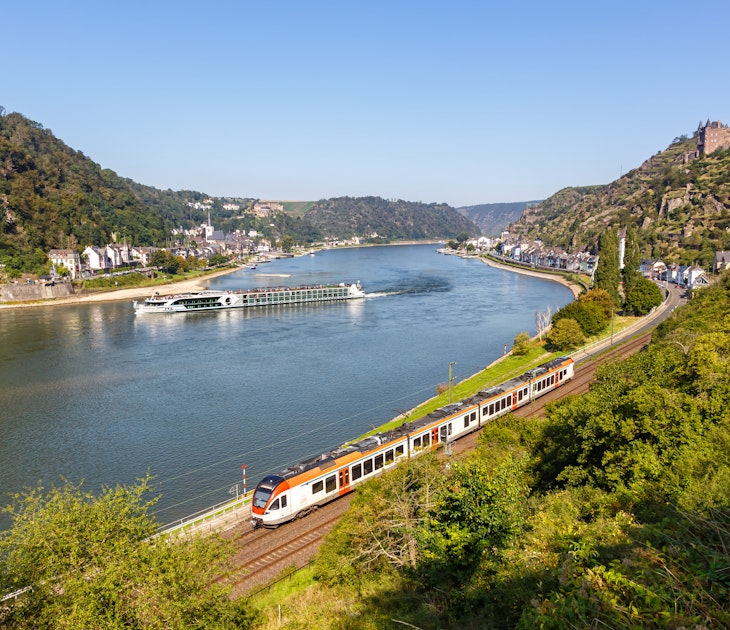
Train Travel
May 3, 2024 • 5 min read
From new routes to services that only run in peak season, here are the best European train journeys to take this summer.

Jan 16, 2024 • 8 min read

Dec 25, 2023 • 11 min read

Dec 19, 2023 • 6 min read

Nov 1, 2023 • 4 min read

Oct 19, 2023 • 8 min read

Oct 6, 2023 • 8 min read

Jun 26, 2023 • 5 min read

Jun 18, 2023 • 6 min read

May 19, 2023 • 12 min read
Travel Safe

11 incredible trips around Spain for train lovers

The Transcantábrico
The Transcantábrico Train is the oldest and most quintessential luxury tourist train. This route is a dream: travel around the north of Spain, known as Green Spain for its stunning landscapes overflowing with this colour, on board a train that preserves the romanticism of the great trains of the early 20th century but also has modern facilities. The more glamorous version is the Transcantábrico Gran Lujo which departs from San Sebastian and eight days later arrives in Santiago de Compostela . Travellers can try the gastronomy from Castile and Leon , the Basque Country , Cantabria , Asturias and Galicia , while enjoying gala nights, live music on board and tickets to museums and monuments with a multilingual guide.
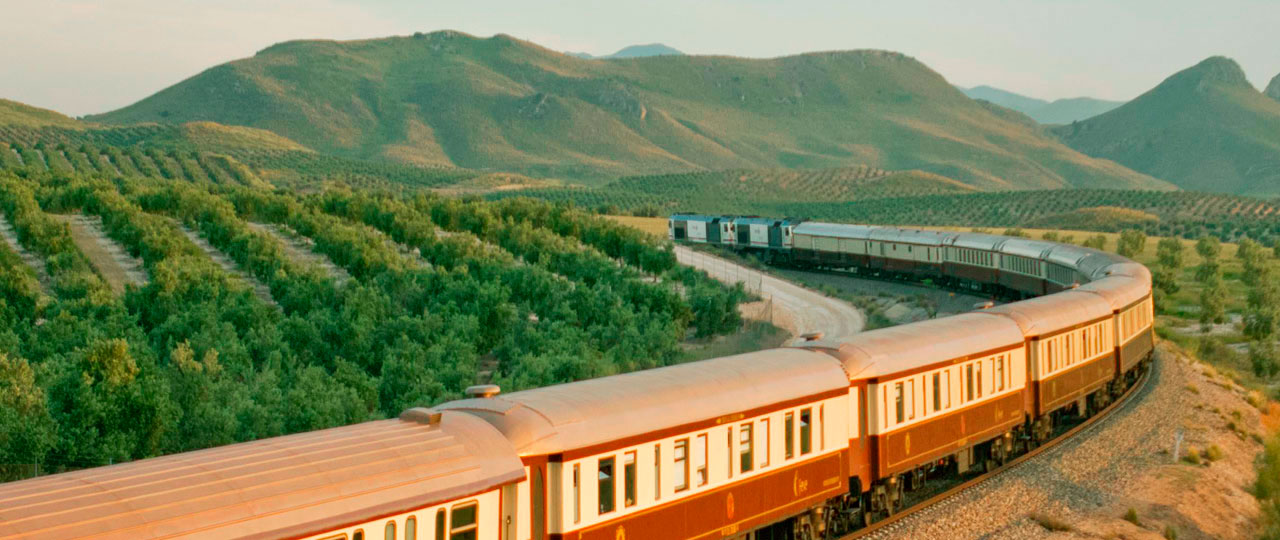
People say the Al-Andalus Train is like a palace on wheels. In fact, the carriage-suites are part of the very series constructed to transport the British Royal family between Calais and the Côte d'Azure. Passengers on this train will visit Andalusia over seven days, ending in Seville . The experience of travelling on one of the world's most spacious trains is combined with the chance to try dishes by prestigious chefs and discover cities such as Cadiz, Ronda, Cordoba, Úbeda and Baeza and sights like the Alhambra .

Galicia's tourist trains
Did the previous ideas tempt you to visit Galicia? Then you will be happy to hear that every year in Galicia, they run various themed tourist trains. They usually run between May and October and travel the most beautiful routes, such as the Lighthouses Route, the Mansions and Historic Gardens Route, the Roman Lugo Route, the Ourense Spa and Shopping Route, etc. Galician wine has become very famous and one of the most original ways to try it is on board one of these trains, on routes such as the Rías Baixas Wine Route and the Ribeira Sacra Wine Route. Get ready to see landscapes of valleys and vineyards, monasteries hidden among the mountains and incredible scenery along the Sil and Miño rivers.
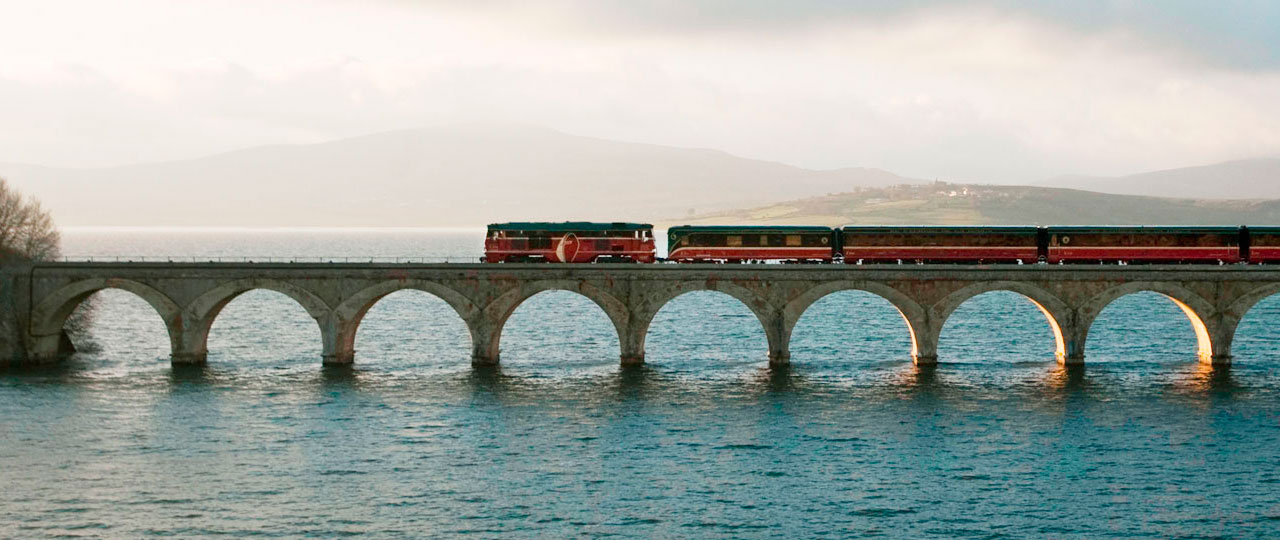
La Robla Express
Still in the north of Spain, for three days and nights this train offers a journey through the nature and culture of the area, for the most part following the Camino de Santiago or St James' Way. The Bilbao and Leon itinerary is a journey usually offered from June to October. Inside, you can expect classic decoration and outside you will see the natural landscape of the north of Spain. And fine dining is an important part of this route.
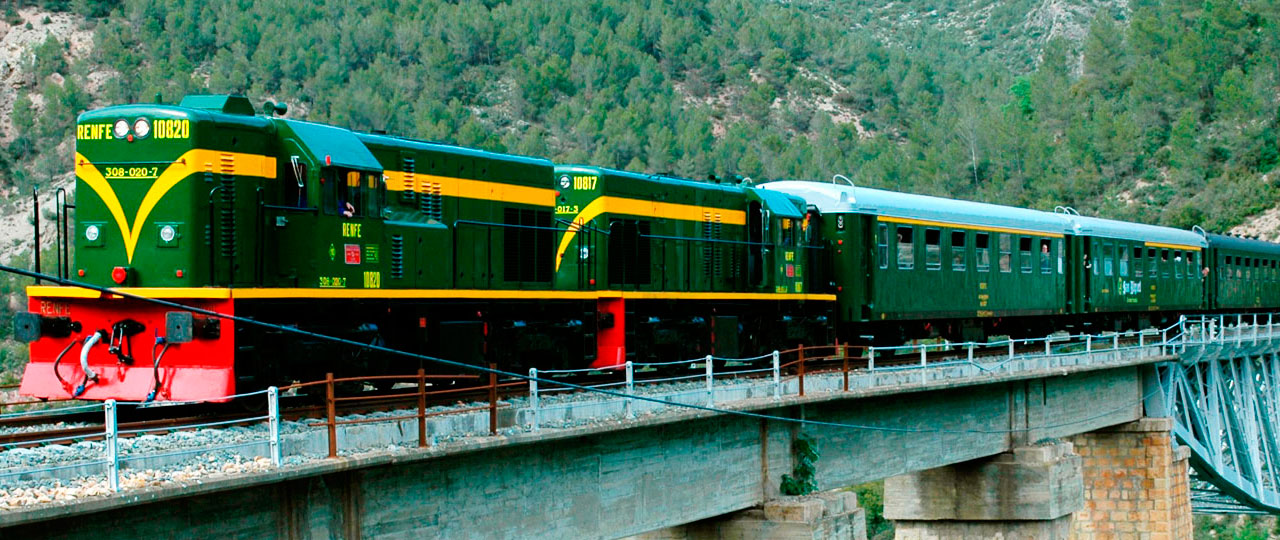
Tren dels Llacs
The landscape on this route is equally stunning. We are going to the province of Lleida (in Catalonia) to travel on the Lakes Train . You have two options: a journey in vintage carriages, which have been lovingly restored, or on board modern, panoramic trains. The route takes you to a multitude of locations and has plenty of activities to take part in. For example, there are stops arranged at one of the oldest liquor factories in Catalonia, a lunch of traditional local dishes, trips to the Gerri de la Sal salt flats, the Castell de Mur, artisan cheesemakers, the Aigüestortes y Estany de Sant Maurici National Park and much more. You can enjoy a trip on this historic train most Saturdays from April to October. The panoramic trains are also available some Saturdays in July and August.

The Cervantes Train
As well as trips over several days there are also interesting day trips. The Cervantes Train departs from Madrid and arrives in the historic city of Alcalá de Henares , the birthplace of the most famous Spanish writer of all time: Miguel de Cervantes. Even the journey itself is interesting as various actors in 17th-century costume accompany the travellers. When you arrive you can visit iconic places in Alcalá such as the Calle Mayor, the University, the Cathedral and, of course, the home of the author of Don Quixote . The train usually runs on Saturdays in the spring and autumn seasons.

Sigüenza Medieval Train
Sigüenza , known as the “City of the Young Kinght”, is just 130 kilometres from Madrid. It is one of the few places that still has three preserved walls and a surprising medieval feel. The train journey, which departs from Madrid, is brought to life by folk singers, knights and princesses through music and theatre, and it also offers a selection of cakes. Upon arrival in Sigüenza, a tour guide will take you to discover the most important points in the city: the Castle, the Cathedral, the Plaza Mayor square and the Casa del Doncel. You will also be able to try typical dishes such as migas, Castilian soup and the delicious Yemas del Doncel sweets. It usually operates between April and November, not necessarily on weekends.

The Strawberry Train
This is a great idea for the weekends in Spring and Autumn . The route? From Madrid to Aranjuez , a location famous for its delicious strawberries and whose Cultural Landscape is listed as World Heritage. Aranjuez is primarily known for the Royal Palace of Aranjuez and its stunning gardens that are great for walking around. During the journey, you will travel in wooden carriages constructed between 1914 and 1930, and will be offered strawberries to try. Once you arrive in Aranjuez, depending on which itinerary you have chosen, you can visit places such as the Palace or the gardens, or climb aboard a boat or sightseeing bus-train.
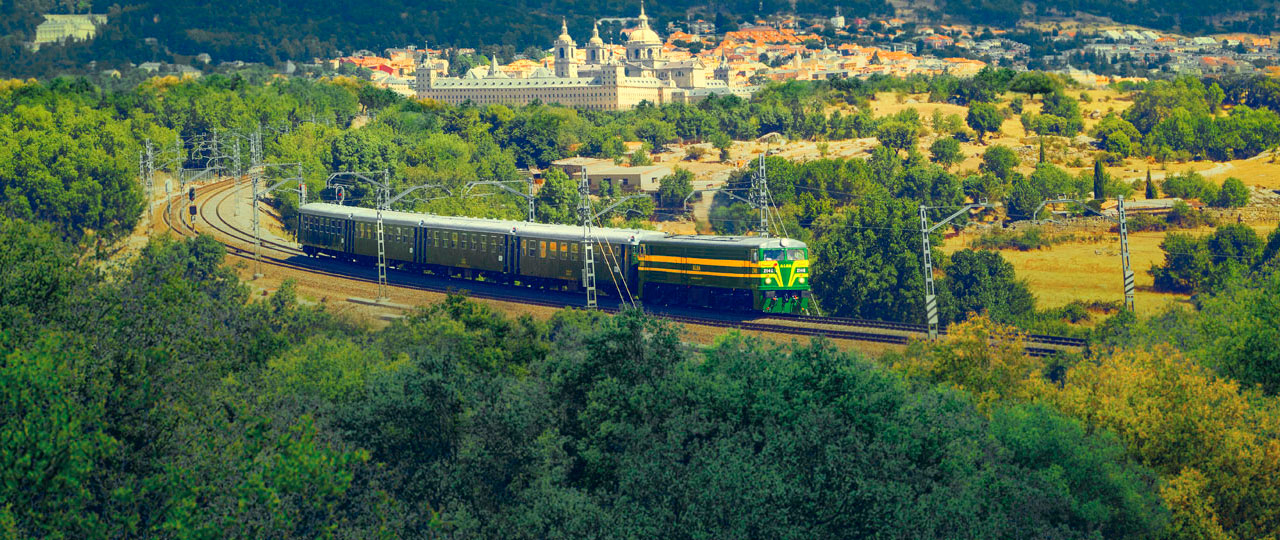
Philip II Train
Passengers are taken to San Lorenzo de El Escorial , just over 50 kilometres from Madrid, in a 20th-century locomotive . Once the train arrives, and depending on the ticket type, the trip includes a guided tour of the Monastery of San Lorenzo de El Escorial . This amazing monument was built by Philip II in the 16th century and was considered the “Eighth Wonder of the World”. It houses the Royal Pantheon, the Basilica, the Library, the Hapsburg Palace, etc. That is why walking around inside is an experience worthy of kings. The tour can also include a panoramic route through La Herrería forest or the Casita del Infante gardens.
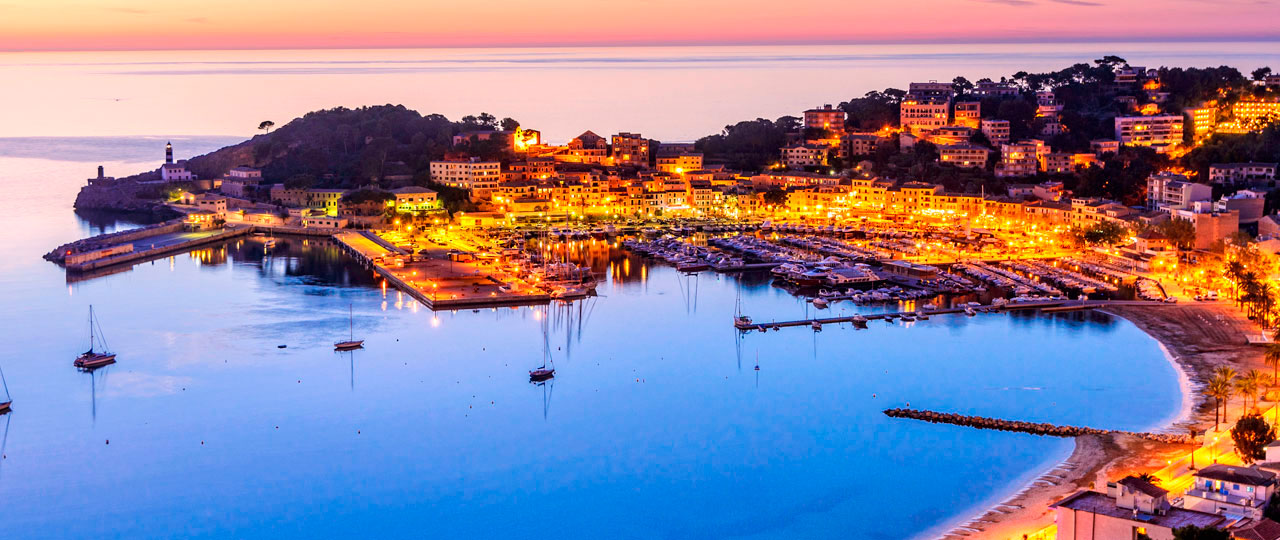
Sóller railway
Climbing aboard this period train with wooden carriages is one of the best experiences on the island of Mallorca . The railway itself is really beautiful, but what you can see through its windows is even more so: it leaves the city of Palma , goes through the Sierra de Alfàbia, overcomes a drop of almost 200 metres and crosses 13 tunnels, several bridges and the “Cinc-Ponts” viaduct. Once the train reaches the beautiful village of Sóller , the smell of orange blossom mixes with the sea and having a coffee outside with the mountainous landscape in the background is a truly delightful experience.
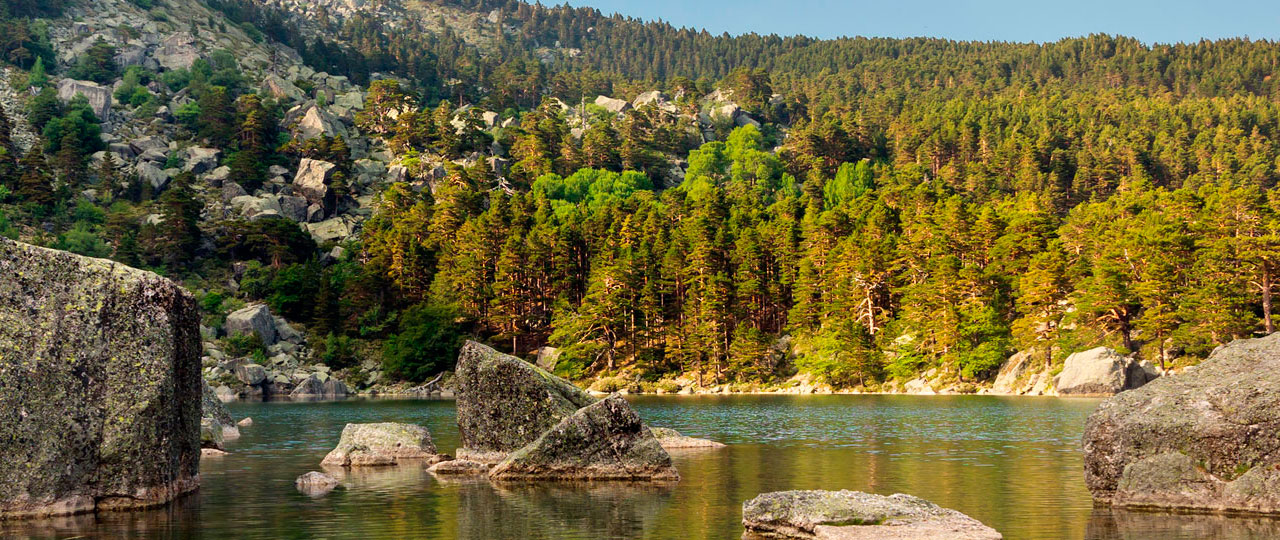
Campos de Castilla Train
We recommend travelling to Soria from Madrid and spending the weekend surrounded by poetry and local cuisine. Taking this train means following in the footsteps of the famous poet Antonio Machado, who lived there more than 100 years ago. Before the train arrives in Soria, in Sigüenza, some “special” passengers get on board: actors who liven up the journey with anecdotes about Machado. Once you reach Soria you can visit the Baroque San Saturio Chapel, the splendid San Juan de Duero Monastery , the ancient city of Numantia and the enigmatic, captivating Black Lagoon. You can take this trip some weekends between May and November.
Travel plans for inspiring you
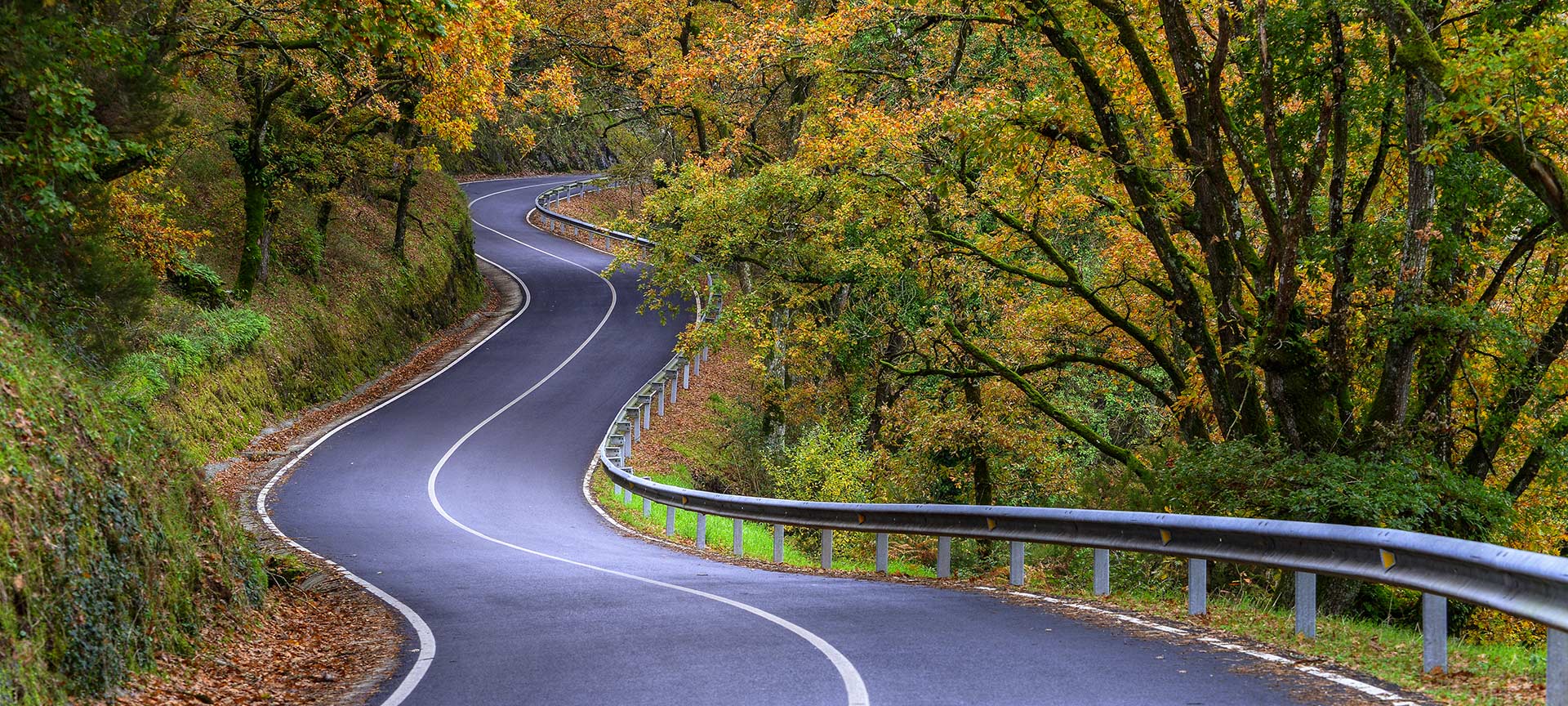
Galicia on the road, spectacular landscapes, in images
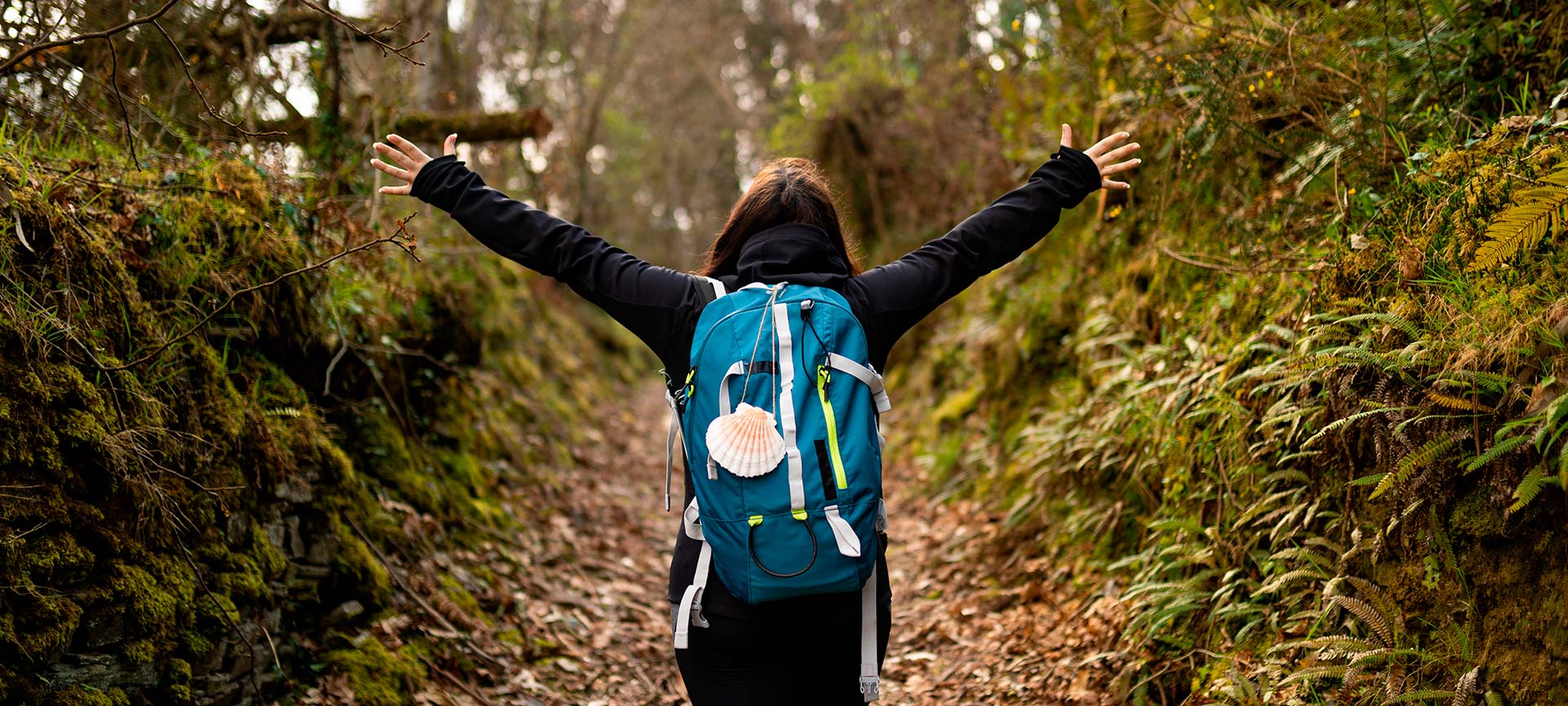
How much do you know about the routes of Spain? #SpainQuiz
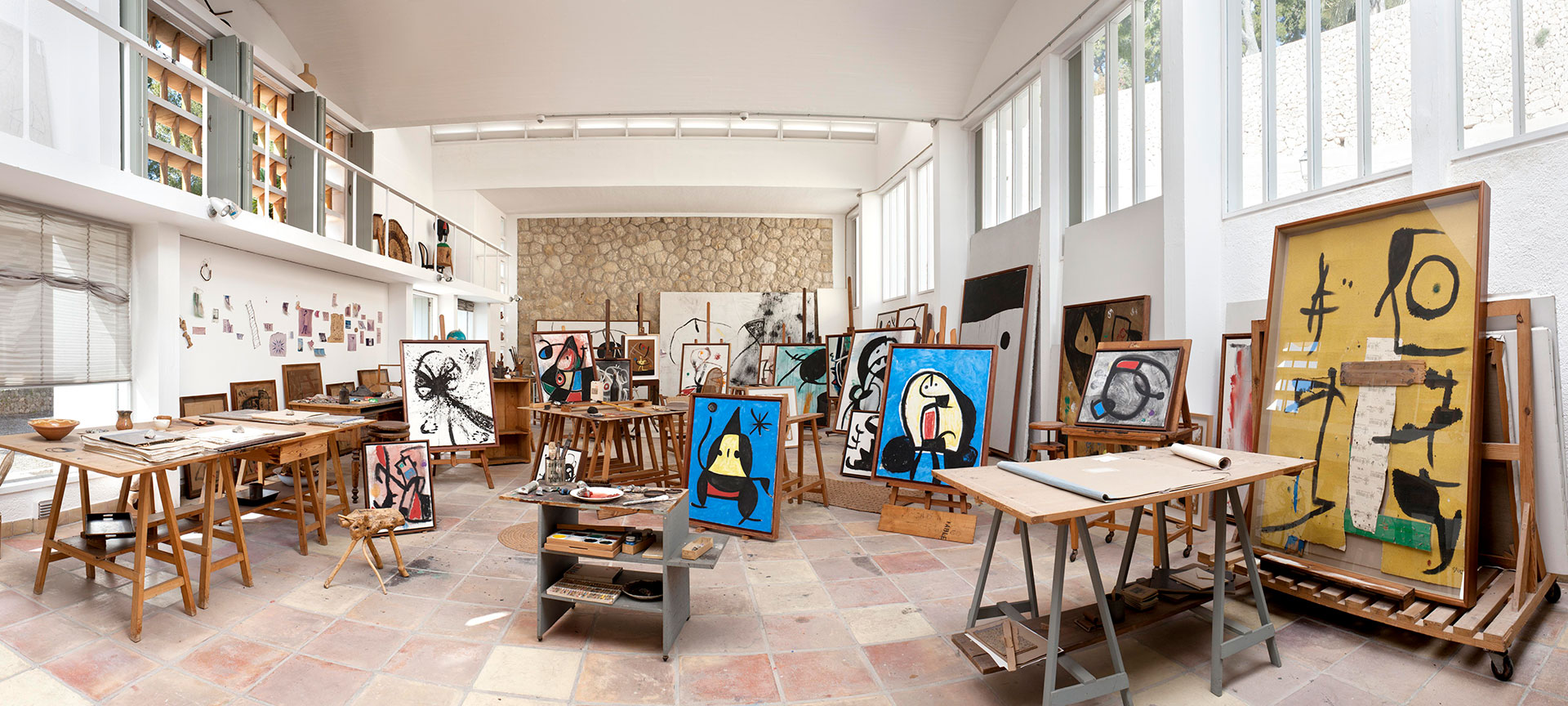
In the footsteps of Miró

Choose between thousands of activities to live your best life on holiday.


Here's What You Need To Know About Drinking In Spain Before A Summer Getaway
Wondering what the legal drinking age in Spain is so that you can make the most of your trip and know if you can drink the fabulous Spanish wine or vermouth? You’re in the right spot because we have the deets!
Spain is home to some of the best wine on the planet, has great local beer and – our favorite – Spanish Vermouth and many of the best things to do in Spain involve alcohol. It also makes an amazing Spanish souvenir ! In fact, you will see locals drinking wine or beer on their lunch break!
The legal drinking age in Spain is 18, much younger than in the USA. And, unlike the US where the drinking age can vary, the drinking age in Spain does not change from region to region
In this post we’ll share all about the legal drinking age, the drinking culture of Spain, the alcohol laws, what happens if you break the drinking laws, and even our favorite drinks and cultural tips so that you can make the most of your Spanish vacation!
Let’s get to it! ¡Salud!
What is the legal drinking age in Spain?
The legal drinking age in Spain is 18 years old. This goes for drinking alcohol or trying to purchase alcohol. You must be 18 years old to do both of these in Spain.
This does not change no matter what city or region of the country you are in . From Barcelona to Madrid to Mallorca, the legal drinking age is 18 years old.
For a long time, the legal drinking age was 16 but the laws started to change in 1991 and were fully implemented in 2009. Praise the Lord for this because can you imagine trying to take a romantic vacation with drunk 16-year-olds around? No thank you.
The Legal Drinking Age in Europe
For most countries in Europe, the legal drinking is the same as in Spain: 18 years old.
However, there are some differences across Europe:
- In Belgium, Denmark, and Germany you can buy alcohol that is less than 1.2% of distilled alcohol at 16 and alcohol that is more than that at 18.
- In Sweden, you must be 20 years old to purchase anything more than 3.5% alcohol.
- In Cyprus and Malta, you can buy any alcohol at 17
- In Luxembourg, you can purchase alcohol at 16.
The Difference Between the Spain and U.S. Legal Drinking Ages
The main difference between the Spain and U.S. legal drinking ages is that you have to be 21 to buy or consume alcohol in the USA. In Spain, you only have to be 18.
This makes countries like Spain popular for things like spring break (which is why we don’t recommend going during this time if you’re looking for a nice, romantic couples vacation!)
The legal drinking age in the US was established at 21 years old by the National Minimum Drinking Age Act of 1984 so that young adults would have a more responsible approach to alcohol. Much for the same reason that Spain increased their legal drinking age from 16 to 18.
Both countries have laws around buying alcohol, selling alcohol to minors, serving minors alcohol, drinking in public, open containers, and drinking and driving. Both countries also require you to show your ID if you are asked but we have found that we never get carded in Spain, whereas we do all the time in the USA (and it always makes our day because who doesn’t want to look in their 20’s.)
Bringing Alcohol Back From Spain Into the USA
When you come back from your vacation, we guarantee you are going to want to bring some amazing Spanish wine or Vermouth. We don’t want you to risk having it taken away, so here is what you need to know:
- If you do not want to pay any duty on your alcohol, you can bring one little alcohol per person back into the USA (as long as you’re 21.)
- There is no federal limit to how much alcohol you can bring back for personal use however large quantities might get you flagged.
However, the Federal Aviation Admission limits the amount of alcohol that can be brought on a plane to 5 liters of unopened alcohol per person if that alcohol content is 24% to 70%. If it’s less than 24% you can bring more. Again, ANYTHING over 1 liter per person will be taxed by customs.
- Keep in mind that different states have different laws around how much alcohol you can bring bac k if you live in that state, so do your research. This usually doesn’t apply if you just transit through that state, such as being on a layover.
Duty-free: When you leave the airport in Spain, you can always buy alcohol there duty-free. Remember though, that just means you don’t pay tax on the booze in Spain. You will still have to pay duty in the USA if you bring back more than 1 liter per person.
Drinking Culture In Spain
Drinking alcohol in Spain is much more chill, relaxed, and normal than in the USA and people are much more casual about it, even when visiting some of the islands like Mallorca . It’s very common to see people sipping on a few beers or glasses of wine with their lunch, evening if it’s a work day and they’re on a (long) lunch break. You don’t have to stick to alcohol only on a weekend visit ! Amazing right?
We find that Spaniards eat out WAY more than Americans (probably because their cost of food/drinks is much less than eating out here) which means that going out for beer, wine, and cocktails at night is something that is super common. A glass of local beer or wine is often cheaper than pop!
You would be very remiss to not take advantage of this especially as Spain has some of the best wines in the entire world! We like Spanish wine so much more than the popular California wine of the USA.
We found that beer seems to be the “fancier” drink in Spain and wine was “less fancy.” When you are in the USA, this is the opposite.
Like The USA, Spain does experience underage drinking. Drinking in Spain does usually begin around 13 with 75% of people aged 14-18 having had alcohol at some point in their life.
When you spend some days in big cities like Madrid , Barcelona, or Ibiza, you will find that the adorable bars are buzzing until late into the night as Spain is quite known for its incredible nightlife.
Cultural Tip
Eating and drinking are more tied together in Spain and it’s less common to find people JUST drinking without food, like you find in the USA. Usually, some kind of small snack is eaten while drinking.
In some areas, especially Andalucía or less touristy areas, and only order a drink at the bar, you may find that they give you a small tapa for free because of this. We did not find this very common in large cities like Madrid or Barcelona, but it sure is a nice surprise when it happens!
Rules Around Drinking Alcohol in Spain
Drinking in public.
While in Spain, you may come across something called a “botellón” (“big bottle” in English) when you are wandering the streets of Spain. This is essentially a group of young people gathering with loud music and sharing alcohol in public to save money.
Botellón is technically illegal, and some rules have been put in place like not being able to buy alcohol past 10 pm in store s. But, that doesn’t mean it does not happen – both the botellón and buying alcohol past 10. You may find some stores that sell it to you after 10 pm, but it is still illegal so please do not put them at risk. Just go to a bar.
Of course, you can drink your beverage on the patio of a restaurant in public.
Open Container Laws in Spain
Even if you are not having a loud and crazy botellón, it is still illegal to carry an open container of alcohol around the streets in Spain.
Driving Under The Influence (DUI) In Spain
It is never okay to drink and drive regardless of where you are. There is always a taxi, Uber, or a train/metro as Europe has incredible public transportation that is much better than the USA. You have no reason to drink and drive!
The legal limit whether you are driving around islands like Mallorca or mainland Spain is:
0,25 mg/l for a breathalyser test or 0,5 g/l in your bloodstream.
Note: if you are a new driver, the limit drops to 0,3 g/l in your bloodstream.
Legal Consequences For Breaking The Spain Drinking Laws
If you are caught drinking in the streets or participating in a botellón in Spain, you can be fined up to €600.
Spain takes drinking and driving seriously and has been working hard to reduce instances of this happening. If you are found drinking and driving, here are the consequences you can expect to face”
BAC (g/l)Fine in €Driving banImprisonment>0.25g/l to 0.5g/l500 and 4 points loss (out of max. 15)>0.5g/l to 1.2g/l1000 and 6 points loss (out of max. 15)>1.2g/l (criminal offence)Fine from 6 up to 12 months (Spain adopts a system of day-fine)From 1 up to 4 yearsBetween 3 and 6 months or social works up to 90 daysRefusal to get tested2,000 €From 1 up to 4 yearsBetween 6 up to 1 year
So, please do not drink and drive. Be responsible adults, especially since large cities in Spain like Madrid are extremely walkable !
Serving or Selling Alcohol to Minors
While some servers may turn a blind eye to serving minors if they are with their parents, this does not make it legal and the penalty is a minimum of € 30,000 and a maximum penalty of € 600,000.
Are there any exceptions to the legal drinking age in Spain?
There are no expectations for the legal drinking age in Spain. The age to buy or drink alcohol is 18, no matter the situation.
Can I Drink Beer Under 18 In Spain?
No. It is illegal to drink beer under 18 in Spain. You may see minors drinking with their parents however this is illegal.
Is Wine Allowed In Spain Under The Legal Drinking Age?
No wine is not allowed in Spain if someone is under the legal drinking age of 18.
Can Minors Drink Alcohol With Their Parents in Spain?
Technically it is illegal for minors to drink alcohol with their parents in Spain. If the parent is caught, they will be held responsible.
However, adults usually find it their job to teach children a healthy relationship with alcohol, so you may see children having sips of it at home.
Words to Know for Drinking In Spain
Now that you know all about what NOT to do when you’re drinking in Spain, you need to know WHAT to do and say! Here are the most typical words you will need to know:
- Wine – Vino (VEE-NO)
- Red wine – Vino Tinto (VEE-NO TEEN-TOE)
- White Wine – Vino Blanco (VEE-NO BLAH-NCO)
- Beer – Cerveza (SIR-VAY-SA)
- Cider – Sidra (SEE-DRAH)
- Gin – Ginebra (JIN-E-BRAH)
- Whiskey – Whiskey
- Vodka – Vodka
- Rum – Ron
- A shot – Un chupito (OO-N CHU-PEE-TOE)
- Alcohol-free – Sin Alcohol
- I would like – Me gustaría (MAY GOO-STAH-REE-AH)
- Cheers! – ¡Salud! This translates to “Health!” Note: the “d” is silent so it’s pronounced (SAH-LOO)
- No more – no más
- Please – Por favor (POOR FAH-VOR)
Unlike the USA where the base tip expected is 20% these days, even for a glass of wine, tipping at a bar is not customary ESPECIALLY if a drink is all you are getting. If you order food, round up to the nearest Euro and leave a few coins
Must-try Traditional Drinks in Spain (Alcoholic)
Spain makes some incredible adult beverages and your trip would not be complete without trying:
- Sangria – A sweet mix of red wine, brandy, sprite, peaches, oranges, apples, sugar, lemon and cinnamon. We LOVE the sangria at Taberna El Sur in Madrid .
Despite what you hear, locals do not drink Sangria all the time. It used to be just for parties and then tourism happened and now everyone thinks Spain drinks gallons of Sangria. You will find it everywhere but, if you want to drink like the locals, try Tinto de Verano (more on that below!)
- Spanish Wine – Spain makes some of the most incredible wines in the whole world.
If you like red wine, try a tempranillo . If you like white wine, try Albariño.
- Mahou – Brewed in Madrid, this is the most popular of all the beer brands.
- Tinto de verano – The simple cousin of Sangria (and the local option) is simply wine and Sprite with a slice of lemon
- Vermouth – We LOVE Vermouth so much. It is much different than Italian vermouth and is becoming quite popular in Spain.
Spanish vermouth is a fortified wine that is flavored with caramel, spices, and botanicals. It’s a dark brown color but is actually made from white wine and it’s rich, sweet, and medicinal but in a super delish, unique way. I promise it’s way more delicious than it sounds.
Our favorite spot to get Vermouth is Taberna La Concha in Madrid. We ALWAYS bring bottles home.
Spain Drinking Age FAQ’s
Can i drink beer under 18 in spain.
No, it is illegal to drink beer under the age of 18 in Spain. Drinking any kind of alcohol under 18 is prohibited by law.
Is wine allowed in Spain under the legal drinking age?
Despite making amazing wine, it is illegal to drink wine under the legal drinking age of 18 in Spain.
Can alcohol be bought at shops and supermarkets in Spain?
Yes, shops and supermarkets can have licenses to sell alcohol which means they are available for you to buy if you are under the legal drinking age. It’s important to note that the law prohibits alcohol sales after 10 pm. So, don’t wander into a shop at 10:30 trying to buy some wine.
Can I purchase alcohol in a store in Spain if I am under 18?
No, you cannot purchase alcohol in a store in Spain if you are under 18.
Do bars in Spain ID?
Yes, bars in Spain ID and especially so if you look under 18. Make sure you carry a valid ID such as your driver’s license or passport. We recommend your passport as it is more widely recognized than a state driver’s license.
How old do you have to be to go clubbing in Spain?
Legally, you have to be 18 to go clubbing in Spain. Bars and clubs enforce this by carding those who try to get in.
What is the legal age to drink in Barcelona?
The legal drinking age in Barcelona is the same as in the rest of the country: 18 years of age.
What is the legal age to drink in Madrid?
The legal drinking age in Madrid is 18, just like that of the rest of Spain.
Can you openly drink in Spain?
You cannot openly drink in Spain unless you are, of course, sitting on a patio at a restaurant. If you drink in public, you can face fines of up to €600.
Does Spain have good nightlife?
We feel that the nightlife in Spain is second to none. The cities are always buzzing and you’ll always find a cozy bar or a more lively club to spend the night


COMMENTS
9. Road trip around Mallorca. 5 days, 175 miles. Lazy. 10. The full circle - A complete road trip around Spain. 35 days, 2,800 miles. Challenging. Whether you want a relaxing drive along the coast or drive around the entire country of Spain, here are the 10 amazing options for a Spain road trip to pick from.
Day 1: Arrive in Barcelona (sleep in Barcelona) Day 2: Barcelona (sleep in Barcelona) Day 3: Barcelona, evening train to Madrid (sleep in Madrid) Day 4: Madrid (sleep in Madrid) Day 5: Madrid, or day trip to El Escorial and/or Valley of the Fallen (sleep in Madrid) Day 6: Madrid, late afternoon to Toledo (sleep in Toledo)
Spain Itinerary - 14 Days. This road trip would be a beast. As planned above with the scheduled day trips you'd cover around 2600 kilometres. The driving time would be around 27 hours and 30 minutes - but of course, this varies by traffic and which day trips/stop days (beach days) you opt to take, etc.
Day 5: Granada. Next on our itinerary is a short stop in another Andalusian gem, Granada. Though you could spend several days discovering all the sights of Granada, there's really only enough time on this trip for a single day here. Start your day in the city center at Granada Cathedral.
Northern Spain Road Trip Itinerary. Road Trip Through Tenerife (Canary Islands) Road Trip Through Catalonia (Catalunya) Road Trip Through Central Spain. Driving the Balearic Islands. Road Trip Along Spain's East Mediterranean Coast. Road Trip Across Galicia. Road Trip Around the Basque Country.
In this article, you will find 11 itineraries to travel to Spain, from 1 day to two weeks, all full of recommendations for different cities and activities. You can follow them as they are or tweak them a bit and personalize the itineraries; after all, Sensation Spain's itineraries are meant for you to enjoy and travel happily.
Europe. Check out this year's Best in Travel winners. Passionate, sophisticated Spain is full of wild beauty, deep history and some of the best food you'll ever eat. Life is a fiesta, and everyone's invited. Best Time to Visit. Best Places to Visit.
2. Andalucía road trip. Best road trip for getting close to Spain's Moorish past. Malaga- Seville; 471km (293 miles), allow 5 days. Southern Andalucía is the only European region that has both Mediterranean and Atlantic coastlines, linked by the Strait of Gibraltar.
Tip #4 - Go On Day Trips To Spain's Hidden Gems. The adorable town of Competa. Everyone wants to go to Barcelona and Madrid, but fewer people are lining up around the block for Spain's lesser-known gems of towns. Some of my favorite smaller places in Spain were Frigiliana, Nerja, and Competa in southern Spain.
Average cost of 20 days in Spain. Plan to spend around $2,000 for a 3-week trip in Spain if you prefer to stay in a mid-range hotel and eat often. Accommodation costs you the most during your trip, around $40-$60 a night for a decent double room. Eating out in a m id-range restaurant will be about $7 to $12 per meal.
What to pack for your Spain road trip. A few of my favourite must-pack essentials to make your road trip around Spain comfortable, safe and hassle-free. Travel insurance for Spain. The one thing I never travel without. When it comes to medical expenses, accidents, travel delays and the like, preferred partner for long-term travel insurance is ...
10 Best Spain Tours & Trips 2024/2025 - TourRadar. Admire the golden wonders of Granada or fall in love with Gaudí's La Sagrada Família with the best Spain travel deals - from Bilbao to the Balearic Islands.
The south of Spain is all about Andalusia, with classic cities such as Seville, Granada, Cordoba, Jerez and Cordoba to visit. Eat classic tapas, drink sherry and explore Spain's centuries-long relationship with Islam at the Mezquita in Cordoba or the Alhambra in Granada. Plus there's also the beaches of the Costa del Sol .
The best and fastest way to travel long distances in Spain is by taking the AVE (Alta Velocidad Española), which uses Madrid as its principal terminal and travels to many of the country's principal cities. AVE trains are comfortable, efficient and incredibly fast. Traveling up to 310km (192.6 miles) per hour, it connects Madrid to Barcelona ...
The Ultimate Spain Road Trip Itineraries: Routes, Sights, Guides, Maps And More. Last Updated: January 2, 2024. From San Sebastian's world-famous food scene and the attractions of Barcelona, to the incredible museums of Madrid, history of Granada and beaches on the Costa del Sol, this Spain road trip has it all!
The perfect Spain road trip itinerary - full travel guide and plan for a 2 week Spanish road trip from Barcelona to Andalucia with insider tips and route map. ... While there is ample parking around the city, much like most of Spain, getting around on foot or using the relatively cheap metro system is a lot more convenient and relaxing ...
Accommodation - Accommodations in Spain, while slightly less expensive compared to other Western European countries, have risen quite a bit post-pandemic. Dorm beds in hostels typically begin around 35 EUR per night in smaller cities in the low season and go as high as 90 EUR in major cities like Barcelona or Madrid during the summer.
Spain Road Trip Itinerary. Day 1: Fly from London to Malaga and pick up rental car. Day 2 - 4: Malaga and some gems of Andalucia. Day 5: Drive to Valencia via Granada. Day 6 - 7: Explore Valencia and get bruised by tomatoes in Bunol and coloured by red wine in Valencia. Day 8: Drive to Figueres.
see eurail spain pass prices. For this itinerary we recommend: Eurail pass: Spain. Travel days: 4 days within 1 month. Most of the high-speed trains in Spain require reservations. These reservations are not included in your Eurail Pass. Make sure to book your seats in advance, there are limited seats available for Eurail Pass holders.
The best way to travel long distances in Spain is to book the high-speed train or AVE (Alta Velocidad) which run between most major cities. A train ride from Barcelona to Madrid covers some 500km (311 miles) in just 2hrs 40 minutes, while a train from Madrid to Seville takes around the same time.
This southern Spain 2-week itinerary will take you through the best cities and towns in Andalucía. Even better, you can get to all the places via train if you don't want to rent a car! Plaza de España in Seville. Madrid and Barcelona may be the best known cities in Spain, but my heart belongs in Andalucía! After the Muslims invaded Spain ...
Using the train in Spain can be quicker and cheaper than flying. For example, a flight from Madrid to Barcelona takes 1¼ hours compared with 2½ hours by high-speed rail. But once you factor in security checks, out-of-city airport transfers, and runway taxi times, the overall journey length by plane becomes longer.
The Transcantábrico. The Transcantábrico Train is the oldest and most quintessential luxury tourist train. This route is a dream: travel around the north of Spain, known as Green Spain for its stunning landscapes overflowing with this colour, on board a train that preserves the romanticism of the great trains of the early 20th century but also has modern facilities.
The legal drinking age in Spain is 18, much younger than in the USA. And, unlike the US where the drinking age can vary, the drinking age in Spain does not change from region to region